inbox and environment news: Issue 607
November 26 - December 2, 2023: Issue 607
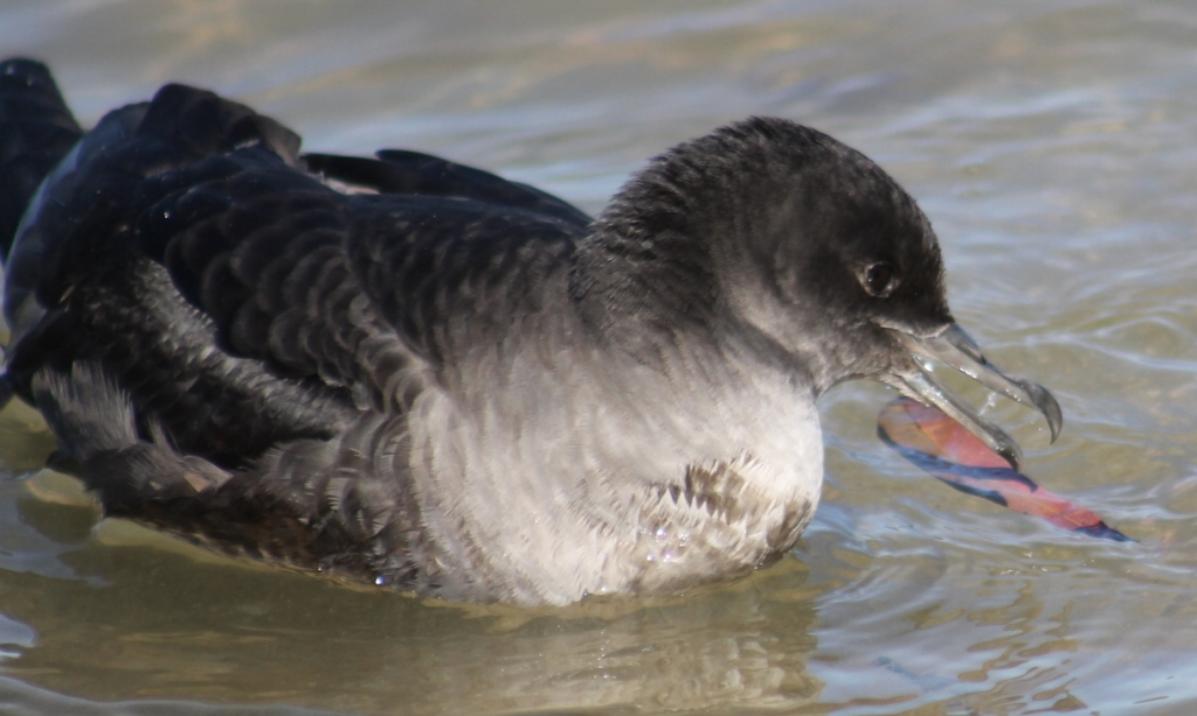
Some Late November Insects: For Youngsters
Many of you will have noticed there are a lot of flying and crawling insects around at the moment. Those who work in the field of ants will know that there are tiny black and brown ones and big ones, Bull ants, with nippers on the ground while those that fly have taken to the air with the rains we've been having lately.
The ants we’re most used to seeing are female black garden ants or the brown coastal ants, marching around collecting food. But during Summer, winged males and new queens of the same species take to the air. The ants take to the skies so that queens can mate with males from different colonies, and set up new nests of their own. For a swarm of ants to occur, conditions must be just right – they’re usually triggered by hot and humid weather, which is why we start seeing them in late November and swarms of them over Summer.
There are also moths flapping around at dusk and all through the night, although we haven't seen any bogan moths for years now, along with the first cicadas emerging these past few weeks - in fact, at Avalon, Clareville, Narrabeen and Elanora Heights people have been seeing Greengrocer cicadas emerging and shedding their skins. The past few years we've had masses of Black Prince cicadas emerging and trilling for around six weeks making a deafening noise.
Insects (from Latin insectum -Etymology. From Middle French insecte, from Latin īnsectum, from īnsectus “cut into, cut up, with a notched or divided body”, from the notion that the insect's body is "cut into" three sections; head, thorax, abdomen) are pancrustacean hexapod invertebrates of the class Insecta.
Insects are the largest group within the arthropod phylum. Insects have a chitinous exoskeleton, a three-part body (head, thorax and abdomen), three pairs of jointed legs (six legs!), compound eyes and one pair of antennae. Their blood is not totally contained in vessels; some circulates in an open cavity known as the 'haemocoel'. Insects are the most diverse group of animals; they include more than a million described species and represent more than half of all known living organisms. The total number of extant species is estimated at between six and ten million; potentially over 90% or 4/5ths of the animal life forms on Earth are insects.
This Issue a few of those we've spotted in our own yard and around the streets this past week.
Some ant species live in colonies that are supported by a single queen while others are supported by multiple queens. Although there are 1,300 ant species known in Australia, there are relatively few that we commonly see as pests as most are what is termed 'beneficial insects'.
Beneficial Insects
Beneficial is an adjective with a meaning of 'resulting in good; favourable or advantageous'.
Ants are known as beneficial insects because they keep the ecosystem clean of dead insect carcasses and aid in the destruction and decomposition of plant and animal matter. By carrying bits of plants and animal remains into their nests, the soil is fertilised and nutrients recycled through the world's ecosystems.
Other beneficial insects are bees, ladybugs, moths, lacewings, red and blue beetles, and a small native wasp, Microplitis. There are others - but in just these we have those that get rid of bugs that may destroy your plants, along with those that carry pollen to other plants to help them flower and grow into fruits and vegetables and nuts.
That's why you want to encourage insects to come into your garden by planting species that will attract them or making sure there's some good habitat for them - flowering plants, rotting logs, trees that have hollows, patches of grasses and rocks.
Ok - some of the insects we've spotted in the last week of November 2023.
Late November insects seen this past week
Bull ants are large, alert ants that can grow up to 40 mm They have characteristic large eyes and long, slender mandibles and a potent venom-loaded sting. They have superior vision, able to track and even follow intruders from a distance of 1 metre. Many species of bull ants have bright red or orange colours on the head or abdomen.
There are about 90 species of bull ants in Australia with diverse behaviours and life cycles. Nine bull ant species have been recorded in Sydney, but there may be more as yet undiscovered. Some of the smaller species are known as jumper ants after their habit of aggressively jumping toward intruders.
Bull ants live in urban areas, forests and woodland, and heath, including the coastal heath ecological communities we have here in Pittwater. Bull ants collect nectar and other plant juices, as well as animal prey, which are carried back to the nest.
Bull ant nests are usually underground and often have hidden or small entrances. The nests can extend several metres below the ground. They attack intruders of any size that come too close to their nest. Bull ants also have well-developed vision and will follow or even chase an intruder a good distance from the nest. Usually the sight of large aggressive ants streaming out of the nest is enough to prompt a hasty retreat. If not, the ants deliver painful stings by gripping the intruder with their mandibles (jaws), curling their abdomen to reveal the sting and injecting the victim with venom. Often multiple stings are delivered.
Several species have no colony workers. Instead, a raiding queen invades the nest of another species, kills the resident queen and takes over the colony. The queen may live for several years.
.jpg?timestamp=1700786483391)
Bull ant, Myrmecia sp, taken in bushland surrounding Swifts Creek, Victoria. Specimen is approximately 25mm in size. Photo: fir0002.
These ants can deliver painful stings and are aggressive. An ice pack or commercially available spray may be used to relieve the pain of the sting. If there is evidence of an allergic reaction, medical attention should be sought.
The Greengrocer Cicada, Cyclochila australasiae, is probably the most commonly encountered in the Sydney area. The two common names of Greengrocer and Yellow Monday refer to different colour forms of the same species. The origin of the names is unclear but they are known to have been in use as early as 1896. Other names for different colour forms include Chocolate Soldier (dark tan form) and Blue Moon (turquoise form).
Greengrocers are common on a range of trees, the adults spend much of the daytime sucking sap from branches.
.jpg?timestamp=1700787912886)
Greengrocer Cicada, Cyclochila australasiae, photographed Thursday November 23 2023. Photos: Selena Griffith
.jpg?timestamp=1700787943428)
Dusk is the usual time to hear the male Greengrocers calling for females, but they also sing in the morning on warm days. The harsh song may be continuous or delivered in short bursts, and can be extremely loud and penetrating.
Adult Greengrocer cicadas live for around six weeks. Females deposit eggs into dead or dying branches of a food plant. The eggs hatch after about four months into spidery-looking, long-legged nymphs that burrow into the soil. Here they suck sap out of plant roots and grow for up to seven years, emerging as adults between September and November on warm nights often following rain.
These little flying beetles make their appearance around now and this one flew into our kitchen this week - that's Eric's finger it's resting on so we could take some photos for you. It then flew off again!
This is a Phyllophaga and part is a very large genus (more than 260 species here) of New World scarab beetles in the subfamily Melolonthinae. Common names for this genus and genera of the subfamily are May beetles, June bugs and June beetles as they appear in America during those months (they have 750 species counted so far) although here they appear during our warmer months of November, December and January.
They are quite hard shelled which is why you may hear them bouncing off your walls indoors, and fly very fast. They are medium to large oval or cylindrical beetles, body length 8-25mm. Body colouration commonly brown to reddish brown, and blackish.
Larvae of Phyllophaga feed on the roots of a large range of plants and grasses. Adult beetles feed on plant foliage, and can cause significant damage when mass emergences occur. Both forms can have severe impacts on a large number of cultivated crops including maize, sorghum, wheat, rye, beans, oat, potato, sugarcane, turnip and cranberry. They can also be a significant pest of pastures and turf. Most adults emerge late spring/ early summer. Adults are nocturnal, and attracted to light. Night feeding beetles are not easily disturbed, leading to easy collection from their host plants. Among the recognised pest species in Australia are: P. anxia, P. crinita, P. ephilida, P. elenans, P. fusca, P. implicita, P. menetriesii, and P. vicina.
We also spotted a Christmas Beetle on Saturday Morning, November 25, unfortunately someone had stepped on it and it was squashed. Christmas beetle is a name commonly applied to the Australian beetle genus Anoplognathus, which belongs to the subfamily Rutelinae. They are known as Christmas beetles because they are abundant in both urban and rural areas close to Christmas.
There are about 36 species of Christmas Beetles (family Scarabaeidae) with all but one unique (endemic) to Australia and 21 species found in New South Wales. At least 10 species occur in the Sydney region – more if the Blue Mountains are included. Anoplognathus viriditarsus is the largest of the Sydney Christmas beetles.
Christmas Beetles come into Sydney from surrounding woodland where the adults feed on eucalyptus leaves and the larvae feed on grass roots. Adults can occur in large numbers, sometimes completely defoliating trees. The total number of Christmas Beetles reported in the Sydney area has declined over the last 30 years as the grassy woodland areas get used up for housing.
This moth is a Acosmeryx cinnamomea, a species of in the family sphinx moths. Sphingidae (Sphinx Moths) is a family of Lepidoptera (Moths And Butterflies). They eat the leaves of Cayratia clematidea (wild grape), Cissus antarctica (Kangaroo vine), Cissus oblonga, Vitis vinifera (wine grape/edible grape), Vitis vinifera rupestris (ornamental grape). They are Nocturnal - Active at night. Their colour ranges from brown to grey. Their size at rest - tip of thorax to tip of either forewing: 49mm.
As you can see, this one has a bald spot. Moths and butterflies constantly accumulate damage on their wings and bodies over time, and they're especially prone to loosing the delicate scales that coat their exoskeleton (which is usually visible as a 'bald spot' on the top part of a moth's thorax when it's been bumping around a light for a few hours). You can even get a sense of a moth's age by seeing how worn and tattered its wings are; newly emerged individuals are usually pristine, while older ones have frayed wings and patches of missing scales.
The species is found in North-Western WA, Northern NT, Far North Queensland and south along the coast through QLD, NSW to northern tip of VIC. The caterpillar grows to a length of about 8cms. The pupa has a length of about 4.5 cms.
Finally, how about one more of the moths you are likely to see at present? This one flew in and hovered around the computer and then dived down the back of the desk, where there are heaps of cobwebs, on Friday morning at dawn - obviously coming indoors for the day - and reminding me to clean behind my desk! - whoops....
This is a Tiger Moth.
Unlike many other moths, Tiger Moths has bright orange bars and spots on its wings. They have striped abdomens which has given them their name. Most Tiger Moths fly at night but some are day-fliers. They do not fly very fast.
Most Caterpillars of the Arctiidae are covered in dense dark hairs, which gives them the name "Woolly Bears". The hairs can cause irritation in sensitive skin. The caterpillars are small to medium size. The caterpillars usually active during the daytime. If disturbed, they will roll into a tight spiral.
Tiger Moths live on the coastal areas of eastern Australia. You will find Tiger Moths on plants usually around flowers, around water such as puddles and in the air.
After dark Tiger Moths emit ultrasonic clicks which can be picked up by insectivorous bats. These clicks warn the bats that the moth is unpleasant to eat, and also jams the bats’ sonar system.
The Tiger Moth is a food source for small birds. Luckily for the Tiger Moth, most predators know its marked patches of orange and black mean that the moth is distasteful or poisonous.
They love to drink the nectar from wildflowers and prefer an established garden, where they can also eat lichen. Lichen occurs when fungi and algae grow together. In rainforests and alpine forests it forms a large carpet on the ground. Keep a look out for grey, green or yellow patches on your backyard rocks and trees.
Finally, a lot of our local insects are food for birds that live here. This week we also spotted the pair of Butcher Birds that live in our yard have had two babies this year and they are now able to fly around a bit, known as 'fledglings' at this stage, and be taught how to catch insects for their own dinner. Although, as you can see from the photos, one was trying out a larvae as well.
calling to mum and dad; feed me! feed me!
leaning off the top of the fence top get a larvae pod
success!
his/her brother or sister was a little further along the same fence top, also hunting for insects
Ok - we'll keep taking photos of insects we spot over Summer and will bring you more on our local insects soon.
Information from the Australian Museum and Backyard Buddies and the NSW Department of Primary Industries. Photos; A J Guesdon.
Collaroy Beach Coastal Works: Have Your Say - Closes December 3
- completing the submission form here
- emailing council@northernbeaches.nsw.gov.au
- writing to council at Northern Beaches Council, PO Box 82 Manly NSW 1655.
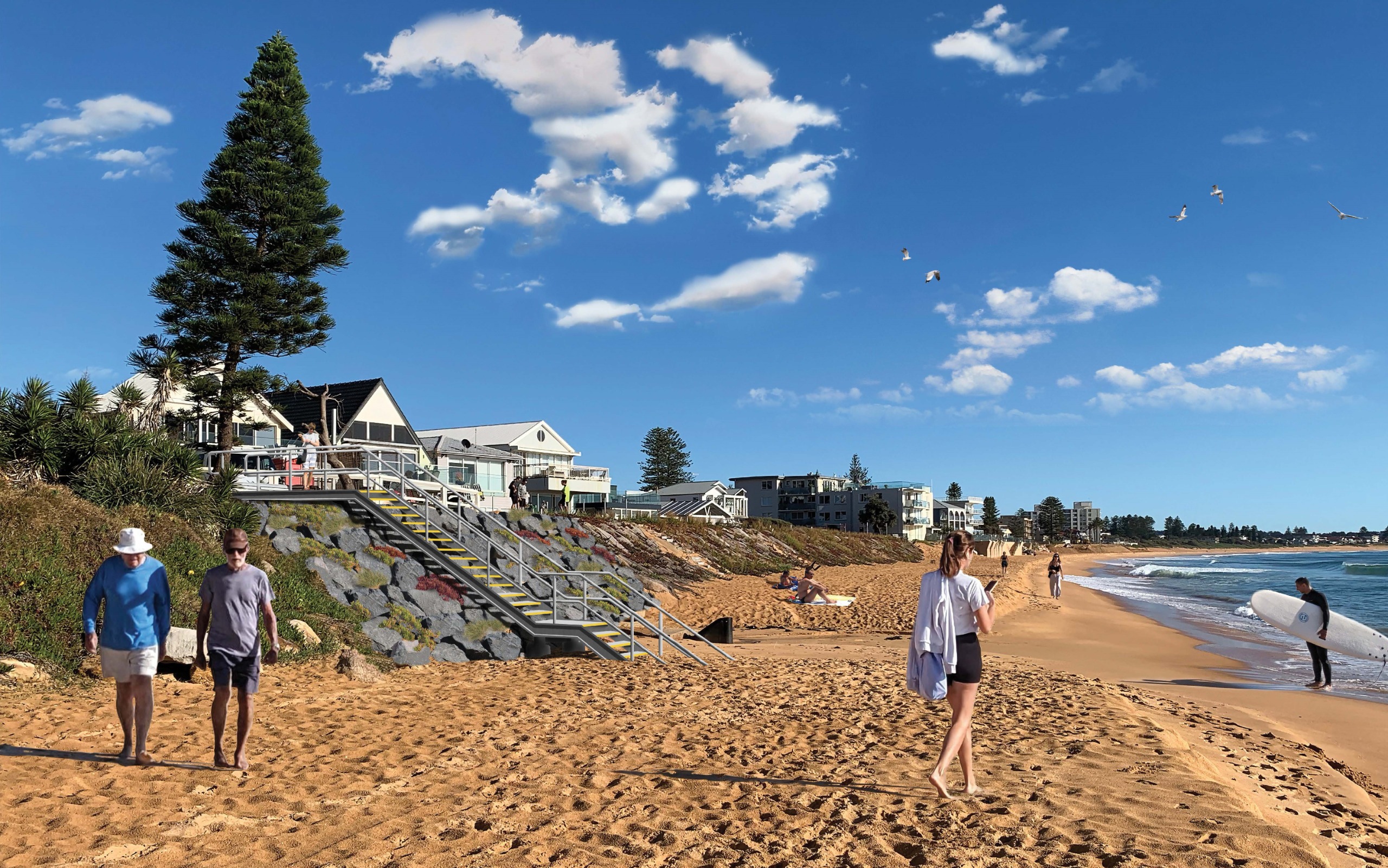
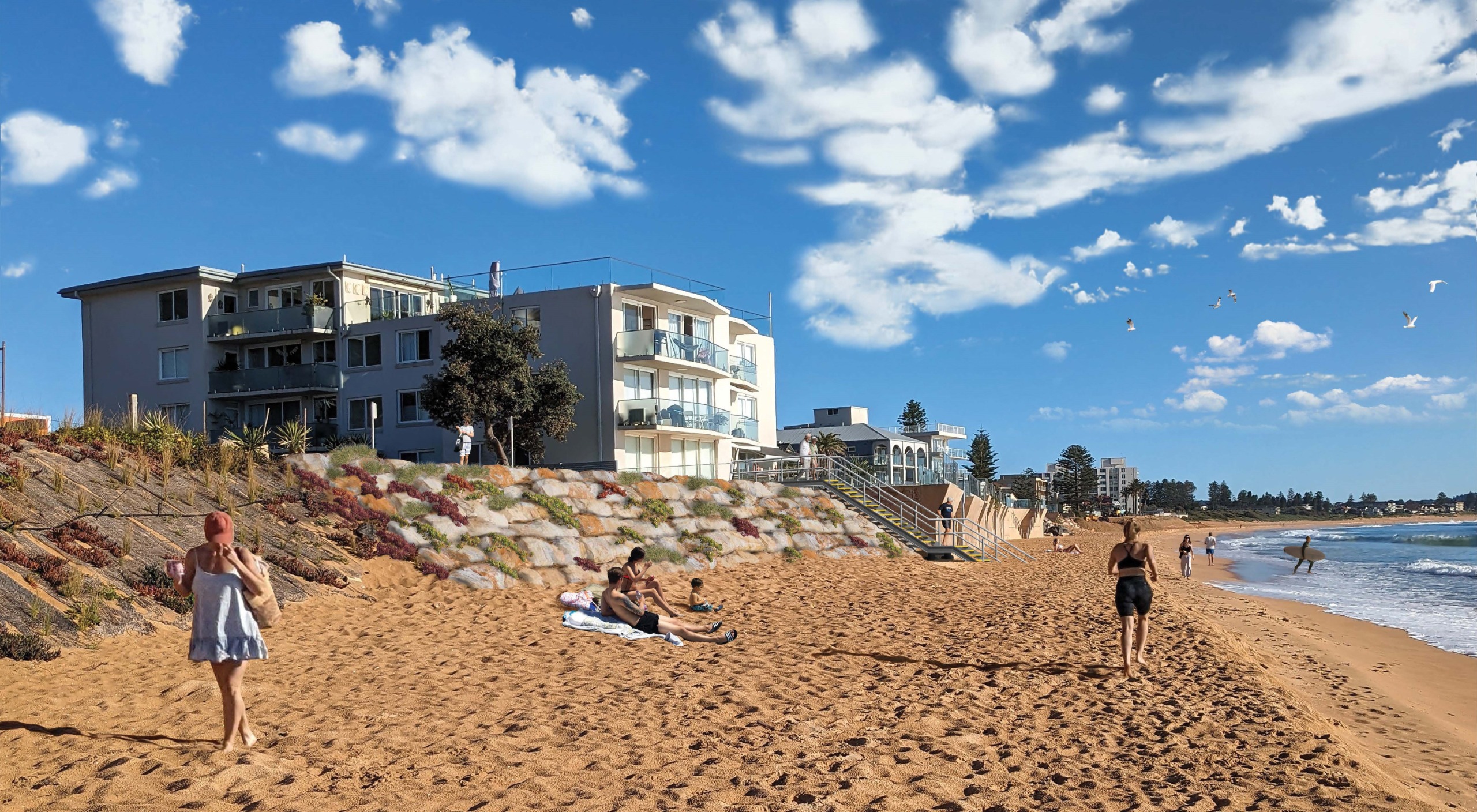
West Head Lookout Update
- >reinstatement of the previous sandstone paving and the bronze map plinth
- > installation of the stainless-steel balustrade along the lower retaining wall
- > planting of native species in the garden beds.

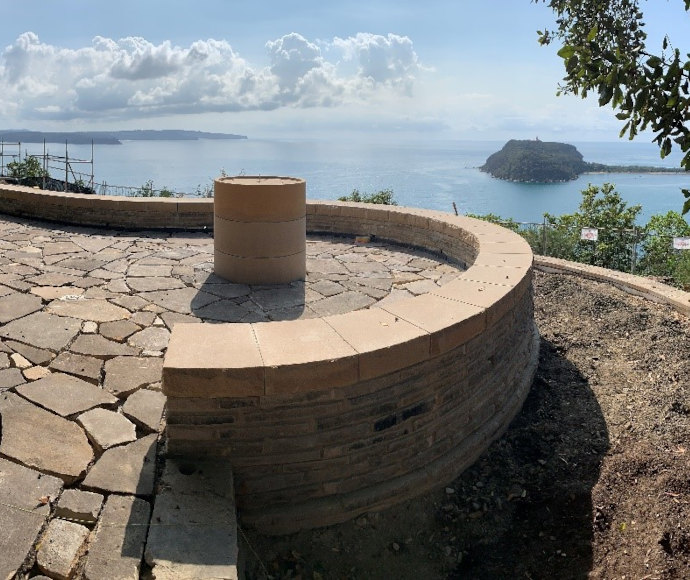
Living Ocean Beach Clean: December 3rd + Relaunch Of No Plastic Please

Hazard Reduction Impact On Bees: Call For Participants For Study
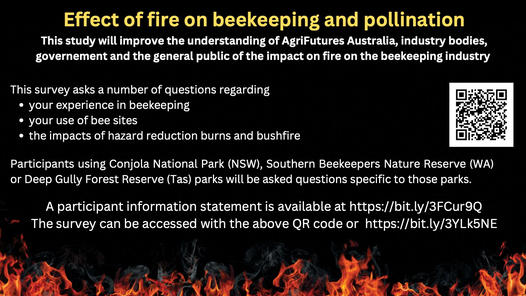
Mountain Bike Incidents On Public Land: Survey
- Mountain Bike Incidents On Public Land: Survey Launched To Gather Data On What's Happening To Public Parks - Community Land - Bush Reserves In Pittwater
- Mother Brushtail Killed On Barrenjoey Road: Baby Cried All Night - Powerful Owl Struck At Same Time At Careel Bay During Owlet Fledgling Season: calls for mitigation measures - The List of 'What You can Do' as requested
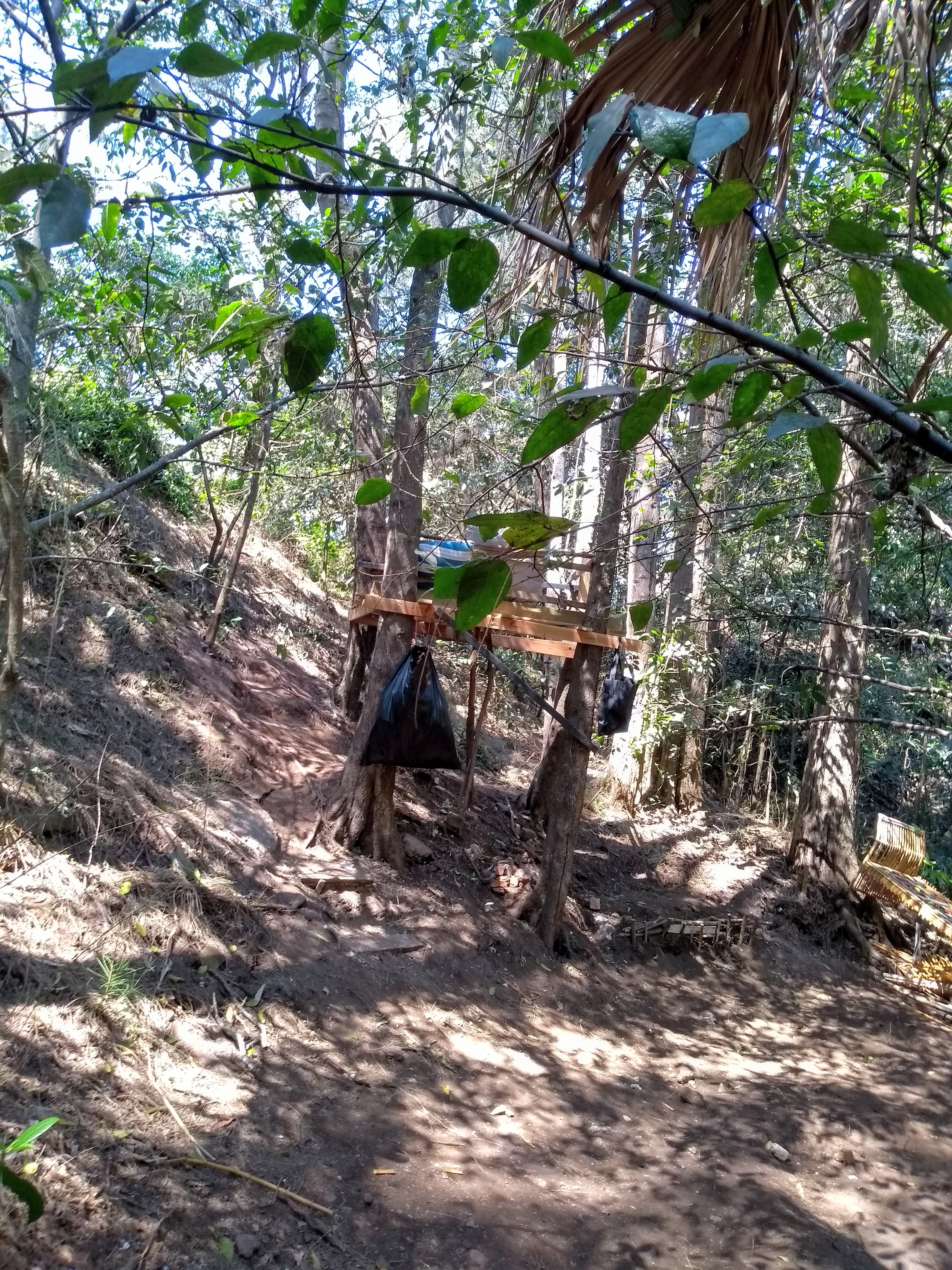
Communities And Industry To Have Their Say As NSW Accelerates Renewable Energy Transition
Next Steps To Beat Plastic Pollution In NSW: Have Your Say
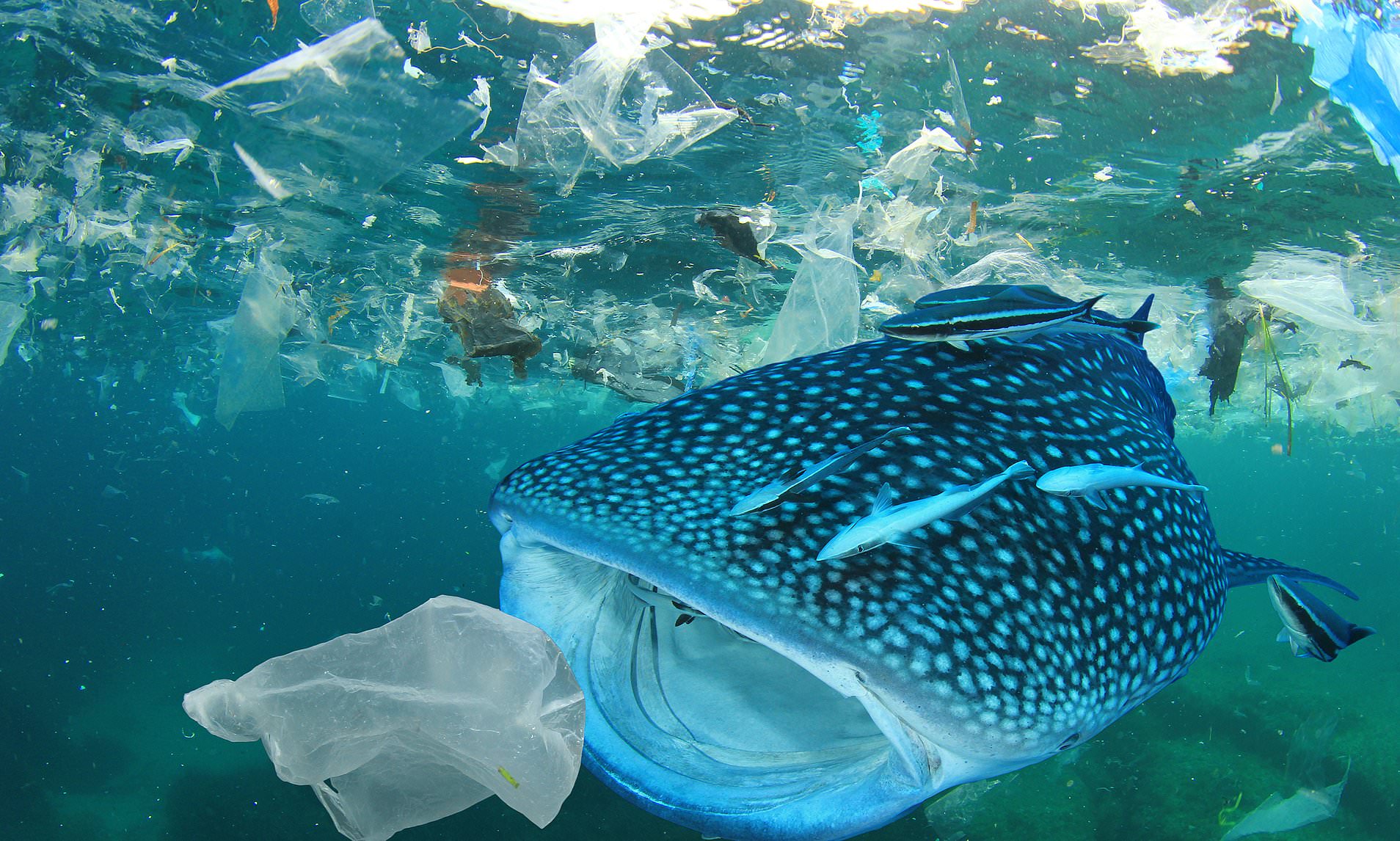
- Are frequently littered or release microplastics into the environment;
- Contain harmful chemical additives; or
- Are regulated or proposed to be in other states and territories.
- Items containing plastic such as lollipop sticks, cigarette butts, bread tags and heavyweight plastic shopping bags are some of the problematic products that could be redesigned or phased out.
Upcoming Workshop With Permaculture Northern Beaches + 2023 AGM + 2023 Raffle
 Gardening for a Long Hot Summer
Gardening for a Long Hot Summer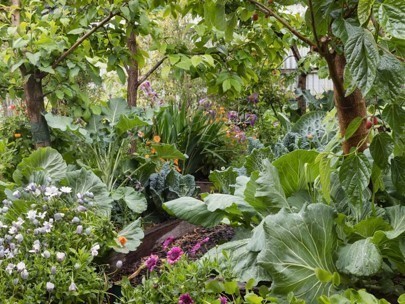
Finding Frogs In Warriewood Wetlands
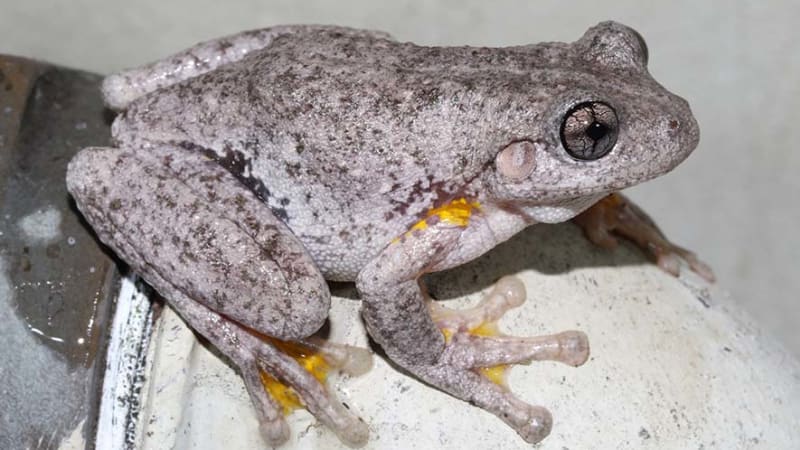
Creative Christmas: Making Natural Christmas Decorations At Narrabeen + Avalon
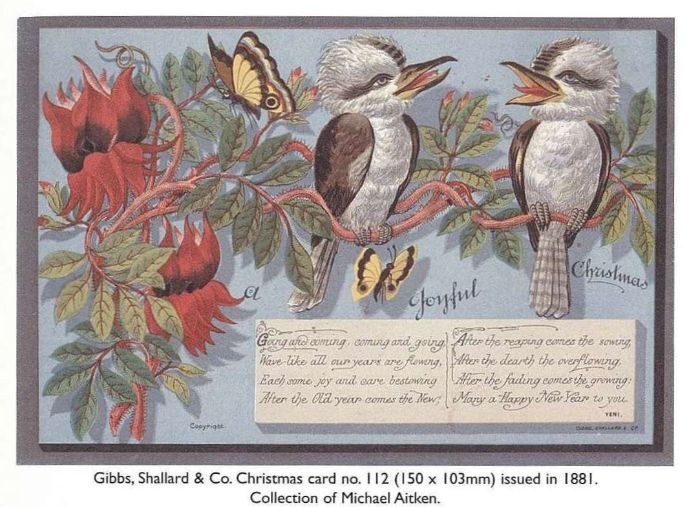 Saturday, 2 December 2023 - 10:00 am to 01:00 pm
Saturday, 2 December 2023 - 10:00 am to 01:00 pmJoin The Avalon Christmas Tree Decoration Program
Wakehurst Parkway Update: REF For Proposed Works Available - Feedback Closes December 6
Sydney Local Native: Pittwater Edition Published
- average maximum height and width
- a description of the plant's form
- flower colour and flowering season
- an overview of the plant's best features
- its preferences for soil, water and light
- where it is naturally distributed.
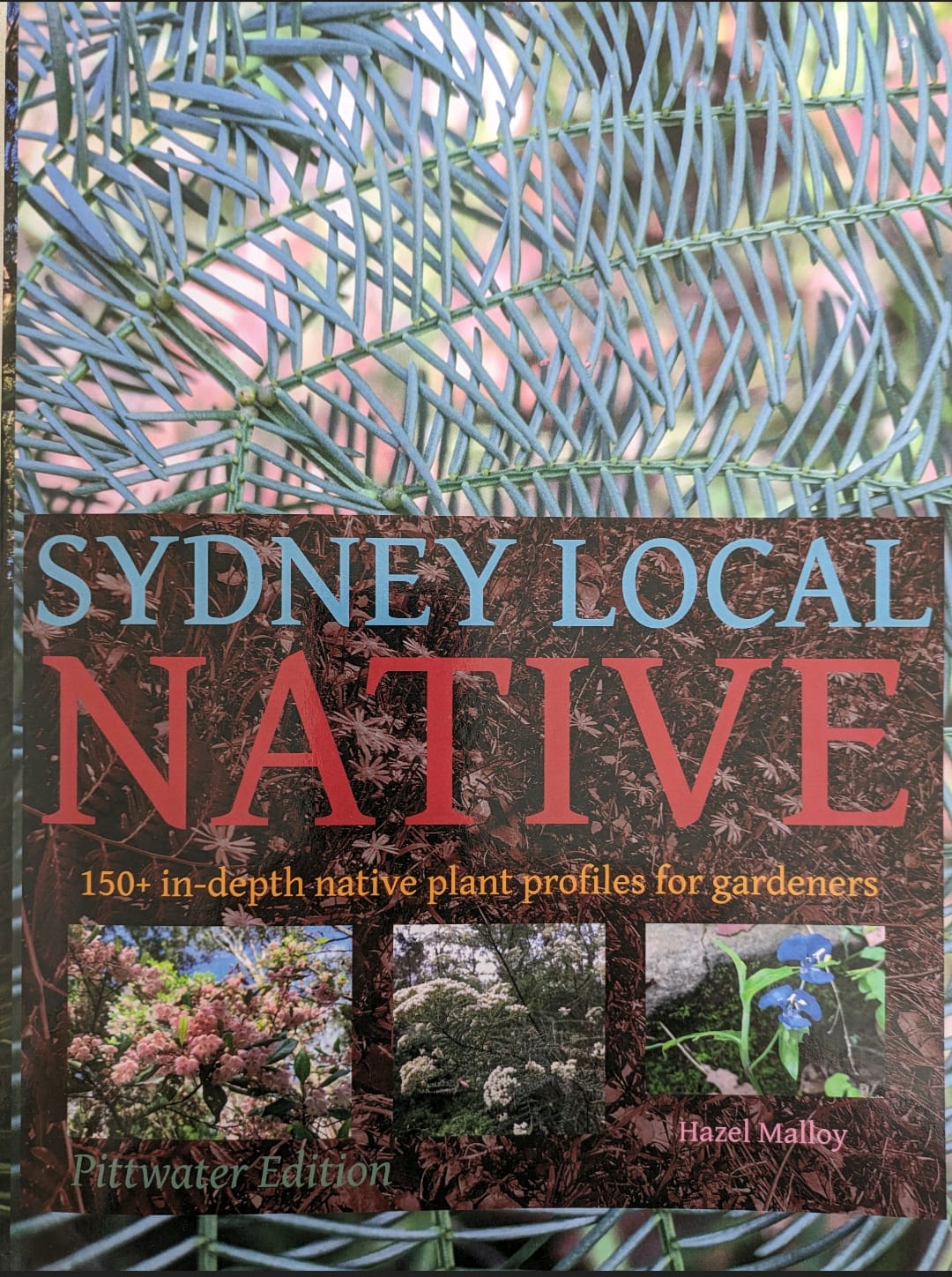
Please Look Out For Wildlife During Heatwave Events

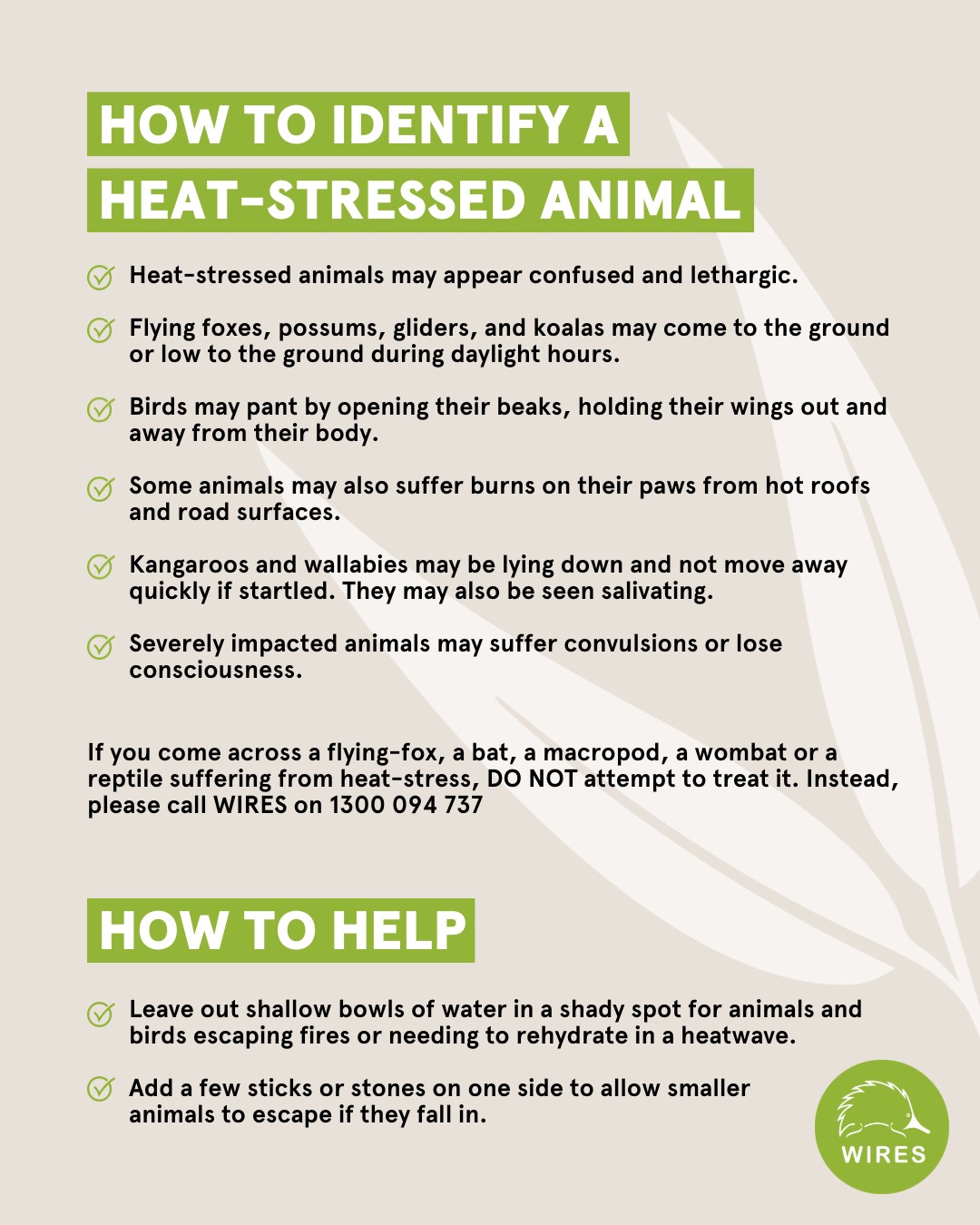
AER Releases Social Licence For Electricity Transmission Directions Paper
- What expectations should be held of transmission businesses in undertaking community engagement
- What outcomes need to be achieved from engagement
- When and how social licence issues can be factored into regulatory tests for the approval of and recovery of cost for new transmission development
- What evidence is needed to justify transmission network expansion and associated expenditure.
- clearly identify the information that is the subject of the confidentiality claim
- provide a non-confidential version of the submission in a form suitable for publication.
Bushwalk Fundraiser
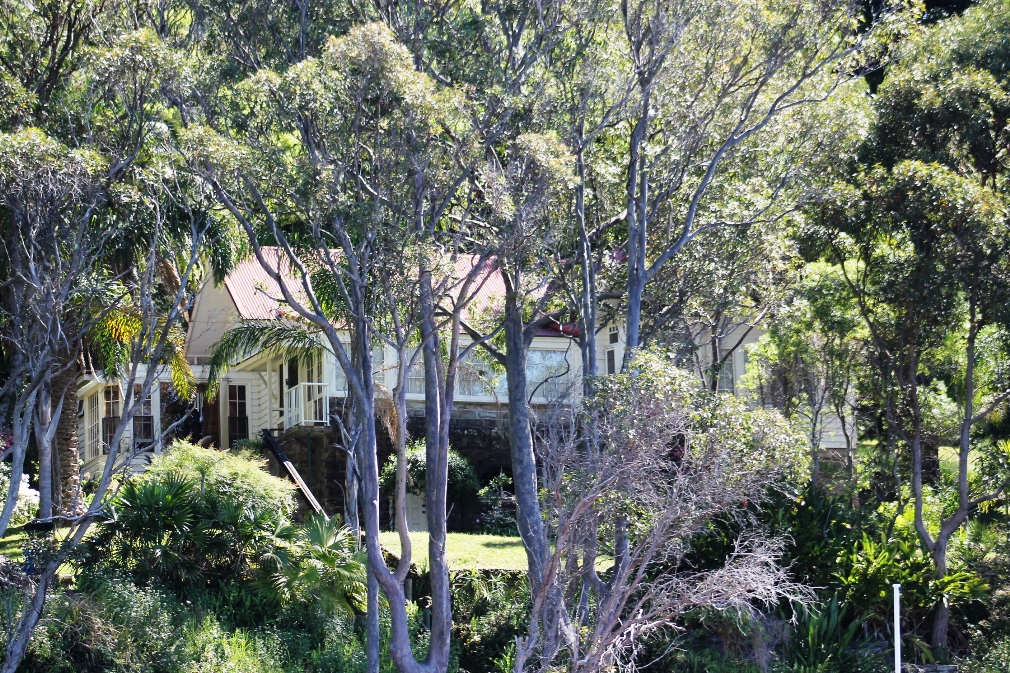
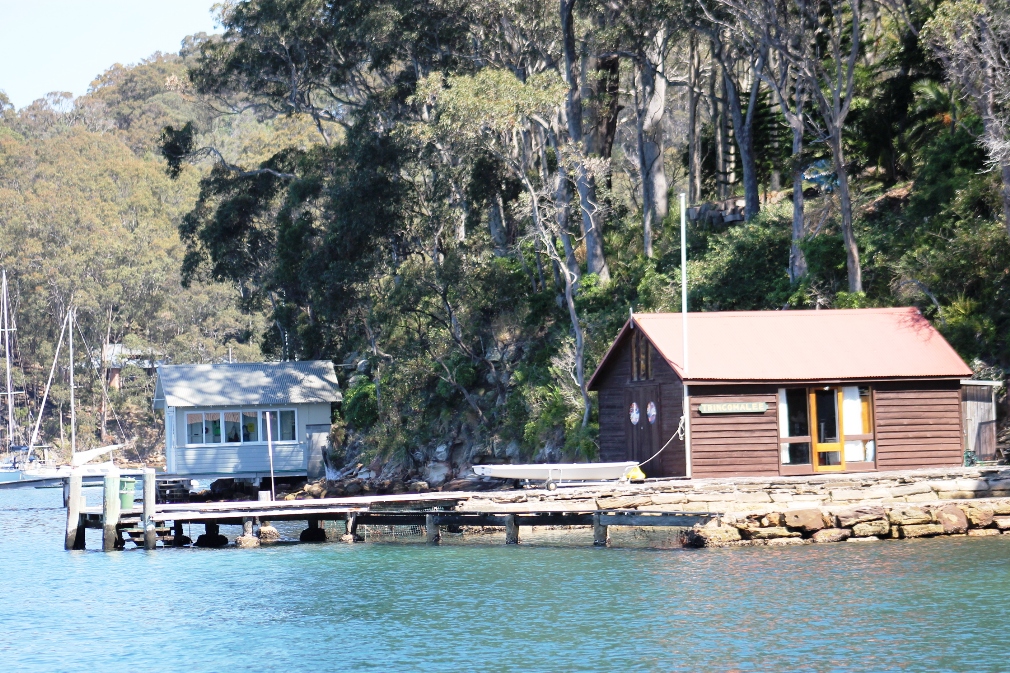
- Friday 8 December
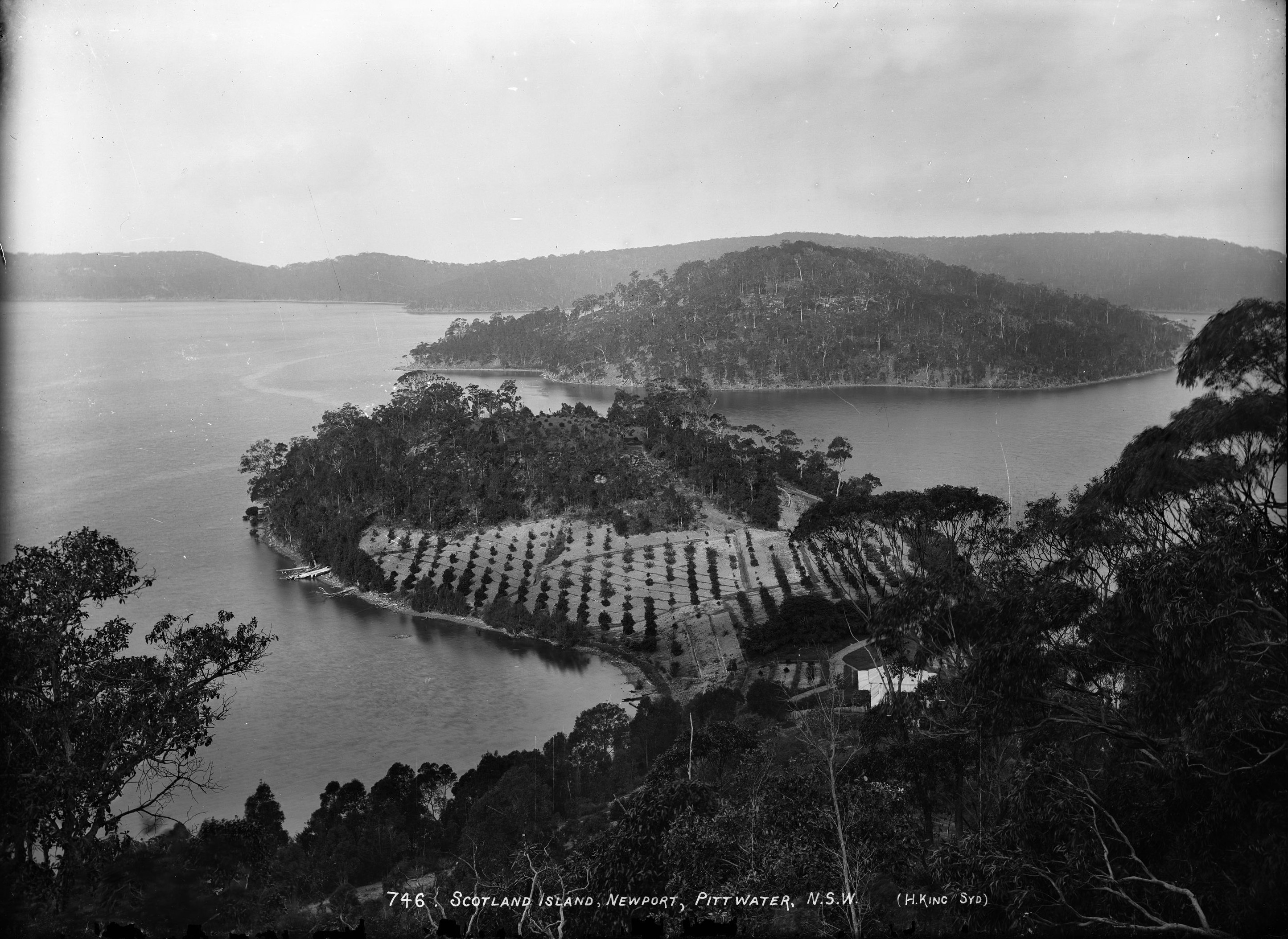
'Scotland Island, Newport, Pittwater, N.S.W.', photo by Henry King, Sydney, Australia, c. 1880-1886. and section from to show cottage on neck of peninsula at western end with no chimneys through roof. From Tyrell Collection, courtesy Powerhouse Museum
Palmgrove Park Avalon: New Bushcare Group
 Palmgrove Park Avalon is a remnant of the Spotted Gum forest that was once widespread on the lower slopes of the Pittwater peninsula. This bushland’s official name and forest type is Pittwater and Wagstaffe Endangered Ecological Community, endangered because so much has been cleared for suburban development. Canopy trees, smaller trees and shrubs, and ground layer plants make up this community. Though scattered remnant Spotted Gums remain on private land, there is little chance of seedlings surviving in gardens and lawns. More information HERE
Palmgrove Park Avalon is a remnant of the Spotted Gum forest that was once widespread on the lower slopes of the Pittwater peninsula. This bushland’s official name and forest type is Pittwater and Wagstaffe Endangered Ecological Community, endangered because so much has been cleared for suburban development. Canopy trees, smaller trees and shrubs, and ground layer plants make up this community. Though scattered remnant Spotted Gums remain on private land, there is little chance of seedlings surviving in gardens and lawns. More information HERE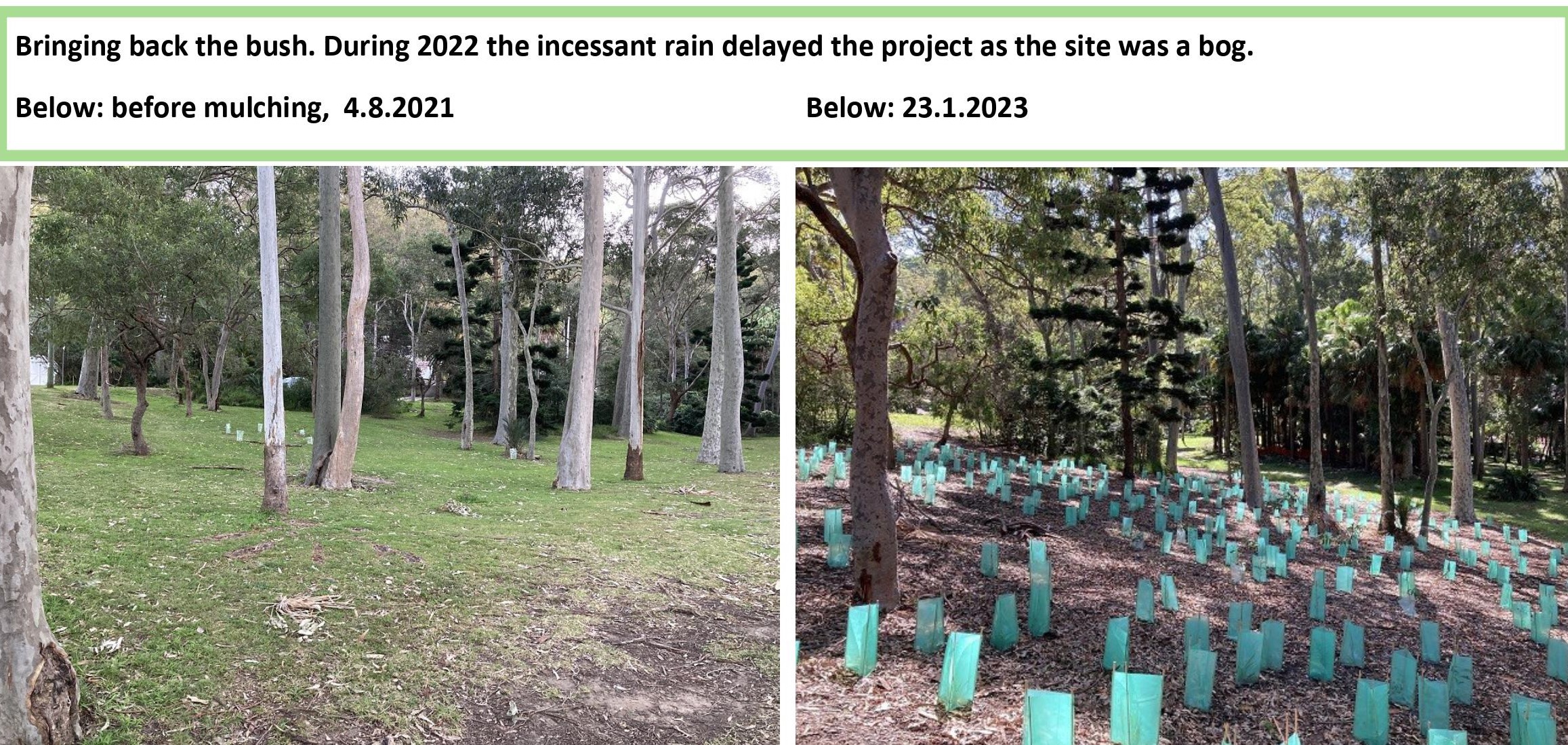
PNHA Guided Nature Walks 2023
Our walks are gentle strolls, enjoying and learning about the bush rather than aiming for destinations. Wear enclosed shoes. We welcome interested children over about 8 years old with carers. All Welcome.
So we know you’re coming please book by emailing: pnhainfo@gmail.com and include your phone number so we can contact you if weather is doubtful.
The whole PNHA 2023 Guided Nature Walks Program is available at: http://pnha.org.au/test-walks-and-talks/
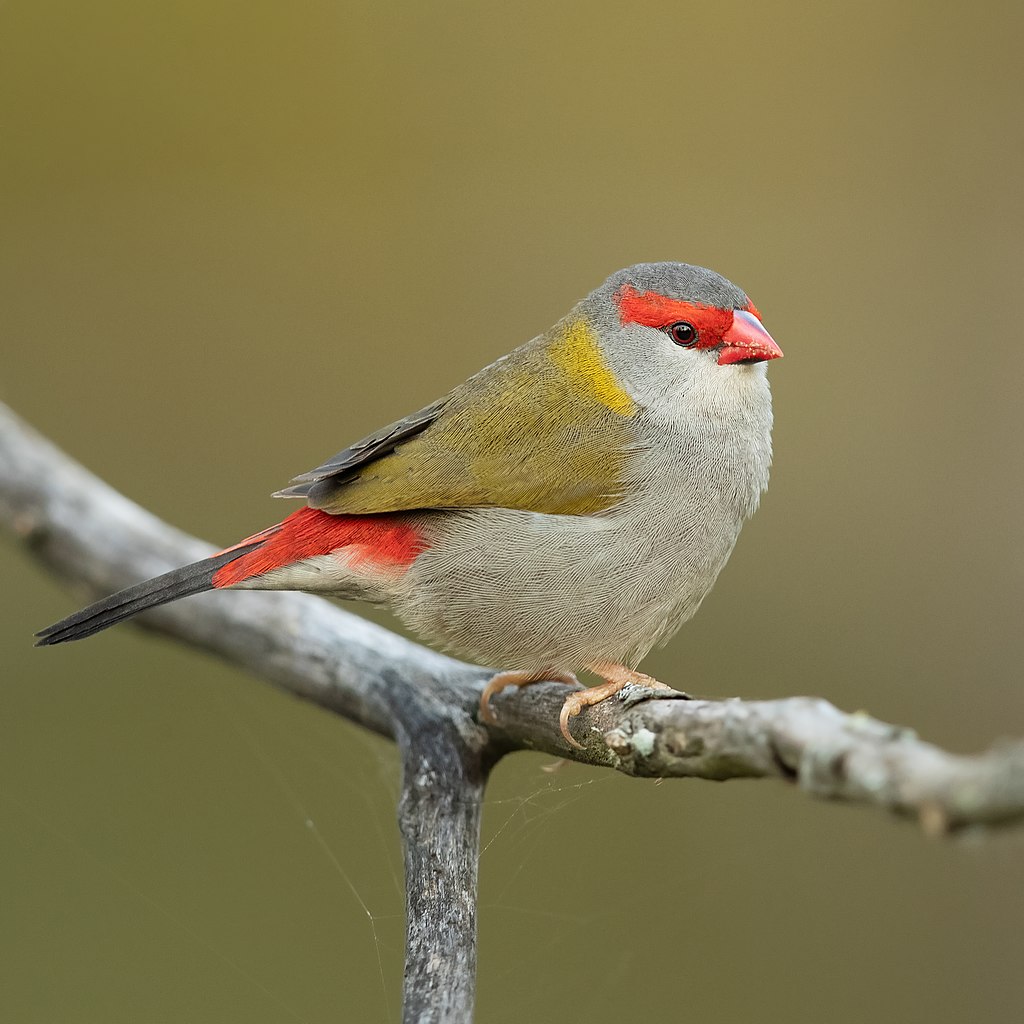
Red-browed finch (Neochmia temporalis). Photo: J J Harrison
Report Fox Sightings
%20(1).jpg?timestamp=1675893929686)
Marine Wildlife Rescue Group On The Central Coast
A new wildlife group was launched on the Central Coast on Saturday, December 10, 2022.
Marine Wildlife Rescue Central Coast (MWRCC) had its official launch at The Entrance Boat Shed at 10am.
The group comprises current and former members of ASTR, ORRCA, Sea Shepherd, Greenpeace, WIRES and Wildlife ARC, as well as vets, academics, and people from all walks of life.
Well known marine wildlife advocate and activist Cathy Gilmore is spearheading the organisation.
“We believe that it is time the Central Coast looked after its own marine wildlife, and not be under the control or directed by groups that aren’t based locally,” Gilmore said.
“We have the local knowledge and are set up to respond and help injured animals more quickly.
“This also means that donations and money fundraised will go directly into helping our local marine creatures, and not get tied up elsewhere in the state.”
The organisation plans to have rehabilitation facilities and rescue kits placed in strategic locations around the region.
MWRCC will also be in touch with Indigenous groups to learn the traditional importance of the local marine environment and its inhabitants.
“We want to work with these groups and share knowledge between us,” Gilmore said.
“This is an opportunity to help save and protect our local marine wildlife, so if you have passion and commitment, then you are more than welcome to join us.”
Marine Wildlife Rescue Central Coast has a Facebook page where you may contact members. Visit: https://www.facebook.com/profile.php?id=100076317431064
- Ph: 0478 439 965
- Email: marinewildlifecc@gmail.com
- Instagram: marinewildliferescuecc
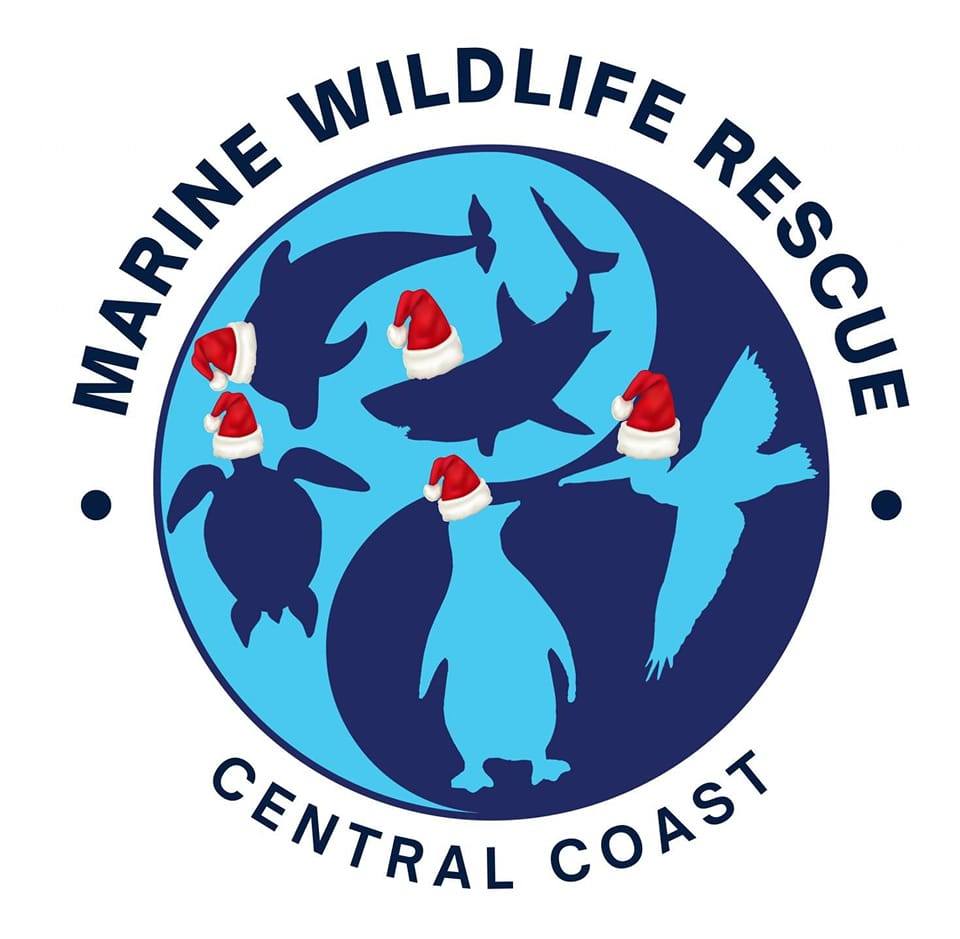
Watch Out - Shorebirds About
.JPG.opt1460x973o0,0s1460x973.jpg?timestamp=1663629195339)
Possums In Your Roof?: Do The Right Thing
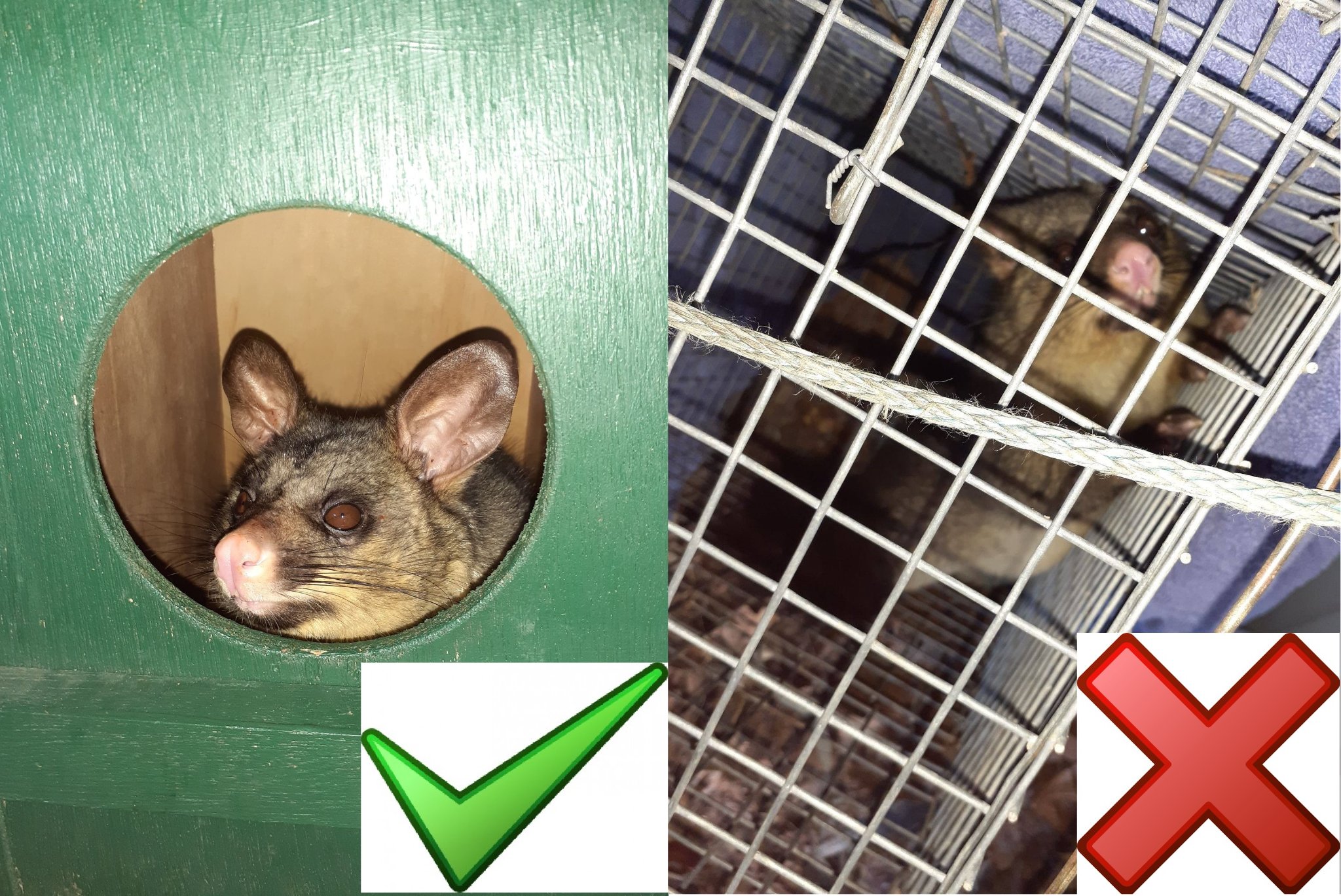
Aviaries + Possum Release Sites Needed

Bushcare In Pittwater
Where we work Which day What time
Avalon
Angophora Reserve 3rd Sunday 8:30 - 11:30am
Avalon Dunes 1st Sunday 8:30 - 11:30am
Avalon Golf Course 2nd Wednesday 3 - 5:30pm
Careel Creek 4th Saturday 8:30 - 11:30am
Toongari Reserve 3rd Saturday 9 - 12noon (8 - 11am in summer)
Bangalley Headland 2nd Sunday 9 to 12noon
Bayview
Winnererremy Bay 4th Sunday 9 to 12noon
Bilgola
North Bilgola Beach 3rd Monday 9 - 12noon
Algona Reserve 1st Saturday 9 - 12noon
Plateau Park 1st Friday 8:30 - 11:30am
Church Point
Browns Bay Reserve 1st Tuesday 9 - 12noon
McCarrs Creek Reserve Contact Bushcare Officer To be confirmed
Clareville
Old Wharf Reserve 3rd Saturday 8 - 11am
Elanora
Kundibah Reserve 4th Sunday 8:30 - 11:30am
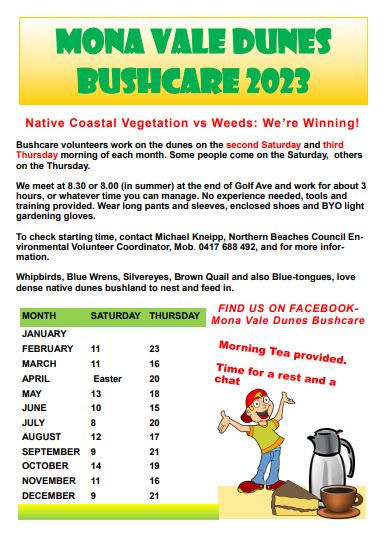 Mona Vale
Mona Vale Mona Vale Beach Basin 1st Saturday 8 - 11am
Mona Vale Dunes 2nd Saturday +3rd Thursday 8:30 - 11:30am
Newport
Bungan Beach 4th Sunday 9 - 12noon
Crescent Reserve 3rd Sunday 9 - 12noon
North Newport Beach 4th Saturday 8:30 - 11:30am
Porter Reserve 2nd Saturday 8 - 11am
North Narrabeen
Irrawong Reserve 2nd Saturday 2 - 5pm
Palm Beach
North Palm Beach Dunes 3rd Saturday 9 - 12noon
Scotland Island
Catherine Park 2nd Sunday 10 - 12:30pm
Elizabeth Park 1st Saturday 9 - 12noon
Pathilda Reserve 3rd Saturday 9 - 12noon
Warriewood
Warriewood Wetlands 1st Sunday 8:30 - 11:30am
Whale Beach
Norma Park 1st Friday 9 - 12noon
Western Foreshores
Coopers Point, Elvina Bay 2nd Sunday 10 - 1pm
Rocky Point, Elvina Bay 1st Monday 9 - 12noon
Friends Of Narrabeen Lagoon Catchment Activities

Gardens And Environment Groups And Organisations In Pittwater
Moonlight basking and queer courting: new research reveals the secret lives of Australian freshwater turtles
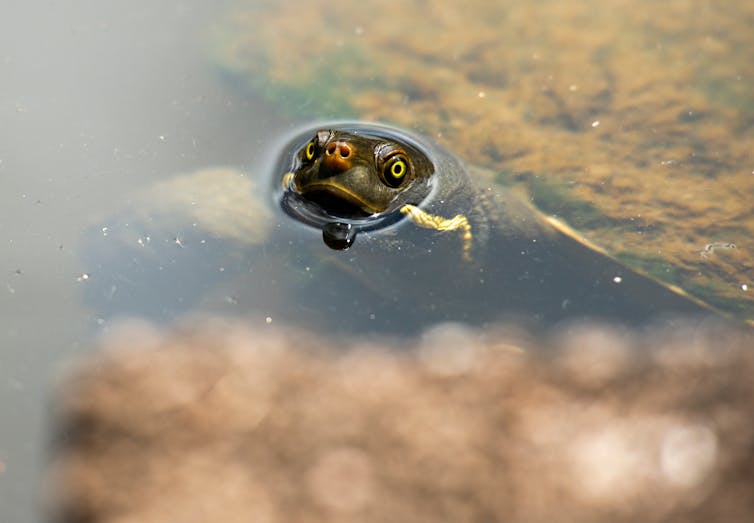
Australian freshwater turtles support healthy wetlands and rivers. Yet one in three turtle species is threatened with extinction. And there is still much we don’t know about them.
In today’s special issue of the journal Austral Ecology, 55 authors present the latest research on Australian freshwater turtles.
Along with other biologists, we have contributed to a series of research papers to inform ecology and conservation of freshwater turtles.
Our research reveals some fresh insights into turtle behaviour, survey methods and conservation strategies.
Spy Wear And Other Turtle Tech
In one study researchers compared data from underwater video cameras to traditional trapping surveys and achieved similar results. They detected 83 turtles from 52 hours of footage and identified all species in the study area.
Overall, baited remote underwater videos proved to be a “useful, time effective, non-invasive technique to collect relative abundance and species richness estimates for freshwater turtles”.
Another study provided the first vision of a wild saw-shelled turtle attempting to court a mate. The male sought affection from the female turtle by waving his feet and pressing his nose into her face.
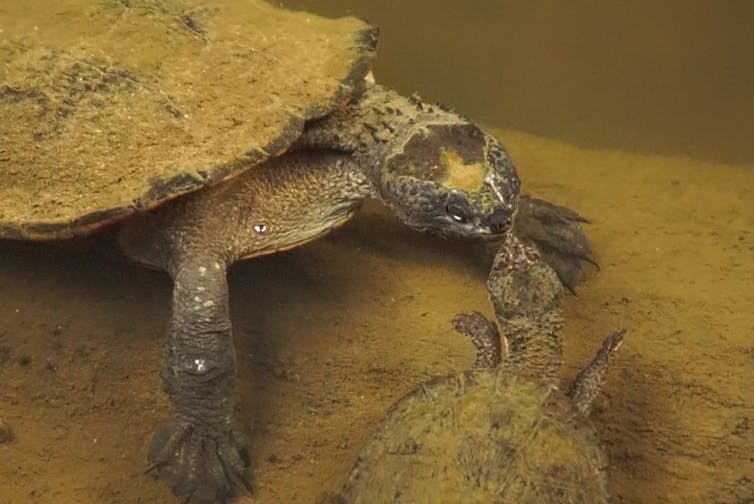
Meanwhile, a different male was observed trying to mount a larger male. This was the first case of same-sex mounting seen in this species.
We are continuing to unravel curious turtle behaviour known as nocturnal basking. During the day, many reptiles regulate their body temperature by sunning themselves. But some freshwater turtles (and crocodiles) also emerge from the water and bask on logs at night.
To find out why, scientists in Queensland measured the preferred temperature of Krefft’s river turtles and watched them bask more when the water was hot. So it seems they do this to stay cool in hot weather.
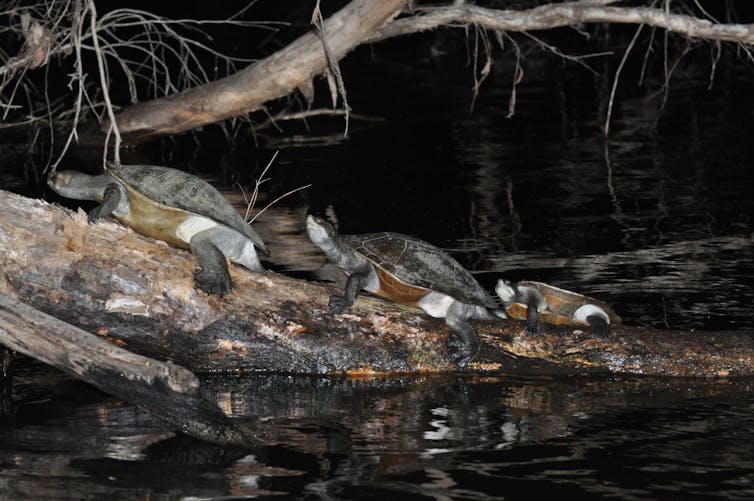
Over in desert country, we recaptured Cooper Creek turtles after two decades. While we were there, the site became surrounded with floodwater – this provided a rare opportunity to find turtles moving onto the floodplain to find food.
We also found lots of baby turtles. This is in contrast to most places around Australia, which have ongoing problems with foxes eating turtle nests.
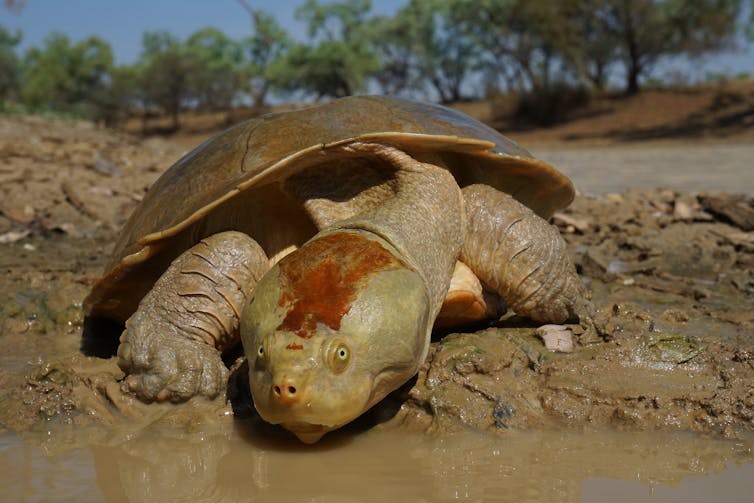
Conservation Success Stories
Foxes target freshwater turtle nests across Australia, reducing breeding success. Researchers are experimenting with measures to protect nests from predators.
In the New England Tablelands, temporary electric fences served to protect turtle nests from foxes over three breeding spring-summer seasons from 2019 to 2022. But in the Murray River, plastic mesh over individual nests only protected some of them.
Nest protection supports conservation of the endangered Mary River turtle. Over 22 years, more than 100 members of the local community in the Mary River Catchment have led initiatives to protect Mary River turtles. Working with communities has dual benefits – for research and for the people involved, who enjoy connecting to nature.
These collaborations have helped improve river management, informing delivery of water for the environment and improving the quality of river habitats for turtles.
November is Turtle Month for the 1 Million turtles campaign, a national citizen science program bringing together scientists and the community, to support freshwater turtle conservation initiatives.
Through the free TurtleSAT app, people can do more than just report turtle sightings. They can actively contribute to data-driven turtle management.
The app provides real-time data visualisation. The program website also provides education, helping citizen scientists protect nests, establish predator-free turtle sanctuaries, engage in national experiments, and deepen their understanding of turtles and wetlands.
With more than 18,000 records logged, 1,200 turtles saved from road hazards and 500 nests protected, this initiative is crucial in light of the growing threats faced by freshwater turtle species.
Challenges And Solutions
Of Australia’s 25 freshwater turtle species, 12 are so poorly known their national conservation status could not be assessed during this 2022 review. Many of these lesser-known species occur in northern Australia.
Of the 15 species or subspecies assessed, we recommended listing a higher level of threat for eight. This included western saw-shelled turtles, which were recently uplisted from vulnerable to endangered.
Threats include habitat loss, being eaten by foxes or feral pigs, disease, fire, and moving species into new areas where they breed with existing turtle species. To manage these threats, we need to move beyond engagement to an integrated approach, where conservation advice is co-determined by First Nations people who are closely involved in implementing recovery plans and action plans.
There is immense value in establishing long-term studies to track these long-lived species. And technology continues to provide new opportunities to learn more.
Future conservation and management will require working with communities to learn more about turtles and protect them. If one million people each save one turtle, collectively we will have made a big difference.![]()
Deborah Bower, Associate Professor in Zoology and Ecology, University of New England; Donald McKnight, , James Cook University; Eric Nordberg, Senior Lecturer (Applied Ecology and Landscape Management), University of New England; James Van Dyke, Associate Professor in Biomedical Sciences, La Trobe University; Michael B Thompson, Emeritus Professor in Zoology, University of Sydney, and Ricky Spencer, Associate Professor of Ecology, Western Sydney University
This article is republished from The Conversation under a Creative Commons license. Read the original article.
Australian dolphins have the world’s highest concentrations of ‘forever chemicals’

As predators at the top of the food chain, dolphins tend to accumulate and magnify high levels of toxins and other chemicals in their bodies. So health problems in dolphins can be a warning that all is not well in the system as a whole.
One group of persistent pollutants has been dubbed “forever chemicals” because they almost never break down in the environment. Commonly known by the acronym PFAS, these per- and polyfluorinated substances are globally recognised as an environmental hazard and a potential human health issue.
In our new research, we found dolphins with the highest concentration of PFAS in the world live in Australian waters. One young Burrunan dolphin had liver concentrations almost 30% higher than any other dolphin ever reported.
This is a critically endangered species endemic to southeast Australia. While the consequences for dolphin health and the implications for humans remain unknown, the record-breaking concentrations are cause for alarm.
The Case Of The Burrunan Dolphin
The Burrunan dolphin was recognised as a separate species in 2011. Fewer than 200 individuals remain. Two small, isolated and genetically distinct populations reside in coastal Victoria, Australia.
In our research, we took liver samples from Burrunan dolphins and three other dolphin species found dead and washed up on beaches.
We found the critically endangered Burrunan dolphin had 50–100 times more PFAS than other dolphins in the same region. Their PFAS concentrations were the highest reported globally.
In 90% of these dolphins, the liver concentrations of these chemicals (1,020–19,500 nanograms per gram) were above those thought to cause liver toxicity and altered immune responses.
These record-breaking and potentially health-compromising PFAS concentrations are a major concern for the survival of the species.
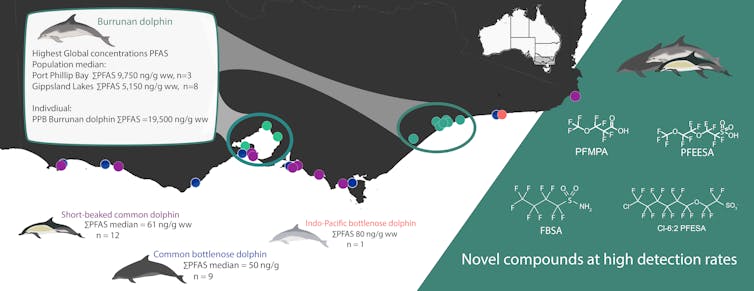
Results From Australia And Around The World
By far the highest PFAS concentrations in the dolphins we studied were of a particular compound called PFOS (perfluorooctane sulfonate). PFOS is one of the most studied PFAS compounds. It is listed on the Stockholm Convention, a global treaty on environmental pollutants, with international restrictions on use.
While Australia does not manufacture PFOS, heavy use of PFOS-containing firefighting foams occurred until the early 2000s. The Australian government still allows PFOS import for permitted purposes, such as mist suppressants in manufacturing and metal plating.
In recent years, public concern has prompted ongoing investigations into areas of high firefighting foam use, such as Royal Australian Airforce training facilities and airports.
While firefighting foam is a probable source of PFAS in waterways, there are others. Recent research in Florida in the United States found leaking septic and wastewater systems in urban areas were sources of PFAS runoff into the aquatic environment.
The Burrunan dolphins are not alone. In 2017, the South Australian Environment Protection Authority investigated PFOS concentrations in dolphins from Western Australia, South Australia and New South Wales. Dolphins in the Swan-Canning River Estuary in Perth, and in Port River or Barker Inlet, SA, had high PFOS levels (2,800–14,000ng per gram and 510–5,000ng per gram, respectively). These PFOS levels are similar to those in the Burrunan dolphin (between 494ng and 18,700ng per gram).
The globally significant PFAS and PFOS concentrations in multiple Australian dolphin populations demonstrates potential widespread contamination. This highlights our limited understanding of the short- and long-term consequences in our oceans and estuaries.
It is crucial we understand where different PFAS compounds are coming from, particularly PFOS, and whether the contamination is from a time when we didn’t know better (known as legacy sources) or if we are still releasing them.
Isn’t PFOS Getting Banned Anyway?
The Australian government has expressed an intention to further regulate PFOS and two other PFAS. This marks a significant step forward. However, the problem with forever chemicals is they will be around for a really long time.
Typically, these chemicals are substituted with alternatives believed to be less detrimental, but unfortunately that is not always the reality. For example, early replacements for PFOS were initially thought to be less readily absorbed by body tissues and pose lower health concerns. But studies have shown their high biomagnification potential (with levels increasing higher up the food chain) and accompanying health risks.
While PFOS levels were highest in the Burrunan dolphins we studied, emerging contaminants such as PFMPA, PFECHS, and 6:2 Cl-PFESA were also detected. The presence of these emerging and replacement compounds in dolphins shows they are accumulating within our waterways and suggests it is more than our historic usage that might be a problem.
It’s Not Too Late
Dolphins are the “canary in the coal mine” for coastal ecosystems. They live their lives in these inshore waterways and they consume tonnes of fish within their lifetimes. Finding these alarming contaminant concentrations is an important first step to highlighting the problem.
So now we know there’s a problem, we need to ask why. Then we need to determine what can be done about it.
The next step is mapping sources of PFAS so we can more effectively manage this threat to our wildlife and ecosystems. ![]()
Chantel Foord, Research Associate, Marine Mammal Foundation, PhD researcher, RMIT University
This article is republished from The Conversation under a Creative Commons license. Read the original article.
If we do it right, we can replant trees and shrubs to store carbon – and restore biodiversity
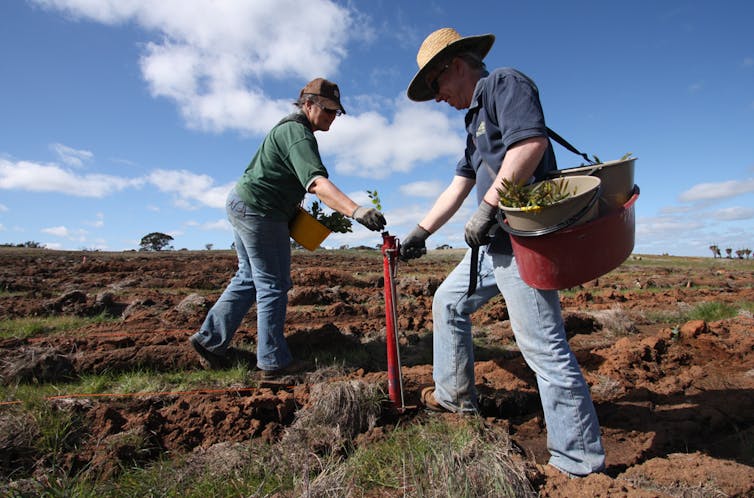
This is how carbon farming works. Farmers plant trees on abandoned farmland. The trees take in carbon from the atmosphere as they grow, acting as a natural sink to offset some emissions. For farmers, these carbon-storing plants pay off with carbon credits.
It sounds simple. But in recent years, the technique has come under fire over claims the approach is not delivering the carbon credits required to offset Australia’s carbon emissions.
This comes amid a broader crisis of confidence in carbon offsets and credits.
As a restoration scientist, I believe it’s good the industry gets more scrutiny. But we should not write off carbon farming. If done properly, carbon farming can also restore lost habitat and help tackle the global biodiversity crisis. As Earth loses more and more species, large-scale restoration is now essential.
We know keeping existing habitat and restoring degraded land to habitat will benefit 86% of the over 1,300 threatened species in Australia. At one well-run carbon farming initiative in southwestern Australia, for instance, we saw a rare malleefowl – a bird that is exceptionally fussy about where it lives.
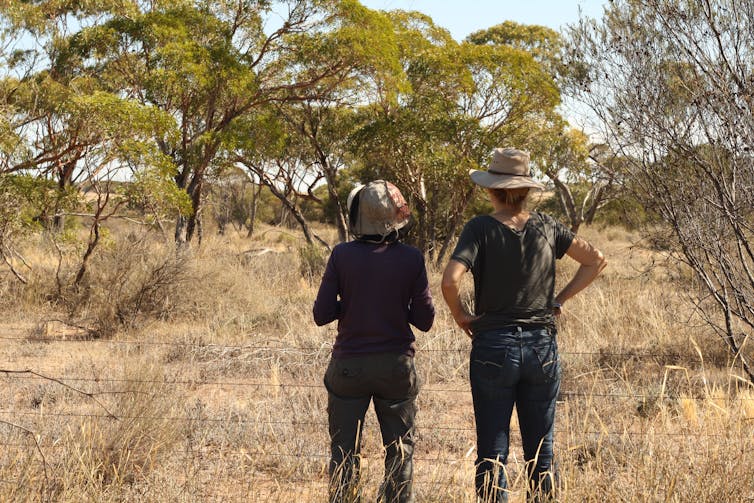
Carbon Farming Can Be A Win-Win – If Done Right
There are good and bad ways to do carbon farming. It’s wrong to claim credits for the growth of native remnant vegetation caused by rainfall, for instance, rather than regrowth after ending livestock grazing or other deliberate human intervention. It’s also wrong to claim credits for “avoided deforestation” – leaving vegetation intact when it was never intended to be cleared. We should also avoid planting trees in grasslands, which have their own set of species and should not be replaced.
Some carbon farming efforts have been run like plantations, where you plant a single fast-growing species such as blue mallee. The assumption here is monocultures like this store more carbon than a mix of species.
But we and other researchers have found this isn’t the case. Planting a diverse range of trees – like in a real forest – can store just as much carbon as monocultures.
Shrubs store less carbon than trees but play an important role in restoration. Their tangle of branches and leaves can offer safe harbour for smaller birds, for instance. Shrubs also boost projects’ resilience to drought and fire as they respond differently, which helps in recovery.
There would be no penalty to farmers for planting shrubs if the government’s planned nature repair market comes into force. Biodiverse projects could earn both carbon and biodiversity credits.
This would open the door to a win-win. Carbon-farming efforts could double as nature restoration projects, if we avoid tree monocultures and focus on restoring biodiversity while storing carbon. Australia has 13 million hectares of degraded land, meaning there’s plenty of room for restoration without taking farmland or compromising agricultural production.
Australia Could Benefit
As critics of carbon farming have pointed out, carbon credits from tree planting can be rubbery. But we shouldn’t tar all projects with the same brush.
In Australia, a number of companies are offering high-integrity carbon credits from biodiverse native tree planting projects, such as Carbon Positive Australia and Greening Australia.
Nature restoration is likely to become more attractive to investors because of the potential for growth in natural capital and employment.
As much as restoration is needed, so too is ongoing care such as feral animal control and leaving remnant vegetation intact.
Climate change is, unfortunately, threatening the environmental restoration which can help reduce its effects. In dryland Australia, drought makes it harder for seedlings to survive and for trees or shrubs to grow well even once established.
While many of Australia’s native plants are tough enough to weather fires, more frequent fires make it harder to bounce back. Plants need time between fires to grow rootstock and develop seed banks.
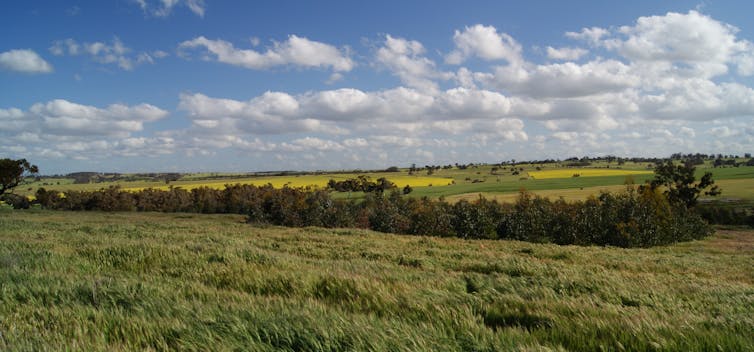
Biodiversity Matters
When we talk about biodiversity, we’re talking about the richness of life.
To date, Australia’s carbon farming efforts vary a great deal in how they protect biodiversity. Think of the difference in walking through a blue mallee or sugar gum plantation – where there are few birds or other species – compared to walking through a patch of native forest. Some carbon farms can be diverse.
Restoration efforts which attract more species will come to function more like a true native ecosystem typical of their region.
This is not to say restoration work is easy. Turning a weed-filled paddock worn down by decades of agricultural use is tough. Even native species such as kangaroos and emus can become challenges by eating seedlings.
Treating experimentation as part of practice and publicly reporting successes and failures can help the industry progress. For instance, our restoration research has found native shrubs return if given the chance – but not understorey species.
In Defence Of Carbon Farming
Carbon farming is new. While some efforts may well be aimed at gaming the system, there are many others genuinely seeking ways of using nature to store the carbon we’ve released into the atmosphere. As this new approach progresses, there will be failures. But a failure is not necessarily greenwashing.
And as Australia, like many other nations, sets ambitious restoration targets to protect 30% of land and sea by 2030, we will need to experiment, innovate, work alongside Traditional Owners and plan to be there for the long term.
We are already seeing hopeful signs restoration work does yield benefits for at least some species, such as ants and woodland birds.
Restoration can work: for us, for climate and for our species. Let’s make sure it does work. ![]()
Rachel Standish, Associate Professor, Murdoch University
This article is republished from The Conversation under a Creative Commons license. Read the original article.
Our new high-resolution climate models are a breakthrough in understanding Australia’s future
Ralph Trancoso, The University of Queensland; Jozef Syktus, The University of Queensland, and Sarah Chapman, University of LeedsAustralia’s climate, already marked by extremes with bushfires, heatwaves, storms and coastal flooding, is only set to worsen with the growing effects of climate change.
Disasters like the Black Summer bushfires of 2019–20 and the 2022 eastern Australian floods are likely to become more frequent and intense.
If carbon emissions continue at the current rate, climate change may make Australia unbearable for future generations. It’s a confronting outlook, and we need better tools to understand future impacts so we can adapt to them.
In our new research, published in the journal Earth’s Future, we have “downscaled” the latest global climate models to a 10-kilometre resolution across Australia. Having such a high resolution significantly enhances current global projections, with great improvements in projecting temperature, precipitation and extreme weather patterns for Australia.
Our new dataset is very useful. It provides scientists, policymakers and stakeholders with a valuable tool for comprehensively evaluating the potential impacts of climate change across Australia.
Why Do We Need High-Resolution Climate Projections?
Climate models are key tools for understanding future climate risks. Current global climate models have a coarse resolution of 50–200km. This makes them less suitable for local adaptation. Regional climate models add locally relevant details, such as mountainous, coastal and urban regions.
For example, a high-resolution photo of a city lets you zoom in on the small details, such as people and vehicles. Likewise, high-resolution climate projections enable climate scientists to better simulate specific details such as storms and urban heat. They also help to track weather events like tropical cyclones – a meaningful refinement to understand local impacts of climate change.
This is why the Australian Royal Commission has recommended that future natural disaster risks are informed by high-resolution climate projections.
High-resolution models also match up much better with real-world local geographical features such as mountains. This is important, as mountains play a role in both temperature and rainfall.
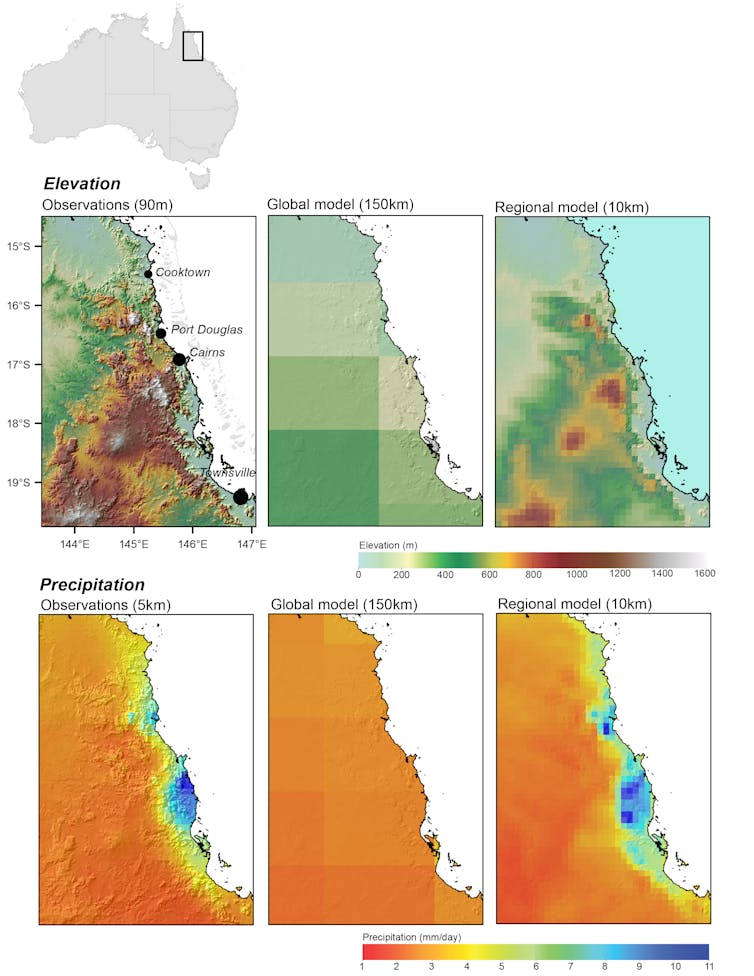
What The New Projections Show For Australia
To produce high-resolution projections for Australia, we tapped into the most up-to-date climate model dataset that’s coordinated by climate scientists globally. This is known as the Coupled Model Intercomparison Project, or CMIP6 for short.
The full CMIP6 dataset comprises hundreds of model simulations. As climate modelling is computationally expensive, we can’t downscale them all. Instead, we evaluated them to find the models that best represent Australia’s climate but also retain nearly a full range of future climate impacts.
This resulted in a set of 15 downscaled models and three emissions scenarios representing low, intermediate and high emissions trajectories in the future.
Ours is the largest downscaled set of projections produced for Australia to date. The range of emissions scenarios is important for studies evaluating the impacts of climate change.
We evaluated our high-resolution projections by comparing their historical component (that is, the period between 1980 and 2010) to records measured at weather stations around Australia over that time. We examined temperature and precipitation (rain and snow), including their distribution, annual cycles and extremes.
Overall, we found our downscaling produced major improvements in how accurate the projections were. This was especially true for minimum temperature, which is important for looking at the impacts of heatwaves – high night-time temperatures can lead to heat stress and even deaths.

We also looked at whether our models accurately represented day-to-day observations – that is, how well they matched up with actual weather recordings. The biggest difference came when looking at extremes (either very high or very low values), with a 142% improvement in representing minimum temperatures and an 87% improvement in representing winter maximum temperature.
Our models also worked well for precipitation. Predicting the number of days with no rain, as well as heavy rain days, is usually tricky for most models. Downscaling improved representation of dry days by 46% and extreme rain by 45%. This means we’ll have more reliable models when examining impacts from events like floods and droughts.
How Will This Be Useful?
The new projections provide more accurate data across Australia, but particularly in the mountains and densely populated coastal areas. This is important for disaster planning, preparedness and response. For example, in South East Queensland the improvements reached an impressive 150%.
The new data is not only more accurate, but offers a significantly clearer picture of the climatic future for densely populated regions. We can now have future climate information for shires and towns – an important step towards adaptation.
Downscaled climate projections based on the previous global suite of models have been used in Australia to understand future heatwaves, severe wind, drought and flood risks.
Our new high-resolution dataset, based on the latest global models, provides scientists and stakeholders with a solid ground to support adaptation policies, inform communities, and build resilience and preparedness for future climate hazards in Australia.![]()
Ralph Trancoso, Adjunct Associate Professor in Climate Change, The University of Queensland; Jozef Syktus, Professorial Research Fellow, School of the Environment, The University of Queensland, and Sarah Chapman, Visiting Research Fellow, University of Leeds
This article is republished from The Conversation under a Creative Commons license. Read the original article.
Denial is over. Climate change is happening. But why do we still act like it’s not?

Climate-fuelled disaster is now front-page news, as record-breaking floods, fires, droughts and storms keep arriving.
The damage done by climate change is systemic and pervasive, resonating through our communities, economies and environments. It manifests in many ways, from empty spaces in supermarket shelves to houses left unlivable after floods, anxious communities, collapsing ecosystems and emergency services stretched to capacity.
Climate researchers initially assumed that if you gave people the right information, we would act on it. Burning fossil fuels comes with severe consequences – so let’s phase out fossil fuels. But they found out very quickly this was not the case.
For many people, it triggered cognitive dissonance, where they knew climate change was happening but acted like it wasn’t. After all, many people still smoke, even though they know it is bad for their health. And many of us still fly to Italy – even though we know how many extra tonnes of carbon dioxide we put into the atmosphere.
But why is it so easy to understand but not act?

Change Seems Hard, Doing Nothing Is Easy
It’s because of public and private narratives we have grown up with. Our expectations of life are geared towards wanting comfort and stability.
This means not everyone has developed the ways of thinking needed to deal with the impacts (such as natural hazards) we are now facing. Sudden changes caused by these – such as the loss of a home – are almost invariably shocking and can create a sense of disbelief. How could this be? When do we get back to normal? Surely it won’t happen again?
Our research on systemic risks such as climate change adaptation suggests this disconnect is common. Because we expect and hope for stable normality, we find it hard to truly believe the changes we are seeing will continue.
There’s also a divide between who benefits and who pays. Your family trip to Iceland pays off for you in shared memories and good times. The damage in terms of emissions is spread across the globe. Often the damage done has less impact on the people who have done most to cause it, compounding inequality and eroding the ability of those most at risk to respond.
Adapting to the climate and working to reduce further heating can be an uncomfortable and at times painful process where we have to embrace and acknowledge our grief for the changing world. We’re often taught to avoid potentially dangerous or painful things – especially if they are unfamiliar. But now, doing what we’ve always done is not safe.
Then there are the limitations of individual action. No matter how committed you are to cutting your own climate impact, it makes very little difference if others aren’t doing the same.
Action needs to be collaborative and sustained over the longer term, favouring public good over individual vested interests and short term gains. The politicisation of action in Australia’s climate wars has polarised opinion and eroded trust in the research. It has also left some people feeling that their actions are too small to matter.
All of this means we can find it surprisingly easy to detach our own daily actions – driving to work, holidays in Queensland, watching Netflix – from the broader goals of getting emissions down to zero as soon as possible.
So How Can We Avoid Climate Hypocrisy?
Many of us understand the risks of climate change full well, but we do not accept the responsibility. That, in turn, means we may feel okay not to act. Or we may understand and accept the risk, but not have the resources or ability to act.
We know that presenting climate change as a problem without a solution or using fear tactics disengages and demotivates us. It can also feed anxiety, which undermines action.
So the first step to overcoming climate inaction is to identify where you can act directly, such as switching your second car to an e-bike, investing in solar panels, working on local re-vegetation projects or making climate-friendly consumer choices.

Where you have influence, apply this through voting, education or advocacy. Humble actions matter because they accumulate to create change.
This isn’t to say you should give up holidays. It is about making informed choices. Ending the burning of fossil fuels will take time and our choices will change as we transition away from this.
But doing something is always better than nothing. Active responses can help reduce climate anxiety and they are also the panacea for avoiding climate hypocrisy. And while large-scale policy responses are necessary, individual action and pressure can help speed up the shift.
Climate change isn’t just a problem for scientists, engineers and governments. We need both large-scale and small-scale action. As the costs of climate change escalate, we can no longer afford to know about climate change but not act. ![]()
Celeste Young, Collaborative Research Fellow, Sustainable Industries and Liveable Cities (ISILC), Victoria University and Roger Jones, Professorial Research Fellow, Victoria University
This article is republished from The Conversation under a Creative Commons license. Read the original article.
In September we went past 1.5 degrees. In November, we tipped over 2 degrees for the first time. What’s going on?
Andrew King, The University of MelbourneIn September, the world passed 1.5°C of warming. Two months later, we hit 2°C of warming. It’s fair to wonder what is going on.
What we’re seeing is not runaway climate change. These are daily spikes, not the long-term pattern we would need to say the world is now 2 degrees hotter than it was in the pre-industrial period.
These first breaches of temperature limits are the loudest alarms yet. They come as the United Nations Environment Program warns the world is still on a path to a “hellish” 3°C of warming by the end of the century.
But they do not signal our failure. The sudden spike in warming in 2023 comes from a combination of factors – climate change, a strong El Niño, sea ice failing to reform after winter, reduced aerosol pollution and increased solar activity. There are also minor factors such as the aftermath of the volcanic eruption near Tonga.
How Significant Are These Factors?
1. Climate change
This is by far the biggest factor. What many of us don’t recognise is how recent our intense period of emissions is. If you were born in 1983, fully 50% of all of humanity’s emissions have gone into the atmosphere since your birth. Human emissions and other activities have so far contributed about 1.2°C of warming.
Greenhouse gases trap heat, which is why the Earth is not a snowball. But the 2 trillion tonnes of fossil carbon we’ve taken from underground and put back in the atmosphere are trapping more heat. And more heat. And will continue to do so until we stop burning fossil fuels for heat or power.
2. El Niño
The El Niño-Southern Oscillation climate cycle in the Pacific has the biggest natural influence on climate. That’s because the Pacific is huge, accounting for 30% of Earth’s surface. When in the El Niño phase, the seas off South America heat up. This, in turn, usually makes average global temperatures hotter.
Right now, there’s a dangerous heatwave in Brazil, where heat and humidity combined makes it feel like 60°C. The intense heat contributed to the death of a fan at Taylor Swift’s Rio concert last week.
El Niño will likely peak in the next two months. But its effects may well persist throughout 2024, driving global average temperatures higher by perhaps 0.15°C.
3. Antarctic sea ice isn’t bouncing back
The declines in Arctic sea ice are well known. But now Antarctic sea ice, too, is failing to recover. Normally, the ring of frozen seawater around the ice continent reaches maximum extent in September. But this year’s maximum is well below any previous year.
As we enter summer, that means more dark water will be exposed. And since dark surfaces absorb more heat while white ones reflect it, it means still more heat will go into the oceans rather than back out to space.
4. Increased solar activity
Our Sun runs on a roughly 11-year cycle, going between lower and higher output. The solar maximum was forecast for 2025 and a clear increase is occurring this year. This brings spectacular auroras – even in the Southern Hemisphere, where residents have seen auroras as far inland as Ballarat, in Victoria.
Solar maximums add extra heat. But not much – the effect is only around 0.05°C, about a third of an El Niño.
5. The volcanic hangover
Normally, volcanic eruptions cool the planet, as their vast plumes of aerosols block sunlight. But the largest volcanic eruption this century near Tonga in January 2022 did the opposite.
That’s because the Hunga Tonga-Hunga Ha’apai volcano was under the sea. Its explosive force evaporated vast volumes of seawater – and water vapour is a greenhouse gas. While some sceptics like to point to this eruption as the root cause of our recent spike in warming, the Tonga eruption is a blip – it will add an estimated 0.035°C for about five years.
6. Cutting aerosol pollution
In 2020, new international shipping rules came into force, mandating low-sulphur fuels. This cut sulphur dioxide emissions by about 10%. That’s good for health. But aerosols in the atmosphere can actually block heat. Cutting pollution may have added to warming. But again, the effect seems small, adding an estimated 0.05°C of warming by 2050.
What Should We Take From This?
The climate is enormously complex. We should see the first day 2°C warmer than the same day in the pre-industrial period as a stark warning – but not as a sign to give up.
In short, this isn’t a step change. It’s a combination of factors which has driven this surge. Some of those, like El Niño, are cyclical and will switch back.
But as negotiators prepare for next week’s COP28 climate talks, it’s yet another sign that we cannot relent.
We are – at last – seeing signs of real progress in the clean energy and clean transport roll out. This year, we may even see emissions from power generation finally peak and then begin to fall.
So – we haven’t failed, yet. But we are on a rapidly warming planet – and we can now clearly see the effect, even in these new daily temperature records. ![]()
Andrew King, Senior Lecturer in Climate Science, The University of Melbourne
This article is republished from The Conversation under a Creative Commons license. Read the original article.
Concern for the Great Barrier Reef can inspire climate action - but the way we talk about it matters
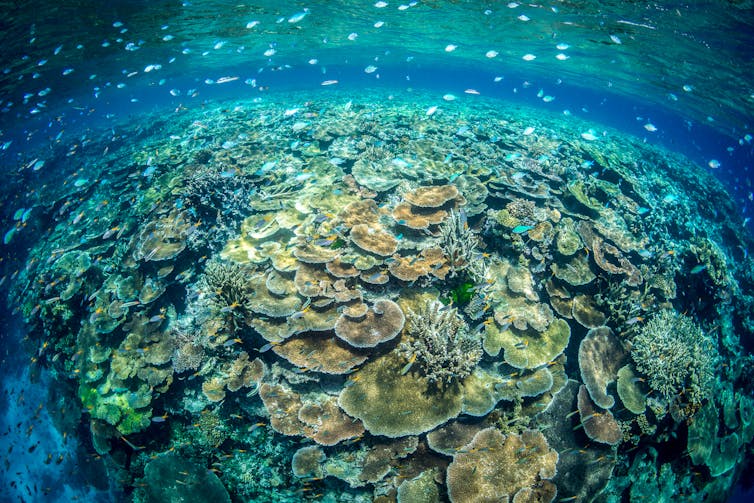
There’s no doubt you’ve heard the Great Barrier Reef is under pressure. The main culprit? Climate change. The main solution? An urgent reduction in greenhouse gas emissions and a shift away from fossil fuels.
Those who promote action to protect the reef therefore have a difficult task. How do we encourage more people to take action on climate change? Whether it’s reducing reliance on fossil fuels in our personal lives, or asking our government to transition from fossil fuels to renewables, what do people need to know, and how do we say it in a way that makes a difference?
Researchers in climate change communication have been grappling with these questions for decades. But we have something other communicators don’t – the reef itself.
In our new research we used experiments to show what many divers, tourism operators and local communities have known for decades – the wonder of the Great Barrier Reef inspires climate action. But it doesn’t just magically happen. The way we talk about it matters.
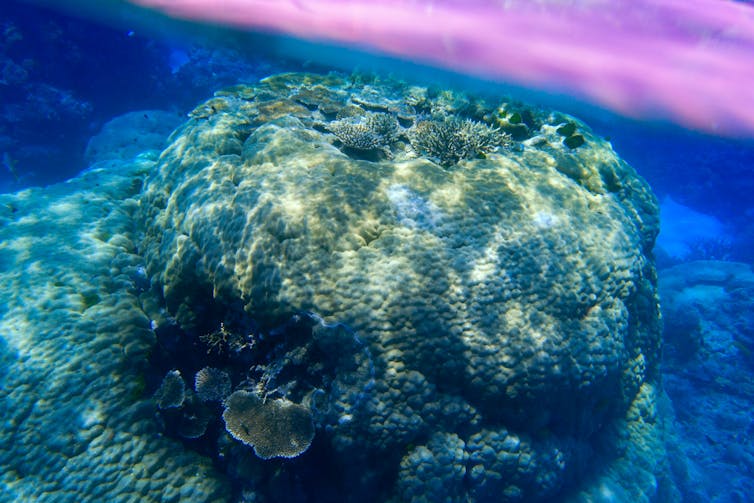
What’s Happening On The Great Barrier Reef?
Earlier this year the Bureau of Meteorology officially announced an El Niño weather event, which has already begun to bring hotter than average temperatures to much of Australia. But while Australia braces for a scorcher on land this summer, those working on the Great Barrier Reef are preparing for a marine heatwave.
The marine equivalent of bushfires, heat is set to wreak havoc on marine ecosystems all around Australia. For the Great Barrier Reef, this means increased risk of mass coral bleaching.
These events have occurred four times in recent years (2016, 2017, 2020 and 2022). Scientists expect mass coral bleaching will happen every year if we do not urgently reduce greenhouse gas emissions and eliminate the use of fossil fuels.
But while the science around the Great Barrier Reef is clear, the way we talk about it isn’t.
Different Messages About The Reef
We are constantly flooded with all kinds of information about the Great Barrier Reef. This can make it tricky for people to understand what is going on and what they can do to help.
Some communicators convey a sense of urgency by emphasising the “reef is dying”. Others warn against the use of apocalyptic-style messages, suggesting fear is an ineffective tool for motivating action. These commentators suggest stories of resilience, restoration and recovery can strengthen motivation and hope. But what really works? How do we talk about the reef in a way that motivates action?
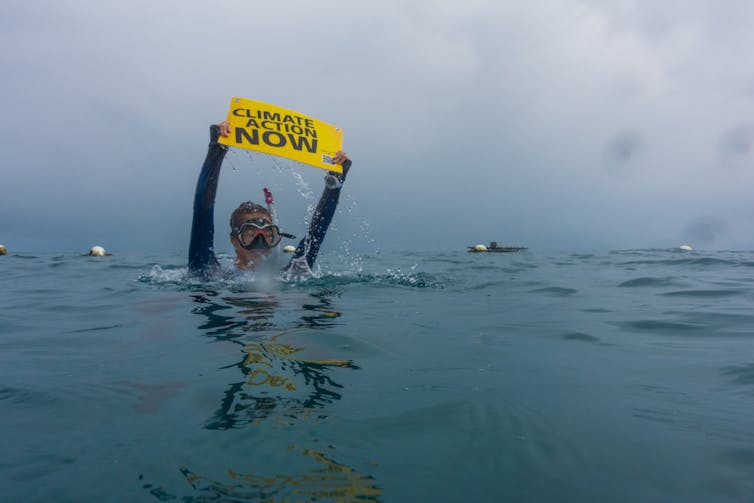
Which Messages Work? An Experiment
To find out how best to inspire action, we provided 1,452 Australians with one of eight different messages about climate change and/or the Great Barrier Reef. We then looked at which messages were most likely to increase engagement in a range of climate actions.
We found climate messages focusing on the reef were more effective than generic climate messages, compared to a control that included an unrelated message or no message at all.
This suggests the reef itself is a valuable tool for motivating climate action. This was particularly true when we emphasised our collective potential to protect the reef, using language such as “together we can”, and asked people to take action by using their voice. That is, letting their friends, families and politicians know they support stronger action on climate change.
We also found sadness is a necessary ingredient, and there is no need to shy away from the reality of coral bleaching or fear provoking negative emotions. When exploring why these messages focusing on the reef were more effective, we found the effect was largely due to feelings related to sadness, worry and anxiety.
But here’s the rub. For reef messages to work, we found they must include tangible, specific and relevant calls to action. In other words, highlighting the reef is the hook, but we need to show people what they can do to help.
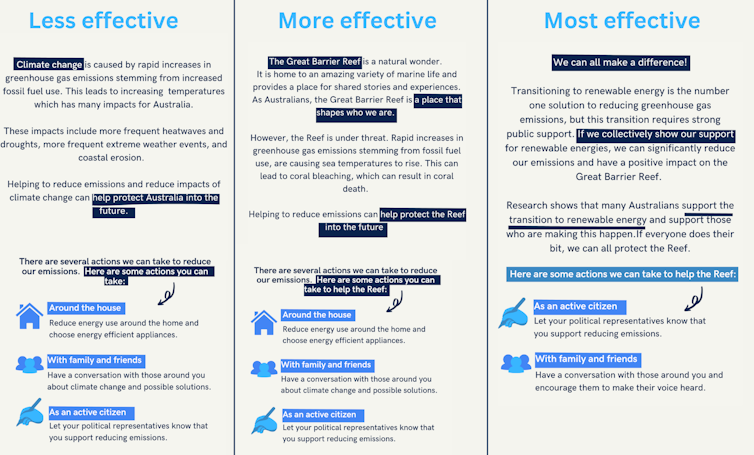
Preparing For A Hot Reef Summer
We can’t control the heatwaves or the headlines coming this summer, but we can do our best to leverage this opportunity to motivate widespread action for the reef.
Here’s how you can talk about the reef this summer:
highlight the iconic nature of the reef and how it is a part of who we are
emphasise collective and motivational language (such as “together we can”) instead of personal and restrictive language (such as “you can reduce”)
state the problem (including the cause – burning fossil fuels) but don’t focus too much on explaining the threat. It’s time to talk about action
avoid broad policy statements such as “to protect the reef, we need to keep global warming to 1.5 degrees” unless they are followed by more specific calls to action
include very specific calls to action. People want to know exactly what you want them to do. Examples include encouraging people to commit to finding ways to reduce their personal carbon footprint, join a climate action group, or have a conversation about climate change with at least one family member or friend
be careful, too many calls to action can be overwhelming. Aim to give one to three options – a mix of easy and difficult actions tends to work best.
Of course, don’t forget to remind people they don’t need to live near the reef to make a difference – people can demand and support climate action from anywhere.![]()
Yolanda Lee Waters, PhD Candidate, The University of Queensland and Angela Dean, Lecturer, School of Agriculture and Food Science & Centre for Biodiversity and Conservation Science, The University of Queensland
This article is republished from The Conversation under a Creative Commons license. Read the original article.
Lizards, fish and other species are evolving with climate change, but not fast enough
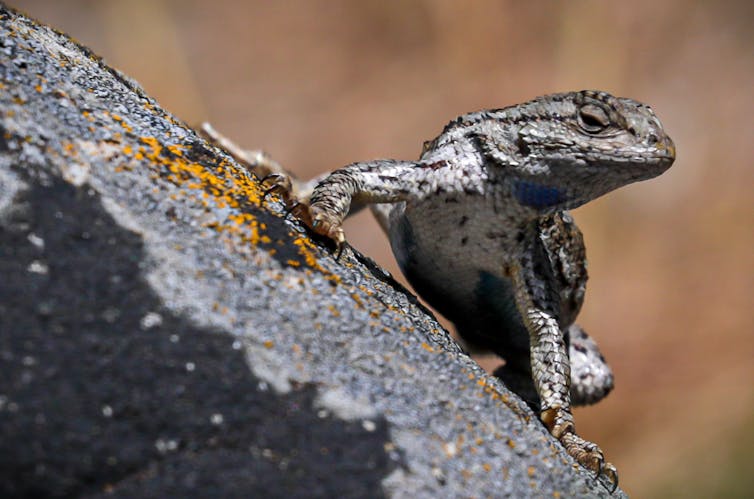
Climate change is threatening the survival of plants and animals around the globe as temperatures rise and habitats change.
Some species have been able to meet the challenge with rapid evolutionary adaptation and other changes in behavior or physiology. Dark-colored dragonflies are getting paler in order to reduce the amount of heat they absorb from the sun. Mustard plants are flowering earlier to take advantage of earlier snowmelt. Lizards are becoming more cold-tolerant to handle the extreme variability of our new climate.
However, scientific studies show that climate change is occurring much faster than species are changing.
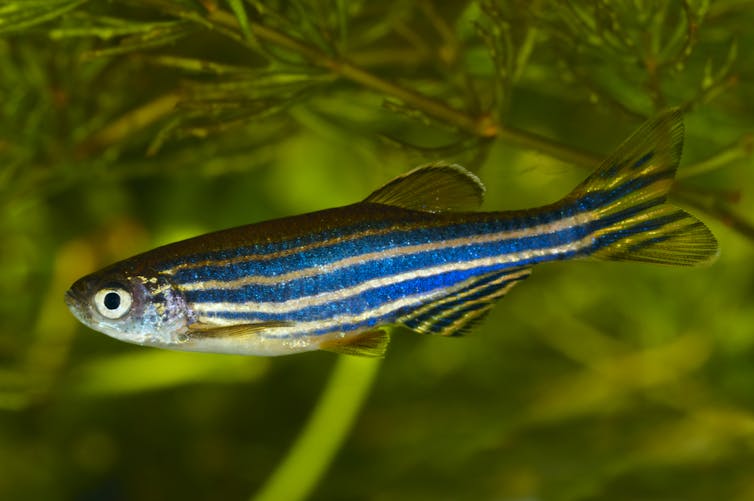
What Is Evolutionary Adaptation?
The word “adaptation” is used in many ways by climate scientists, but it has a very specific meaning to biologists: It refers to genetic changes that are passed on from one generation to the next and improve a species’ ability to survive in its environment.
These genetic modifications make evolutionary adaptation different from “acclimation” or “acclimatization,” which involve advantages that are not passed on to offspring. For example, when people move to high-altitude cities, they start producing more red blood cells as they acclimate to the low oxygen.
All over the world, plants and animals have adapted to many different warm and dry habitats, prompting scientists to question whether species might also adapt to our rapidly changing climate, too.
Thus far, the answer seems to be no for most species.
Evolving, Fast And Slow
A recent study of the populations of 19 bird and mammal species, including owls and deer, shows one potential barrier to adaptation.
In animals that take several years to reach breeding age, the climate has already shifted by the time their offspring are born. Genes that gave the parents an advantage – like hatching at exactly the right time or growing to the best size – are no longer as beneficial for the offspring.
Populations of these slow-maturing animals are adapting to climate change, but not enough during each generation to thrive in the changing conditions. In fact, the rate of evolution is so mismatched to the rate of global warming that the study’s authors estimate that nearly 70% of the local populations they studied are already vulnerable to climate-driven extinction over the coming decades.
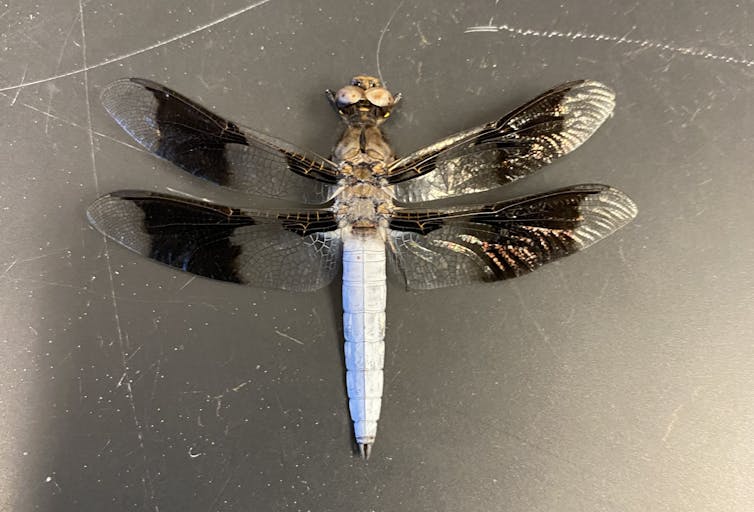
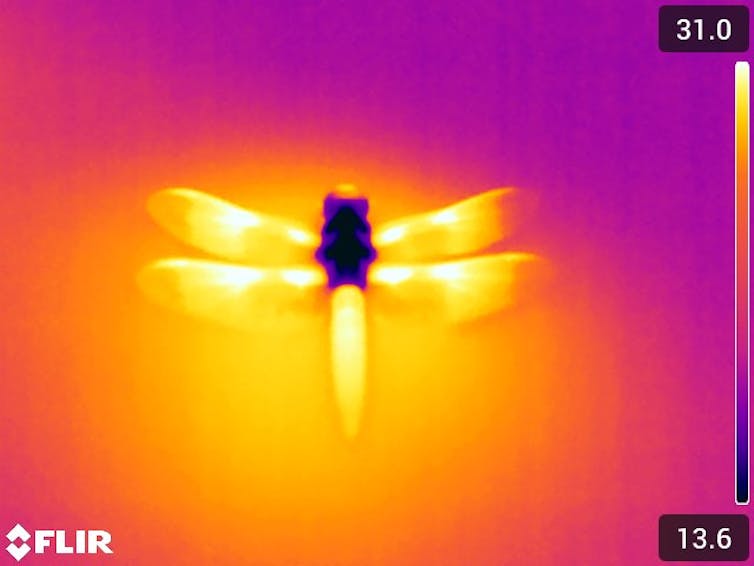
Small-bodied animals, such as many fish, insects and plankton, typically mature quickly. Yet, recent research on small fish and a type of fast-maturing plankton called a copepod revealed another hurdle for rapid genetic adaptation to climate change.
Many species possess genes that permit them to live in environments that are 1 to 2 degrees Celsius (about 2 to 4 Fahrenheit) warmer than today, but new genetic mutations must arise to enable survival if climates reach 4 to 5 C (about 7 to 9 F) warmer, as is possible in some regions, particularly if greenhouse gas emissions continue at a high rate.
To test species’ resilience, scientists warmed populations of these fast-maturing species over many generations to observe their genetic changes. They found that both the copepods and the small fish were able to adapt to the first couple degrees of warming, but populations soon went extinct above that. This was because genetic mutations that increased their ability to live in hotter conditions occurred at a slower rate than the temperatures rose.
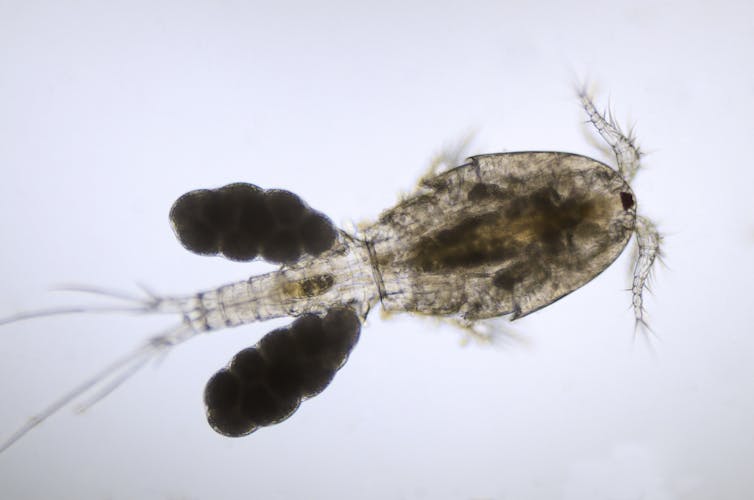
Cold-blooded species, such as lizards, frogs and fish, are especially vulnerable to climate change because they have a limited capacity to regulate their own body temperatures. Their ability to evolve in response to climate change is expected to be critical for their survival.
However, rapid adaptation to climate change often comes at a cost: Populations get smaller due to the deaths of individuals that cannot tolerate new, hotter temperatures. Therefore, even if species do evolve to survive with climate change, their smaller populations may still go extinct due to problems such as inbreeding, harmful new mutations or plain old bad luck, such as a disease epidemic.
In a now-classic study, researchers studying lizards in Mexico discovered that the high death rates of just the heat-sensitive individuals – representing only a subset of the entire population – caused 12% of all lizard populations in Mexico to go extinct between 1975 and 2009. Even with some heat-tolerant adult lizards surviving in each population under the warmer conditions, the researchers estimated climate change would kill so many heat-sensitive adults within each population that 54% of all populations would go extinct by 2080.
Evolutionary Adaptation Isn’t Species’ Only Option
Another way species adjust to rising temperatures is acclimation, sometimes called “phenotypic plasticity.” For example, great tits in the U.K. – small birds that are common in yards and forests – lay their eggs earlier in warmer years so that their nestlings hatch right as the winter weather ends, no matter when that happens.
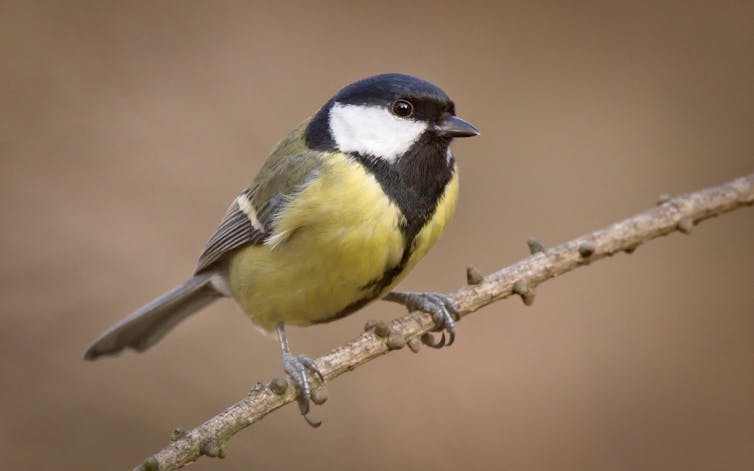
However, a recent analysis of more than 100 beetle, grasshopper and other insect species all over the world found that acclimation may not help those species enough. The study’s authors found that the species they reviewed gained an average of only 0.1 C (about 0.2 F) greater heat tolerance when acclimating to 1 C (about 2 F) warmer air temperatures during their development. Thus, the rate of global warming seems to be outstripping species’ abilities to acclimate, too.
Plants and animals could also escape the impacts of global warming by migrating to cooler habitats. A global analysis of more than 12,000 different plants and animal species recently showed that many species are migrating toward the poles fast enough to keep pace with rising temperatures, and many tropical species are moving upslope to higher elevations as well.
Nonetheless, migration has its limits. Research shows that tropical birds that already live high in the mountains could be doomed because there is no room for them to migrate any farther upward. Tropical species, therefore, may be on what the authors call an “escalator to extinction.”

High-latitude and high-elevation habitats also present numerous challenges for species to overcome besides temperature. Our own research across 800 species of insects all over the Earth shows that butterflies, bees and other flying insects are especially hindered from migrating to higher elevations because there is not enough oxygen for them to survive.
Many Species Lack Obvious Climate Strategies
Overall, evolutionary adaptation appears to help lessen the impacts of global warming, but the evidence thus far shows that it is insufficient to overcome current rates of climate change. Acclimation and migration provide faster solutions, but research shows that those may not be enough, either.
Of course, not all evolution is driven by warming temperatures. Plant and animal species appear to be also gradually adapting to other kinds of environments, including human-created ones like cities. But the fast pace of global warming makes it one of the major threats that species must respond to immediately.
The evidence indicates that humanity cannot simply assume that plants and animals will be able to save themselves from climate change. To protect these species, humans will have to stop the activities that are fueling climate change.![]()
Michael P. Moore, Assistant Professor of Biology, University of Colorado Denver and James Stroud, Assistant Professor of Ecology and Evolution, Georgia Institute of Technology
This article is republished from The Conversation under a Creative Commons license. Read the original article.
The government will underwrite risky investments in renewables – here’s why that’s a good idea
Tony Wood, Grattan InstituteClimate Change and Energy Minister Chris Bowen today announced a scheme to underwrite the risk of investing in new renewable energy generation and storage.
The expansion of the national Capacity Investment Scheme follows a successful pilot study with New South Wales. The government paid A$1.8 billion for just over a gigawatt of capacity, through a combination of batteries and other storage.
Bowen says the scheme “underwrites new renewable generation and storage, providing certainty for renewable investors and cheaper, cleaner energy for households and businesses”. And if all goes well, the scheme will provide a financial return to taxpayers.
Most of the country still relies on dirty coal-fired power. Several power stations have already closed and many more have flagged intentions to close. The ageing fleet is also unreliable, causing power outages. Before coal exits the system, we need to replace it. This scheme will ensure that happens well in advance.
What’s The Problem?
The government was not on track to achieve 82% renewables by 2030. It was clearly under pressure to do something about that. And now it has.
If what’s been announced today actually is built, then it’s likely we will be able to hit the target. The amount of new capacity being considered will certainly make a huge difference. So that’s 23 gigawatts of new variable renewables such as wind and solar, plus 9GW of “dispatchable” capacity, which involves storage – mainly batteries.
If the scheme does its job, it’s also likely to accelerate the closure of coal-fired power stations.
That will help us to reduce emissions but it also raises the risk of blackouts from grid instability. That’s a worry as we head into a long, hot summer.
We need to close the gap between closure of coal-fired power and new generators coming online to firm up the system.
Today’s announcement takes us to a total of 32GW nationally. Compare that to the total generation capacity of the National Electricity Market at about 65GW.
How Does The Capacity Investment Scheme Help?
Under the original scheme, the federal government has begun to run competitive tenders seeking bids for clean renewable generation projects.
Under the expanded scheme, successful projects will be offered contracts in which a revenue floor and ceiling are agreed with the Commonwealth.
This scheme will be rolled out with regular six-monthly tenders from the second quarter of the 2024–25 financial year through to 2027.
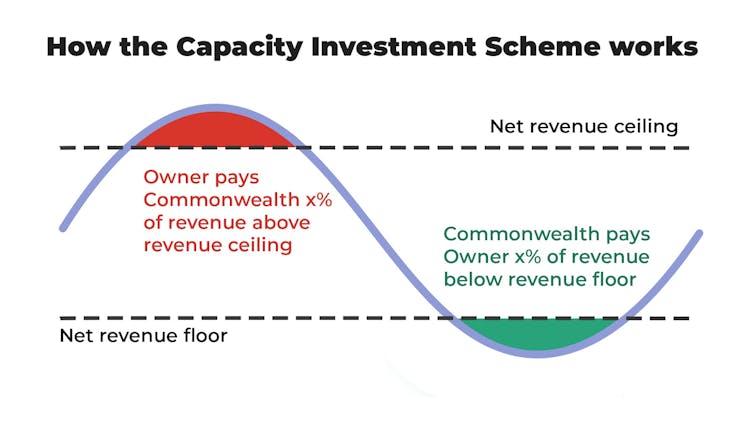
In principle, it’s a good idea for two reasons. First, it provides a much greater level of certainty for investors. Difficulty getting people to invest in the renewable energy sector is one of the reasons why we’re not on track. In this case the government will be paying directly, holding auctions to guarantee a certain revenue for those who invest in these projects. In other policy instruments it’s really the consumer who ends up paying.
The way it’s done, through “contract the difference”, is pretty sensible, in that the government is only underwriting the risk, rather than the full amount of money. If the revenue the project actually generates in the market is within the agreed range, the government doesn’t pay anything.
But if the people who invested are not getting the agreed amount of financial return, the government will pay the difference. Or most of the difference anyway, through a formula yet to be worked out – but the government will certainly be contributing towards that difference.
On the other hand, it’s not a one-sided arrangement. If the project generates more revenue than the agreed ceiling, that money goes back to the government. So the government’s not signing up to an open chequebook.
Second, this approach puts all the responsibility for reliability of the grid in the hands of the states. That is, dealing with the closure of the coal plants and making sure there’s enough capacity to replace it.
That’s probably a good idea, because some of the states have different views about how reliability should be addressed. Some would not want to see any gas-fired generation being used to back up renewables; others may be happy to have gas-fired power or even a hydrogen power station to back up reliability. It will be up to them now.
Alongside these steps federal and state governments still need to step up the pressure on building transmission lines to connect all of this new renewable capacity to the grid. However, today’s announcement does nothing to address how this will be done.
What Will This Do To Power Prices?
I don’t expect it to make much difference to prices. While new renewables themselves are cheap, the transmission and storage needed to back them up will not be. So they’ll probably largely balance each other out.
The bottom line is we will be getting a more reliable and lower-emissions electricity sector at a relatively low carbon cost. ![]()
Tony Wood, Program Director, Energy, Grattan Institute
This article is republished from The Conversation under a Creative Commons license. Read the original article.
Tropical forest loss from growing rubber trade is more substantial than previously thought – new research
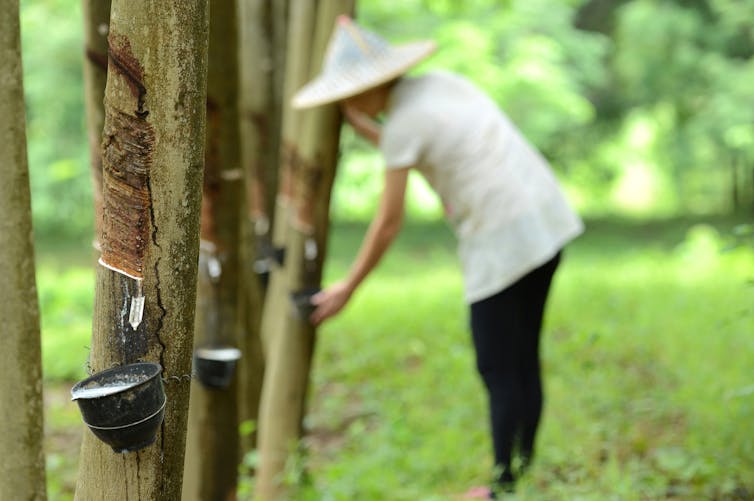
Over 4 million hectares of tree cover – an area equivalent to the size of Switzerland – may have been cleared to make space for rubber plantations since the 1990s. Out of all the rubber planted, 1 million hectares may have been established in key biodiversity areas – sites that contribute significantly to biodiversity in terrestrial, freshwater and marine ecosystems.
These are the findings of our recent research, which mapped the conversion of land to rubber tree plantations across south-east Asia. The likely pace of forest loss that we found surpasses previous estimates.
The global demand for natural rubber, which is found in thousands of products including vehicle and aeroplane tyres, is increasing. In separate research, published in July 2023, we estimated that between 2.7 million and 5.3 million additional hectares of plantation area could be needed by 2030 to fulfil this additional demand. This is a concern. Research has found that rubber plantations support nowhere near as much biodiversity, nor do they contain as much carbon, as natural forests.
Most natural rubber is made by extracting latex – the liquid sap – from the Hevea brasiliensis tree in a process called “tapping”. As a tropical species, the places suitable for Hevea brasiliensis cultivation coincide with some of the world’s most biodiverse regions. Thailand and Indonesia, for example, are the world’s leading rubber producers.

Rubber’s Impact On Forests
We reviewed more than 100 case studies to understand what types of land are being converted to rubber. In many cases, rubber replaced natural forests. But we also noted instances of other plantation types and agricultural systems transitioning to rubber.
We then examined national statistics regarding the extent of rubber plantations and their productivity per hectare. Our findings revealed a global trend of expanding rubber areas in producer countries, coupled with static or declining yields.
Low yields are partly due to tapping less frequently in countries where prices are relatively low – though they are also probably caused by suboptimal tapping practices. As existing rubber stockpiles are eventually exhausted, prices should theoretically increase again, potentially leading to more frequent tapping of plantations that are currently not or only infrequently tapped. However, past trends suggest that more land will be established for rubber cultivation to meet the growing demand, rather than using existing plantation land more effectively.
Ivory Coast in west Africa emerged as a new hotspot for expanding rubber plantations. These plantations seem to be displacing cocoa agroforests (where trees or shrubs are grown around or among other crops or natural vegetation) in the region.
Using cutting-edge analysis of satellite data, which was based on the unique timing of rubber tree leaf drop compared to other tree cover, we more recently generated high-resolution maps of rubber distribution and the associated deforestation.
Our mapping revealed Cambodia as a country of particular concern, with 40% of rubber plantations associated with deforestation. These plantations were often located within protected areas.
Supporting Livelihoods And Economies
Most rubber that is produced in Asia is grown by smallholder farmers – people who farm less than five hectares of land. Rubber production thus forms the basis of many regional economies and supports the livelihoods of millions. Producing rubber sustainably in existing plantations, and avoiding further plantation expansion, is a critical part of protecting forests and supporting people.
In June 2023, the EU adopted a new regulation to curb the EU market’s impact on global deforestation. Alongside several other commodities, rubber is covered by this legislation. Any company looking to sell products containing these commodities on the EU market can only do so if suppliers can show that they were not sourced from land deforested after December 2020.
On the one hand, there is a risk that the new law may inadvertently marginalise rubber smallholders. Rubber is typically collected by middlemen and can change hands several times before reaching a processing facility. Smallholders will also largely be unaware of the new regulations and often may not have documentation showing their official land tenure.
Given the complexity of tracing smallholder rubber, larger tyre manufacturers and other rubber consumers may choose to source their rubber from industrial plantations that have the resources to prove that their rubber is compliant with the EU’s new regulation.

Opportunities For Farmers
But, accompanied by the need to trace rubber supply, the new regulation could also offer opportunities to help smallholders improve their rubber production methods. Our research from July 2023 found that reducing land availability for rubber expansion could indirectly drive increases in production efficiency on existing land.
There is evidence that this is taking place in Mato Grosso – the largest soy and cattle-producing state in Brazil. Double cropping (where several crops are planted in the same area and in the same crop year) rates were significantly higher in regions where forest conservation policies were more stringent.
Natural rubber should not be demonised. Rubber plantations have the potential to sequester carbon and continue contributing to the long-term wellbeing of smallholder farmers.
There is also evidence suggesting that rubber agroforests can support at least some biodiversity. In a study published in 2019, we found a higher abundance of butterflies in rubber agroforests compared to monocultures. The presence of birds also increased in tandem with the height of herbaceous vegetation within rubber plots.
But this does not mean that the growing demand for natural rubber should be accepted as inevitable. A clear approach to reducing the adverse effects of rubber on forests and biodiversity is to curb our use of cars, especially in more developed regions where efficient public transport systems are, or can be, established. This would not only address carbon emissions from fossil fuels but would also reduce demand for rubber.

Don’t have time to read about climate change as much as you’d like?
Get a weekly roundup in your inbox instead. Every Wednesday, The Conversation’s environment editor writes Imagine, a short email that goes a little deeper into just one climate issue. Join the 20,000+ readers who’ve subscribed so far.![]()
Eleanor Warren-Thomas, Lecturer in Conservation and Forestry, Bangor University and Antje Ahrends, Head of Genetics and Conservation, Royal Botanic Garden Edinburgh
This article is republished from The Conversation under a Creative Commons license. Read the original article.
Sails and satellite navigation could cut shipping industry’s emissions by up to a third
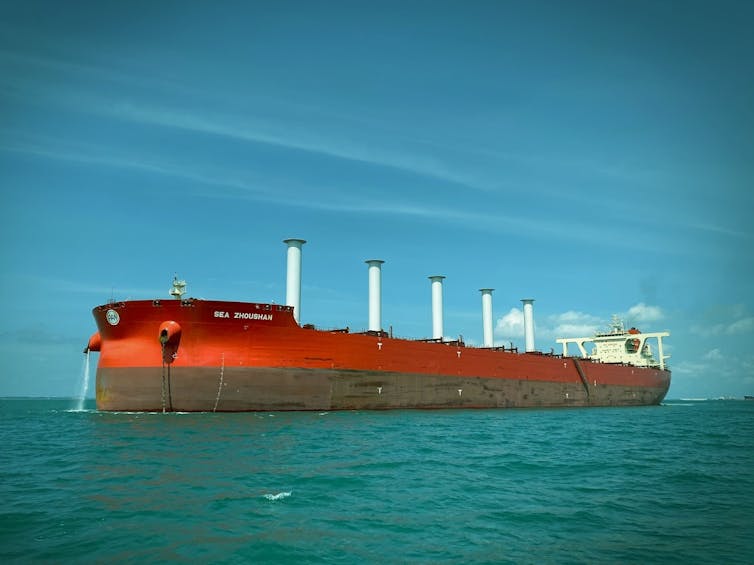
In the vast expanse of the world’s oceans, a transformation is underway.
The international shipping sector, made up of thousands of massive cargo ships laden with many of the goods we buy, emits carbon dioxide (CO₂) roughly equivalent to the entire country of Germany.
Our research emphasises the need for immediate action. Reducing shipping emissions by 34% by 2030 is necessary to stay on course with the Paris Agreement’s 1.5°C goal. But with low-carbon fuel pipelines unlikely to be available at the necessary scale until at least the 2030s, how can the industry meet its short-term target?
Enter a new solution with ancient origins: sails. Not the billowing canvases of centuries past but high-tech systems capable of harnessing renewable wind energy to supplement the propulsion from a ship’s engine.
A number of advanced sail designs are gaining the attention of shipping firms. Two contenders include Flettner rotors, cylinders that spin to generate propulsion, and “wingsails”, which resemble aeroplane wings and are derived from designs used in yacht racing.

Wind propulsion allows ships to use less fuel and so emit less greenhouse gas. However, in our new paper, we found that the real opportunity to slash emissions from shipping this decade lies in combining sails with optimal routes plotted by satellite navigation systems.
An Old Idea With New Technology
Optimised routing is a familiar concept to most of us. You’ll have used it by typing a destination into Google Maps and allowing its algorithms to calculate the quickest way for you to arrive at your destination.
The process is similar for ships. But instead of finding the quickest journey, the software models the ship’s performance in water to calculate routes and speeds that minimise fuel use.
With optimised routing and sails, ships can deviate from their standard course to seek out favourable winds. The ship may travel a longer distance but the extra power gained by the sails limits the ship’s fuel consumption and reduces the total emissions over the full journey. The software only suggests routes that guarantee the same arrival time, keeping the ship to its original schedule.
We used a computer model simulation of a cargo vessel with four sails, each taller than Brazil’s Christ the Redeemer statue at 35 meters high. By calculating the fuel consumption of this large bulk carrier ship on over 100,000 journeys spanning four years and covering 14 shipping routes worldwide, we found that sails can cut annual carbon emissions by around 10%.
The true promise of sails unfolds when optimal routing is used, increasing annual emission cuts to 17%.
Routes with ideal wind conditions have even greater potential. The most promising are typically those far from the equator, such as transatlantic and transpacific crossings, where strong winds can fill large sails. By taking advantage of wind patterns moving across the ocean on these routes, sails and optimised routing can cut annual emissions by over 30%.
Take the journey between the UK and the US as an example. A ship setting out on this voyage will typically experience strong headwinds which generate drag and push the ship backwards, meaning more fuel must be burned to maintain the same forward momentum. But by using sails and optimised routing software on this crossing, ships can avoid these headwinds and steer into more favourable winds.
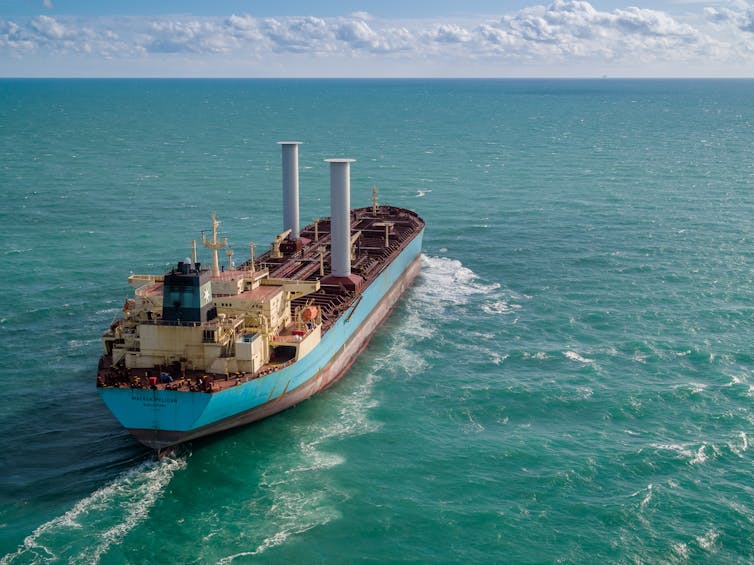
On the return journey, the ship would typically experience strong winds from behind and the side, which would fill the sails and push the ship on. With optimised routing software the ship can find even stronger winds and fine-tune its direction for the sails to maximise propulsion.
Keeping The 1.5°C Target Afloat
The International Maritime Organization (the UN agency responsible for environmental regulation in shipping) has a target of cutting greenhouse gas emissions by 20%-30% by 2030. The Paris Agreement’s 1.5°C target requires even deeper cuts.
Our research shows that cuts to CO₂ of this magnitude are possible this decade using wind propulsion and optimised routing on promising routes. Achieving this will oblige the shipping industry to deploy existing technologies and practices and shift its focus from fuel alone, as zero-carbon fuels will take longer to develop.
As we sail further into the 21st century, our research delivers a clear message to the shipping industry: substantial carbon reductions are feasible this decade. Here is an old idea, one that integrates technology with tradition, that can steer international shipping towards its climate goals.

Don’t have time to read about climate change as much as you’d like?
Get a weekly roundup in your inbox instead. Every Wednesday, The Conversation’s environment editor writes Imagine, a short email that goes a little deeper into just one climate issue. Join the 20,000+ readers who’ve subscribed so far.![]()
James Mason, Visiting Academic in Decarbonisation, University of Manchester; Alice Larkin, Professor of Climate Science and Energy Policy, University of Manchester, and Simon Bullock, Research Associate, Shipping and Climate Change, University of Manchester
This article is republished from The Conversation under a Creative Commons license. Read the original article.
Rishi Sunak is wrong: we polled the British public and found it largely supports strong climate policies
Christian Bretter, University of Leeds and Felix Schulz, University of LeedsThe UK’s Tory government is rolling back climate legislation and is continuing to fund the expansion of domestic oil and gas reserves. Our new research suggests this might be based on a misreading of public opinion.
Since winning a July 2023 by-election in the London suburb of Uxbridge, the UK government has made polarising voters on climate policy one of its main strategies. The Tory campaign had focused on opposing a new low emission zone for cars, and prime minister Rishi Sunak took its victory as vindication of a clear “pro-motorist” and anti-climate policy stance.
The apparent lack of public support for strict climate policies such as a ban of fossil-fuelled cars is now being used as an excuse to roll back policies urgently necessary to reach net zero targets.
In a recently study in the journal Climate Policy, we demonstrate that, by betting on a public tired of stringent climate policies, the government is backing the wrong horse.
We asked 1,911 people that are representative of the UK population in terms of age, gender and ethnicity to indicate the extent to which they support different climate policy instruments. Almost two thirds support the most stringent climate policies, while others receive even higher support.
In short, people in the UK favour all kinds of policy instruments to tackle climate change, even the most stringent ones. There is a lesson here for the opposition too, which should put forward more effective climate policies, and not shy away from regulation.
A Vote In Favour Of UK Climate Politics
In our study, we asked people about actual policy proposals by UK government bodies and political parties (as opposed to hypothetical ones).
We put each into one of four categories based on the type of policy instrument: regulation (such as banning the sale of fossil-fuel-powered cars or stopping drilling for oil and gas), market instruments (carbon trading, stopping fossil fuel subsidies), informational tools (consumer labels, advertising campaigns), and voluntary initiatives (carbon offsets, non-binding product standards).

Contrary to the government’s rhetoric, our findings point towards a more optimistic view of the UK’s future climate politics – at least from a voter perspective. A large majority supports strict regulations that mandate or prohibit specific behaviour. An even larger share backs market-based initiatives (78%), information tools (86%) and voluntary measures (87%).
While the important thing here is that the UK public wants a package of different policy instruments to decarbonise the economy and reach net zero, one could rightly argue that more still needs to be done to increase support for stricter measures. So what drives public support for climate policies?
Drivers Of Public Support
In line with previous research, our study found that free market and environmental beliefs have the biggest impact on whether someone supports climate policies.
The more people believed that a free market acts in the interests of the public, the less they supported all climate policies. Similarly, people that believe nature is important voiced stronger support for all policies.
Interestingly, support for regulatory and market-based policies didn’t change according to a person’s income. This is important because the current government usually tries to appeal to working class voters in its attempts to demonise ambitious climate policies.
These are important findings that highlight the need to challenge free market ideologies by publicly and repeatedly scrutinising their validity for a functioning and just society. We also should start recognising their detrimental effect on climate policy preferences.
Regional Variations In Public Support
However, only looking at national results might hide important differences. Our research found important regional variation, with London often being an exception compared to the rest of the UK.
People living in other regions were about 30% less likely to support regulatory and market-based climate policies compared to people in Greater London, for instance.
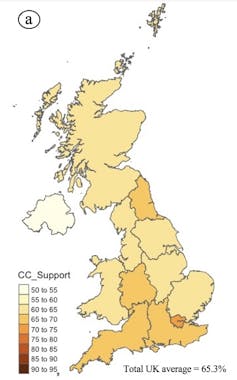
Drivers of these differences are both ideological and structural. People living in Greater London tend to believe less in the free market system compared to people in regions which had significantly lower support for climate policies. This indicates that neoliberal ideology favouring free markets is discouraging climate action.
Yet it is not only what people believe in. Those in more rural regions with higher emissions show less support for stricter climate policies. These tend to be regions with less access to public transport where people have to rely more heavily on high-emitting cars.
More needs to be done to improve public infrastructure in rural areas. This will require investment in affordable, low-carbon transport networks rather than championing the continuation of the combustion engine.
How The Media May Shape Policy Support
Of course, our study only captured a snapshot of people’s policy preferences. We are constantly confronted by news stories, particularly through social media.
These often act as echo chambers to reinforce existing ideologies (and by extension, policy preferences), thereby strengthening existing polarisations. This will make it harder to engage people with contrasting beliefs in a discussion on climate policies.
On the other hand, being repeatedly confronted with particular views and ideas can shift one’s beliefs. In psychology, this is referred to as “repeated priming”. In Germany, we have seen how newspaper campaigns against the slow phase-out of gas boilers have further undermined public support for this specific climate policy.
Could something similar happen in the UK? To avoid the gradual weakening of support by particular news outlets, the UK opposition parties need to be consistent and persistent in their communication of climate policies and their effects.

Don’t have time to read about climate change as much as you’d like?
Get a weekly roundup in your inbox instead. Every Wednesday, The Conversation’s environment editor writes Imagine, a short email that goes a little deeper into just one climate issue. Join the 20,000+ readers who’ve subscribed so far.![]()
Christian Bretter, Research Fellow in Environmental Psychology, University of Leeds and Felix Schulz, Research Fellow, University of Leeds
This article is republished from The Conversation under a Creative Commons license. Read the original article.
COP28: a year on from climate change funding breakthrough, poor countries eye disappointment at Dubai summit
Lisa Vanhala, UCLAt the COP27 summit in Sharm El-Sheikh, Egypt, an agreement to establish a loss and damage fund was hailed as a major breakthrough on one of the trickiest topics in the UN climate change negotiations. In an otherwise frustrating conference, this decision in November 2022 acknowledged the help that poorer and low-emitting countries in particular need to deal with the consequences of climate change – and, tentatively, who ought to pay.
This following year has seen more extreme weather records broken. Torrential rains created flooding which swept away an entire city in Libya, while wildfires razed swathes of Canada, Greece and the Hawaiian island of Maui.
As these events become routine worldwide, the case grows for an effective fund that can be set up quickly and help those most vulnerable to climate change. But after a year of talks, the fund has, so far, failed to materialise in the way that developing countries had hoped.
I’m writing a book on UN governance of loss and damage, and have been following the negotiations since 2013. Here’s what happened after the negotiators went home and what to watch out for when they return, this time at COP28 in Dubai.
Big Questions
Many questions were raised and left unresolved in Sharm El-Sheikh. Among them: who will pay into this new fund? Where will it sit? Who will have power over it? And who will have access to the funding (and who won’t)?
A transitional committee with 14 developing country members and 10 developed country members was appointed by the UN to debate these questions after COP27. The committee has met regularly over the last year, but at its fourth meeting at the end of October – scheduled as the last session – important questions surrounding the fund, such as who should host and administer it, remained. Discussions broke down without an agreement.
In early November, less than a month before COP28, a hastily arranged fifth meeting presented committee members with a text cobbled together by the two co-chairs from South Africa and Finland as a take-it-or-leave-it agreement. Developing countries agreed to having the fund hosted by the World Bank for an interim period, despite reservations.
Developed countries also objected to the final text. The US wanted to add the adjective “voluntary” to any mention of contributions to the fund. Others argued that the pool of contributors to the fund should be widened to include some developing countries, such as Saudi Arabia, and also private sources of finance. These objections were noted but the text was adopted without them.
These recommendations must now be signed off at COP28, which begins on November 30. With almost 200 countries having to reach agreement on these arrangements and dissatisfaction widespread, the process isn’t likely to be straightforward.
The World’s Bank?
Developing countries have been sceptical of the World Bank as a potential host of the fund for several reasons.
Many delegates worry about the bank’s reputation, including the dominance of developed country donors, its emphasis on providing loans rather than grants, and the lack of climate-savviness in the bank’s operations. These concerns are likely to reemerge in Dubai.
The US is the biggest shareholder in the World Bank and traditionally, the bank’s president has been a US citizen nominated by Washington. Small-island developing states (among the most vulnerable to climate change due to sea-level rise) have argued for moving the fund away from a donor-recipient model, with all their usual power imbalances, towards a partnership founded on a shared commitment to protecting the planet.
This will require partial or total reform of the World Bank – and some argue this is already happening under its new president. But hosting the fund within the bank would still give donor countries disproportionate influence, despite recommendations by the transitional committee that the fund’s governing board be composed of a majority of developing country members.

High overhead costs are another concern. One board member of another fund hosted by the World Bank has suggested that the administrative fees the bank charges are rising and absorbing a larger share of aid. This could mean that, for every US$100 billion offered to countries and communities reeling from disaster, the World Bank will keep $US1.5 billion. This will be hard for an institution still funding the climate-wrecking oil and gas industry to justify.
The types of finance made available by the fund will need to be at odds with the bank’s traditional mode of loan financing, by offering grants and other forms of highly concessional lending. Developing countries have consistently argued that loss and damage funding should not increase a developing country’s debt burden.
The agreed text says the loss and damage fund will “invite financial contributions”, with developed countries expected to “take the lead”. Developing countries want developed nations (as the largest historical emitters) to provide funding, but rich nations have pushed back against any notion that they have an obligation to pay.
Rather, while making all the right noises on climate finance, they may gain short-term kudos by simply rebranding existing forms of climate finance or development aid, rather than offering any new money.
The Compensation Taboo
One thing you’re unlikely to hear at COP28 is “compensation”. While newspaper editors love headlines about reparations, liability and compensation when reporting on loss and damage, and a rise in climate litigation is making governments and polluting companies nervous, this language is still totally absent in discussion of the issue in the negotiations.
In fact, research has shown that mentions of compensation in state submissions to the UN declined dramatically after the establishment of the mechanism on loss and damage in 2013. The fine print of the 2015 Paris Agreement noted that loss and damage was “not a basis for liability or compensation”.
I have noticed a taboo emerging around the term within the COP process. Instead, countries are increasingly opting for language such as “solidarity” as the basis for finance. These word choices show where power lies.
All of this is to sound a note of caution going into COP28. Major agreements on loss and damage have historically not lived up to their promises due to bureaucratic forum-shifting (moving topics to venues outside of the UN Framework Convention on Climate Change), delays, and under-resourcing. The adaptation fund was established in 2001 but only approved its first funding in 2010.
How is the urgent need for support among vulnerable communities and countries going to be met when the pace of progress within the climate change negotiations is glacial at best, and tends to be particularly slow and unambitious on loss and damage finance?
At COP28, making the loss and damage fund real is a litmus test for the legitimacy of the entire climate change negotiation regime.

Don’t have time to read about climate change as much as you’d like?
Get a weekly roundup in your inbox instead. Every Wednesday, The Conversation’s environment editor writes Imagine, a short email that goes a little deeper into just one climate issue. Join the 20,000+ readers who’ve subscribed so far.![]()
Lisa Vanhala, Professor of Political Science, UCL
This article is republished from The Conversation under a Creative Commons license. Read the original article.
Plants are likely to absorb more CO₂ in a changing climate than we thought – here’s why
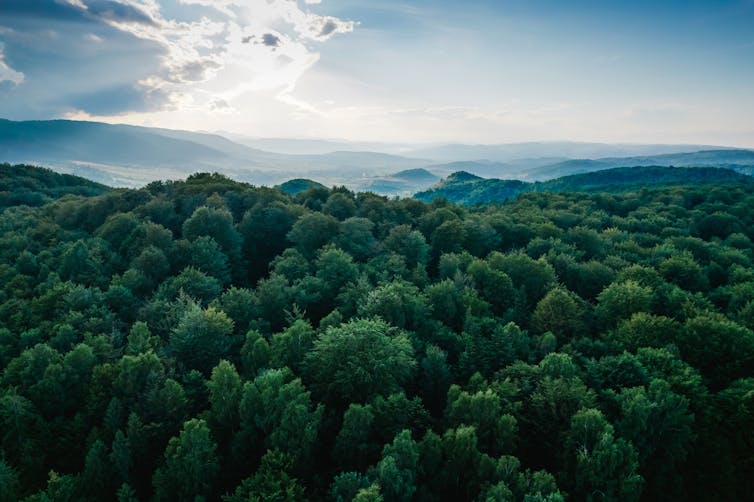
The world’s vegetation has a remarkable ability to absorb carbon dioxide (CO₂) from the air and store it as biomass. In doing so, plants slow down climate change since the CO₂ they take up does not contribute to global warming.
But what will happen under more advanced climate change? How will vegetation respond to projected changes in atmospheric CO₂, temperatures and rainfall? Our study, published today in Science Advances, shows plants might take up more CO₂ than previously thought.
We found climate modelling that best accounted for the processes that sustain plant life consistently predicted the strongest CO₂ uptake. The most complex model predicted up to 20% more than the simplest version.
Our findings highlight the resilience of plants, and the importance of planting trees and preserving existing vegetation to slow climate change. While this is good news, it doesn’t let us off the hook in the fight against climate change. The rapid increase in atmospheric CO₂ means we must still cut emissions.
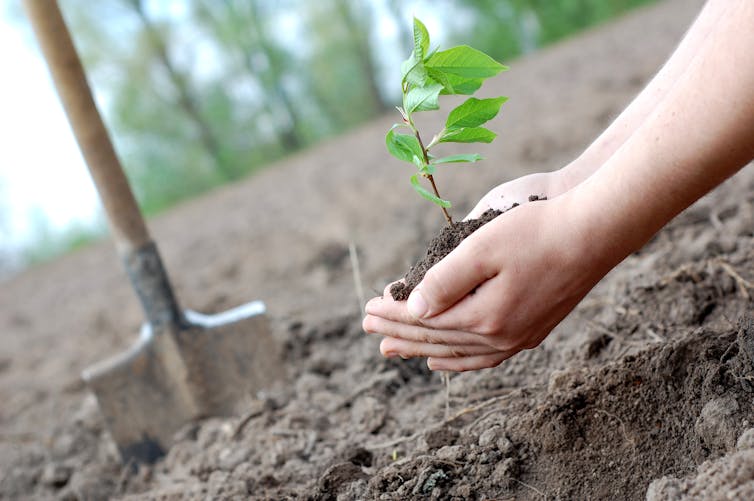
What Happens To The CO₂ Plants Take Up?
Plants take up CO₂ through photosynthesis. This process uses the Sun’s energy to convert – or “fix” – CO₂ from the air into the sugars plants use for growth and metabolic activity.
Plants release around half of that CO₂ back to the atmosphere via respiration relatively quickly. The other half is used for growth and stays in the plant biomass for longer – months to centuries.
That biomass will eventually die and decompose. Part of the carbon will be released again to the atmosphere, but other parts will enter the soil where it can stay for hundreds of years.
So, if plants take up more CO₂, it’s likely more carbon will be stored in vegetation and soils. This “land sink” of carbon has indeed increased over the past few decades as the annual global carbon budget assessment has shown.
What’s more, the increasing land carbon sink has largely been attributed to the beneficial effects of rising atmospheric CO₂ on plant photosynthesis. This is important because that carbon stored in plants and soils slows the increase in atmospheric CO₂ and therefore global warming.
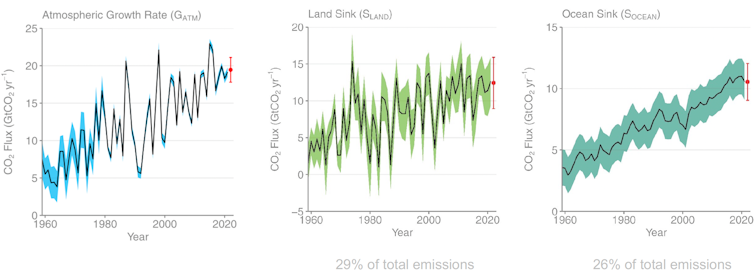
A Gap In Current Climate Models
But how do we know how much carbon is taken up and stored on land? Even more challenging, how can we predict what happens in the future?
One attempt to answer these questions is to use so-called terrestrial biosphere models. These models encapsulate our understanding of how plants function and how they respond to changes in climate.
For example, we know from experiments that plants photosynthesise more under higher CO₂ concentrations but less when they don’t have enough water. Models translate all this knowledge into mathematical equations and allow them to interact with each other.
All this knowledge? Well, not really, and that was the motivation for our research. While today’s terrestrial biosphere models include a plethora of processes, they do not necessarily account for all mechanisms and processes that we know exist. There might not be enough data or information available to confidently represent a process across the entire globe, or it might just be difficult – conceptually or technically – to include it in models.
What Did The Study Look At?
We included three of those neglected processes into the well-established Australian terrestrial biosphere model. We accounted for:
- how efficiently CO₂ can move inside the leaf
- how plants adjust to changes in their surrounding temperature
- how they distribute nutrients most economically.
We used the most recent data and research publications to include the processes as realistically as possible. We then confronted the model with a strong climate change scenario and looked at how much CO₂ plants will take up until the end of this century.
We repeated this experiment with eight different versions of the model. The simplest version did not account for any of the three physiological mechanisms. The most complex version accounted for all three.
The results were surprisingly clear: the more complex the model, the higher the predicted CO₂ uptake by plants. Model versions that accounted for at least two mechanisms (those with greater ecological realism) consistently predicted the strongest CO₂ uptake – up to 20% more than the simplest version.
What Does This Mean For Climate Action?
For modellers this is important news. It tells us our current models, which are usually at the lower end of this complexity range, likely underestimate future CO₂ uptake by plants.
These results suggest plants could be pretty resilient to even severe climate change.
However, we only looked at this from a plant physiological angle. Other processes in models are still oversimplified, such as the impacts of, and recovery from, fires and droughts. We clearly need to better capture these processes to get a more complete picture of how effectively plants will absorb CO₂ in the future.
And last but not least, because plants help fight climate change, it’s essential to conserve existing plant biomass and restore lost vegetation.
But while plants might even be more industrious helpers than previously assumed, they will never do the heavy lifting for us. It is still up to us humans to fight climate change by drastically cutting fossil fuel emissions. There is no shortcut.![]()
Jürgen Knauer, Postdoctoral Research Fellow, Hawkesbury Institute for the Environment, Western Sydney University
This article is republished from The Conversation under a Creative Commons license. Read the original article.
Carved trees and burial sites: Wiradjuri Elders share the hidden stories of marara and dhabuganha

Aboriginal and Torres Strait Islander readers are advised that the following contains information about deceased persons, ceremonial practices, and Men’s and Women’s Business with the permission of the Gaanha-bula Action Group.
People have long used symbols (marks or characters) to communicate ideas and concepts. It is something that sets humans apart from other beings.
The oldest dated example of symbolic thinking is a 77,000-year-old carved ochre object found in South Africa. While we will never know what its symbols meant, it is a different story in Australia, where we are privileged to learn from Aboriginal and Torres Strait Islander peoples today about symbols made by their ancestors in the past.
One remarkable example of symbolic expression is the marara (carved trees or dendroglyphs) of Wiradjuri Country, in southeastern Australia. In a new Wiradjuri-led study, we have combined traditional cultural knowledge and archaeological methods to develop culturally and scientifically informed understanding of these sacred locations for the first time.
Our study of marara and dhabuganha is guided by the principles of the Wiradjuri philosophy Yindyamarra (cultural respect).
Carved Trees And Burials
Marara are trees with elaborate muyalaang (tree carvings), marking the dhabuganha (burials) of Wiradjuri men of high standing. They represent a traditional cultural practice with deep roots.
Wiradjuri people created marara by removing a large slab of bark, then intricately carving muyalaang into the fresh tree surface. Muyalaang often appear as a series of curved lines or geometric patterns like diamonds and zig-zags.
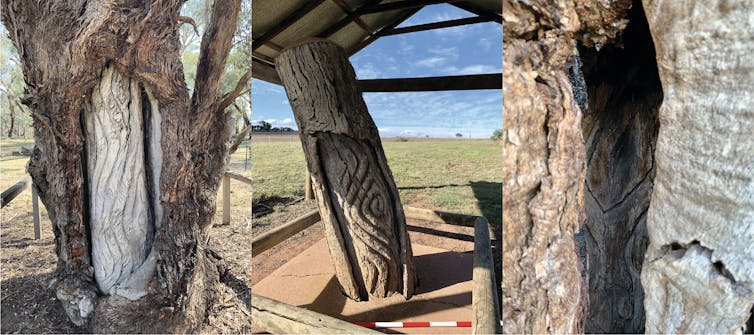
The British explorer John Oxley described marara and dhabuganha in an 1817 diary entry. Three years later, painter G.H. Evans depicted the scene, with several marara carved to face a central dhabuganha and three “mourning” seats:
The form of the whole was semi-circular. Three rows of seats occupied one half, the grave and an outer row of seats the other; the seats formed segments of circles of fifty, forty-five, and forty feet each, and were formed by the soil being trenched up from between them. The centre part of the grave was about five feet high, and about nine long, forming an oblong pointed cone.
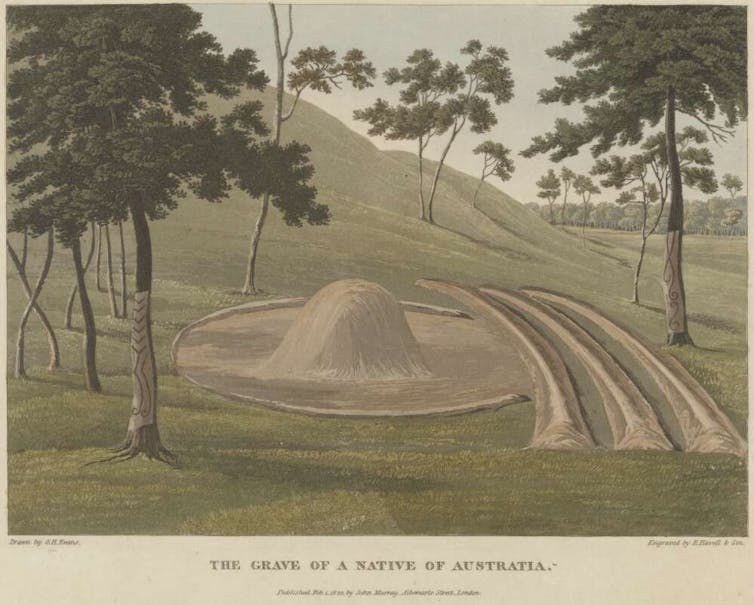
Today, a diminishing number of marara remain. Most dhabuganha are no longer visible due to erosion and modern land-use practices.
Two Burial Sites
We used ground-penetrating radar at one location to non-invasively analyse and map changes in soil to refine our understanding of the resting place of a Wiradjuri man of high standing, whose dhabuganha is no longer visible today but remains marked by a marara. We created a 3D model of this marara.
Not far away, on the other side of a creek, is a fallen scarred tree reported to mark the dhabuganha of the man’s “wife”. The man’s marara and the woman’s fallen scarred tree would have faced each other when the fallen tree was still standing – perhaps as a symbol of their connection.
We also studied marara and dhabuganha at Yuranigh’s Grave, a public tourist site near Molong. Yuranigh was a Wiradjuri man of high standing who accompanied explorer Thomas Mitchell on his inland expeditions during the 19th century.
Mitchell valued Yuranigh so much that, after Yuranigh’s passing, he added a European headstone to Yuranigh’s dhabuganha, which is also surrounded by several traditionally carved marara. The headstone inscription reads:
To Native Courage Honesty and Fidelity. Yuranigh who accompanied the expedition of discovery into tropical Australia in 1846 lies buried here according to the rites of his countrymen and this spot was dedicated and enclosed by the Governor General’s authority in 1852.
A Bigger Cultural Landscape
Despite the remarkable appearance of marara, our interviews with Wiradjuri Elders and knowledge holders make it clear that marara are not just artistic objects. They are sacred locations with specific cultural (or symbolic) meaning that is not clear without deeper understanding of Wiradjuri people and Country.
Wiradjuri Elder Uncle Neil Ingram reveals that muyalaang speak to “the different clan groups and their stories”. Wiradjuri Elder Aunty Alice Williams explains that muyalaang are “connected back to the totems” of the area. Wiradjuri Knowledge Holder James Williams states that marara show “a path from here – this life – to the next life”, between the earth and “sky world” where Baiame the Wiradjuri Creator, or Sky Spirit, lives.
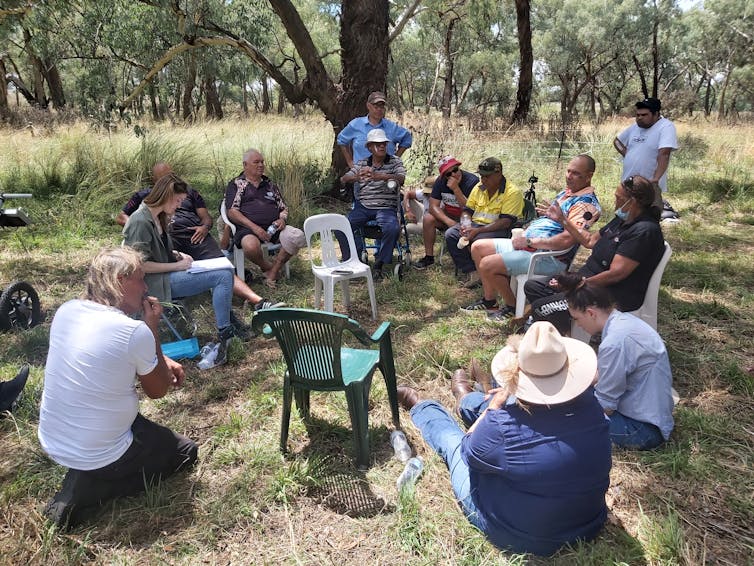
Our interviews with Wiradjuri Elders and knowledge holders also highlight that marara and dhabuganha should not be understood as individual locations or isolated “sites”.
Wiradjuri Elder Aunty Alice Williams explains that “you need to open your mind and think further than what’s on the tree, and what’s in the ground, and have a look around, and see what’s there … within a bigger cultural landscape”. Marara and dhabuganha form part of a connected system of Wiradjuri lore, beliefs, traditional cultural practices and Country that involved men, women and children together.
Marara and dhabuganha encourage us to look beyond what we perceive in physical form to understand the different ways of seeing the world around us.
We have had the privilege of working together to document these sacred locations, and to shine a light on this important and fragile part of Australian history. Marara and dhabuganha tell a hidden story that is not apparent without deeper cultural understanding.
The authors wish to acknowledge this article was also written with Uncle Neil Ingram (Wiradjuri Elder), Aunty Alice Williams (Wiradjuri Elder), James Williams (Wiradjuri Knowledge Holder), Yarrawula Ngullubul Men’s Corporation, Orange Local Aboriginal Land Council, Michelle Hines (Central Tablelands Local Land Services) and Tracey Potts (Central Tablelands Local Land Services).![]()
Caroline Spry, Adjunct Senior Research Fellow, PhD, La Trobe University; Brian J Armstrong, Research Associate, The University of Melbourne; Greg Ingram, Wiradjuri Traditional Custodian, and Aboriginal Communities Officer at Central Tablelands Local Land Services, Indigenous Knowledge; Ian Sutherland, Wiradjuri/Kamilaroi Traditional Custodian, Indigenous Knowledge, and Lawrence Conyers, Professor of Anthropology, University of Denver
This article is republished from The Conversation under a Creative Commons license. Read the original article.
Pittwater Reserves: Histories + Notes + Pictorial Walks
A History Of The Campaign For Preservation Of The Warriewood Escarpment by David Palmer OAM and Angus Gordon OAM
A Stroll Around Manly Dam: Spring 2023 by Kevin Murray and Joe Mills
A Stroll Through Warriewood Wetlands by Joe Mills February 2023
A Walk Around The Cromer Side Of Narrabeen Lake by Joe Mills
America Bay Track Walk - photos by Joe Mills
An Aquatic June: North Narrabeen - Turimetta - Collaroy photos by Joe Mills
Angophora Reserve Angophora Reserve Flowers Grand Old Tree Of Angophora Reserve Falls Back To The Earth - History page
Annie Wyatt Reserve - A Pictorial
Aquatic Reflections seen this week (May 2023): Narrabeen + Turimetta by Joe Mills
Avalon's Village Green: Avalon Park Becomes Dunbar Park - Some History + Toongari Reserve and Catalpa Reserve
Bairne Walking Track Ku-Ring-Gai Chase NP by Kevin Murray
Bangalley Headland Bangalley Mid Winter
Bangalley Headland Walk: Spring 2023 by Kevin Murray and Joe Mills
Banksias of Pittwater
Barrenjoey Boathouse In Governor Phillip Park Part Of Our Community For 75 Years: Photos From The Collection Of Russell Walton, Son Of Victor Walton
Barrenjoey Headland: Spring flowers
Barrenjoey Headland after fire
Bayview Baths
Bayview Wetlands
Beeby Park
Bilgola Beach
Botham Beach by Barbara Davies
Bungan Beach Bush Care
Careel Bay Saltmarsh plants
Careel Bay Birds
Careel Bay Clean Up day
Careel Bay Playing Fields History and Current
Careel Creek
Careel Creek - If you rebuild it they will come
Centre trail in Ku-ring-gai Chase National Park
Chiltern Track- Ingleside by Marita Macrae
Clareville Beach
Clareville/Long Beach Reserve + some History
Coastal Stability Series: Cabbage Tree Bay To Barrenjoey To Observation Point by John Illingsworth, Pittwater Pathways, and Dr. Peter Mitchell OAM
Cowan Track by Kevin Murray
Curl Curl To Freshwater Walk: October 2021 by Kevin Murray and Joe Mills
Currawong and Palm Beach Views - Winter 2018
Currawong-Mackerel-The Basin A Stroll In Early November 2021 - photos by Selena Griffith
Currawong State Park Currawong Beach + Currawong Creek
Deep Creek To Warriewood Walk photos by Joe Mills
Drone Gives A New View On Coastal Stability; Bungan: Bungan Headland To Newport Beach + Bilgola: North Newport Beach To Avalon + Bangalley: Avalon Headland To Palm Beach
Duck Holes: McCarrs Creek by Joe Mills
Dunbar Park - Some History + Toongari Reserve and Catalpa Reserve
Dundundra Falls Reserve: August 2020 photos by Selena Griffith - Listed in 1935
Elsie Track, Scotland Island
Elvina Track in Late Winter 2019 by Penny Gleen
Elvina Bay Walking Track: Spring 2020 photos by Joe Mills
Elvina Bay-Lovett Bay Loop Spring 2020 by Kevin Murray and Joe Mills
Fern Creek - Ingleside Escarpment To Warriewood Walk + Some History photos by Joe Mills
Iluka Park, Woorak Park, Pittwater Park, Sand Point Reserve, Snapperman Beach Reserve - Palm Beach: Some History
Ingleside
Ingleside Wildflowers August 2013
Irrawong - Ingleside Escarpment Trail Walk Spring 2020 photos by Joe Mills
Irrawong - Mullet Creek Restoration
Katandra Bushland Sanctuary - Ingleside
Lucinda Park, Palm Beach: Some History + 2022 Pictures
McCarrs Creek
McCarr's Creek to Church Point to Bayview Waterfront Path
McKay Reserve
Mona Vale Beach - A Stroll Along, Spring 2021 by Kevin Murray
Mona Vale Headland, Basin and Beach Restoration
Mona Vale Woolworths Front Entrance Gets Garden Upgrade: A Few Notes On The Site's History
Mother Brushtail Killed On Barrenjoey Road: Baby Cried All Night - Powerful Owl Struck At Same Time At Careel Bay During Owlet Fledgling Season: calls for mitigation measures - The List of what you can do for those who ask 'What You I Do' as requested
Mount Murray Anderson Walking Track by Kevin Murray and Joe Mills
Mullet Creek
Narrabeen Creek
Narrabeen Lagoon Catchment: Past Notes Present Photos by Margaret Woods
Narrabeen Lagoon Entrance Clearing Works: September To October 2023 pictures by Joe Mills
Narrabeen Lagoon State Park
Narrabeen Lagoon State Park Expansion
Narrabeen Rockshelf Aquatic Reserve
Nerang Track, Terrey Hills by Bea Pierce
Newport Bushlink - the Crown of the Hill Linked Reserves
Newport Community Garden - Woolcott Reserve
Newport to Bilgola Bushlink 'From The Crown To The Sea' Paths: Founded In 1956 - A Tip and Quarry Becomes Green Space For People and Wildlife
Pittwater Reserves: The Green Ways; Bungan Beach and Bungan Head Reserves: A Headland Garden
Pittwater Reserves, The Green Ways: Clareville Wharf and Taylor's Point Jetty
Pittwater Reserves: The Green Ways; Hordern, Wilshire Parks, McKay Reserve: From Beach to Estuary
Pittwater Reserves - The Green Ways: Mona Vale's Village Greens a Map of the Historic Crown Lands Ethos Realised in The Village, Kitchener and Beeby Parks
Pittwater Reserves: The Green Ways Bilgola Beach - The Cabbage Tree Gardens and Camping Grounds - Includes Bilgola - The Story Of A Politician, A Pilot and An Epicure by Tony Dawson and Anne Spencer
Pittwater spring: waterbirds return to Wetlands
Pittwater's Lone Rangers - 120 Years of Ku-Ring-Gai Chase and the Men of Flowers Inspired by Eccleston Du Faur
Pittwater's Great Outdoors: Spotted To The North, South, East + West- June 2023: Palm Beach Boat House rebuild going well - First day of Winter Rainbow over Turimetta - what's Blooming in the bush? + more by Joe Mills, Selena Griffith and Pittwater Online
Pittwater's Parallel Estuary - The Cowan 'Creek
Resolute Track at West Head by Kevin Murray
Resolute Track Stroll by Joe Mills
Riddle Reserve, Bayview
Salvation Loop Trail, Ku-Ring-Gai Chase National Park- Spring 2020 - by Selena Griffith
Seagull Pair At Turimetta Beach: Spring Is In The Air!
Stapleton Reserve
Stapleton Park Reserve In Spring 2020: An Urban Ark Of Plants Found Nowhere Else
Stony Range Regional Botanical Garden: Some History On How A Reserve Became An Australian Plant Park
The Chiltern Track
The Chiltern Trail On The Verge Of Spring 2023 by Kevin Murray and Joe Mills
The Resolute Beach Loop Track At West Head In Ku-Ring-Gai Chase National Park by Kevin Murray
Topham Track Ku-Ring-Gai Chase NP, August 2022 by Joe Mills and Kevin Murray
Towlers Bay Walking Track by Joe Mills
Trafalgar Square, Newport: A 'Commons' Park Dedicated By Private Landholders - The Green Heart Of This Community
Tranquil Turimetta Beach, April 2022 by Joe Mills
Turimetta Beach Reserve by Joe Mills, Bea Pierce and Lesley
Turimetta Beach Reserve: Old & New Images (by Kevin Murray) + Some History
Turimetta Headland
Turimetta Moods by Joe Mills: June 2023
Turimetta Moods (Week Ending June 23 2023) by Joe Mills
Turimetta Moods: June To July 2023 Pictures by Joe Mills
Turimetta Moods: July Becomes August 2023 by Joe Mills
Turimetta Moods: August Becomes September 2023 ; North Narrabeen - Turimetta - Warriewood - Mona Vale photographs by Joe Mills
Turimetta Moods: Mid-September To Mid-October 2023 by Joe Mills
Warriewood Wetlands - Creeks Deteriorating: How To Report Construction Site Breaches, Weed Infestations + The Long Campaign To Save The Warriewood Wetlands & Ingleside Escarpment March 2023
Warriewood Wetlands and Irrawong Reserve
Whale Beach Ocean Reserve: 'The Strand' - Some History On Another Great Protected Pittwater Reserve
Wilshire Park Palm Beach: Some History + Photos From May 2022
Winji Jimmi - Water Maze

Pittwater's Birds
Australian Predators of the Sky by Penny Olsen - published by National Library of Australia
Australian Raven Australian Wood Duck Family at Newport
A Week In Pittwater Issue 128 A Week In Pittwater - June 2014 Issue 168
Baby Birds Spring 2015 - Rainbow Lorikeets in our Yard - for Children Baby Birds by Lynleigh Greig, Southern Cross Wildlife Care - what do if being chased by a nesting magpie or if you find a baby bird on the ground
Baby Kookaburras in our Backyard: Aussie Bird Count 2016 - October
Balloons Are The Number 1 Marine Debris Risk Of Mortality For Our Seabirds - Feb 2019 Study
Bangalley Mid-Winter Barrenjoey Birds Bird Antics This Week: December 2016
Bird of the Month February 2019 by Michael Mannington
Birdland Above the Estuary - October 2012 Birds At Our Window Birds at our Window - Winter 2014 Birdland June 2016
Birdsong Is a Lovesong at This time of The Year - Brown Falcon, Little Wattle Bird, Australian Pied cormorant, Mangrove or Striated Heron, Great Egret, Grey Butcherbird, White-faced Heron
Bird Songs – poems about our birds by youngsters from yesterdays - for children Bird Week 2015: 19-25 October
Bird Songs For Spring 2016 For Children by Joanne Seve
Birds at Careel Creek this Week - November 2017: includes Bird Count 2017 for Local Birds - BirdLife Australia by postcode
Black Cockatoo photographed in the Narrabeen Catchment Reserves this week by Margaret G Woods - July 2019
Black-Necked Stork, Mycteria Australis, Now Endangered In NSW, Once Visited Pittwater: Breeding Pair shot in 1855
Black Swans on Narrabeen Lagoon - April 2013 Black Swans Pictorial
Endangered Little Tern Fishing at Mona Vale Beach
‘Feather Map of Australia’: Citizen scientists can support the future of Australia's wetland birds: for Birdwatchers, school students and everyone who loves our estuarine and lagoon and wetland birds
Fledgling Common Koel Adopted by Red Wattlebird -Summer Bird fest 2013 Flegdlings of Summer - January 2012
Flocks of Colour by Penny Olsen - beautiful new Bird Book Celebrates the 'Land of the Parrots'
Friendly Goose at Palm Beach Wharf - Pittwater's Own Mother Goose
Front Page Issue 177 Front Page Issue 185 Front Page Issue 193 - Discarded Fishing Tackle killing shorebirds Front Page Issue 203 - Juvenile Brush Turkey Front Page Issue 208 - Lyrebird by Marita Macrae Front Page Issue 219 Superb Fairy Wren Female Front Page Issue 234: National Bird Week October 19-25 and the 2015 the Aussie Back Yard Bird Count: Australia's First Bird Counts - a 115 Year Legacy - with a small insight into our first zoos Front Page Issue 236: Bird Week 2015 Front Page Issue 244: watebirds Front Page Issue 260: White-face Heron at Careel Creek Front Page Issue 283: Pittwater + more birds for Bird Week/Aussie Bird Count Front Page Issue 284: Pittwater + more birds for Bird Week/Aussie Bird Count Front Page Issue 285: Bird Week 2016 Front Page Issue 331: Spring Visitor Birds Return
G . E. Archer Russell (1881-1960) and His Passion For Avifauna From Narrabeen To Newport
Glossy Black-Cockatoo Returns To Pittwater by Paul Wheeler Glossy Cockatoos - 6 spotted at Careel Bay February 2018
Grey Butcher Birds of Pittwater
INGLESIDE LAND RELEASE ON AGAIN BUT MANY CHALLENGES AHEAD by David Palmer
Issue 60 May 2012 Birdland - Smiles- Beamings -Early -Winter - Blooms
Jayden Walsh’s Northern Beaches Big Year - courtesy Pittwater Natural Heritage Association
John Gould's Extinct and Endangered Mammals of Australia by Dr. Fred Ford - Between 1850 and 1950 as many mammals disappeared from the Australian continent as had disappeared from the rest of the world between 1600 and 2000! Zoologist Fred Ford provides fascinating, and often poignant, stories of European attitudes and behaviour towards Australia's native fauna and connects these to the animal's fate today in this beautiful new book - our interview with the author
July 2012 Pittwater Environment Snippets; Birds, Sea and Flowerings
Juvenile Sea Eagle at Church Point - for children
King Parrots in Our Front Yard
Kookaburra Turf Kookaburra Fledglings Summer 2013 Kookaburra Nesting Season by Ray Chappelow Kookaburra Nest – Babies at 1.5 and 2.5 weeks old by Ray Chappelow Kookaburra Nest – Babies at 3 and 4 weeks old by Ray Chappelow Kookaburra Nest – Babies at 5 weeks old by Ray Chappelow Kookaburra and Pittwater Fledglings February 2020 to April 2020
Lion Island's Little Penguins (Fairy Penguins) Get Fireproof Homes - thanks to NSW National Parks and Wildlife Service and the Fix it Sisters Shed
Lyre Bird Sings in Local National Park - Flock of Black Cockatoos spotted - June 2019
Magpie's Melodic Melodies - For Children (includes 'The Magpie's Song' by F S Williamson)
Masked Lapwing (Plover) - Reflected
May 2012 Birdland Smiles Beamings Early Winter Blooms
Musk Lorikeets In Pittwater: Pittwater Spotted Gum Flower Feast - May 2020
Nankeen Kestrel Feasting at Newport: May 2016
National Bird Week 2014 - Get Involved in the Aussie Backyard Bird Count: National Bird Week 2014 will take place between Monday 20 October and Sunday 26 October, 2014. BirdLife Australia and the Birds in Backyards team have come together to launch this year’s national Bird Week event the Aussie Backyard Bird Count! This is one the whole family can do together and become citizen scientists...
National Bird Week October 19-25 and the 2015 the Aussie Back Yard Bird Count: Australia's First Bird Counts - a 115 Year Legacy - with a small insight into our first zoos
Nature 2015 Review Earth Air Water Stone
New Family of Barking Owls Seen in Bayview - Church Point by Pittwater Council
Noisy Visitors by Marita Macrae of PNHA
Odes to Australia's Fairy-wrens by Douglas Brooke Wheelton Sladen and Constance Le Plastrier 1884 and 1926
Oystercatcher and Dollarbird Families - Summer visitors
Painted Button-Quail Rescued By Locals - Elanora-Ingleside escarpment-Warriewood wetlands birds
Palm Beach Protection Group Launch, Supporters Invited: Saturday Feb.16th - Residents Are Saying 'NO' To Off-Leash Dogs In Station Beach Eco-System - reports over 50 dogs a day on Station Beach throughout December-January (a No Dogs Beach) small children being jumped on, Native birds chased, dog faeces being left, families with toddlers leaving beach to get away from uncontrolled dogs and 'Failure of Process' in council 'consultation' open to February 28th
Pardalote, Scrub Wren and a Thornbill of Pittwater
Pecking Order by Robyn McWilliam
Pelican Lamps at Narrabeen Pelican Dreamsong - A Legend of the Great Flood - dreamtime legend for children
Pittwater Becalmed Pittwater Birds in Careel Creek Spring 2018 Pittwater Waterbirds Spring 2011 Pittwater Waterbirds - A Celebration for World Oceans Day 2015
Pittwater's Mother Nature for Mother's Day 2019
Plastic in 99 percent of seabirds by 2050 by CSIRO
Plover Appreciation Day September 16th 2015
Powerful and Precious by Lynleigh Grieg
Red Wattlebird Song - November 2012
Restoring The Diamond: every single drop. A Reason to Keep Dogs and Cats in at Night.
Return Of Australasian Figbird Pair: A Reason To Keep The Trees - Aussie Bird Count 2023 (16–22 October) You can get involved here: aussiebirdcount.org.au
Sea Birds off the Pittwater Coast: Albatross, Gannet, Skau + Australian Poets 1849, 1898 and 1930, 1932
Sea Eagle Juvenile at Church Point
Seen but Not Heard: Lilian Medland's Birds - Christobel Mattingley - one of Australia's premier Ornithological illustrators was a Queenscliff lady - 53 of her previously unpublished works have now been made available through the auspices of the National Library of Australia in a beautiful new book
7 Little Ducklings: Just Keep Paddling - Australian Wood Duck family take over local pool by Peta Wise
Shag on a North Avalon Rock - Seabirds for World Oceans Day 2012
Short-tailed Shearwaters Spring Migration 2013
South-West North-East Issue 176 Pictorial
Spring 2012 - Birds are Splashing - Bees are Buzzing
Spring Becomes Summer 2014- Royal Spoonbill Pair at Careel Creek
Spring Notes 2018 - Royal Spoonbill in Careel Creek
Station Beach Off Leash Dog Area Proposal Ignores Current Uses Of Area, Environment, Long-Term Fauna Residents, Lack Of Safe Parking and Clearly Stated Intentions Of Proponents have your say until February 28, 2019
Summer 2013 BirdFest - Brown Thornbill Summer 2013 BirdFest- Canoodlers and getting Wet to Cool off Summer 2013 Bird Fest - Little Black Cormorant Summer 2013 BirdFest - Magpie Lark
New Shorebirds WingThing For Youngsters Available To Download
A Shorebirds WingThing educational brochure for kids (A5) helps children learn about shorebirds, their life and journey. The 2021 revised brochure version was published in February 2021 and is available now. You can download a file copy here.
If you would like a free print copy of this brochure, please send a self-addressed envelope with A$1.10 postage (or larger if you would like it unfolded) affixed to: BirdLife Australia, Shorebird WingThing Request, 2-05Shorebird WingThing/60 Leicester St, Carlton VIC 3053.

 Shorebird Identification Booklet
Shorebird Identification Booklet
The Migratory Shorebird Program has just released the third edition of its hugely popular Shorebird Identification Booklet. The team has thoroughly revised and updated this pocket-sized companion for all shorebird counters and interested birders, with lots of useful information on our most common shorebirds, key identification features, sighting distribution maps and short articles on some of BirdLife’s shorebird activities.
The booklet can be downloaded here in PDF file format: http://www.birdlife.org.au/documents/Shorebird_ID_Booklet_V3.pdf
Paper copies can be ordered as well, see http://www.birdlife.org.au/projects/shorebirds-2020/counter-resources for details.
Download BirdLife Australia's children’s education kit to help them learn more about our wading birdlife
Shorebirds are a group of wading birds that can be found feeding on swamps, tidal mudflats, estuaries, beaches and open country. For many people, shorebirds are just those brown birds feeding a long way out on the mud but they are actually a remarkably diverse collection of birds including stilts, sandpipers, snipe, curlews, godwits, plovers and oystercatchers. Each species is superbly adapted to suit its preferred habitat. The Red-necked Stint is as small as a sparrow, with relatively short legs and bill that it pecks food from the surface of the mud with, whereas the Eastern Curlew is over two feet long with a exceptionally long legs and a massively curved beak that it thrusts deep down into the mud to pull out crabs, worms and other creatures hidden below the surface.
Some shorebirds are fairly drab in plumage, especially when they are visiting Australia in their non-breeding season, but when they migrate to their Arctic nesting grounds, they develop a vibrant flush of bright colours to attract a mate. We have 37 types of shorebirds that annually migrate to Australia on some of the most lengthy and arduous journeys in the animal kingdom, but there are also 18 shorebirds that call Australia home all year round.
What all our shorebirds have in common—be they large or small, seasoned traveller or homebody, brightly coloured or in muted tones—is that each species needs adequate safe areas where they can successfully feed and breed.
The National Shorebird Monitoring Program is managed and supported by BirdLife Australia.
This project is supported by Glenelg Hopkins Catchment Management Authority and Hunter Local Land Services through funding from the Australian Government’s National Landcare Program. Funding from Helen Macpherson Smith Trust and Port Phillip Bay Fund is acknowledged.
The National Shorebird Monitoring Program is made possible with the help of over 1,600 volunteers working in coastal and inland habitats all over Australia.
The National Shorebird Monitoring program (started as the Shorebirds 2020 project initiated to re-invigorate monitoring around Australia) is raising awareness of how incredible shorebirds are, and actively engaging the community to participate in gathering information needed to conserve shorebirds.
In the short term, the destruction of tidal ecosystems will need to be stopped, and our program is designed to strengthen the case for protecting these important habitats.
In the long term, there will be a need to mitigate against the likely effects of climate change on a species that travels across the entire range of latitudes where impacts are likely.
The identification and protection of critical areas for shorebirds will need to continue in order to guard against the potential threats associated with habitats in close proximity to nearly half the human population.
Here in Australia, the place where these birds grow up and spend most of their lives, continued monitoring is necessary to inform the best management practice to maintain shorebird populations.
BirdLife Australia believe that we can help secure a brighter future for these remarkable birds by educating stakeholders, gathering information on how and why shorebird populations are changing, and working to grow the community of people who care about shorebirds.
To find out more visit: http://www.birdlife.org.au/projects/shorebirds-2020/shorebirds-2020-program
Aussie Bread Tags Collection Points

Lifesavers Issue Schoolies Safety Message
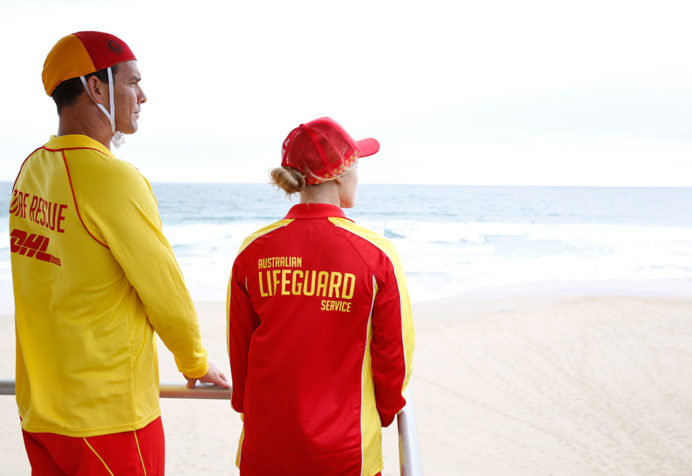 With Schoolies celebrations set to officially kick off on Saturday 18 November, surf lifesavers are reminding potential revellers that alcohol, drugs, and the ocean do not mix.
With Schoolies celebrations set to officially kick off on Saturday 18 November, surf lifesavers are reminding potential revellers that alcohol, drugs, and the ocean do not mix.- Only swim at a patrolled beach, between the red and yellow flags
- Don’t swim under the influence of alcohol or drugs
- Never swim at night
- Ask a surf lifesaver or lifeguard for advice
- Look after your mates, and know where your group is while in the water
- Call triple-zero (000) to report an in-water emergency
2023 Harken International Youth Match Racing Line-Up Confirmed: Racing On Pittwater December 4-8

The 2023 HARKEN International Youth Match Racing Championship will once again host some of the World’s best youth match racing talent, with competitors travelling from across the world, including UK and Ireland, New Zealand, Canada and Brazil, as well as a strong representation from across Australia.
After receiving over 20 applications from teams to compete, the Royal Prince Alfred Yacht Club in Newport, NSW, had a tough decision to select the final 10 teams. The 2023 line up sees an exciting mix of developing and experienced Match Racing teams, looking to have their name etched on the Rockin’ Robin Perpetual Trophy.
The 2023 edition sees 5 skippers taking part in their first event at RPAYC. International entrants include Nicolas Bernal from Santo Amaro Yacht Club in Brazil, Ben Tylecote from Rutland Sailing Club in Great Britain, Jack Frewin from Royal New Zealand Yacht Squadron, Tom Higgins from Royal Saint George Yacht Club in Ireland, and Richard Rychlik Jr from Oakville Yacht Squadron in Canada.
RPAYC’s Senior Head Instructor commented on the line up of teams for this years Championship. 'The excitement is building as we look forward to welcoming emerging youth match teams from all over the world to Pittwater. To have 6 different nations, and 9 clubs represented is a testament to the global recognition of this world class event'.
Leading the local talent competing at this years are two teams from Royal Prince Alfred Yacht Club. Daniel Kemp finished in 5th position in the 2022 edition of the HARKEN Youth Match Racing Championship.
''After competing last year, it is awesome for myself and the team to have the opportunity to once again represent our home club RPAYC at this prestigious event – we can not wait for the racing to begin!'' Daniel said
Hugo Butterworth, also from Royal Prince Alfred Yacht Club, was a crew member in last years event, but is now stepping up to lead a team.
''This year’s HARKEN will be my first Grade 3 event as a Skipper, and the suspense is very intense! As a team we are super excited for the fierce competition and experience that lays ahead of us.'' Hugo said
Not only will the 2023 HARKEN Championship attract sailors from across the world, but RPAYC is also thrilled to once again welcome an experienced Race Management and an international cast of Umpires, with club stalwart Ted Anderson returning as Race Officer, and Richard Slater heading up the Umpire team.
Royal Prince Alfred Yacht Club is delighted to maintain the longstanding support of title sponsor HARKEN Australia.
Grant Pellew, HARKEN Australasia Managing Director is looking forward to seeing the teams compete this year.
‘This year we have a huge range of international teams from around the globe, which is great to see. The HARKEN global family looks forward to this long-standing regatta each year as we are very committed to youth sailing both locally and globally. We wish all competing teams the best of luck and look forward to seeing a new name etched onto the trophy alongside the previous winners who have gone on to become America's Cup Sailors, Olympians & World Champions.'' Grant said this week
The regatta commences with official proceedings on Monday 4th December, with four days of Match Racing on the RPAYC’s fleet of Elliott 7 yachts from Tuesday 5th to Friday 8th December.
Visit the website to view the full line up of teams and umpires: www.intyouthmatchracingchampionship.com.au
Follow the regatta on social media:
The HARKEN International Youth Match RacinCompetitor & Officials List
Skipper List
- Daniel Kemp (AUS), Royal Prince Alfred Yacht Club
- Ben Tylecote (GBR), Rutland Sailing Club
- Hugo Butterworth (AUS), Royal Prince Alfred Yacht Club
- Jack Frewin (NZL), Royal New Zealand Yacht Squadron
- Mia Lovelady (AUS), Royal Freshwater Bay Yacht Club
- Nicolas Bernal (BRA), Yacht Club Santo Amaro
- Richard Rychlik (CAN), Oakville Yacht Squadron
- Tom Higgins (IRE), Royal Saint George Yacht Club
- Zac West (GBR), Royal Sydney Yacht Squadron
Race Officials
- Ted Anderson (AUS), Principal Race Officer
Umpires
- Richard Slater (AUS), Chief Umpire
- Ryan Parkin (NZL), Umpire
- Kotan Imazu (JPN), Umpire
- Phillipe Mazzard (FRA), Umpire
- Robyn Tames (AUS), Umpire
- Simon Barrington (AUS), Umpire
- Jen Richardson (AUS), Umpire
Katie Maxim (USA), Umpireg Championship, a Grade 3 Youth Match Racing event, will be held from Monday 4th to Friday 8th December 2023. Consisting of four days of match racing, youth teams under age 23 will compete for the Rockin’ Robin Perpetual Trophy, racing on the Royal Prince Alfred Yacht Club’s Elliott 7 performance keelboats with a crew of four or five.
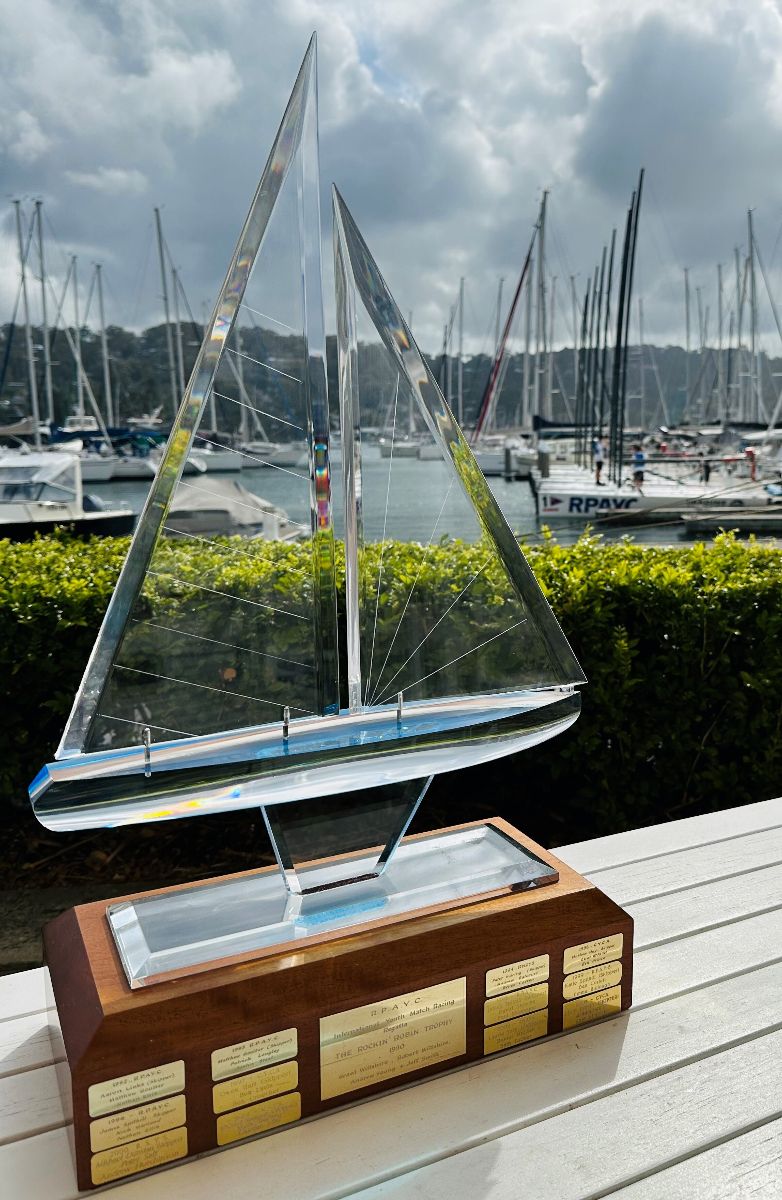
The Rockin’ Robin Perpetual Trophy.
Established in 1992, the HARKEN International Youth Match Racing Championship has grown into a world-renowned international youth event. The event has proven to be a fine training ground for outstanding young sailors who have gone on to sail in the America’s Cup, World Match Racing Tour, Volvo Ocean Race, World Championships and Olympics. It goes without saying the climate, the pristine waterways, Royal Prince Alfred Yacht Club’s vision to be at the forefront of Youth Development and the match racing discipline, attracts many of the most talented youth crews from around the world. The event’s popularity is reflected in the demand for places in the team line-ups and in the ever-broadening geographic spread of competing nations.
Junior Irukandjis Team In Brazil For 2023 ISA World Junior Surfing Championship
Pittwater surfer Milla Brown has been named for Junior Irukandjis team which arrived in Brazil for ISA World Junior Surfing Championship on Thursday November 23 2023. Freshwater surfer Fletcher Kelleher is also part of the team.
- Keira Buckpitt and Lennix Smith named captains of the team
- Competition due to start today
- Location: Rio de Janeiro, Brazil
- Competition dates: November 24 – December 3, 2023
The junior Irukandjis team has arrived in Brazil for the 2023 ISA World Junior Surfing Championship.
Keira Buckpitt and Lennix Smith have been named captains of the team as they prepare to take on the world's best junior surfers at Macumba Beach.
17-year-old Buckpitt is hoping to make it into the top five this year after finishing ninth in El Salvador.
“The team is looking very strong. Everyone’s looking good.”
18-year-old Smith will be competing at the event for the first time after an injury setback forced him to withdraw from last year's competition.
“To be able to experience the culture and going over as a team and being in that environment with everyone should be really good and pretty special. We couldn’t have a better team. I think we all should do well. Everyone is really talented.”
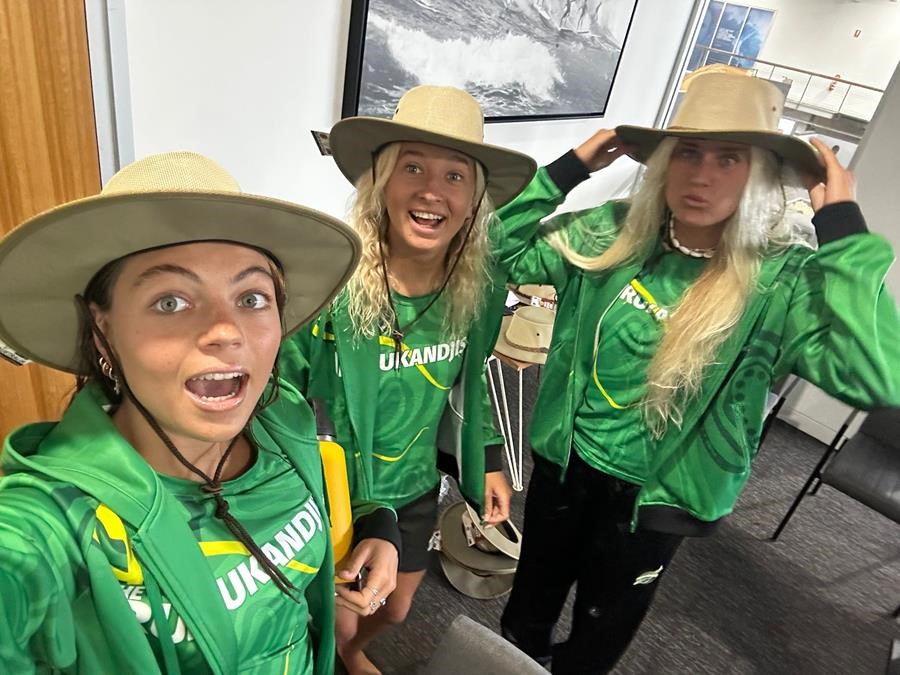
Coco Cairns, Keira Buckpitt and Jahly Stokes will compete in the U18 Girls division. Photo Credit: Surfing Australia.
The Championship is set to kick off with an Opening Ceremony at Macumba Beach on Friday morning (local time) before the potential start of the surf contest in the afternoon.
For more information, visit the ISA event website HERE.
About the ISA World Junior Surfing Championship:
The best junior surfers from every part of the globe will contend for medals in this prestigious event that has proved itself as a direct pathway to the Olympic Games, with Stephanie Gilmore among past ISA World Junior Champions.
2023 Junior Irukandjis team:
U18 Girls
- Coco Cairns (Tewantin, QLD)
- Jahly Stokes (Buddina, QLD)
- Keira Buckpitt (Culburra Beach) *Junior Irukandjis team Captain
U18 Boys
- Harley Walters (Angourie, NSW)
- Lennix Smith (Barrack Point, NSW) *Junior Irukandjis team Captain
- Willis Droomer (Jan Juc, VIC)
U16 Girls
- Isla Huppatz (Bilinga, QLD)
- Milla Brown (Newport, NSW)
- Sierra Kerr (Bilinga, QLD)
U16 Boys
- Kash Brown (Cronulla, NSW)
- Rico Haybittle (Palm Beach, QLD)
- Fletcher Kelleher (Freshwater, NSW)
The Irukandji name
In a historic moment for Australian Surfing, a new team name and identity was unveiled Wednesday, 17 March 2021, at the Novotel in Manly for Australia’s national surf team. The much-anticipated new namesake and tagline was revealed to be ‘The Irukandjis: Deadly in the Water’, after the Irukandji jellyfish – an extremely venomous species of jellyfish that inhabit Australian marine waters.
“They pack a serious punch, just like our Australian surfers in the water”, said Surfing Australia CEO, Chris Mater, of the name that will lead Australia’s inaugural Olympic surf team’s debut into the Tokyo games this July.
For the first time, Australian representatives across all surfing genres, including Junior, Open, Masters, Olympic, Longboard, Big Wave, Stand Up Paddleboard (SUP) and Adaptive disciplines, will compete under The Irukandjis national identity and united colours at international events such as the Olympics, International Surfing Association (ISA), World Surfing Games, WSL World Juniors and Longboard Championships.
Pittwater's Milla Brown - a few notes
In 2021 Milla Brown finished her State Title campaign with a bang as she took out the Under-16 Girls final.
In 2022 Milla Brown Won her Division in the 2022 Australian Junior Surfing Titles and Qualified for the 2023 Irukandjis Team.
On July 11 2023 15-year-old Milla Brown (Bungan Beach) showed she remains one to keep an eye on in future years as she took out the coveted Pro Junior title as well as the Under-18 Girls division in the 2023 Skullcandy Oz Grom pres. by Vissla. In November Milla won the Let’s Surf Lake Mac Pro Junior 2023.

Milla Brown being chaired by friends after winning the 2023 Pro Junior + Skullcandy Oz Grom Open. Photo: Ethan Smith/Surfing NSW
10 Things To Know About The 2023 ISA World Junior Surfing Championship
The 2023 ISA World Junior Surfing Championship (WJSC) is set to gather the world’s best junior surfers in Rio de Janeiro, Brazil on November 24 – December 3, 2023.
Here are 10 things you need to know about the upcoming competition.
1. Pathway to the Olympic Games
The best junior surfers from every part of the globe will contend for medals in this prestigious event that has proved itself as a direct pathway to the Olympic Games. 33 out of the 40 Tokyo 2020 Olympic surfers previously participated in the WJSC, 16 of them claiming ISA World Junior medals, including Olympic Bronze Medallist Owen Wright (AUS), Tatiana Weston-Webb (BRA), Stephanie Gilmore (AUS), and Gabriel Medina (BRA).
Multiple Paris 2024 qualified surfers have also topped the podium at the WJSC, including current WSL World Champions Caroline Marks (USA) and Filipe Toledo (BRA).
2. Former Medallists and Future Olympians Return
Three of the four of the 2022 WJSC U/16 Boy’s medallists will be present. Silver medallist Inigo Madina (FRA) and copper medallist Hans Odriozola (ESP) will once again vie for the U/16 World Title, while 2022 U/16 World Junior Champion, Willis Droomer (AUS) will compete for the first time in the U/18 Boy’s division.
Two of the four 2022 WJSC U/16 Girl’s medallists will also return. Bronze medallist Mirai Ikeda (JPN) and copper medallist Tya Zebrowski (FRA) will both seek to better their results in the U/16 Girl’s.
Paris 2024 Olympic Games qualified surfer Sanoa Olin will represent Canada in her fifth WJSC when she competes in the U/18 Girl’s.
3. Record National Teams Participation
46 national teams will gather to compete for the coveted Team Gold medals, surpassing the previous record set in 2022. Current Team World Champions, Team Hawaii, will look to defend their title and add a sixth World Championship to their total as they approach Australia’s record of seven. The home team of Brazil hasn’t won since the inaugural event in 2003. Will this be the year they win it back?
4. New National Teams
Three national teams, Czech Republic, Hungary, and Ukraine, will be represented in the WJSC for the very first time, while one team, Romania, will participate in their first ever ISA event.
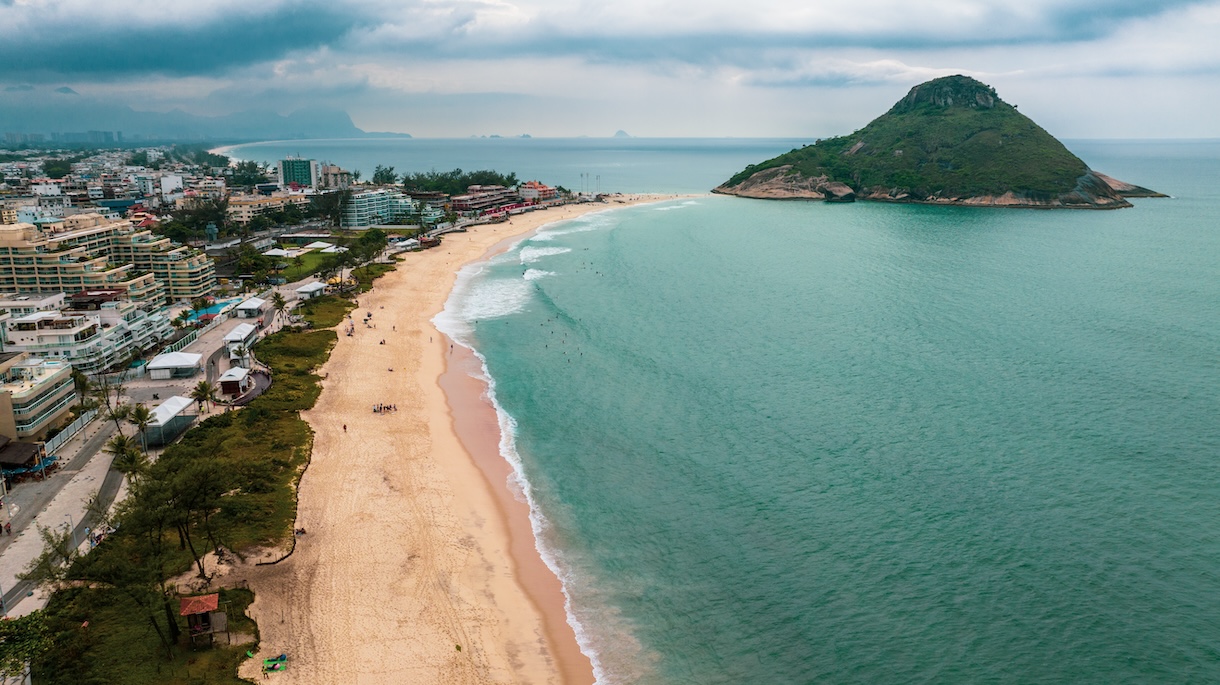
Macumba Beach, Rio de Janeiro. Photo: Naslo Bustamante
5. The Divisions
365 athletes will compete across four divisions:
- Girl’s U/16
- Boy’s U/16
- Girl’s U/18
- Boy’s U/18
6. Gender Equality
A record 177 girls (44% of competitors) will compete and represent their nations in the 2023 WJSC. Since 2017 the ISA has offered equal competition slots for men and women across its World Championship Series, promoting women’s participation and gender equality in surfing.
7. Where to Watch
The live webcast will be streamed on www.isasurf.org from November 24 – December 3. Visit isasurf.org for results, team rosters, photos, videos, and news pertaining to the competition.
8. Social
The ISA will be posting live updates, photos and videos from the competition on social media. Follow along on Facebook, Instagram, Twitter and YouTube. Don’t forget to use the official hashtag #ISAworlds.
- Facebook: International Surfing Association
- Instagram: @ISAsurfing
- Twitter: @ISAsurfing
- YouTube: @ISAsurfing
- Tiktok: @isasurfing
9. Schedule
- November 24 – Opening Ceremony, Macumba Beach; 3:30pm – Local Time
- November 25 – December 2: Competition Days
- December 3: Finals and Closing Ceremony
10. The ISA and Brazil
The WJSC is being hosted by the Brazilian Surfing Confederation (CBSurf) with the strong support of the Brazilian Olympic Committee and the State of Rio de Janeiro.
It will be the 19th edition of the WJSC and the second time the event has been hosted by Brazil, after the 2006 ISA World Junior Surfing Championship was held in Maresias. Two historic editions of the ISA World Surfing Games were also hosted by Brazil, the first of which was in Rio de Janeiro in 1994.
Opening Ceremony:
National Teams will parade carrying their flags to the “Sands of the World” ceremony.
Date: Friday Nov 24th
Place: Macumba Beach
Time: 3:30pm – Local Time
Competition runs from Nov 25th to Dec 2nd.
Watch live webcast via this link and check ISA's social platforms for daily news.
How TAFE Digital NSW Helped Nymoida Teen Sow Seeds Of Success While Still At School
TAFE Digital has helped a Nymboida teen launch a promising career while still at school, giving him the skills and experience to land a job in the booming horticulture field.
This time last year, while most of his South Grafton High friends were agonising over their HSC, Tom Lavery was already working as a school-based trainee biosecurity officer at Clarence Valley Council, part of a unique arrangement that allows high school students to “earn and learn” simultaneously.
It comes as the horticulture industry rides the crest of a post-COVID jobs boom, with Labor Market Insights predicting a 14 per cent increase in gardening and landscaping jobs nationwide over the next two years.
“I’ve always loved the outdoors and school work was never my strong point, so to be able to start a career I wanted and make money while still at school was great,” Mr Lavery said.
“I was able to walk straight from school into a full-time job.”
Under the school-based traineeship, Mr Lavery worked one day a week at council and split the rest of his time between his Certificate II in Horticulture at TAFE NSW and his school work.
“Being able to study my TAFE NSW work online was perfect because it meant I didn’t have to go into a campus and I could study where and when suited me,” he said.
“My teacher had so much industry knowledge and was really supportive.
“And I love my job: I’m outdoors and in a different location every day, it keeps me fit, the money is good for a young fella and I get to help the environment.
“There’s also a real career path at council. Who knows, I could be running my team here one day.”
TAFE Digital horticulture teacher Emma De Landre, a 30-year veteran of the horticulture industry, said the industry had surged in growth during COVID lockdowns and maintained momentum since.
“There is a huge demand for our graduates and plenty of jobs around,” Ms De Landre said.
The Diploma of Horticulture Management will be offered for the first time via TAFE Digital in 2024 and is a fee-free course. It includes units in identifying and selecting trees, diagnosing plant health, managing staff, and preparing estimates, quotes and tenders. The course requires students to hold a minimum of a Certificate III to enrol, and qualifies graduates to earn roles such as parks and gardens supervisor, landscape manager, and nursery manager.
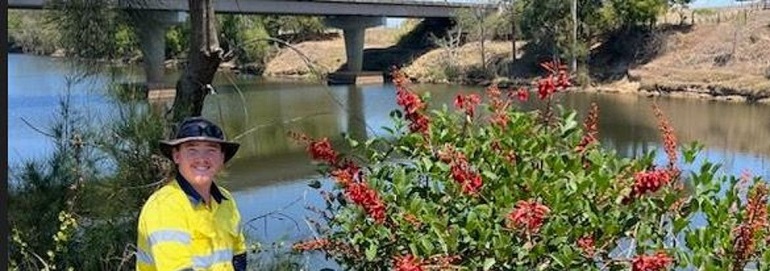
Photo: WEED PATROL: TAFE Digital Tom Lavery is busy forging a career while many of his mates are still sweating on HSC results.
TAFE Digital offers a wide range of nationally recognised, online study options, across a range of modern industries. You can study online and enjoy flexible learning to fit your lifestyle, with our online short courses, certificates, diplomas, and degrees.
Have a look at what's available at: https://www.tafensw.edu.au/digital
TAFE NSW Semester 1, 2024
Enrol now. Explore courses at: https://www.tafensw.edu.au/course-areas
Some Late November Insects
Many of you will have noticed there are a lot of flying and crawling insects around at the moment. Those who work in the field of ants will know that there are tiny black and brown ones and big ones, Bull ants, with nippers on the ground while those that fly have taken to the air with the rains we've been having lately.
The ants we’re most used to seeing are female black garden ants or the brown coastal ants, marching around collecting food. But during Summer, winged males and new queens of the same species take to the air. The ants take to the skies so that queens can mate with males from different colonies, and set up new nests of their own. For a swarm of ants to occur, conditions must be just right – they’re usually triggered by hot and humid weather, which is why we start seeing them in late November and swarms of them over Summer.
There are also moths flapping around at dusk and all through the night, although we haven't seen any bogan moths for years now, along with the first cicadas emerging these past few weeks - in fact, at Avalon, Clareville, Narrabeen and Elanora Heights people have been seeing Greengrocer cicadas emerging and shedding their skins. The past few years we've had masses of Black Prince cicadas emerging and trilling for around six weeks making a deafening noise.
Insects (from Latin insectum -Etymology. From Middle French insecte, from Latin īnsectum, from īnsectus “cut into, cut up, with a notched or divided body”, from the notion that the insect's body is "cut into" three sections; head, thorax, abdomen) are pancrustacean hexapod invertebrates of the class Insecta.
Insects are the largest group within the arthropod phylum. Insects have a chitinous exoskeleton, a three-part body (head, thorax and abdomen), three pairs of jointed legs (six legs!), compound eyes and one pair of antennae. Their blood is not totally contained in vessels; some circulates in an open cavity known as the 'haemocoel'. Insects are the most diverse group of animals; they include more than a million described species and represent more than half of all known living organisms. The total number of extant species is estimated at between six and ten million; potentially over 90% or 4/5ths of the animal life forms on Earth are insects.
This Issue a few of those we've spotted in our own yard and around the streets this past week.
Some ant species live in colonies that are supported by a single queen while others are supported by multiple queens. Although there are 1,300 ant species known in Australia, there are relatively few that we commonly see as pests as most are what is termed 'beneficial insects'.
Beneficial Insects
Beneficial is an adjective with a meaning of 'resulting in good; favourable or advantageous'.
Ants are known as beneficial insects because they keep the ecosystem clean of dead insect carcasses and aid in the destruction and decomposition of plant and animal matter. By carrying bits of plants and animal remains into their nests, the soil is fertilised and nutrients recycled through the world's ecosystems.
Other beneficial insects are bees, ladybugs, moths, lacewings, red and blue beetles, and a small native wasp, Microplitis. There are others - but in just these we have those that get rid of bugs that may destroy your plants, along with those that carry pollen to other plants to help them flower and grow into fruits and vegetables and nuts.
That's why you want to encourage insects to come into your garden by planting species that will attract them or making sure there's some good habitat for them - flowering plants, rotting logs, trees that have hollows, patches of grasses and rocks.
Ok - some of the insects we've spotted in the last week of November 2023.
Late November insects seen this past week
Bull ants are large, alert ants that can grow up to 40 mm They have characteristic large eyes and long, slender mandibles and a potent venom-loaded sting. They have superior vision, able to track and even follow intruders from a distance of 1 metre. Many species of bull ants have bright red or orange colours on the head or abdomen.
There are about 90 species of bull ants in Australia with diverse behaviours and life cycles. Nine bull ant species have been recorded in Sydney, but there may be more as yet undiscovered. Some of the smaller species are known as jumper ants after their habit of aggressively jumping toward intruders.
Bull ants live in urban areas, forests and woodland, and heath, including the coastal heath ecological communities we have here in Pittwater. Bull ants collect nectar and other plant juices, as well as animal prey, which are carried back to the nest.
Bull ant nests are usually underground and often have hidden or small entrances. The nests can extend several metres below the ground. They attack intruders of any size that come too close to their nest. Bull ants also have well-developed vision and will follow or even chase an intruder a good distance from the nest. Usually the sight of large aggressive ants streaming out of the nest is enough to prompt a hasty retreat. If not, the ants deliver painful stings by gripping the intruder with their mandibles (jaws), curling their abdomen to reveal the sting and injecting the victim with venom. Often multiple stings are delivered.
Several species have no colony workers. Instead, a raiding queen invades the nest of another species, kills the resident queen and takes over the colony. The queen may live for several years.
.jpg?timestamp=1700786483391)
Bull ant, Myrmecia sp, taken in bushland surrounding Swifts Creek, Victoria. Specimen is approximately 25mm in size. Photo: fir0002.
These ants can deliver painful stings and are aggressive. An ice pack or commercially available spray may be used to relieve the pain of the sting. If there is evidence of an allergic reaction, medical attention should be sought.
The Greengrocer Cicada, Cyclochila australasiae, is probably the most commonly encountered in the Sydney area. The two common names of Greengrocer and Yellow Monday refer to different colour forms of the same species. The origin of the names is unclear but they are known to have been in use as early as 1896. Other names for different colour forms include Chocolate Soldier (dark tan form) and Blue Moon (turquoise form).
Greengrocers are common on a range of trees, the adults spend much of the daytime sucking sap from branches.
.jpg?timestamp=1700787912886)
Greengrocer Cicada, Cyclochila australasiae, photographed Thursday November 23 2023. Photos: Selena Griffith
.jpg?timestamp=1700787943428)
Dusk is the usual time to hear the male Greengrocers calling for females, but they also sing in the morning on warm days. The harsh song may be continuous or delivered in short bursts, and can be extremely loud and penetrating.
Adult Greengrocer cicadas live for around six weeks. Females deposit eggs into dead or dying branches of a food plant. The eggs hatch after about four months into spidery-looking, long-legged nymphs that burrow into the soil. Here they suck sap out of plant roots and grow for up to seven years, emerging as adults between September and November on warm nights often following rain.
These little flying beetles make their appearance around now and this one flew into our kitchen this week - that's Eric's finger it's resting on so we could take some photos for you. It then flew off again!
This is a Phyllophaga and part is a very large genus (more than 260 species here) of New World scarab beetles in the subfamily Melolonthinae. Common names for this genus and genera of the subfamily are May beetles, June bugs and June beetles as they appear in America during those months (they have 750 species counted so far) although here they appear during our warmer months of November, December and January.
They are quite hard shelled which is why you may hear them bouncing off your walls indoors, and fly very fast. They are medium to large oval or cylindrical beetles, body length 8-25mm. Body colouration commonly brown to reddish brown, and blackish.
Larvae of Phyllophaga feed on the roots of a large range of plants and grasses. Adult beetles feed on plant foliage, and can cause significant damage when mass emergences occur. Both forms can have severe impacts on a large number of cultivated crops including maize, sorghum, wheat, rye, beans, oat, potato, sugarcane, turnip and cranberry. They can also be a significant pest of pastures and turf. Most adults emerge late spring/ early summer. Adults are nocturnal, and attracted to light. Night feeding beetles are not easily disturbed, leading to easy collection from their host plants. Among the recognised pest species in Australia are: P. anxia, P. crinita, P. ephilida, P. elenans, P. fusca, P. implicita, P. menetriesii, and P. vicina.
We also spotted a Christmas Beetle on Saturday Morning, November 25, unfortunately someone had stepped on it and it was squashed. Christmas beetle is a name commonly applied to the Australian beetle genus Anoplognathus, which belongs to the subfamily Rutelinae. They are known as Christmas beetles because they are abundant in both urban and rural areas close to Christmas.
There are about 36 species of Christmas Beetles (family Scarabaeidae) with all but one unique (endemic) to Australia and 21 species found in New South Wales. At least 10 species occur in the Sydney region – more if the Blue Mountains are included. Anoplognathus viriditarsus is the largest of the Sydney Christmas beetles.
Christmas Beetles come into Sydney from surrounding woodland where the adults feed on eucalyptus leaves and the larvae feed on grass roots. Adults can occur in large numbers, sometimes completely defoliating trees. The total number of Christmas Beetles reported in the Sydney area has declined over the last 30 years as the grassy woodland areas get used up for housing.
This moth is a Acosmeryx cinnamomea, a species of in the family sphinx moths. Sphingidae (Sphinx Moths) is a family of Lepidoptera (Moths And Butterflies). They eat the leaves of Cayratia clematidea (wild grape), Cissus antarctica (Kangaroo vine), Cissus oblonga, Vitis vinifera (wine grape/edible grape), Vitis vinifera rupestris (ornamental grape). They are Nocturnal - Active at night. Their colour ranges from brown to grey. Their size at rest - tip of thorax to tip of either forewing: 49mm.
As you can see, this one has a bald spot. Moths and butterflies constantly accumulate damage on their wings and bodies over time, and they're especially prone to loosing the delicate scales that coat their exoskeleton (which is usually visible as a 'bald spot' on the top part of a moth's thorax when it's been bumping around a light for a few hours). You can even get a sense of a moth's age by seeing how worn and tattered its wings are; newly emerged individuals are usually pristine, while older ones have frayed wings and patches of missing scales.
The species is found in North-Western WA, Northern NT, Far North Queensland and south along the coast through QLD, NSW to northern tip of VIC. The caterpillar grows to a length of about 8cms. The pupa has a length of about 4.5 cms.
Finally, how about one more of the moths you are likely to see at present? This one flew in and hovered around the computer and then dived down the back of the desk, where there are heaps of cobwebs, on Friday morning at dawn - obviously coming indoors for the day - and reminding me to clean behind my desk! - whoops....
This is a Tiger Moth.
Unlike many other moths, Tiger Moths has bright orange bars and spots on its wings. They have striped abdomens which has given them their name. Most Tiger Moths fly at night but some are day-fliers. They do not fly very fast.
Most Caterpillars of the Arctiidae are covered in dense dark hairs, which gives them the name "Woolly Bears". The hairs can cause irritation in sensitive skin. The caterpillars are small to medium size. The caterpillars usually active during the daytime. If disturbed, they will roll into a tight spiral.
Tiger Moths live on the coastal areas of eastern Australia. You will find Tiger Moths on plants usually around flowers, around water such as puddles and in the air.
After dark Tiger Moths emit ultrasonic clicks which can be picked up by insectivorous bats. These clicks warn the bats that the moth is unpleasant to eat, and also jams the bats’ sonar system.
The Tiger Moth is a food source for small birds. Luckily for the Tiger Moth, most predators know its marked patches of orange and black mean that the moth is distasteful or poisonous.
They love to drink the nectar from wildflowers and prefer an established garden, where they can also eat lichen. Lichen occurs when fungi and algae grow together. In rainforests and alpine forests it forms a large carpet on the ground. Keep a look out for grey, green or yellow patches on your backyard rocks and trees.
Finally, a lot of our local insects are food for birds that live here. This week we also spotted the pair of Butcher Birds that live in our yard have had two babies this year and they are now able to fly around a bit, known as 'fledglings' at this stage, and be taught how to catch insects for their own dinner. Although, as you can see from the photos, one was trying out a larvae as well.
calling to mum and dad; feed me! feed me!
leaning off the top of the fence top get a larvae pod
success!
his/her brother or sister was a little further along the same fence top, also hunting for insects
Ok - we'll keep taking photos of insects we spot over Summer and will bring you more on our local insects soon.
Information from the Australian Museum and Backyard Buddies and the NSW Department of Primary Industries Photos: A J Guesdon
This Week's History Snippet: Avalon Beach Rock Pool
Avalon had 'natural attributes' and had a bonafide 'rock pool' to begin with and existed from at least 1921.
Geoff Searl, president of the Avalon Beach Historical Society, states;
The ‘Bathing Pool’ was as close to a natural rock pool as geologically possible. In 1917 A.J.Small lodged a cheque with Warringah Shire Council to allow workmen to formalise the shape and level the bottom of the pool to improve its use. Access to the pool at the time was somewhat difficult and at your own risk with some huge boulders to climb over.
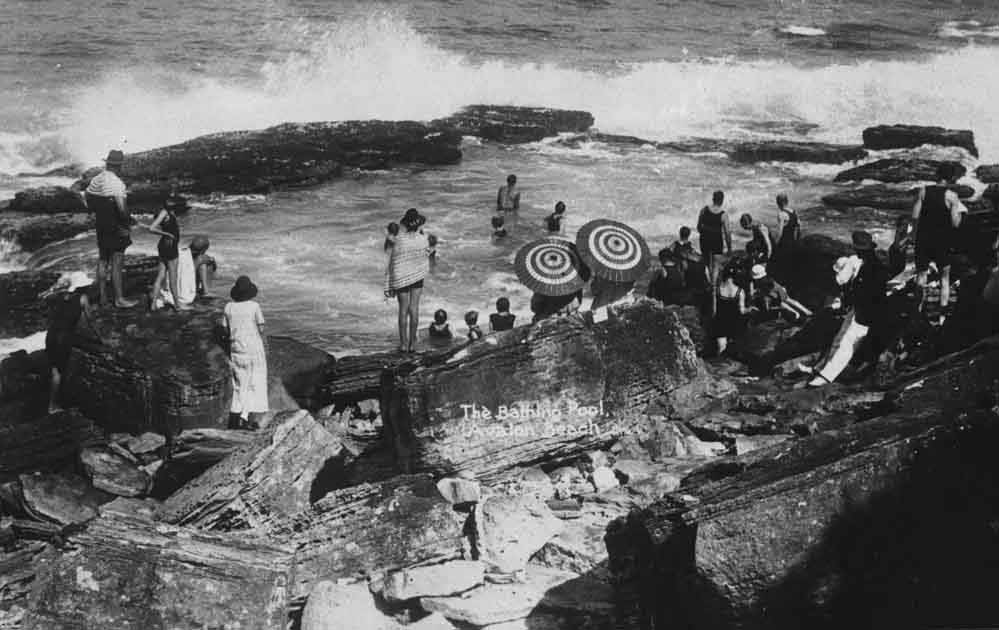
'The Bathing Pool. Avalon Beach' by Rex Hazelwood, circa 1920 - courtesy State Library of NSW
In 1922 this was 'improved':
IMPROVING AVALON. ROADSIDE TREES PLANTED
Since the sale of Avalon Beach Estate at Christmas additions and improvements have been effected on the estate.
The rock pool baths at the southern end of the beach have been extended 18ft., and are now 57ft. long, with a smooth -bottom. Ladies' dressing sheds have been erected Immediately at the roar, on a spot once occupied by a jumble of rocks, and a general store and refreshment room of original design has been built close to the beach.
Several landowners are already building homes on their lots. A new, wide road has been constructed, giving the land direct access to the beach, and at the side of all the roads, trees, of eight different varieties, chosen as specially suitable for the land land atmosphere, have been planted: One of these is the Illawarra Flame Tree, which carries blooms of fire color.
IMPROVING AVALON (1922, March 22). The Sun (Sydney, NSW : 1910 - 1954), p. 10 (FINAL RACING). Retrieved from http://nla.gov.au/nla.news-article225222882
THE ROCKY COAST OF AVALON.
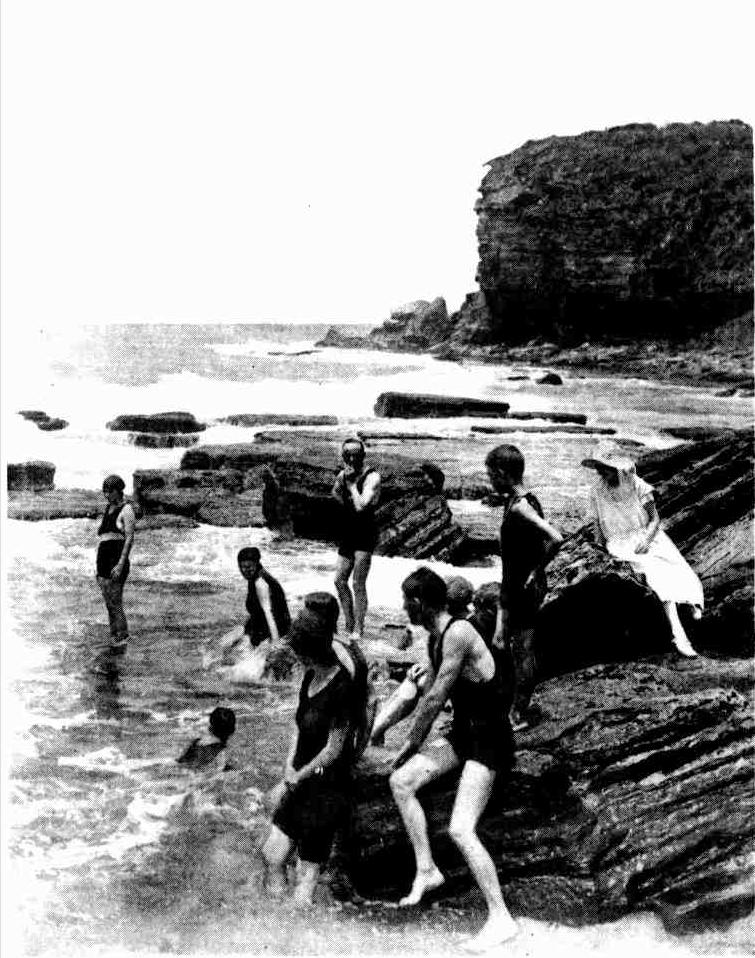
Avalon is near Palm Beach, that exquisitely beautiful spot beyond Newport, which in recent years has become a fashionable holiday and week-end resort. These young people an enjoying themselves at what is known as the Avalon bathing hole, a natural rocky bath, which has been improved by the residents in the locality. Current (1923, January 17). Sydney Mail (NSW : 1912 - 1938), p. 7. Retrieved from http://nla.gov.au/nla.news-article159024708
A J Small, Avalon Beach developer is writing to council in May 23rd 1925 stating that a recent storm has damaged the swimming pool, the dressing sheds for these and the ladies dressing sheds on the beach - here too the swimming pool is referred to as 'Avalon Beach Rock Bath' during this era:
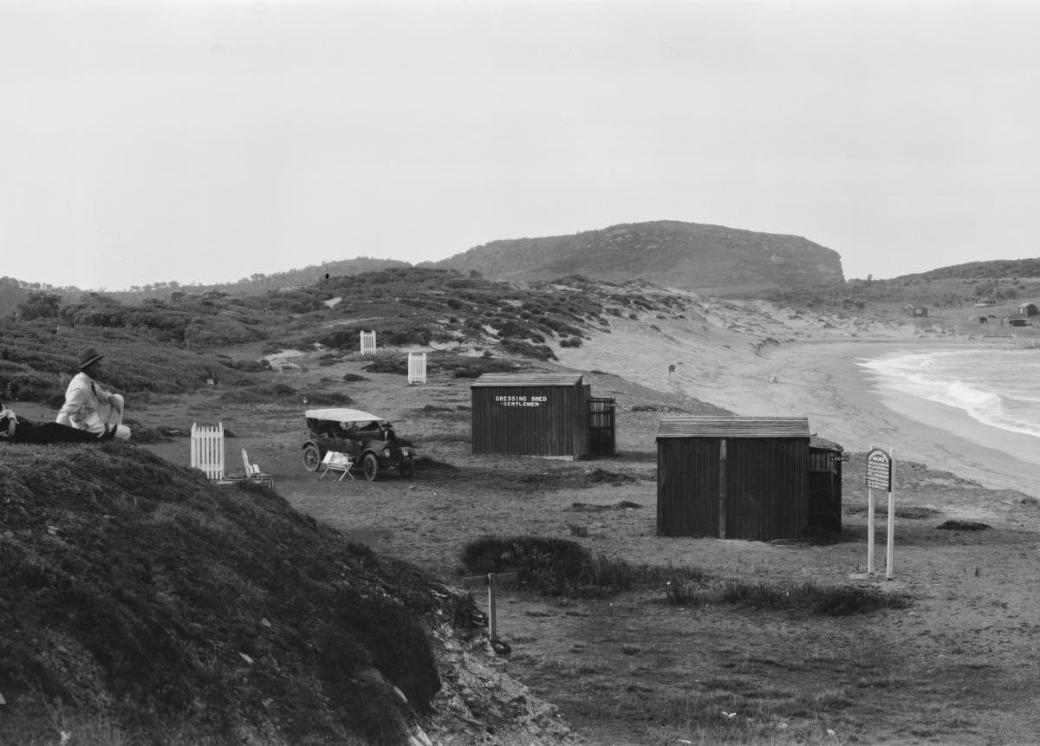
'Panorama of beachgoers at Avalon Beach', New South Wales, ca. 1925 (1920; no mid-beach dressing sheds in picture as per 1921/22 photos from sales plans/advertisements) - section enlarged to show dressing sheds on Avalon Beach at this point in time. Full picture below. The beginnings of Norfolk Pines, planted by A J Small are in the white wicker tree guards. Image No.: nla.pic-vn6217968 by EB Studios, part of the Enemark collection of panoramic photographs, courtesy National Library of Australia.

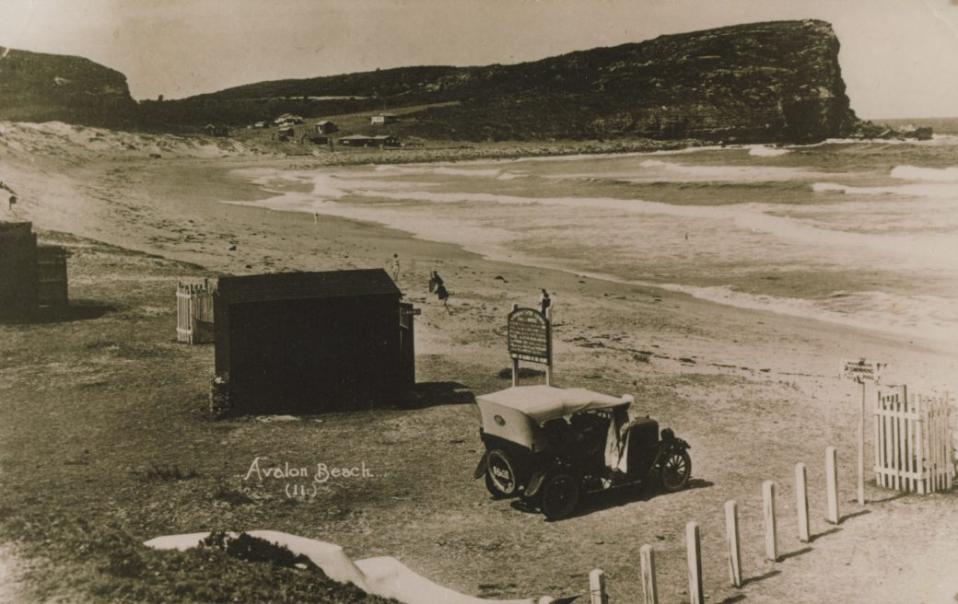
THE ROCK BATHS AT AVALON BEACH.

As a part of its policy the Warringah Shire Council has instituted enclosed baths at all the popular beaches under its control. Some, as at Avalon, are cut out of the solid rock, while others have been partly excavated and built up with concrete walls. They form a valuable adjunct to the beaches on account of their freedom from danger. THE ROCK BATHS AT AVALON BEACH. (1927, February 2). Sydney Mail (NSW : 1912 - 1938), , p. 22. Retrieved from http://nla.gov.au/nla.news-article169144831
POPULAR AVALON.

The popular rock baths at Avalon, skirting the (3) Three (3) Beaches Estate. (See advertisement on this page.) No title (1929, June 30). Sunday Times (Sydney, NSW : 1895 - 1930), , p. 11. Retrieved from http://nla.gov.au/nla.news-article131640629
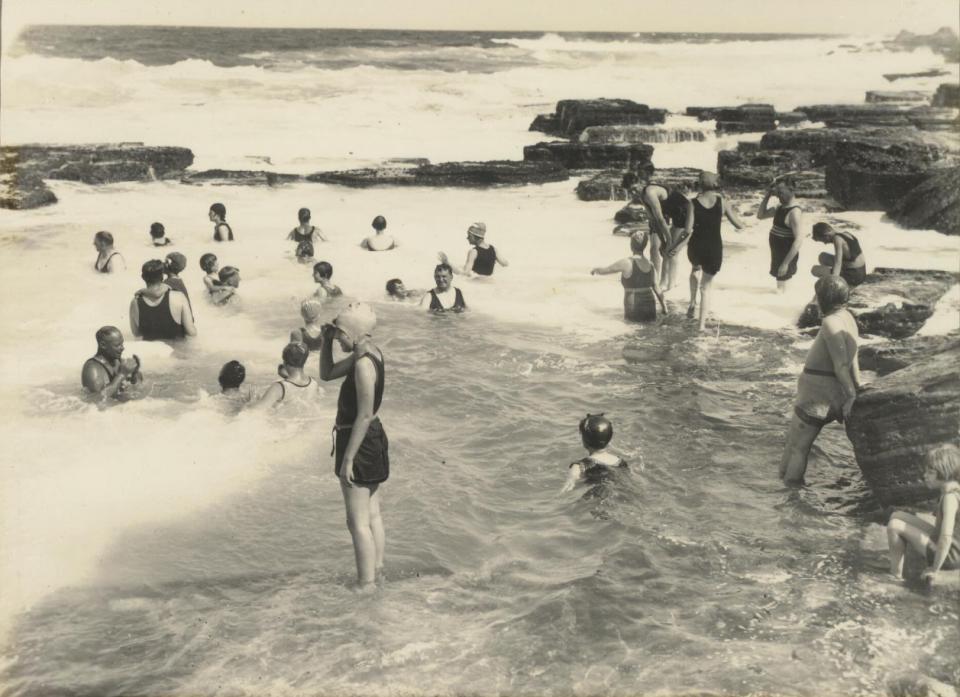
From The National Library of Australia NLA Pic 24770604 - Unidentified People Swimming in Rockpool, Avalon Beach, New South Wales,1930 (members of the Williams/Fox Family state and one of these girls is Sophie Iris Williams)
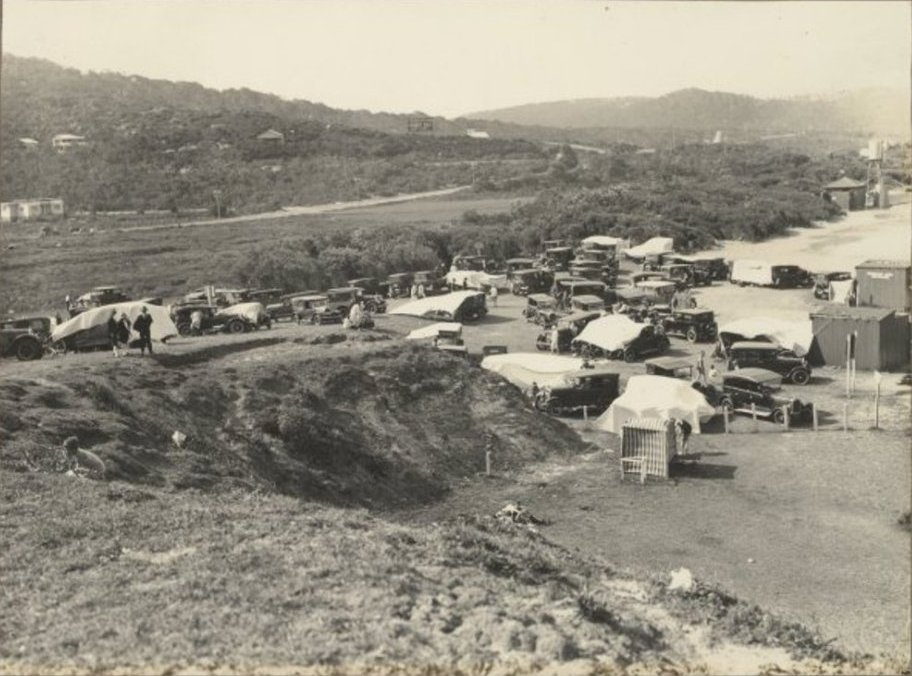
This photo shows the extent of the dressing sheds and showers in 1930 - those at the southern end would have been the rockbath ones: 'Motor cars, some with tarpaulins attached, parked adjacent to Avalon Beach, New South Wales, 1930', nla.pic-an24768648, Part of Prospectus photographs of Avalon, 1930 [album], courtesy National Library of Australia.
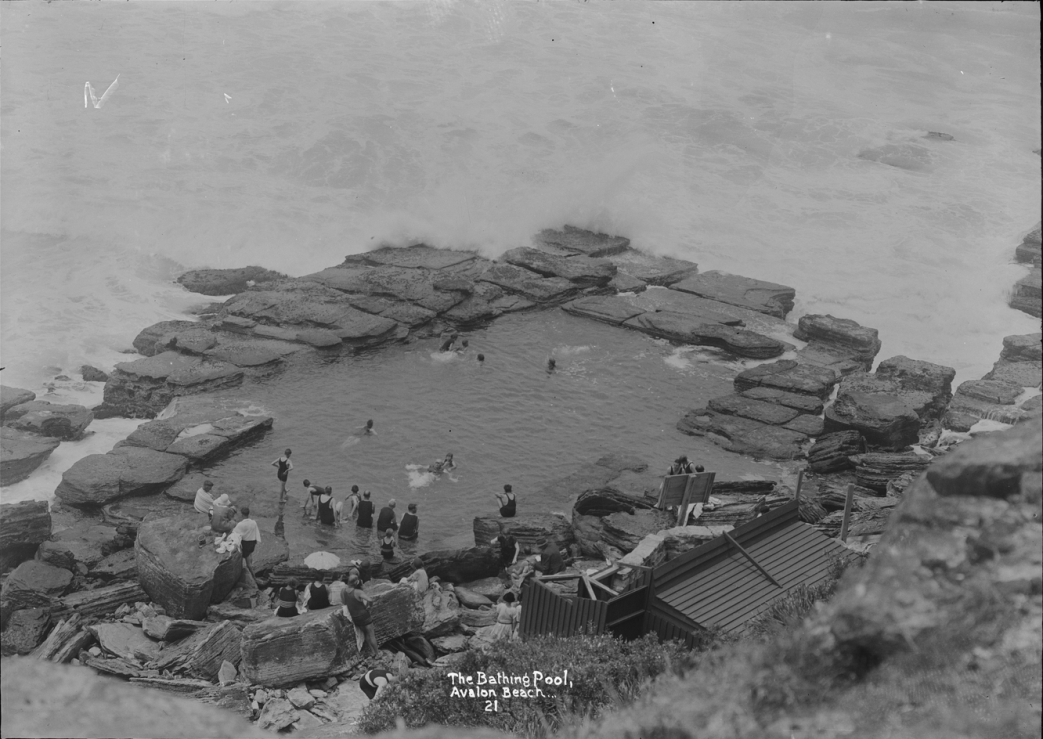
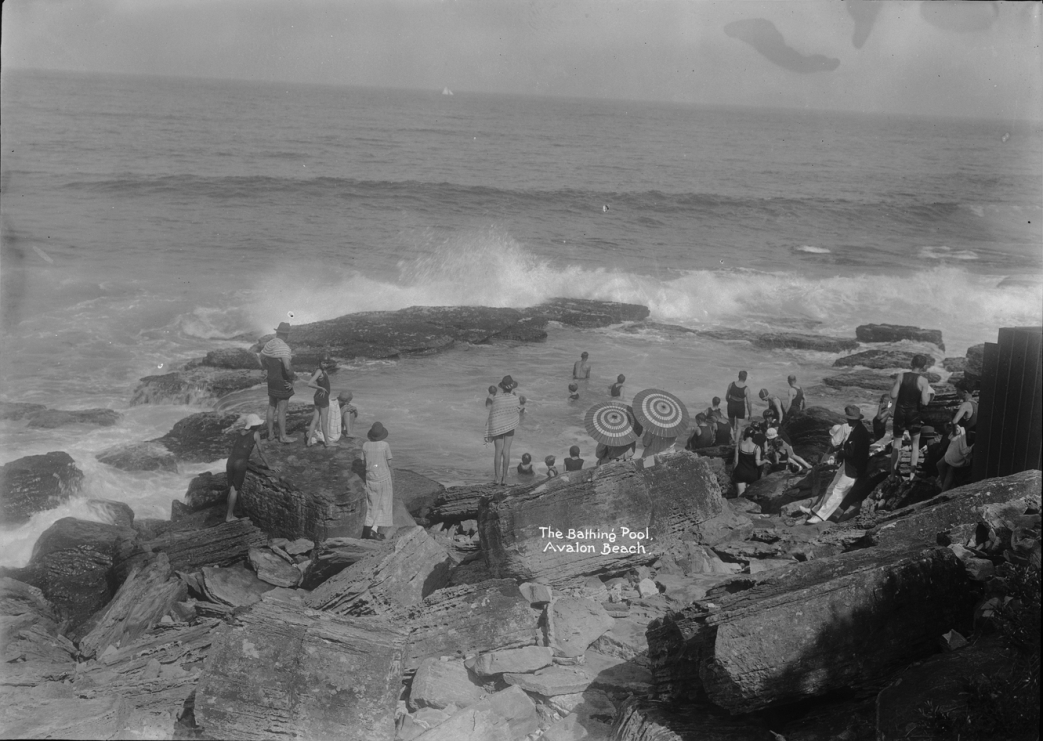
The bathing pool Avalon Beach - photos by Rex Hazlewood, circa 1920-1929 Images Courtesy The Mitchell Library, State Library of NSW, No.: c046220002h and c046220014h
As you can see in the photos and articles above, the waves would come in over these rocks and perhaps make for a bathing experience that wasn't as safe as it could be. Something that persisted for a few years.
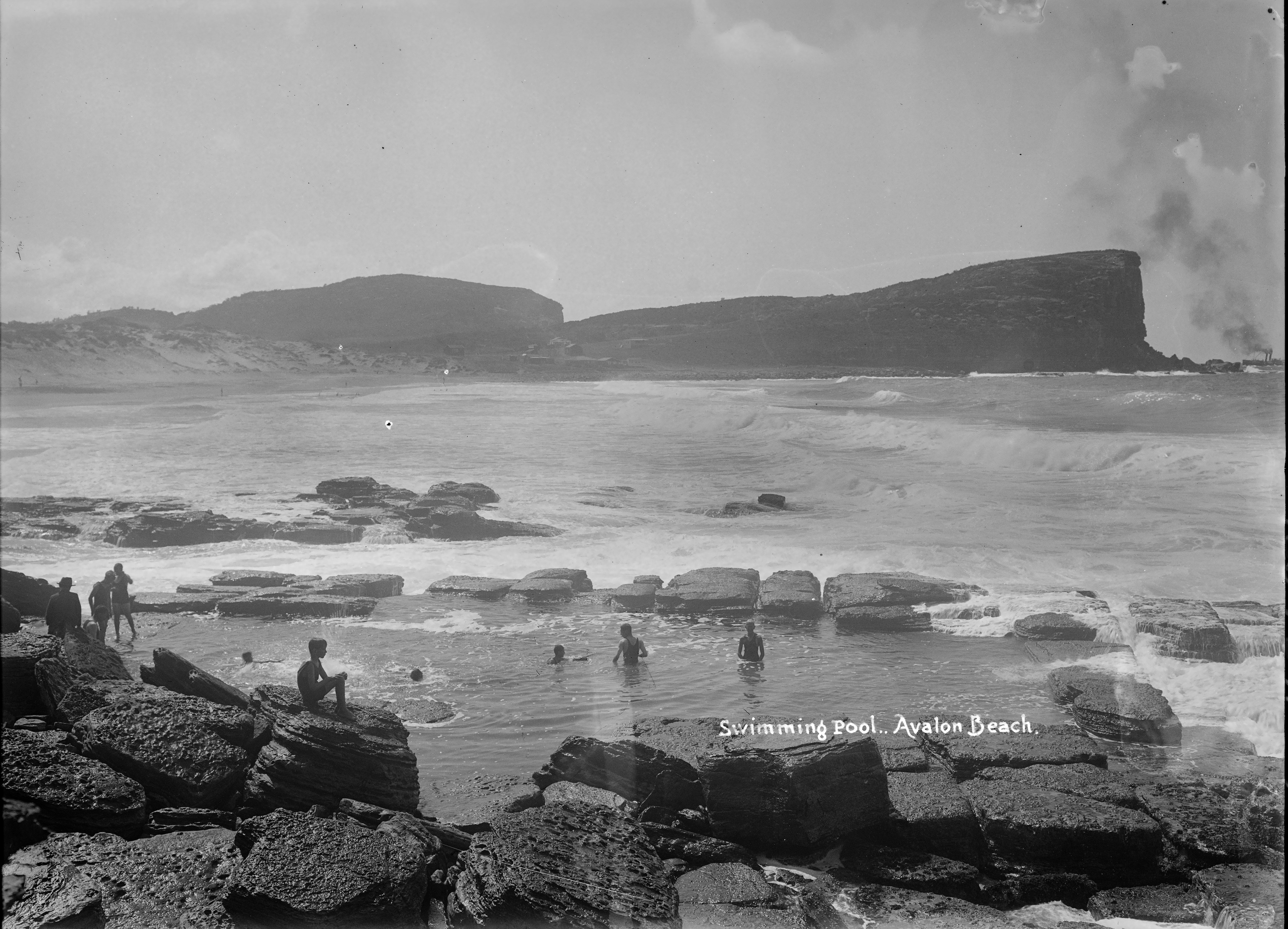
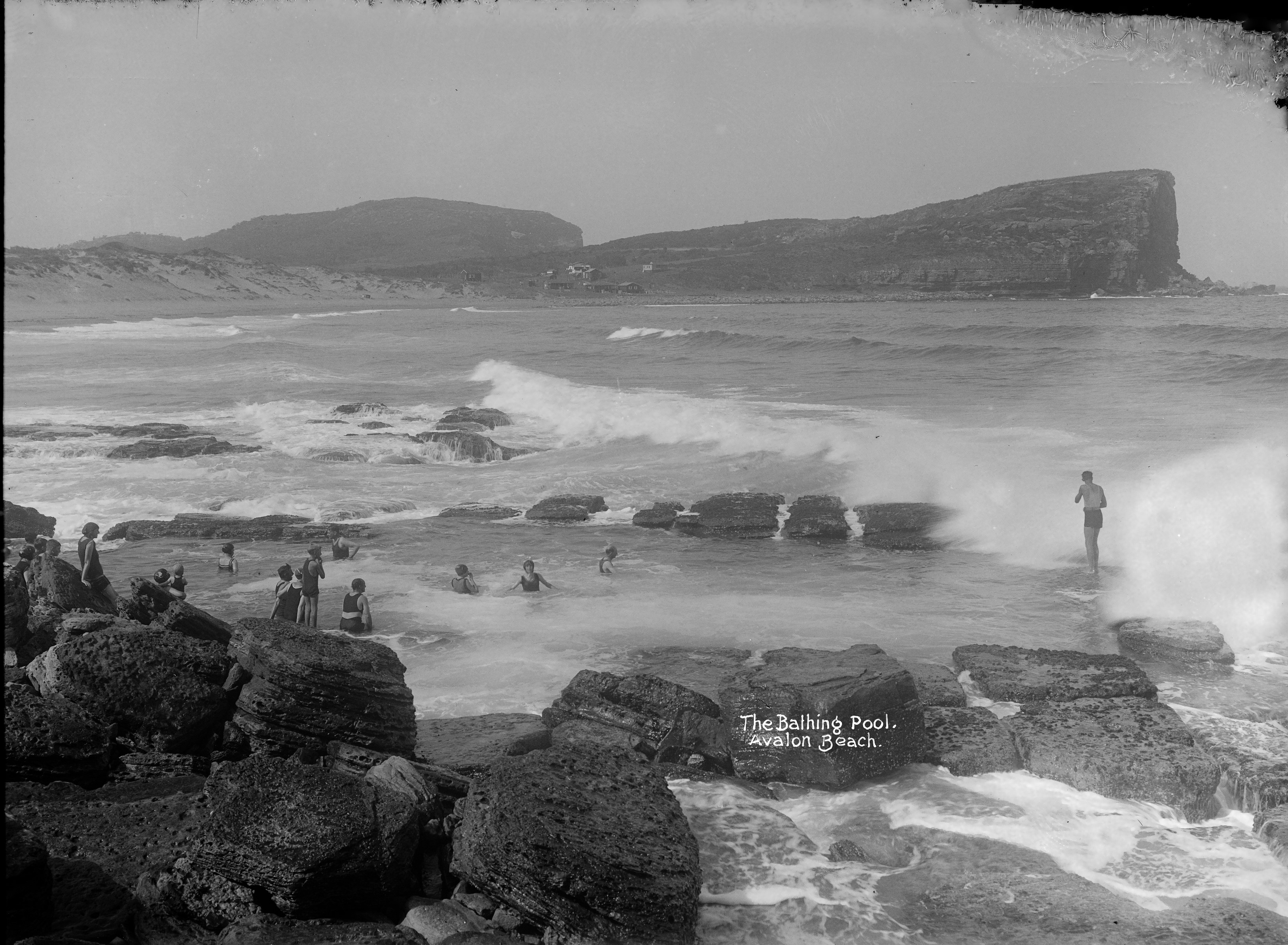
The Bathing Pool Avalon Beach - photos by Rex Hazlewood, circa 1920-1929 Images Courtesy The Mitchell Library, State Library of NSW, No.: c07771_0004_c and ' Swimming Pool' c07771_00043_c
At the June 15th, 1925 Warringah Shire Council Meeting a letter was read from A J Small: A: J. Small, 27/5/25, drawing attention to the damage' done during recent storm to (a) swimming-pool; (b) The Avalon Beach dressing shed at swimming-pool, and (a) ladies dressing shed on beach at Avalon ; Resolved, — (Crs. Hewitt, Hithcock) That the Engineer attend to the swimming pool, and the Inspector to the dressing sheds.
The Avalon Beach and District Progress Association began in March 1933 to ask that "an additional swimming pool be constructed at Avalon, or, alternatively that the existing Rockbath pool be increased in size and deepened" while another letter, a week later from this same residential body 'submitting plan of proposed dressing sheds at Avalon Beach, stating Mr. Rowe; Architect, is willing to prepare Proper plans, etc free of cost to Council.' This second submission was "Received".
During this same month the Avalon Beach District Progress Association was also asking when land would be resumed to create a Reserve for Avalon Beach and that the problem of straying cows and horses be addressed by introducing a compound.
In July 1935 the Avalon Beach Progress Association is asking that 'the path to the around the rockbath rocks be cleared of boulders; (b)that the safety chain be reinstated; and (c) that the plug be replaced.'
This request was granted and would be completed by the work gang who were at present at Whale Beach rockbaths attending to works needed there, but by October another letter stated the ' temporary plug' was completely 'inadequate'
In February 1936 the Avalon Beach Progress Association is 'inquiring whether anything has yet been done in regard to resumption of land adjacent to the Beach reserve to permit of safe approach to the beach by the public; requesting a statement showing how the money in the proposed loan for "A" Riding is to be expended; inquiring what steps have been taken regarding the enlargement of the rock pool, whether it in the intention to fit the valve in the pool, and reporting that the baths are without water at low tide;'
Interestingly this same letter is asking about the acquisition by Council of 16 allotments adjoining old Barrenjoey Road at Avalon, and inquiring 'for what purpose these were acquired, what was the purchase price, and how many Councillors inspected the land before or after the acquisition'.
By June 1936 the Association is again asking whether a provision has been made for the enlargement of the pool, suggesting this be done prior to the beginning of the 'surf bathing season' and are informed that the loan for A Riding does not include this project.
The following two years make reference to a water supply for Avalon Beach surf club now being part of monies allocated in November of 1936 and the need to redo the floor of the surf club building. A request that the association had to re-request with a result on April 14th, 1937 of: ' Council's decision to consider in six months' time the question of regrading and reconstructing the floor of the Avalon surf building, pointing out that steps towards doing this work should be taken in order that the work will be completed before next season. Resolved, - That £60 be voted for cementing and regrading the floor in accordance with the Inspector's report to last meeting and that the work be done in time for the next surfing season. '
Finally, on January 18th 1938, the Avalon Beach Progress Association, is thanking council for 'the splendid bathing pool now available, but pointing out that the depth of the pool is such as to preclude use by small children, and suggesting the formation of a children's pool at the northern end of the rockbath at a probable cost of £20.'
There is also a note in these January 1938 Minutes that the fixing of the surf club floor be 'expedited'. While on 7th of June, 1938, 'Avalon S.L.S, Club, again pressing the Council to comply with its request for extensions to be made to the Clubhouse during this winter in order that the Club may increase its membership, and be thereby enabled to patrol this beach properly, pointing out that it is useless to resume land at the beach to attract more people unless the Club is placed in a stronger position,' What was 'Resolved' in this request was 'That the letter be marked "received".
The mission to achieve a kiddies pool at Avalon Beach was similarly one that needed vigour and stamina. In August 1938 an inquiry whether provision had been made to make a children's pool part of the Avalon Rock baths was met with the response that it had not been. the reply expressed 'consternation' that it had not and requested that it be so - this was answered with a decision that ' the Engineer make inspection and furnish the Council with an estimate of the cost — of a new pool for the children, and that he get in touch with Dunbar, Secretary of the Association, and get him in consultation on the matter.'
By November 1938 the Association was again requesting a pool for the children, 'adjoining the northern side of the existing pool at Avalon; submitting sketch of proposed pool, and requesting that the work be undertaken.'
Unfortunately the Association were informed that there is no money available for the work at that present time, but, 'should there be any surplus from the camping and parking fees collected at Avalon, consideration will be given to the application of this money to the work'.
In May 1939 the Association again brought up the request for a children's pool, also stating that the bottom of the pool needed to be cleared of stones and that a rock wall between the cliff and sheds was needed. This time the answer was, 'that a children's pool be constructed at the Engineer's estimate of £75, and that the cost be charged to the Avalon Beach Income A/c, (Crs. Hitchcock, Latham).
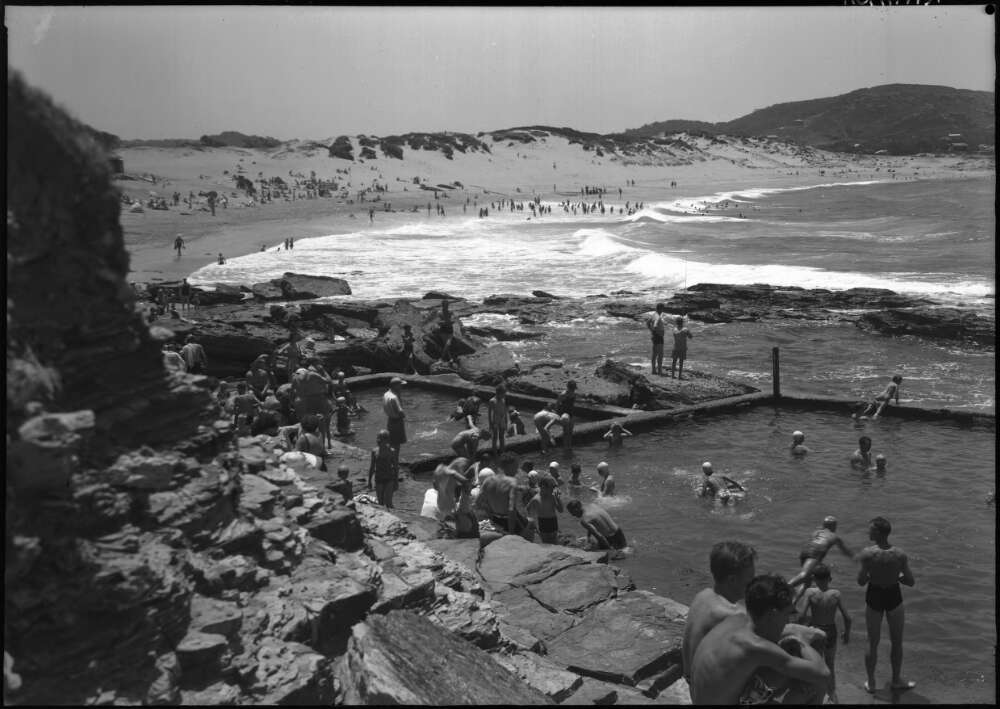
Hurley, Frank. ([ca.195-?]). [Sea baths and beach, Avalon Beach, New South Wales] Retrieved from http://nla.gov.au/nla.obj-160160048 National Library of Australia Picture No.: http://nla.gov.au/nla.obj-160160048
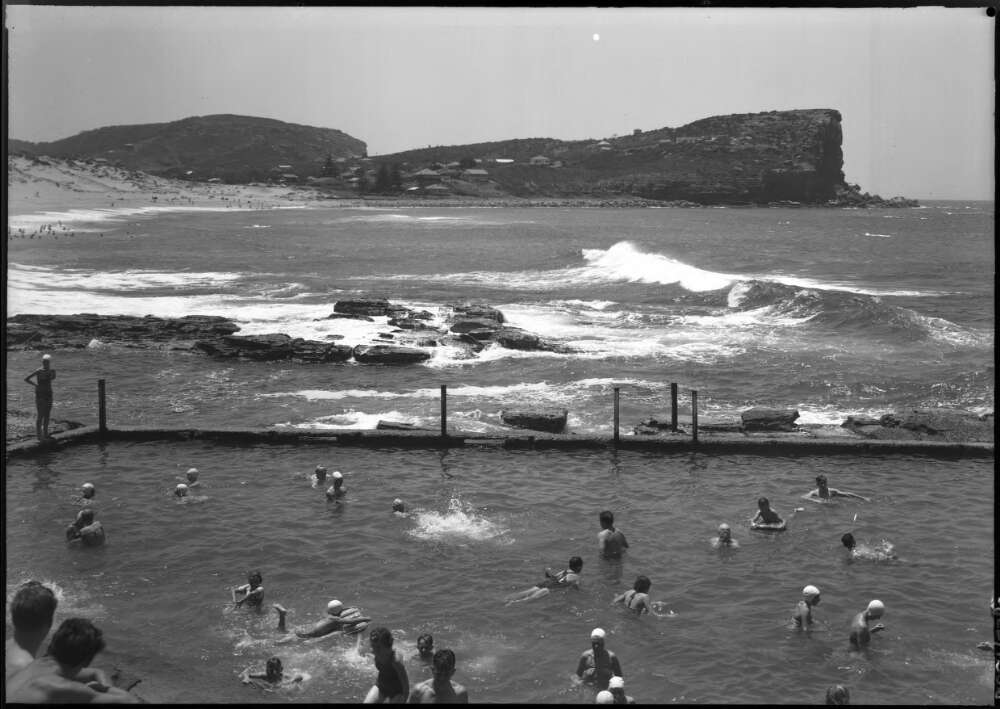
There were also rock pools at North Avalon. Both Geoff Searl of ABHS and Margie Charlton (nee Watt) recall natural pools that residents would clean out of rocks and debris so they could be used. Margie states:
There were three rock pools along the rocks at North Avalon that local people used to clear out to keep them free of rocks. The first one was a small baby one, then there was a middle one, and the end one, which is where I spent most of my childhood either fishing for toads, swimming around or just laying on the little sandy beach there. At high tide it was magnificent, and really quite deep. And that was what I based that artwork on – that third rock pool.
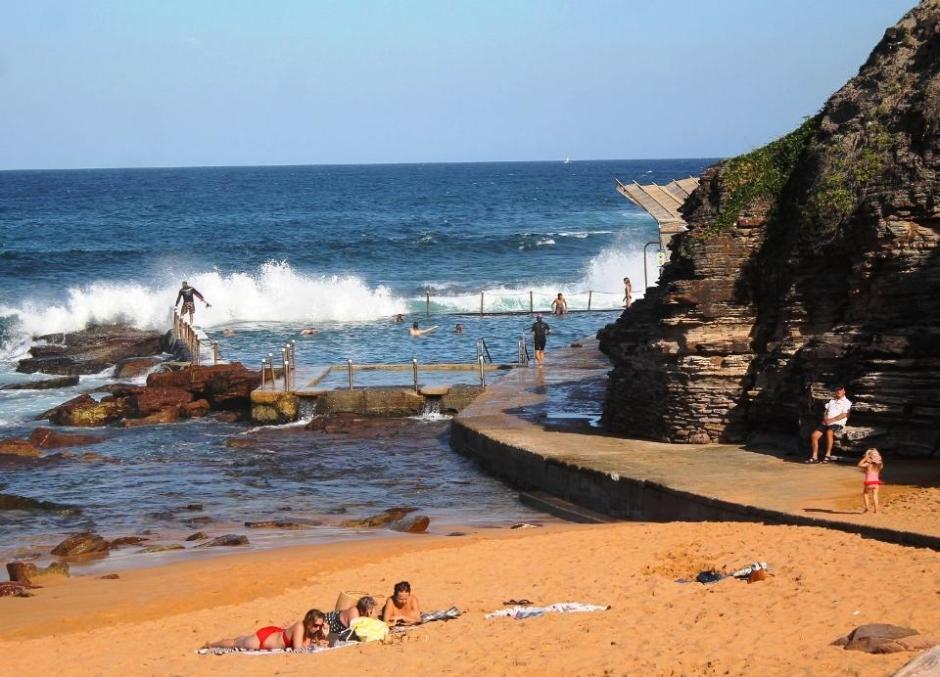
Avalon Rock pool in 2016 - showing the children's pool
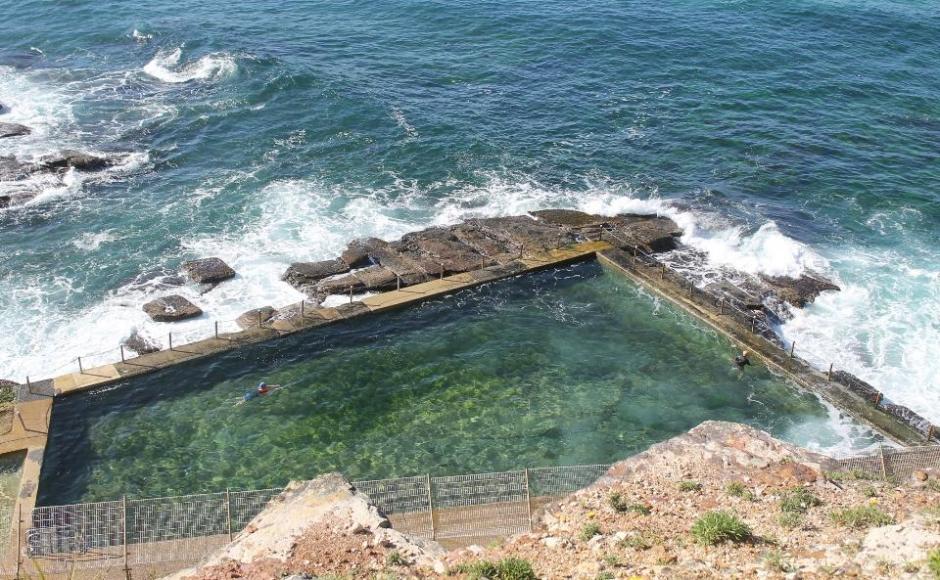
Avalon Rock pool in 2016
School Leavers Support
- Download or explore the SLIK here to help guide Your Career.
- School Leavers Information Kit (PDF 5.2MB).
- School Leavers Information Kit (DOCX 0.9MB).
- The SLIK has also been translated into additional languages.
- Download our information booklets if you are rural, regional and remote, Aboriginal or Torres Strait Islander, or living with disability.
- Support for Regional, Rural and Remote School Leavers (PDF 2MB).
- Support for Regional, Rural and Remote School Leavers (DOCX 0.9MB).
- Support for Aboriginal and/or Torres Strait Islander School Leavers (PDF 2MB).
- Support for Aboriginal and/or Torres Strait Islander School Leavers (DOCX 1.1MB).
- Support for School Leavers with Disability (PDF 2MB).
- Support for School Leavers with Disability (DOCX 0.9MB).
- Download the Parents and Guardian’s Guide for School Leavers, which summarises the resources and information available to help you explore all the education, training, and work options available to your young person.
School Leavers Information Service
- navigate the School Leavers Information Kit (SLIK),
- access and use the Your Career website and tools; and
- find relevant support services if needed.
Word Of The Week: Opportunity
Noun
1. a favourable juncture of circumstances. 2. a time or set of circumstances that makes it possible to do something. 3.a good position, chance, or prospect, as for advancement or success. 4. a chance for employment or promotion.
From: late 14c., opportunitie, "fit, convenient, or seasonable time," from Old French opportunite (13c.) and directly from Latin opportunitatem (nominative opportunitas) "fitness, convenience, suitableness, favourable time," from opportunus "fit, convenient, suitable, favourable," from the phrase ob portum veniens "coming toward a port," in reference to the wind, from ob "in front of; toward" (see ob-) + portus "harbor".
ob-
word-forming element meaning "toward; against; before; near; across; down," also used as an intensive, from Latin ob (prep.) "in the direction of, in front of, before; toward, to, at, upon, about; in the way of; with regard to, because of," from word-root epi, also opi "near, against"
+ port
"a bay, cove, inlet, or recess of a large body of water where vessels can load and unload and find shelter from storms; a harbour, whether natural or artificial," Old English port "a port, harbour, a place where there is a constant resort of vessels for the purpose of loading and unloading;" also "a town, market town, city," reinforced by Old French port "harbor, port; mountain pass." The Old English and Old French words both are from Latin portus "a port, harbour," figuratively "haven, place of refuge, asylum" (in Old Latin also "a house;" in Late Latin also "a warehouse"), originally "an entrance, a passage," akin to porta "a city gate, a gate, a door" (from prtu- "a going, a passage," suffixed form of root per- (2) "to lead, pass over").
Compare fortuity
1. the quality or state of being fortuitous. 2. the fact of something good happening by chance, rather than being planned, or an example of. 3.an accidental occurrence. 4. an instance of great luck or good fortune.
From 1650s, from Latin fortuitus "happening by chance, casual, accidental," from forte "by chance," ablative of fors "chance" (related to fortuna; see fortune). It means "accidental, undesigned" not "fortunate." Earlier in this sense was fortuit (late 14c.), from French. Related: Fortuitously; fortuitousness.
-ity
word-forming element making abstract nouns from adjectives and meaning "condition or quality of being ______," from Middle English -ite, from Old French -ete (Modern French -ité) and directly from Latin -itatem (nominative -itas), suffix denoting state or condition, composed of -i- (from the stem or else a connective) + the common abstract suffix -tas
Fortune
noun
1. chance or luck as an arbitrary force affecting human affairs. 2. the entity or power believed by some to bring good or bad luck to people; luck; chance; fate. often personified. 3. a large amount of money or assets.
From Middle English: via Old French from Latin Fortuna, the name of a goddess personifying luck or chance.
c. 1300, "chance, luck as a force in human affairs," from Old French fortune "lot, good fortune, misfortune" (12c.), from Latin fortuna "chance, fate, good luck," from fors (genitive fortis) "chance, luck," possibly ultimately from PIE root bher- (1) "to carry," also "to bear children," which is supported by de Vaan even though "The semantic shift from 'load' or 'the carrying' to 'chance, luck' is not obvious ...." The sense might be "that which is brought."
Sense of "owned wealth" is first found in Spenser**; probably it evolved from senses of "one's condition or standing in life," hence "position as determined by wealth," then "wealth, large estate" itself. Often personified as a goddess; her wheel betokens vicissitude.
bher- (sense 1)
Proto-Indo-European root meaning "to carry," also "to bear children."
It forms all or part of: Aberdeen; amphora; anaphora; aquifer; auriferous; bairn; barrow (n.1) "frame for carrying a load;" bear (v.); bearing; Berenice; bier; birth; bring; burden (n.1) "a load;" carboniferous; Christopher; chromatophore; circumference; confer; conference; conifer; cumber; cumbersome; defer (v.2) "yield;" differ; difference; differentiate; efferent; esophagus; euphoria; ferret; fertile; Foraminifera; forbear (v.); fossiliferous; furtive; indifferent; infer; Inverness; Lucifer; metaphor; odoriferous; offer; opprobrium; overbear; paraphernalia; periphery; pestiferous; pheromone; phoresy; phosphorus; Porifera; prefer; proffer; proliferation; pyrophoric; refer; reference; semaphore; somniferous; splendiferous; suffer; transfer; vociferate; vociferous.
It is the hypothetical source of/evidence for its existence is provided by: Sanskrit bharati "he carries, brings," bhrtih "a bringing, maintenance;" Avestan baraiti "carries;" Old Persian barantiy "they carry;" Armenian berem "I carry;" Greek pherein "to carry," pherne "dowry;" Latin ferre "to bear, carry," fors (genitive fortis) "chance, luck," perhaps fur "a thief;" Old Irish beru/berim "I catch, I bring forth," beirid "to carry;" Old Welsh beryt "to flow;" Gothic bairan "to carry;" Old English and Old High German beran, Old Norse bera "barrow;" Old Church Slavonic birati "to take;" Russian brat' "to take," bremya "a burden," beremennaya "pregnant."
** Edmund Spenser (1552/1553 – 13 January O.S. 1599) was an English poet best known for The Faerie Queene, an epic poem and fantastical allegory celebrating the Tudor dynasty and Elizabeth I. An Anglican and a devotee of the Protestant Queen Elizabeth, Spenser was particularly offended by the anti-Elizabethan propaganda that some Catholics circulated. Like most Protestants near the time of the Reformation, Spenser saw a Catholic church full of corruption, and he determined that it was not only the wrong religion but the anti-religion. This sentiment is an important backdrop for the battles of The Faerie Queene.
Spenser was called "the Poet's Poet" by Charles Lamb, and was admired by John Milton, William Blake, William Wordsworth, John Keats, Lord Byron, Alfred Tennyson and others. Among his contemporaries Walter Raleigh wrote a commendatory poem to The Faerie Queene in 1590, in which he claims to admire and value Spenser's work more so than any other in the English language. John Milton in his Areopagitica mentions "our sage and serious poet Spenser, whom I dare be known to think a better teacher than Scotus or Aquinas". In the eighteenth century, Alexander Pope compared Spenser to "a mistress, whose faults we see, but love her with them all".
The language of his poetry is purposely archaic, reminiscent of earlier works such as The Canterbury Tales of Geoffrey Chaucer and Il Canzoniere of Petrarch, whom Spenser greatly admired.
Spenser used a distinctive verse form, called the Spenserian stanza, in several works, including The Faerie Queene. The stanza's main metre is iambic pentameter with a final line in iambic hexameter (having six feet or stresses, known as an Alexandrine), and the rhyme scheme is ababbcbcc. He also used his own rhyme scheme for the sonnet.
In a Spenserian sonnet, the last line of every quatrain is linked with the first line of the next one, yielding the rhyme scheme ababbcbccdcdee. "Men Call you Fayre" is a fine Sonnet from Amoretti. The poet presents the concept of true beauty in the poem. He addresses the sonnet to his beloved, Elizabeth Boyle, and presents his courtship.
Like all Renaissance men, Edmund Spenser believed that love is an inexhaustible source of beauty and order, and that we are all souls first, within bodies. In Men Call you Fayre' , the poet expresses his idea of true beauty - the physical beauty will finish after a few days; it is not a permanent beauty. He emphasises beauty of mind and beauty of intellect. He considers his beloved is not simply flesh but is also a spiritual being. The poet opines that he is beloved born of heavenly seed and she is derived from fair spirit and states that because of her clean mind, pure heart and sharp intellect, men call her fair. At the end, the poet praises her spiritual beauty and he worships her because of her Divine Soul.
Amoretti LXXIX
“Men call you fayre, and you doe credit it,
For that your self ye daily such doe see:
But the trew fayre, that is the gentle wit,
And vertuous mind, is much more praysd of me.
For all the rest, how ever fayre it be,
Shall turne to nought and loose that glorious hew:
But onely that is permanent and free
From frayle corruption, that doth flesh ensew.
That is true beautie: that doth argue you
To be divine and borne of heavenly seed:
Deriv'd from that fayre Spirit, from whom al true
And perfect beauty did at first proceed.
He onely fayre, and what he fayre hath made,
All other fayre lyke flowres untymely fade.”
― Edmund Spenser, Amoretti And Epithalamion
Amoretti LXXIX: Men Call you Fair
Men call you fair, and you do credit it,
For that your self ye daily such do see:
But the true fair, that is the gentle wit,
And vertuous mind, is much more prais'd of me.
For all the rest, how ever fair it be,
Shall turn to naught and lose that glorious hue:
But only that is permanent and free
From frail corruption, that doth flesh ensue.
That is true beauty: that doth argue you
To be divine, and born of heavenly seed:
Deriv'd from that fair Spirit, from whom all true
And perfect beauty did at first proceed.
He only fair, and what he fair hath made,
All other fair, like flowers untimely fade.
Spensers use of 'fortune' as now interpreted to denote wealth or a lot of assets, originally went back to this same spiritual wealth or deepening and richness of the soul in describing all the attributes neeed in one who would rule. Spenser says in his Preface to the The Faerie Queene poem that his goal is to show how a virtuous man should live:
THE FAERIE QUEENE
LETTER TO SIR WALTER RALEIGH
A LETTER of the Authors expounding his whole intention in the course of this worke;[1] which, for that it giveth great light to the reader, for the better understanding is hereunto annexed.
TO THE RIGHT NOBLE AND VALOROUS
SIR WALTER RALEIGH, KNIGHT.
Lo: Wardein of the Stanneries, and her majesties lieutenaunt of the countie of Cornewayll.
SIR,
Knowing how doubtfully all Allegories may be constructed, and this booke of mine, which I have entituled The Faery Queene, being a continued Allegorie, or darke conceit, I have thought good, as well for avoyding of jealous opinions and misconstructions, as also for your better light in reading thereof, (being so, by you commanded) to discover unto you the generall intention and meaning, which in the whole course thereof I have fashioned, without expressing of any particular purposes, or by-accidents therein occasioned. The generall end therefore of all the booke, is to fashion a gentleman or noble person in vertuous and gentle discipline. Which for that I conceived shoulde be most plausible and pleasing, beeing coloured with an historicall fiction, the which the most part of men delight to read, rather for varietie of matter than for profit of the ensample: I chose the historie of king Arthure, as most fit for the excellencie of his person, beeing made famous by many mens former workes, and also furthest from the danger of envie, and suspicion of present time. In which I have followed all the antique poets historicall: first Homer, who in the persons of Agamemnon and Ulysses hath ensampled a good governour and a vertuous man, the one in his Ilias, the other in his Odysseis: then Virgil, whose like intention was to doe in the person of Æneas: after him Ariosto comprised them both in his Orlando: and lately Tasso dissevered them againe, and formed both parts in two persons, namely, that part which they in philosophy call Ethice, or vertues of a private man, coloured in his Rinaldo: the other named Politice, in his Godfredo. By ensample of which excellent Poets, I laboure to pourtraict in Arthure, before he was king, the image of a brave knight, perfected in the twelve private morall vertues, as Aristotle hath devised: which if I find to be well accepted, I may be perhaps encoraged to frame the other part of pollitike vertues in his person, after he came to bee king.
To some I know this Methode will seem displeasant, which had rather have good discipline delivered plainly in way of precepts, or sermoned at large, as they use, then thus clowdily enwrapped in Allegoricall devises. But such, mee seeme, should be satisfied with the use of these dayes, seeing all things accounted by their showes, and nothing esteemed of, that is not delightfull and pleasing to common sense. For this cause is Xenophon preferred before Plato, for that the one, in the exquisite depth of his judgement, formed a Commune-wealth, such as it should be; but the other, in the person of Cyrus and the Persians, fashioned a government, such as might best be: So much more profitable and gracious is doctrine by ensample then by rule. So have I laboured to do in the person of Arthure: whom I conceive, after his long education by Timon (to whom he was by Merlin delivered to be brought up, so soone as he was borne of the Lady Igrayne) to have seen in a dreame or vision the Faerie Queene, with whose excellent beautie ravished, hee awaking, resolved to seek her out: and so, being by Merlin armed, and by Timon throughly instructed, he went to seeke her forth in Faery land. In that Faery Queene I mean Glory in my generall intention: but in my particular I conceive the most excellent and glorious person of our soveraine the Queene, and her kingdome in Faery land. And yet, in some places else, I doe otherwise shadow her. For considering shee beareth two persons, the one of a most royall Queene or Empresse, the other of a most vertuous and beautifull lady, this latter part in some places I doe expresse in Belphoebe, fashioning her name according to your owne excellent conceipt of Cynthia,[2] (Phoebe and Cynthia being both names of Diana). So in the person of Prince Arthure I sette forth magnificence in particular, which vertue, for that (according to Aristotle and the rest) it is the perfection of all the rest, and containeth in it them all, therefore in the whole course I mention the deeds of Arthure appliable to the vertue, which I write of in that booke. But of the twelve other vertues I make XII other knights the patrons, for the more varietie of the historic: Of which these three bookes containe three. The first, of the Knight of the Red crosse, in whom I expresse Holinesse: the second of Sir Guyon, in whome I set foorth Temperance: the third of Britomartis, a Lady knight, in whom I picture Chastitie. But because the beginning of the whole worke seemeth abrupt and as depending upon other antecedents, it needs that yee know the occasion of these three knights severall adventures. For the Methode of a Poet historicall is not such as of an Historiographer. For an Historiographer discourseth of affaires orderly as they were done, accounting as well the times as the actions; but a Poet thrusteth into the middest, even where it most concerneth him, and there recoursing to the things forepast, and divining of things to come, maketh a pleasing analysis of all. The beginning therefore of my historie, if it were to be told by an Historiographer, should be the twelfth booke, which is the last; where I devise that the Faery Queene kept her annuall feast twelve daies; uppon which twelve severall dayes, the occasions of the twelve severall adventures hapned, which being undertaken by XII severall knights, are in these twelve books severally handled and discoursed.
The first was this. In the beginning of the feast, there presented him selfe a tall clownish younge man, who falling before the Queene of Faeries desired a boone (as the manner then was) which during that feast she might not refuse: which was that hee might have the atchievement of any adventure, which during that feast should happen; that being granted, he rested him selfe on the fioore, unfit through his rusticitie for a better place. Soone after entred a faire Ladie in mourning weedes, riding on a white Asse, with a dwarfe behind her leading a warlike steed, that bore the Armes of a knight, and his speare in the dwarfes hand. She falling before the Queene of Faeries, complayned that her father and mother, an ancient King and Queene, had bene by an huge dragon many yeers shut up in a brazen Castle, who thence suffered them not to issew: and therefore besought the Faery Queene to assigne her some one of her knights to take on him that exployt. Presently that clownish person upstarting, desired that adventure; whereat the Queene much wondering, and the Lady much gaine-saying, yet he earnestly importuned his desire. In the end the Lady told him, that unlesse that armour which she brought would serve him (that is, the armour of a Christian man specified by Saint Paul, V. Ephes.) that he could not succeed in that enterprise: which being forth with put upon him with due furnitures thereunto, he seemed the goodliest man in al that company, and was well liked of the Lady. And eftesoones taking on him knighthood, and mounting on that straunge Courser, he went forth with her on that adventure: where beginneth the first booke, viz.
A gentle knight was pricking on the playne, etc.
The second day there came in a Palmer bearing an Infant with bloody hands, whose Parents he complained to have bene slaine by an enchauntresse called Acrasia: and therefore craved of the Faery Queene, to appoint him some knight to performe that adventure, which being assigned to Sir Guyon, he presently went foorth with the same Palmer: which is the beginning of the second booke and the whole subject thereof. The third day there came in a Groome, who complained before the Faery Queene, that a vile Enchaunter, called Busirane, had in hand a most faire Lady, called Amoretta, whom he kept in most grevious torment. Whereupon Sir Scudamour, the lover of that Lady, presently tooke on him that adventure. But beeing unable to performe it by reason of the hard Enchauntments, after long sorrow, in the end met with Britomartis, who succoured him, and reskewed his love.
But by occasion hereof, many other adventures are intermedled; but rather as accidents then intendments. As the love of Britomart, the overthrow of Marinell, the miserie of Florimell, the vertuousness of Belphoebe; and many the like.
Thus much, Sir, I have briefly-over-run to direct your understanding to the wel-head of the History, that from thence gathering the whole intention of the conceit, ye may as in a handfull gripe all the discourse, which otherwise may happely seem tedious and confused. So humbly craving the continuance of your honourable favour towards me, and th' eternall establishment of your happines, I humbly take leave.
Yours most humbly affectionate,
EDM. SPENSER.
23 Januarie, 1589.
- The letter served as an introduction to the first three books of the Faerie Queene.
- An allusion to Sir Walter Raleigh's poem Cynthia.
.jpg?timestamp=1700683004317) Fortuna (Latin: Fortūna, equivalent to the Greek goddess Tyche) is the goddess of fortune and the personification of luck in Roman religion who, largely thanks to the Late Antique author Boethius, remained popular through the Middle Ages until at least the Renaissance. The blindfolded depiction of her is still an important figure in many aspects of today's Italian culture, where the dichotomy fortuna / sfortuna (luck / unluck) plays a prominent role in everyday social life, also represented by the very common refrain "La [dea] fortuna è cieca" (latin Fortuna caeca est; "Luck [goddess] is blind").
Fortuna (Latin: Fortūna, equivalent to the Greek goddess Tyche) is the goddess of fortune and the personification of luck in Roman religion who, largely thanks to the Late Antique author Boethius, remained popular through the Middle Ages until at least the Renaissance. The blindfolded depiction of her is still an important figure in many aspects of today's Italian culture, where the dichotomy fortuna / sfortuna (luck / unluck) plays a prominent role in everyday social life, also represented by the very common refrain "La [dea] fortuna è cieca" (latin Fortuna caeca est; "Luck [goddess] is blind").
Fortuna is often depicted with a gubernaculum (ship's rudder), a ball or Rota Fortunae (wheel of fortune, first mentioned by Cicero) and a cornucopia (horn of plenty). She might bring good or bad luck: she could be represented as veiled and blind, as in modern depictions of Lady Justice, except that Fortuna does not hold a balance. Fortuna came to represent life's capriciousness. She was also a goddess of fate: as Atrox Fortuna, she claimed the young lives of the princeps Augustus' grandsons Gaius and Lucius, prospective heirs to the Empire. In antiquity she was also known as Automatia.
Fortuna's father was said to be Jupiter and like him, she could also be bountiful (Copia). As Annonaria she protected grain supplies. June 11 was consecrated to her: on June 24 she was given cult at the festival of Fors Fortuna. Fortuna's name seems to derive from Vortumna (she who revolves the year).
Vortumna, She-Who-Turns-the-Year-About. Alternate meanings: She-Who-Brings, Chance. [to Whom the twenty-sixth day of November, day 330, is dedicated]
Linguistic Note: probably related to Latin vortex, vertere, to turn, from IndoEuropean word-root wer-. There are many related turn words including: inward, worth, stalwart, weird, versatile, verse, version, versus, vertebra, vertex, adverse, anniversary, avert, controversy, convert, divert, invert, pervert, prose, universe, wreath, writhe, wrath, worry, wring, wrong, wrench, wrinkle, converge, wry, wriggle, wrist, wrestle, briar, warp, reverberate, wrap, rhapsody, worm, vermin.
Description: Oracular Goddess of the year and fate; she who urges reproduction; Controller of destinies; Matron of gardeners, and of women seeking conception. Symbols: oak; cornucopia; wheel (of the year); ship's prow and rudder; sphere.
Fortuna, She-Who-Brings. - from Latin fors, fort-, chance.
Description: Oracular Goddess of destiny, fortune and good luck; She Who is worshipped by women desiring offspring, and gardeners seeking a good yield.
Symbols: globe, sphere, or ball (on which She is often represented standing, (this is said to indicate the mutability of Her favours); wheel (symbolising the precariousness of things in this life); cornucopia (which she holds in one hand while distributing luck from it with the other); rudder (with which she guides the world's affairs). Iconography: She is often veiled or blindfolded.
Also called: Fors, Force, or Fors is said to be the later form of her name. Presumed Daughter of Juno, {Shining-One}, since under her alternate name of Primigenia, she is the daughter of Jupiter}; Also called: Primigenia, First-Born, (of Jupiter).
In astrology the term Pars Fortuna represents a mathematical point in the zodiac derived by the longitudinal positions of the Sun, Moon and Ascendant (Rising sign) in the birth chart of an individual. It represents an especially beneficial point in the horoscopic chart. In Arabic astrology, this and similar points are called Arabian Parts.
Al-Biruni (973 – 1048), an 11th-century mathematician, astronomer, and scholar, who was the greatest proponent of this system of prediction, listed a total of 97 Arabic Parts, which were widely used for astrological consultations.
Aspect examples:
- Fortuna Annonaria brought the luck of the harvest
- Fortuna Belli the fortune of war
- Fortuna Primigenia directed the fortune of a firstborn child at the moment of birth
- Fortuna Virilis ("Luck in men"), a woman's luck in marriage]
- Fortuna Redux brought one safely home
- Fortuna Respiciens the fortune of the provider
- Fortuna Muliebris the luck of a woman.
- Fortuna Victrix brought victory in battle
- Fortuna Augusta the fortune of the emperor
- Fortuna Balnearis the fortune of the baths
- Fortuna Conservatrix the fortune of the Preserver
- Fortuna Equestris fortune of the Knights
- Fortuna Huiusce Diei fortune of the present day
- Fortuna Obsequens fortune of indulgence
- Fortuna Privata fortune of the private individual
- Fortuna Publica fortune of the people
- Fortuna Romana fortune of Rome
- Fortuna Virgo fortune of the virgin
- Fortuna Faitrix the fortune of life
- Pars Fortuna
- Fortuna Barbata the fortune of adolescents becoming adults
%20(1).jpg?timestamp=1700682961777)
Lady Fortune in a Giovanni Boccaccio (16 June 1313 – 21 December 1375) manuscript
Giant eagles and scavenging vultures shared the skies of ancient Australia
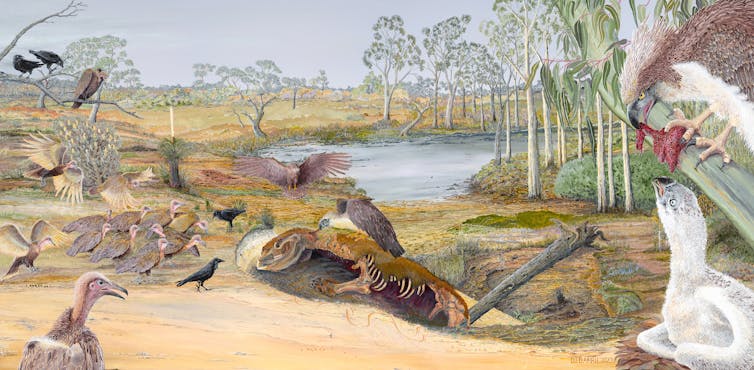
Today, Australia is home to 17 species of hawks and eagles. But the fossil record shows some other, rather special raptors were present in the relatively recent past.
Tens of thousands of years ago, Australia was home to species such as Dynatoaetus gaffae, the largest eagle ever to have lived in Australia, and Cryptogyps lacertosus, our only known vulture.
Now, we have discovered another ancient eagle shared the skies with these prehistoric predators. In a new paper in the journal Alcheringa, we describe the formidable Dynatoaetus pachyosteus, based on fossils found in the Naracoorte Caves in South Australia.
A New Eagle Unearthed
Dynatoaetus pachyosteus (the name means “powerful eagle with thick bones”) lived during the Pleistocene (a time period spanning from 2.5 million to 11,700 years ago). It had a wingspan similar to that of a wedge-tailed eagle, but with much more robust and powerful wings and legs. It was slightly smaller than its cousin, the massive Dynatoaetus gaffae.
This formidable predator would most likely have preyed on medium to large marsupials and birds. It may even have attacked juveniles and weakened individuals of huge megafaunal species like the giant flightless bird Genyornis.
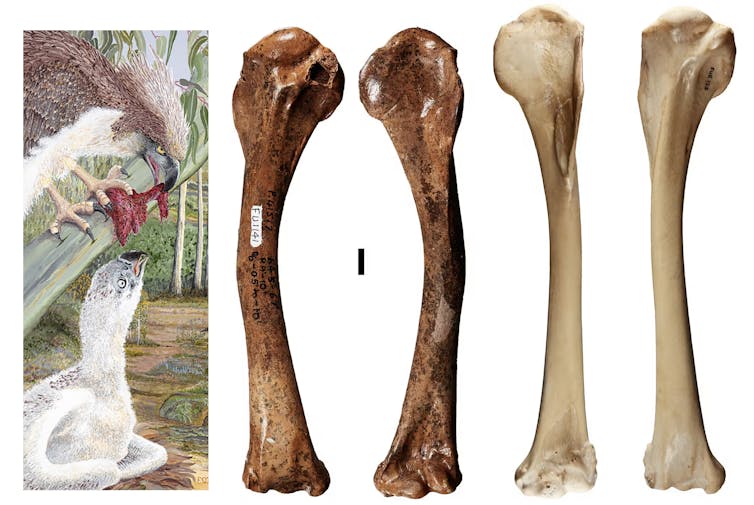
Dynatoaetus pachyosteus shared the Pleistocene landscape with at least two other large eagles, the huge Dynatoaetus gaffae and the wedge-tailed eagle we know today. For these species to coexist, they would have likely needed to have slightly different ecological roles to avoid outright competition.
“Niche separation” typically occurs by exploiting different kinds of food or habitats. These three eagles most likely coexisted by specialising in hunting different prey and nesting in different places.
The occurrence of both species of the Dynatoaetus genus in Australia (and nowhere else) has implications for the evolution of eagles. Dynatoaetus gaffae and D. pachyosteus presumably evolved from a common ancestor in Australia that diverged into two species, a process that typically takes a very long time.
This suggests the ancestor of this genus was already ensconced on our continent millions of years before the two Pleistocene species arose. Dynatoaetus pachyosteus and D. gaffae together form a rare example of a raptor genus diversifying into multiple species entirely on the Australian continent (what scientists call “endemic evolutionary radiation”).
There are only two raptor genera today restricted to Australia, and both consist of only a single species: Hamirostra (the black-breasted buzzard) and Lophoictinia (the square-tailed kite).
Primitive Vultures Of Ancient Australia
Our research has also revealed intriguing new information about another extinct raptor, the vulture Cryptogyps lacertosus.
Fossils from the Green Waterhole (also known as Fossil Cave), in the Tantanoola district near Mt Gambier, give us a more complete picture of this species. We found several paired wing bones, two shoulder bones, a vertebra and a toe bone, all probably from a single individual.
The additional bones of Cryptogyps indicate it was a rather primitive vulture, less adapted for the long periods of soaring flight characteristic of modern vultures.
Thanks to the sediment around the fossils, we also have a very precise date of when Cryptogyps was alive. Many of the Green Waterhole fossils were buried in a deposit of calcite rafts – crystals that form on the surface of still bodies of water in caves.
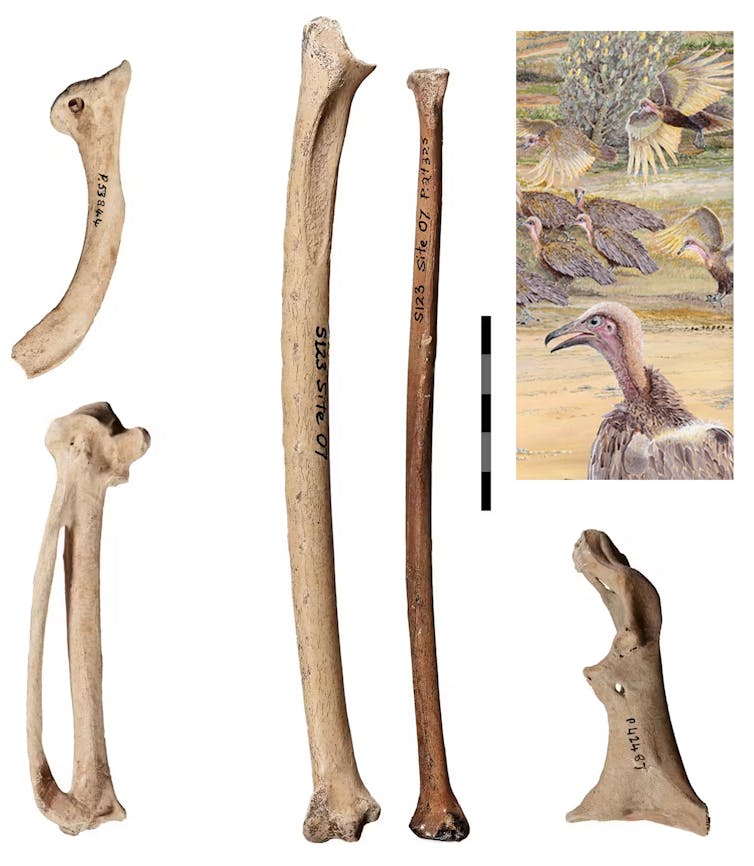
Today, most of the cave is submerged because of a high water table, but in the past, it was mostly dry. A pool of water deeper in the cave was where these calcite rafts formed.
The water was likely what attracted animals into the cave in the first place. These animals then died, and their bones sank to the bottom of the pool along with the calcite rafts. Our team dated these calcite rafts – and thus the entombed Cryptogyps fossils – at approximately 60,000 years old.
Mammal Extinctions Affect Birds Of Prey
When we think of the mass extinction of Australian megafauna, we tend to think about the demise of large mammals, such as the “giant wombat” Diprotodon optatum, the “marsupial lion” Thylacoleo carnifex, and the giant short-faced kangaroo Procoptodon goliah. Some large reptiles are also commonly recognised as victims: the giant goanna (Megalania) Varanus priscus, the constricting snake Wonambi naracoortensis, and even a giant armoured skink Tiliqua frangens.
But as we can see from the case of our large eagles and vultures, other groups of animals were also affected. Birds of prey, especially large and scavenging species, went extinct around the world during the Late Pleistocene, their food supply likely affected by the loss of large mammalian species. Australia appears to have been no exception to the rule.
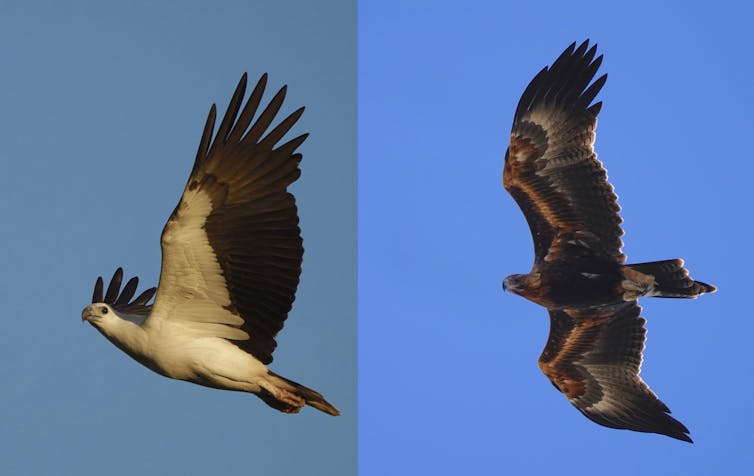
The new fossils reveal many of Australia’s large birds of prey did not survive the megafaunal extinction event in the Late Pleistocene, roughly 50,000 years ago. The two largest species that managed to persist to the present are the wedge-tailed eagle, which is a generalist hunter found throughout the continent, and the white-bellied sea eagle, which targets fish and has a coastal distribution.
It is likely our three extinct large raptors – two giant eagles and a vulture – were too specialised as hunters and scavengers of megafauna to adapt to a rapidly changing world. Their extinction likely caused a further cascade of effects through the ecosytem: in Asia, for instance, more recent loss of vultures has led to increased populations of scavenging feral dogs and higher prevalance of diseases such as rabies.![]()
Ellen K. Mather, Adjunct Associate Lecturer in Palaeontology, Flinders University; Mike Lee, Professor in Evolutionary Biology (jointly appointed with South Australian Museum), Flinders University, and Trevor H. Worthy, Associate Professor, Vertebrate Palaeontology Group, Flinders University
This article is republished from The Conversation under a Creative Commons license. Read the original article.
At OzAsia 2023, Australia’s appreciation of multiculturalism and diversity is most evident in food

This year’s OzAsia festival took place from October 19 to November 5, at its annual festival venues on the Kaurna land of Adelaide.
In its early years, the Asia-focused festival, which started in 2007, often highlighted work from a different Asian country each year.
Under the leadership of previous artistic director Joseph Mitchell, it became an event showcasing the best contemporary art from across Asia.
Now in her third and final year after the cancellation of the 2020 festival and smaller-scale festivals in the past two years, artistic director Annette Shun Wah has overseen the festival in full swing with invited artists from 13 countries.
As I attended this year’s festival, I had a chance to reflect on how Australia’s appreciation of multiculturalism and diversity is most evident in food.
Asians As Others In Australian History
Despite its physical location in the Asia Pacific, Asians are minorities in Australia. One in eight of us were born in Asia, and one in six identify as Asian.
The first notable migration from Asia occurred in the mid-19th century during the gold rush, when Chinese miners came to Australia. By 1861, 3.3% of the Australian population was born in China – the highest percentage until the 1980s.
Working as a team, Chinese workers were more productive than Anglo and European miners, which led to conflict and anti-Chinese sentiments.
There was little social foundation for Australians to enjoy or appreciate artistic performances from Asia in and around the 1870s when performing arts companies from Japan came to Australia with acrobatic and juggling performances.
This was part of an international trend around the appreciation of Japanese culture known as Japonisme. How the Japanese performances were perceived and appreciated in Australia remains a mystery, as there was little review about these shows.
However, considering the monocultural nature of the colonial mindset, they probably did not contribute to Australia’s multiculturalism or diversity. Instead, they were likely seen as foreign performers delivering ethnic-based aesthetics.
Food As A Vehicle To Experience Other Cultures
Although observing performances is an obvious way to experience and learn about other cultures, food has acted as the medium through which a larger number of Australians learn about others.
Food has been an entry point to Asia for many Australians. Many words drawn from Asian cuisine – such as masala, tom yum and wasabi – are no longer foreign in Australian English.
Given this history, it makes sense that a hawker-style food market – introduced alongside the 2015 festival – came to be the Lucky Dumpling Market in 2017.

The night market style stalls along the River Torrens now attract a wide range of people to enjoy Asian food, before or after for a night out, or just coming to eat.
At the OzAsia festival’s A Night with Poh Ling Yeow and Sarah Tiong, I listened to Ling Yeow emphasise the diversity of food in Australia. She spoke of how Australians’ love for travel was a major factor leading to Australia’s multicultural food landscape.
Similarly, Tiong observed how Asian chefs are respected in the Australian food industry as they can bring diversity into the kitchen.
The Lucky Dumpling Market was packed during the weekend with food lovers, who enjoyed a variety of dumplings beyond the Chinese styles that have become orthodox in Australia, notably Japanese gyoza and Nepali momo.
In this year’s festival, I also observed two solo performances related to food, Jacob Rajan’s Paradise or the Impermanence of Ice Cream, and Yumi Umiumare’s Buried TeaBowl — OKUNI.
Ice Cream And Tea In Solo Performances
Rajan’s Paradise or the Impermanence of Ice Cream is a poetic and metaphysical reflection on the border between life and death. Rajan features as all seven characters, including an ice cream parlour server and chai seller.
The New Zealand actor’s capacity to show us diverse characters is exceptional and inventive. Jumping from Indian to Antipodean accents and back, he is a talented actor able to connect to Asia and Australasia.
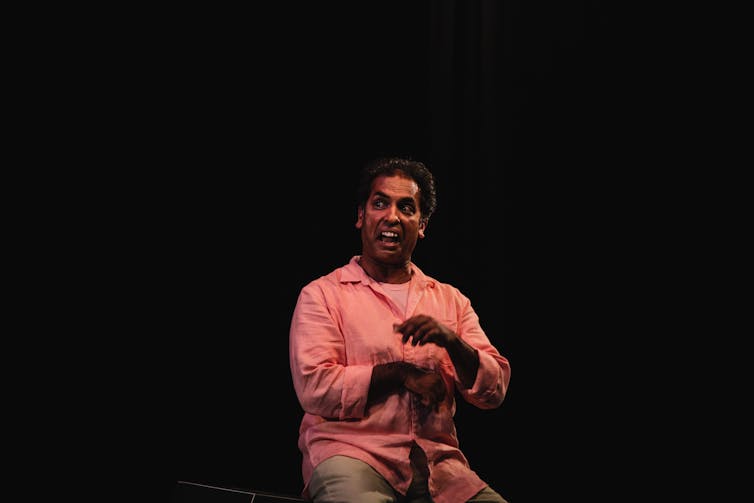
With illustrations of life, migration and death, the world he conjures is recognisable to many Asian-Australians. Humour – including joking about Harvey Norman, possibly inserted for the Australian audience – is warmly received by the South Australian audience.
Set in India, Rajan shows us human sentiments are not limited by cultural boundaries.
In Buried TeaBowl — OKUNI, Yumi Umiumare, a Melbourne-based artist born and trained in Japan, combines a traditional tea making ceremony and contemporary dance, around a framework referencing the origins of Japan’s noh theatre.
The show highlights Umiumare’s complex relationship with her heritage and culture. She shows the audience how peace can be found through a cup of tea, and how this precious moment can be destroyed by drinking premixed tea from a plastic bottle.

Unlike Rajan, who performs in English, Umiumare uses her native language without subtitles from time to time. The majority of the show is performed in English, but the unsubtitled Japanese reflects a complex journey of herself as a performer and a migrant.
Without understanding every single word, the audience can still appreciate her overall performance, a mixture of traditional sentiments and contemporary dynamic expressions.
Understanding artistic performances requires more skills and knowledge than appreciating tasty food. Down by the river, many locals are enjoying Asian food – but do as many enjoy Asian art? There is a task ahead of us to extend appreciation of Asian culture beyond food and beyond the festival period. ![]()
Tets Kimura, Adjunct Lecturer, Creative Arts, Flinders University
This article is republished from The Conversation under a Creative Commons license. Read the original article.
Timeless allure: why Australia is filled to the brim with exhibitions on ancient Egypt
Anna M. Kotarba-Morley, University of AdelaideClosing last month, this year WA Museum Boola Bardip in Perth was host to a major exhibition Discovering Ancient Egypt.
The Australian Museum’s “once-in-a-lifetime” Ramses & The Gold of the Pharaohs exhibition featuring 181 objects from ancient Egypt opened last week in Sydney.
Just four weeks after that exhibition shuts, the 2024 “winter masterpieces” exhibition at the National Gallery of Victoria in Melbourne will be Pharaoh, featuring 500 objects in the largest international loan ever from the British Museum.
Why is there such an intense fascination with a civilisation so far removed from our time and place?
Centuries Of Egyptomania
Few historical cultures seem to have such a hold over the minds of the general public.
Awe-inspiring temples, elaborate mummification rituals, beliefs in afterlife, and contributions to science, technology, engineering and medicine left an indelible mark on the course of human progress.

“Egyptomania”, a term coined to describe the West’s fascination with Egypt, can be traced back to Napoleon’s expedition in the late 18th century. Scientific discoveries and illustrations from that expedition fuelled worldwide curiosity about the secrets of this ancient land.
A key figure of the Egyptomania was Giovanni Battista Belzoni (1778–1823), an Italian explorer and strongman (and con-man) whose daring adventures and discoveries – including removal of colossal Egyptian statues – added fuel to the fire.
This cultural phenomenon influenced fashion and design. Egyptian motifs, such as lotus flowers, scarabs and sphinxes became popular decorative elements in clothing, jewellery and home decor during the 19th and early 20th centuries.

Agatha Christie (who was married to archaeologist Max Mallowan and spent many years working on excavations in the Middle East) sent her famous detective Hercule Poirot into the world of mummies and pharaohs in Death on the Nile and set Death Comes as the End on the Western Bank of Thebes.
Ancient Egypt’s grip on our collective consciousness manifests throughout popular culture. Films such as The Mummy and Cleopatra, games such as Assassin’s Creed Origins and popular cartoon TV series Tutenstein blend historical facts with creative storytelling, perpetuating the mystique and wonder of this lost civilisation.
Ancient Egypt is a staple in schools. For many Australians, their first introduction to a world beyond their immediate surroundings often comes in the form of ancient Egyptian history in the national curriculum for year 7.
This portal to history and foreign cultures opened in childhood often results in lifelong fascination. You might ask: how much Egypt can Australians take? It seems the answer is “a lot”.
A Long Line Of Exhibitions
These latest exhibitions follow a long, near continuous, list of Egyptian exhibitions in Australia.
In 2007, the National Gallery of Australia showcased Egyptian Antiquities from the Louvre: Journey to the Afterlife.
Tutankhamen And The Golden Age Of The Pharaohs was at the Melbourne Museum in 2011. The Western Australian Museum hosted Secrets of the Afterlife: Magic, Mummies and Immortality in Ancient Egypt in 2013. Egyptian Mummies: Exploring Ancient Lives was at Sydney’s Powerhouse in 2016.
In 2012, the Queensland Museum hosted items from the British Museum in Mummy: Secrets of the Tomb. The same museum hosted British Museum artefacts again in 2018 in Egyptian Mummies: Exploring Ancient Lives. In between, the Queensland University Museum hosted Egypt: Land of the Pharaohs from 2016–18.
From an impressive gallery in Chau Chak Wing Museum in Sydney to the small – and in need of a serious update – gallery in the South Australian Museum, each state also proudly displays its own permanent collection of ancient Egyptian artefacts.
Despite this extensive exhibition history, Australia’s interest in ancient Egypt seems to show no signs of waning.
Shifting Egyptology
The new exhibition in Sydney gives a window into the life and accomplishments of Ramses II who ruled Egypt for 67 years.
The National Gallery of Victoria’s exhibition will aim to deepen visitors’ understanding of ancient Egyptian culture, allowing them to see beyond the opulence.
This is part of a broader shift in Egyptology, archaeology and history towards emphasising understanding of the lives of everyday people.

For a long time, Egyptology was centred on grand monuments, temples, tombs, pharaohs and the elite. We now recognise that to understand a civilisation we need to also explore the lives, activities and contributions of ordinary people.
But these major exhibitions coincide with rising debates about the provenance and repatriation of artefacts. A Tutankhamen exhibition which toured the world just before the COVID pandemic and which was scheduled to appear in Sydney has, amid some controversy, finally settled back at home, in the Grand Museum in Cairo, Egypt, where it will – hopefully – remain forever.
Repatriation of artefacts is a sensitive issue that has been gaining momentum in recent years and questions are being raised, even more loudly now, whether institutions such as the British Museum should even possess such artefacts.
Zahi Hawass, former minister of antiquities for Egypt, has called for repatriation of stolen heritage and accused western museums of continuing imperialistic practice by purchasing new artefacts and refusing to return them to their country of origin. Some large travelling exhibitions are already moving away from displaying these artefacts towards immersive digital experiences with great examples in Lisbon, Vienna and Cairo.
For now in Australia, though, it is not just artefacts and treasures that will be on display. It is a celebration of human spirit, ingenuity and quest for knowledge. The sands of time have failed to bury our fascination in ancient Egypt.![]()
Anna M. Kotarba-Morley, Lecturer in Museum and Curatorial Studies, University of Adelaide
This article is republished from The Conversation under a Creative Commons license. Read the original article.
Really need those new shoes? Why you might spend up big at the Black Friday sales
Paul Harrison, Deakin UniversityIf you’re one of those people who line up for the Black Friday sales, jump online for Singles Day, or are thinking you’ll queue outside the local department store on Boxing Day for the “real bargains”, rest assured, you are not alone.
Just like the thousands of people who line the harbour in Sydney to get a glimpse of the New Year’s Eve fireworks, one of those 30-somethings who are desperate for tickets for Taylor Swift’s Eras tour, or the crazy Melburnians who sleep outside for days to get AFL grand final tickets, we’re all victims of some basic psychological factors.
These responses have evolved over millennia, even if the stimuli are very much contemporary.
Scarcity And The Need To Belong
When you succumb to the appeal “It’s finally here” or “get in before you miss out” or even “Hurry, these offers expire at midnight”, don’t be too hard on yourself. It’s an evolutionary thing and it’s actually quite useful.
As human beings, we assume if lots of people want something, then we should want it too. We also believe if something is rare, or scarce, it must be desirable. This is because everybody else seems to want it and they want it now.
Humans are social animals. Although we’d like to think we’re all independent thinkers, it is impossible to think about everything we do in isolation and on its merits. So, we look to others to help us decide.
If everyone in our “in-group” is buying the latest fashion, then we assume the group knows best, so we should do the same. Yes, we are all sheep. Well-dressed sheep, but sheep nonetheless.
But you shouldn’t be worried about that. We all do it, depending on the so-called attitude object, that is, the item we form feelings about.
For example, adults criticising the “crazy” kids lining up to buy new sneakers or phones might be the same people who travel the world, spending thousands of dollars to see an opera.
Funnily enough, we reconcile this process by assuring ourselves we are not followers, but have gone through an independent, rational process to justify our actions. We also tame our ego by believing we are more sensible, rational and considered than the rest of the people in our group. It makes it easier to justify our sometimes irrational decisions.
When it comes sales, there is also another retail-specific factor at play.
Ego Depletion
When we walk into a shopping centre with lights, music, noise, hard surfaces, people and general overstimulation, we experience some form of ego depletion. It also plays out online, when we are confronted with huge amounts of information and pop-ups that say things like “four other people are looking at this product right now”
Ego depletion doesn’t mean you instantly become a humble, thoughtful person. In psychology, we use this term to describe how people don’t always think through their decisions rationally when they are stressed. Although there’s some criticism of how researchers describe ego depletion, in general, too much stimulation leads to less rational decision making.
So, all that noise, colour and movement isn’t just the shopping centre getting into the sales season, it’s also a technique to get you to respond to emotional cues, such as social norms, the fear of missing out and the ritual of the sale.
Our Inability To Forecast And Anticipated Regret
Psychological research tells us humans aren’t very good at predicting the future. Or perhaps we just have an overinflated sense of our accuracy in predicting the future — we rely on how we feel right now to predict how we might feel about something later. Psychologists call this “affective forecasting”.
So, when we are “in” the moment of the sale, we buy things we feel we need. But we discount all the other things that we’ve bought.
We’re also victims of a psychological phenomenon called “anticipated regret”. This occurs when we think about the future and see ourselves regretting having not taken the opportunity when it presented itself. When we think about the future, we not only anticipate events, we also experience the associated emotions of those events.
We also anticipate social effects. When other people might get what we are contemplating getting now, we may fall into anticipated envy, where we imagine them having the item and us wishing we had it.
Sales release a whole range of psychological responses and, for the most part (and in the short term), they work. When it comes to sales, we rarely plan, and so we are more susceptible to the gentle nudges of the marketers when we are stressed, in a hurry, and trying to do ten things at once.
The Importance Of Ritual
All of these responses have parallels with a whole bunch of other rituals that we participate in.
Christmas, Halloween, and Valentine’s Day are all examples of rituals humans are drawn to help them to participate in the social world. While there is material consumption with these events, there is also a sense of community.
As human beings, we look for rituals, we look for community through the things we do, and as other community rituals and institutions such as churches or strong familial and neighbourhood linkages break down, we look for ways to replace that.
The same basic principle is playing out with the Black Friday sales. What the sales are doing is playing upon our need to participate in rituals, but with a different objective. Sales are purely transactional and their goal is to sell us something, rather than giving us the opportunity to participate in perhaps the more rewarding rituals of Christmas or even Halloween.
So What Can We Do?
There are ways to avoid giving into these psychological tendencies:
1. Slow down
The best advice I can give is to slow down the process. Giving yourself time to think (as opposed to respond) may help you to make a better decision. The marketers want you to move through the decision-making process as quickly as possible so that you are responding to your feelings, not your thoughts.
2. Talk it through
Before you buy, talk your purchase over with a friend (preferably one who doesn’t enable you too much). This is connected with the first piece of advice, it leads you to think a bit more.
3. Make a list
I know it’s boring, but if your motivation for attending the sale is to save money, making a list of what you want and giving yourself a budget is the best way to approach sales. And be prepared to walk away if it isn’t right.
4. Calm down
Try listening to music that calms you or simply take some deep breaths — a calm state is more likely to result in a more rational decision.
5. Remember a sales person is not your friend
Remind yourself the sales person is not your friend. They may be lovely, but their main role is to get you to buy. Reciprocity theory tells u one of the best technniques of sales is to blur the line between social interactions and business interactions. A salesperson being nice to you (or offering you a discount) doesn’t mean that you have to buy their product (but do be nice back to them).
6. Walk away
A trick for the online world, is to put the item in your basket, then (virtually) walk away. Many online algorithms will send you an even better discount later on (although if it is connected with Black Friday sales this isn’t guaranteed).![]()
Paul Harrison, Director, Master of Business Administration (MBA); Co-Director, Better Consumption Lab, Deakin University, Deakin University
This article is republished from The Conversation under a Creative Commons license. Read the original article.
Thinking of trying a detox? Here’s what you need to know first
Clare Collins, University of NewcastleWhat is a “detox”? It’s a process that involves using particular products, diets or other detoxification methods to try and rid the body of so-called “toxins”.
Detoxes are prevalent on social media and spruiked by brands offering detox products, celebrities and influencers.
A documentary airing on Channel 10 this week – Todd Sampson’s Mirror Mirror: Are You Well? – explores our fascination with detoxing, and the science (or lack thereof) behind it.
So if you’re thinking of trying a detox, here’s what you need to know.
Detoxing Is Not New
Detoxing has held an attraction since the time of Hippocrates, who believed four bodily fluids or “humors” – blood, phlegm, black bile and yellow bile – had to remain in balance to maintain good health. Being unwell meant the body’s organs and fluids were somehow imbalanced and in need of correction.
Throughout the centuries these “imbalances” have been treated with everything from enemas and emetics to leech therapy and bloodletting. An enema sees a tube inserted into the anus to deliver medication or fluids to the rectum or colon. An emetic is a compound designed to make you vomit. Bloodletting involved using certain techniques – not for the faint of heart – to remove blood from a patient and supposedly cure disease.
Meanwhile, throughout history, the ritual of fasting as a display of self-discipline, purity and holiness was common, particularly among women.
What Are The Different Types Of Detox?
Fast forward to today, and detoxes look a bit different. Detox products sold over the counter or online are typically teas or drinks to be consumed instead of food.
These approaches sometimes start with a fasting phase or use intermittent fasting throughout the program.
The “detox” tag is appearing on a growing range of teas, coffee, infused waters, drinks with added fruit, vegetables, herbal mixes, nutrients or added blends of “natural” ingredients. These products often claim to flush toxins from the body, or to boost immunity.
Global predictions indicate the detox drink market, estimated at more than US$5 billion in 2022, will grow in value by another 50% before 2030.
A survey of detoxification therapies used by naturopaths in the United States reported that more than three-quarters recommended dietary measures, including “cleansing foods” (such as beetroot), vitamin, mineral or antioxidant supplements, organic foods, elimination diets and probiotics.
While drinks and dietary measures represent typical approaches to a detox, there are also some more unusual detox practices.
One-third of patients in that same US study had undergone colonic irrigation, which involves infusing fluids into the colon to remove digestive waste.
More than one-quarter had used homeopathic remedies or laxative herbs.
While we don’t have equivalent data for Australia, a survey of more than 2,000 Australian adults found 63% had either used or consulted someone about complementary therapies in the previous year. A portion of these were likely detox therapies.
Do Detoxes Work?
The short answer is no. A review published in 2022 found detox diets failed to identify plausible pathways by which toxins could be eliminated, or the specific toxins supposedly removed by a particular diet.
This review also pointed out that detoxes defy the general principles of human physiology, in that the liver and kidneys are quite efficient at removing toxins from our bodies.
A previous review from 2015 similarly found studies did not provide convincing evidence to support the use of detox diets.
Detox products don’t have to prove they’re effective to be on the market. In Australia, complementary medicines sold over the counter are regulated by the Therapeutic Goods Administration, with ingredients assessed for quality and safety, but not whether the products actually work.
You should check any product and marketing claims before purchasing to see what the manufacturers say. Big promises to be sceptical about include eliminating toxins, rapid weight loss, stronger willpower, improved self-esteem, an energy or immunity boost, feeling happier, inner peace, or better skin, hair and nails.
Potential Dangers Of Detoxing
Consuming detox products in place of a regular diet leads to a very low total kilojoule intake, and therefore may lead to weight loss in the short term. But they’re not a sustainable way to lose weight.
Detox diets that severely restrict kilojoules or food groups increase the risk of nutrient deficiencies. Adverse effects include fatigue, irritability and bad breath.
There’s also a risk detox product ingredient labels might not be accurate, increasing the risk of side effects, potential overdoses or other adverse events. In Spain, a 50-year-old man died after an incorrect ingredient was added to a liver cleanse detox product he used, leading to manganese poisoning.
A 2018-19 audit of premises in New South Wales performing colonic irrigation found failures to meet infection control standards.
Some people should definitely not try detoxing. This includes people with chronic medical conditions, eating disorders, older adults, children and women who are pregnant or breastfeeding.
One positive aspect of detox programs is that they may help raise awareness of your current food, alcohol or lifestyle habits that could be improved. Reflecting on these can potentially provide the motivation to try and eat more healthily.![]()
Clare Collins, Laureate Professor in Nutrition and Dietetics, University of Newcastle
This article is republished from The Conversation under a Creative Commons license. Read the original article.
Australia’s secrecy laws include 875 offences. Reforms are welcome, but don’t go far enough for press freedom
Peter Greste, Macquarie UniversityIn 2019, the New York Times declared that “Australia may well be the world’s most secretive democracy”.
The Times published the piece shortly after the Australian Federal Police raided journalists from two news organisations, searching for evidence of sources for stories that were embarrassing to the government.
Four years on, Attorney-General Mark Dreyfus today released a comprehensive review of secrecy laws that acknowledges a woefully complicated mess.
The government’s plan to clean it up is a good first step, but it’s just the tip of a very big iceberg.
Progress On Much-Needed Change
To make its case in 2019, The Times pointed to a bewildering array of legal and political obstacles embedded in Australian law that stand in the way of the transparency considered essential to a fully functioning democracy.
In principle, the government seems to agree.
The review points to 875 secrecy offences covering everything from national security to tax laws, and a dysfunctioning system for protecting whistleblowers.
It also recognises the chilling effect on the ability of journalists to work with sources from inside government, and hold it to account.
To fix the problem, the report comes up with 11 recommendations, including reducing the number of offences to a more manageable (but still excessive) 707.
It establishes a set of guiding principles that will help consolidate the law and make it more consistent.
And it says there should be a narrower range of information defined as “secret”, with clear harm to the public interest in any breach of secrecy before a prosecution can take place.
It also calls for specific defences for public-interest journalism to be inserted into key secrecy laws.
All this is laudable, and it starts to untie the Gordian Knot of legislation that created the culture of secrecy the Times was concerned about, but it is simply not enough.
A Patchwork Quilt Of Laws
The enormous number of secrecy offences currently on the books points to the central problem. Whenever lawmakers have spotted a hole in the law, they’ve stuck a patch over it.
That is understandable, particularly in a post-September 11 world when national security has become the overriding concern of governments everywhere.
But it has created a confusing, inconsistent and incoherent mess that the attorney-general appears to be trying to fix with yet more patches.
To be fair, some of them are larger and more coherent than the current ones, but it is still insufficient to deal with the fundamental problem. The Australian government remains dangerously secretive.
Another of the recommendations is a general secrecy offence that says Commonwealth officers can’t can’t disclose anything that would be “prejudicial to the effective working of government”.
A general secrecy offence helps simplify things, but the threshold is worryingly sweeping and runs counter to a recommendation the Australian Law Reform Commission made back in a 2010 report that triggered the review in the first place.
Dangerous Plan For Journalism
The report also makes much of the need to protect public-interest journalism.
Again, it is laudable that the attorney-general recognises the threats to media freedom embedded in the law, and said he’s prepared to tackle them.
But the answers in the report are more of the same: a set of band aids, rather than a comprehensive cure.
Controversially, that includes a commitment to maintain a ministerial directive from the former Attorney-General Christian Porter.
Porter issued his directive in the wake of the 2019 raids, in an attempt to underline the government’s commitment to press freedom. The directive declared that the director of public prosecutions had to seek the attorney-general’s approval before prosecuting a journalist.
One of the fundamental principles of our democracy is a clear separation between the political and legal systems.
Yet the directive clearly crosses that line.
As we saw with the allegations of sexual assault levelled at Porter, and subsequent legal action against the ABC, the attorney-general is as vulnerable to journalistic investigation as anyone else. Giving him the last word about whether or not to prosecute a journalist is a dangerous, if well-intentioned, step.
Time For A Whole New Approach
The report also declines to reverse the burden of proof when it comes to publishing government secrets in the public interest.
A number of media organisations (including the Alliance for Journalists’ Freedom that I work for) have argued there should be a presumption in favour of publishing, unless the investigators can show a clear harm to the public interest.
In other words, they should have to prove the harm in publishing rather than forcing journalists to show the value in their story. The report released today rejected that idea.
At least when it comes to media freedom, the Alliance for Journalists’ Freedom has a far simpler and more comprehensive solution.
Rather than patches, we are proposing a Media Freedom Act that would establish a set of overarching principles in law.
First, it would compel parliament to always consider media freedom when passing new legislation.
And second, the courts would be obliged to interpret existing laws, like secrecy and espionage laws, in ways that are consistent with media freedom.
That would include a presumption in favour of protecting a journalist’s sources and in publishing. The police would have to show why the public interest in an investigation is more important than the public interest in the story itself.
That law alone wouldn’t be enough to solve all the problems - there would need to be a lot of amendments to make it work effectively - but it elegantly creates a set of principles and frameworks that protect the underlying objective: to create the kind of transparency necessary for a healthy democracy, without putting national security at risk.![]()
Peter Greste, Professor of Journalism and Communications, Macquarie University
This article is republished from The Conversation under a Creative Commons license. Read the original article.
Did Napoleon really fire at the pyramids? A historian explains the truth behind the legends of Ridley Scott’s biopic
Joan Tumblety, University of SouthamptonDirectors of historical feature films face a difficult task. How can they make the characters familiar to an audience without reducing them to caricature? How can they make sure that knowledge of the outcome – battles won or lost, empires built then ruined – doesn’t make the story seem like it’s writing itself?
Director Ridley Scott is not a historian and presumably wants to entertain rather than to enlighten. But the problem of historical truth is an interesting one.
It is not easy to know the “real” Napoleon. There’s a recognisable version of him – the confident general beloved of his troops, the instinctive military tactician who could run on empty for days at a time, his stern and somewhat petulant gaze. But much of this is the product of layers of historical storytelling, accrued by the labour of generations of artists, journalists and memoirists – and of course, Napoleon himself.
Abel Gance’s spectacular silent film Napoleon (1927), for example, charted the life and career of Napoleon up to his departure as a military general for the Italian campaign in 1796. In one scene, a heavy winter snowfall interrupts classes at Napoleon’s military college. The boys run outside to play and inevitably start throwing snowballs at each other. The scene depicts a very young Napoleon emerging as a natural commander, directing the combat as though on the field of battle.
Yet the veracity of this moment rests primarily on a single account – the memoir of one of Napoleon’s childhood friends, Louis de Bourrienne, who attended the same school. The author was later an employee of Napoleon, who sacked him for embezzlement in 1802.
Many years later, in 1829, de Bourrienne penned a memoir in the hope of cashing in on the popular appetite for authentic tales of the great general. What we think we know about the “real” Napoleon is often filtered through self-interested and partial accounts like this one.
Here are the facts and legends behind some of the major scenes from Ridley Scott’s new Napoleon biopic.
Did Napoleon Crown Himself?
Napoleon went to great lengths to craft his image as a benign ruler and man of the people, often enlisting the talents of artists to do so.
Most notoriously, Jacques-Louis David was commissioned to produce a series of grand paintings depicting Napoleon’s coronation in Notre Dame Cathedral, Paris in December 1804. In the most famous, we see Napoleon place a crown on the head of the new Empress Josephine while a reluctant Pope Pius VII looks on.
In an astonishing act of hubris, Napoleon had indeed already placed a crown on his own head, though the oil painting shows him only in laurel leaves to signify his martial triumphs. What Scott’s film depicts is the magnificence of the oil paintings, which showed Napoleon and his empress in the most flattering light, rather than the coronation ceremony itself.
His Relationship With Josephine
There is no doubt that Napoleon felt a deep passion for Marie Joséphe Rose de la Pagerie – known to him as Joséphine – whom he married in 1796 as his military career was in the ascendant. Yet her depiction in Ridley Scott’s film as a young seductress probably speaks more to sexist cliche than to Joséphine’s undoubted self-assuredness.
She was six years older than Napoleon, a widow and mother of two young children when they met, and the young general’s romantic feelings were seemingly stronger than hers. While on campaign he wrote to her virtually every day, his pen sometimes piercing the parchment, such was the force of his emotions. Yet some of these letters to her remained unopened.
Their relationship was as tumultuous as it was passionate, and both spouses had several affairs. Yet when Napoleon instigated divorce in 1809 for want of an heir, it was surprisingly amicable. The Empress retained her imperial title until her death in 1814 and was permitted to continue living in the imperial Château de Malmaison.
Was Napoleon Present At The Execution Of Marie Antoinette?
The autumn of 1793 was especially busy for Napoleon given his increasingly important role in the Siege of Toulon. Federalist rebels had handed over the French fleet to the British admiral Samuel Hood, and the young artillery officer commanded the operation that eventually seized it back.
Therefore it is highly unlikely that he ventured to Paris in October to be among the crowd that witnessed the execution of Queen Marie-Antoinette.
In a letter to his older brother Joseph, however, Napoleon did claim to witness the storming of the Tuileries Palace by an angry crowd of republican protesters in June 1792. It revolted him.
Did Napoleon Really Fire At The Pyramids?
Napoleon began his Egyptian campaign in 1798. The cultural legacy of the campaign can be seen in the well-stocked Egyptology section of the Louvre. But it was also the scene of atrocities.
At one point, several thousand Ottoman soldiers were shot or driven into the sea on Napoleon’s orders, rather than taken prisoner. You don’t need to invent ice traps or Napoleon ordering his men to fire at the pyramids, as Ridley Scott’s biopic does, to convey his callous disregard for life.
It was the rumour that he had ordered his own plague-stricken troops to be poisoned in the town of Jaffa that finally tarnished Napoleon’s reputation in the early 19th century. It stuck, no matter how brilliant the sanitising riposte of the artist Antoine-Jean Gros, whom Napoleon commissioned in 1804 to paint a different story.
Ridley Scott’s film does not represent the past so much as carry versions of the tales and images depicting Napoleon that have spun him into existence since his own lifetime – many of which were crafted by his own hand.

Looking for something good? Cut through the noise with a carefully curated selection of the latest releases, live events and exhibitions, straight to your inbox every fortnight, on Fridays. Sign up here.![]()
Joan Tumblety, Associate Professor of French History, University of Southampton
This article is republished from The Conversation under a Creative Commons license. Read the original article.
Stoicism on Tiktok promises happiness – but the ancient philosophers who came up with it had something very different in mind

I don’t know about you, but my TikTok is full of influencers telling me I should be a Stoic. You might know the term “stoic” as a person who goes through hardship while maintaining a steely and calm disposition, and never complains. However, a stoic is also someone who prescribes to the philosophical school of Stoicism.
Stoicism became popular in ancient Rome. Stoic TikTok exclusively draws on Roman Stoicism, mainly Epictetus (a formerly enslaved person), Seneca (a fabulously wealthy and self-aggrandizing advisor to the emperor Nero), and Marcus Aurelius (who was himself a Roman emperor).
But the school goes back much further to ancient Athens, where Stoicism was founded around 300BCE by Zeno of Citium. After Zeno, Stoicism flourished in Athens, especially under Chrysippus, known as the second founder of Stoicism.
On TikTok, you’ll see people saying that Stoicism is a great way to lead a happy and productive life. I’m a professional philosopher who specialises in ancient Greek philosophy – and it’s great, if somewhat surprising, to see how popular Stoicism has become over the last ten years. But as a philosopher, I’m not a Stoic – and Stoic TikTok gets quite a lot wrong about this way of thinking.

This article is part of Quarter Life, a series about issues affecting those of us in our twenties and thirties. From the challenges of beginning a career and taking care of our mental health, to the excitement of starting a family, adopting a pet or just making friends as an adult. The articles in this series explore the questions and bring answers as we navigate this turbulent period of life.
You may be interested in:
How often do you think about the Roman empire? TikTok trend exposed the way we gender history
Bed rotting: the social media trend the Victorians would love, especially writer Elizabeth Gaskell
Lucky girl syndrome: the potential dark side of TikTok’s extreme positive thinking trend
Despite what you see on TikTok, Stoicism was a dry, technical, ivory tower philosophy. Its ideas around happiness and productivity diverge quite a bit from what modern people consider these to be. Traditionally, it was divided into three branches: ethics, physics, and logic – much of which TikTok’s Stoic preachers don’t get quite right.
Logic
Distinctively, the Stoics emphasised logic, comparing it to the shell of an egg or the bones and sinews of a body, because logic protects (like a shell), supports (like bones) and connects (like sinews) our beliefs and knowledge. In fact, the Stoics developed a systematic logical theory which, through various historical twists and turns, inspired 20th-century logic and hence theoretical computer science.
The Stoics took logic seriously because it was needed for knowledge. For the Stoics, to know something – including how to live well – was to understand it so totally that you could defend your view against any degree of argumentative scrutiny, against any opponent. In other words, they used logic to win a sort of philosophical Hunger Games.
But Stoic TikTok isn’t really interested in a deep, rich and logically defensible knowledge of the world and our place in it. In so far as Stoic TikTok is interested in knowledge, it implies that you can get knowledge by simply reading quotations of famous Stoics or practising certain mental exercises, such as meditating on death.
Physics
Stoic TikTok also ignores Stoic physics – the principles that Stoics used to explain the natural processes in the universe. For the Stoics, everything that exists, including your soul and God, is a body. God, in fact, is “mixed with matter, pervading all of it and so shaping it, structuring it and making it into the world”, as the critic Alexander of Aphrodisias told us in the early third century.
The Stoics argued that, since God is rational and active, this makes everything that exists in the world rational and organised for the best. You are part of this rational universe so, if bad things happen to you, it would be irrational to complain – as if your foot complained about getting muddy.
This idea of a rational universe is popular with Stoic TikTok, and can be seen in posts telling followers to “love their fate”. They suggest that true happiness comes from accepting anything that happens.
But does loving your fate in a truly Stoic sense achieve the sort of productivity and happiness most people want? I think not.
Ethics
Which brings us to Stoic ethics. While Stoic TikTok promises productivity and happiness, it’s unlikely you’ll achieve the levels of productivity and happiness you actually desire if you go by what Stoics believed these to be.
Happiness, for a Stoic, was a matter of having virtues and lacking vices. Everything else – including health, wealth and status – were “indifferents”, because they made no difference to your virtue, and so to your happiness.
So, even if the self-helpy advice of Stoic TikTok could make you more productive, being more productive won’t make you be happier, according to Stoic philosophy. At best, you’ll acquire health, wealth or status, but those things are indifferent to your happiness.
There is, of course, something hypocritical about Seneca arguing that wealth is indifferent while being one of the richest men in Rome; or Marcus Aurelius saying that power is indifferent while being emperor.
It is rational to prefer to be healthy rather than ill, rich rather than poor, powerful rather than oppressed. In fact, there was nuanced ancient debate in which the Stoics tried to find a middle way between a view where health, money and power are simply good, and a view where they are totally irrelevant to living a good life.
Chrysippus tried to steer this course by saying that while health, wealth and power are indifferent, how you use them is not. If I use power intemperately or wealth to indulge my most disgusting appetites, I will not be virtuous or happy. Personally, I don’t think the Stoic philosophy will ultimately solve this problem of whether health, wealth and power are totally indifferent to happiness, but it is an open question.
I’ve not touched here on the more sinister aspects of Stoicism on the internet, discussed in Donna Zuckerberg’s Not All Dead White Men. Rather, I’ve tried to point out what Stoic TikTok misses, because I hope people dive deeper into Stoic philosophy. A great place to start is Tad Brennan’s The Stoic Life.
Stoicism is a rich, fascinating and sophisticated philosophical tradition. But, if you’re looking for happiness and productivity in more modern terms, the Stoics might not have the answer.

Looking for something good? Cut through the noise with a carefully curated selection of the latest releases, live events and exhibitions, straight to your inbox every fortnight, on Fridays. Sign up here.![]()
Matthew Duncombe, , University of Nottingham
This article is republished from The Conversation under a Creative Commons license. Read the original article.
Earthrise: historian uncovers the true origins of the ‘image of the century’
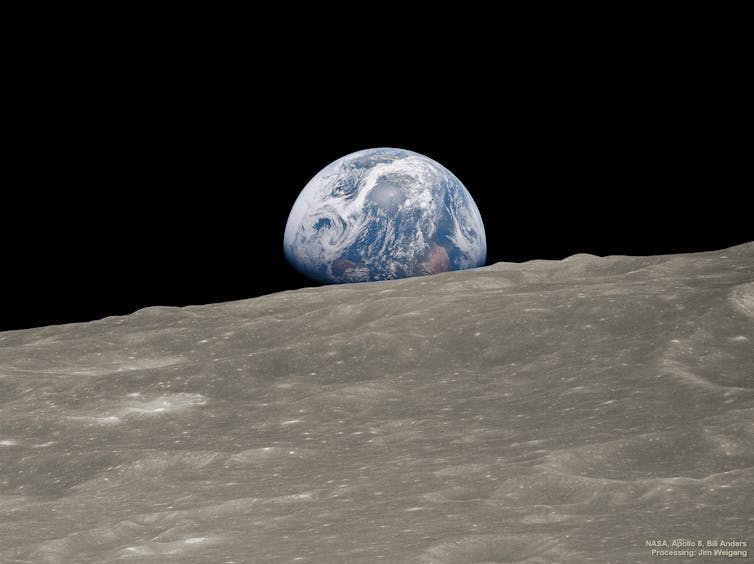
The recent death of Frank Borman, commander of Nasa’s Apollo 8 mission in 1968, has focused attention on that incredible first voyage to the Moon.
It took place eight months before Apollo 11, where Neil Armstrong and Buzz Aldrin explored the lunar surface for the first time. However, the impact of Apollo 8’s “Earthrise” picture – the sight of the Earth from the Moon – now seems even greater than that of the first landing.
For many years, the story behind the famous Earthrise photo, was that the crew were caught off-guard by the blue orb rising from behind the Moon. But even if they were preoccupied, the astronauts knew it was coming.
Another unforgettable event during the mission was a reading by the crew from the Book of Genesis, broadcast to the world at Christmas. Detailed research I’ve conducted in Nasa’s archives has revealed more clearly how much planning lay behind these dramatic moments. The famous Earthrise picture, a wonky snap taken in a hurry, was improvised, but it had been anticipated.
Earthrise Restored
After entering lunar orbit, they nearly missed seeing the Earth. Only on the fourth orbit, when the capsule flipped round 180 degrees to point forwards, did they notice it. Borman confirmed to me that at that moment they were “taken by surprise – too busy with lunar observation on the first three orbits”.
But the Apollo programme’s director of photography, Dick Underwood, was anxious to set the wider record straight. He explained: “Hours were spent with the lunar crews, including the Apollo 8 crew, in briefing on exactly how to set up the camera, which film to use … these briefings were most comprehensive.”

There were, however, battles within Nasa about what images the astronauts should focus on, with the management insisting on shots of lunar geology and potential landing sites. Dick Underwood explained: “I argued hard for a shot of Earthrise, and we had impressed upon the astronauts that we definitely wanted it.”
Borman was joined on the mission by two other astronauts: Jim Lovell, who was the command module pilot, and Bill Anders, who had the title of lunar module pilot. Nasa had intended for Apollo 8 to test the lunar module, but it was behind schedule so the mission didn’t take one.
At the pre-launch press conference, Borman had looked forward to getting “good views of the Earth from the Moon” and Lovell to seeing “the Earth set and the Earth rise”.
The official mission plan directed the astronauts to take photos of Earth, but only as the lowest priority. When the key moment came, the astronauts were indeed taken by surprise, but not for long.
Anders was at a side window taking photos of craters using a camera with black and white film when he saw the Earth rise from behind the Moon. “Look at that picture over there! Here’s the Earth coming up,” Anders exclaimed.
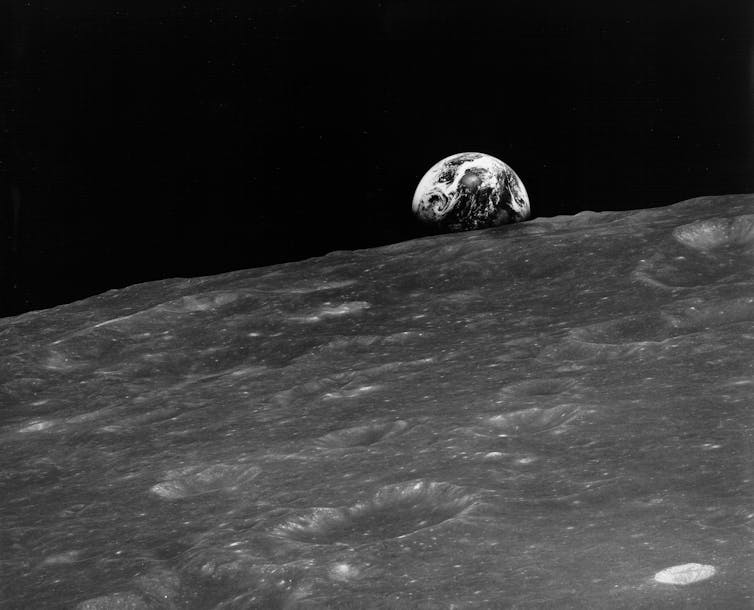
Anders quickly took a sharp shot of the Earth emerging above the lunar horizon. Then he and Lovell argued briefly over who should have the colour film camera, while Borman tried to calm them down.
It was Anders who took the blurry, hastily framed, overexposed colour shot of Earthrise, later dubbed the image of the century. But in the other camera was a much better shot, long ignored because it was in black and white.
That first mono image was spot-on. A restored “Earthrise” photo, recently coloured by experts using the later shots as a reference, conveys the stunning sight beheld by the astronauts.
This shot, revealing the Earth as a majestic but fragile oasis. As Lovell mused: “The loneliness out here is awe-inspiring … it makes us realise what you have back on Earth.” For Borman too it was “intensely emotional … We said nothing to each other, but maybe we shared another thought I had: ‘This must be what God sees.’”
The Genesis Reading
In 1968, as now, space travel was viewed as a scientific and technological domain. But the mission was also sent by one of the world’s most strongly Christianised countries, and the crew was not about to leave its cultural background behind.
It was a point of pride at Nasa that, whereas Soviet cosmonauts were tightly monitored and controlled, their own astronauts were free to speak their minds. Extraordinary as it now seems, they were left to decide for themselves what to say in their historic live broadcast from lunar orbit.
Borman knew that he had to come up with something special for the Christmas broadcast. A few weeks beforehand, he was told by a press officer: “We figure more people will be listening to your voice (during the broadcast) than that of any man in history. So we want you to say something appropriate.”
While Neil Armstrong’s “one small step” message was carefully considered inside Nasa, no one in the agency knew in advance what Borman would say.
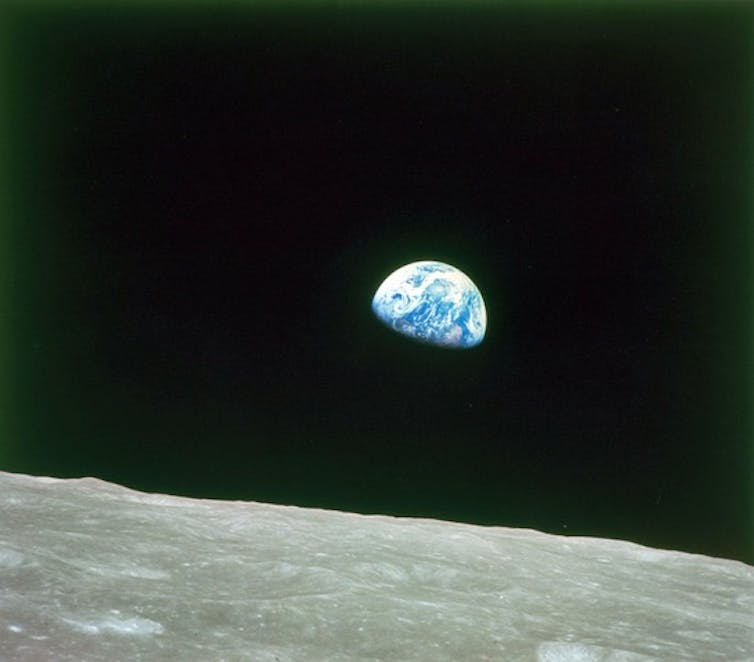
With only two minutes left before radio contact was lost as the spacecraft passed behind the Moon, Anders said: “The crew of Apollo 8 have a message that we would like to send to you.”
He then read from the Book of Genesis: “In the beginning, God created the heaven and the Earth; and the Earth was without form and void.” He continued: “God said, ‘Let there be light,’ and there was light.”
Lovell and Borman took over to read the next verses, and Borman signed off: “Merry Christmas, and God bless all of you – all of you on the good Earth.”
As Apollo 8 dipped out of radio contact, the world was left to absorb the impact. “For those moments I felt the presence of creation and the creator,” Nasa’s chief flight director Gene Kranz later recalled. “Tears were on my cheeks.”
Somehow Borman and his colleagues found the perfect words to convey their experience. But Borman had thought about the assignment carefully, asking a publicist friend to help out with the text.
This was Simon Bourgin, science policy officer at the US Information Agency. Bourgin in turn asked a journalist, Joe Laitin, who mentioned the task to his wife, Christine.
She looked in the Old Testament and suggested: “Why don’t you begin at the beginning?” She recognised the primeval power of the creation story in the first book of Genesis, with its evocative description of the Earth.
Borman immediately recognised that this was just right, and had it typed up. He had superbly vindicated Nasa’s trust in him.
While inspiration and a degree of freedom were involved in the Earthrise photo and Genesis reading, behind their execution lay careful planning and professionalism.![]()
Robert Poole, Professor of History, University of Central Lancashire
This article is republished from The Conversation under a Creative Commons license. Read the original article.
Happy 80th Tony Bonner AM

.jpg?timestamp=1700846676119)
Free 2024 Calendar + Diary For Seniors
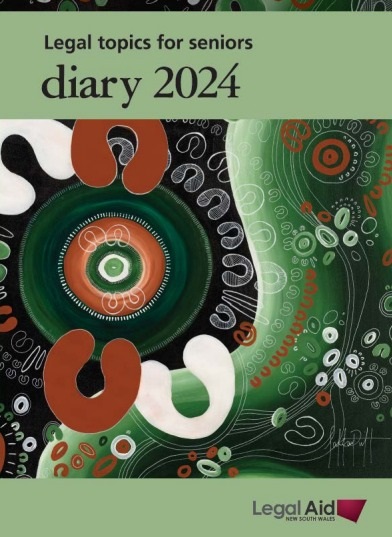
ATAGI Recommendations On Use Of The Moderna And Pfizer Monovalent Omicron XBB.1.5 COVID-19 Vaccines
- Pfizer monovalent Omicron XBB.1.5 vaccine 5 - <12 years formulation (light blue cap)
- Pfizer monovalent Omicron XBB.1.5 vaccine ≥12 years formulation (dark grey cap)
- Moderna monovalent Omicron XBB.1.5 vaccine, registered for use in people aged 12 years and older.
- All currently available COVID-19 vaccines are anticipated to provide benefit to eligible people, however the monovalent Omicron XBB.1.5 vaccines are preferred over other vaccines for use in children aged 5 years or older and adults who are currently recommended primary or additional doses of COVID-19 vaccine according to the Australian Immunisation Handbook
- For those who have had the recommended 2023 dose/s of COVID-19 vaccine, ATAGI is not recommending further doses or re-vaccination with an XBB.1.5-containing vaccine at this time
- ATAGI notes the recent increase in COVID-19 cases across Australia since November 2023. ATAGI encourages all people who have not yet had their recommended 2023 dose/s to receive them as soon as possible (see Appendix).
- The Moderna monovalent XBB.1.5 ≥ 12 years pre-filled syringe contains 50mcg of the SARS-CoV-2 XBB.1.5 Omicron subvariant spike protein mRNA.
- The Pfizer monovalent XBB.1.5 ≥12 years formulation (dark grey cap) contains 30mcg of the SARS-CoV-2 XBB.1.5 Omicron subvariant spike protein mRNA.
- The Pfizer monovalent XBB.1.5 5-<12 years formulation (light blue cap) contains 10mcg of the SARS-CoV-2 XBB.1.5 Omicron subvariant spike protein mRNA.

Aged Care Watchdog Seeks To Restore Trust
- Department of Health and Aged Care
- Aged Care Quality and Safety Commission
- Independent Health and Aged Care Pricing Authority
- other services or bodies in the aged care system regulated or funded by the government.
- robust, accountable and transparent
- able to meet the needs of older people in Australia, their families, and their carers.
- review and report on the aged care system
- identify systemic and significant problems
- recommend changes
- increase accountability and transparency through reporting our findings to parliament, including on the implementation of Royal Commission recommendations.
Survey About The 15% Aged Care Pay Rise Now Open
- Has it helped to attract and retain more workers to aged care?
- Does it make you want to stay working in the sector?
- Do you feel more valued and rewarded for the work you do?

What are the new COVID booster vaccines? Can I get one? Do they work? Are they safe?

As the COVID virus continues to evolve, so does our vaccine response. From December 11, Australians will have access to new vaccines that offer better protection.
These “monovalent” booster vaccines are expected to be a better match for currently circulating strains of SARS-CoV-2, the virus that causes COVID.
Pfizer’s monovalent vaccine will be available to eligible people aged five years and older. The Moderna monovalent vaccine can be used for those aged 12 years and older.
Who is eligible for these new boosters? How do they differ from earlier ones? Do they work? Are they safe?
Who’s Eligible For The New Boosters?
The federal government has accepted the Australian Technical Advisory Group (ATAGI) recommendation to use the new vaccines, after Australia’s regulator approved their use last month. However, vaccine eligibility has remained the same since September.
ATAGI recommends Australians aged over 75 get vaccinated if it has been six months or more since their last dose.
People aged 65 to 74 are recommended to have a 2023 booster if they haven’t already had one.

Adults aged 18 to 64 with underlying risk factors that increase their risk of severe COVID are also recommended to have a 2023 booster if they haven’t had one yet. And if they’ve already had a 2023 booster, they can consider an additional dose.

For adults aged 18 to 64 without underlying risk factors who have already received a 2023 booster, an additional dose isn’t recommended. But if you’re aged 18 to 64 and haven’t had a booster in 2023, you can consider an additional dose.
Additional doses aren’t recommended for children without underlying conditions that increase their risk of severe COVID. A primary course is not recommended for children aged six months to five years without additional risk factors.
Monovalent, Bivalent? What’s The Difference?
From monovalent
The initial COVID vaccines were “monovalent”. They had one target – the original viral strain.
But as the virus mutated, we assigned new letters of the Greek alphabet to each variant. This brings us to Omicron. With this significant change, we saw “immune evasion”. The virus had changed so much the original vaccines didn’t provide sufficient immunity.
To bivalent
So vaccines were updated to target an early Omicron subvariant, BA.1, plus the original ancestral strain. With two targets, these were the first of the “bivalent” vaccines, which were approved in Australia in 2022.
Omicron continued to evolve, leading to more “immune escape”, contributing to repeated waves of transmission.
The vaccines were updated again in early 2023. These newer bivalent vaccines target two strains – the ancestral strain plus the subvariants BA.4 and BA.5.
Back to monovalent
Further changes in the virus have meant our boosters needed to be updated again. This takes us to the recent announcement.
This time the booster targets another subvariant of Omicron known as XBB.1.5 (sometimes known as Kraken).
This vaccine is monovalent once more, meaning it has only one target. The target against the original viral strain has been removed.
According to advice given to the World Health Organization in May, this is largely because immunity to this original strain is no longer required (it’s no longer infecting humans). Raising immunity to the original strain may also hamper the immune response to the newer component, but we’re not sure if this is occurring or how important this is.
The United States approved XBB.1.5-specific vaccines from Pfizer and Moderna in mid-September. These updated vaccines have also been approved in places including Europe, Canada, Japan and Singapore.
In Australia, the Therapeutic Goods Administration (TGA) approved them in October.
Do These Newer Vaccines Work?
Evidence for the efficacy of these new monovalent vaccines comes from the results of research Pfizer and Moderna submitted to the TGA.
Evidence also comes from a preprint (preliminary research available online that has yet to be independently reviewed) and an update Pfizer presented to the US Centers for Disease Control.
Taken together, the available evidence shows the updated vaccines produce good levels of antibodies in laboratory studies, in humans and mice when compared to previous vaccines and when looking at multiple emerging variants, including EG.5 (sometimes known as Eris). This variant is the one causing high numbers of cases around the world currently, including in Australia. It is very similar to the XBB version contained in the updated booster.
The updated vaccines should also cover BA.2.86 or Pirola, according to early results from clinical trials and the US Centers for Disease Control. This variant is responsible for a rapidly increasing proportion of cases, with case numbers growing in Australia.
It’s clear the virus is going to continue to evolve. So performance of these vaccines against new variants will continue to be closely monitored.
Are They Safe?
The safety of the updated vaccines has also been shown to be similar to previous versions. Studies comparing them found no significant difference in terms of the adverse events reported.
Given the availability of the updated vaccines, some countries have removed their approval for earlier versions. This is because newer versions are a closer match to currently circulating strains, rather than any safety issue with the older vaccines.
What Happens Next?
The availability of updated vaccines is a welcome development, however this is not the end of the story. We need to make sure eligible people get vaccinated.
We also need to acknowledge that vaccination should form part of a comprehensive strategy to limit the impact of COVID from now on. That includes measures such as mask wearing, social distancing, focusing on ventilation and air quality, and to a lesser degree hand hygiene. Rapidly accessing antivirals if eligible is also still important, as is keeping away from others if you are infected.![]()
Paul Griffin, Professor, Infectious Diseases and Microbiology, The University of Queensland
This article is republished from The Conversation under a Creative Commons license. Read the original article.
Halfway through their term, the ‘teal’ MPs look here to stay – and may present a huge challenge in 2025
Mark Kenny, Australian National UniversityHalfway through the 47th federal parliament, we can begin cautiously to gauge the potential historical significance of the “teal” independents.
Contemporaneous analysis, of course, can be problematic but it can also direct attention to emergent dynamics in the way politics operates in Australia. This includes how well voters are represented, politico-cultural shifts and the influence on how laws are made.
The next election will tell us if the 2022 infusion of these independents marked an electoral realignment of longer-term substance or merely a short-term reaction to circumstances. In other words, was it a movement or a moment?
There are three key issues that will help answer this question.
First, many or all of the new crossbench MPs could be defeated, casting their 2022 victories as an aberration driven largely by the unpopularity of the Morrison government rather than by something deep and structural.
Alternatively, they may all be returned, consolidating their respective support locally.
A third outcome builds on the second and would see their ranks swell in 2025, confirming a trend of voter disillusionment with the major parties.
In the second option, Australia would have been politically transformed. In the third, that transformation could be regarded as highly significant, heralding an era of minority governments becoming the most common election result.
The pre-conditions of such a change are already there. The crossbench in the House of Representatives now stands at 16 – a record since the two-party era settled in after the first dozen years of the federation.
Given how finely balanced the political contest appears halfway into this term, a hung parliament looms as more than a mere possibility. Outside of a huge government scandal, a parliamentary majority for the Coalition seems unattainable – that is, without unseating the teals and making other gains. More on that in a moment.
Labor is in a stronger position as the incumbent government, but is hardly ascendant. It confronts a serious cost-of-living crisis that has the potential to cause serious voter unhappiness. While the most recent Newspoll reported a two-party-preferred result of 52-48 in favour of the Albanese government, there is some suggestion the government’s post-election popularity may have topped out and could decline from here.
With a record-low 32.6% primary vote delivering a slender two-seat majority, (a third was gained at the Aston byelection) Labor has little ground to give. The “majors” appear to be managing their prospects in a climate of declining brand loyalty.
For the independents, the opposite may be true. This stark reality is what made the federal election in May 2022 feel like a watershed.
In 2022, teals picked up six seats (Curtin, Goldstein, Kooyong, Mackellar, North Sydney, and Wentworth), adding to two formerly safe Liberal seats (Indi and Warringah)that community independents gained in 2019 and successfully defended in 2022.
It is now plausible to conceive of the “teals” as a loose grouping of eight centrist independents occupying once-safe Liberal seats. Important to that conception also is that all are female and that, on any issue, not all eight automatically align.
Election 2022 was also a watershed because the Australian Greens quadrupled their lower house holdings with three upset wins in Queensland, a state where no “teals” were running.
The future of these Greens seats is an important factor to add into considerations. As independents, the teals cannot ensure legislative change or drive through private members’ bills to a final vote. However, they have proved influential in raising issues, improving legislation and, in some cases, in stiffening government resolve.
This was the case with the government’s emissions reduction legislation. The Greens’ public pressure succeeded in convincing Labor to make its 2030 emissions reduction target of 43% a floor rather than a ceiling. This was a significant change given Labor’s timidity around the electoral politics of emissions.
The government’s National Anti-Corruption Commission – which eventually passed with Coalition support – was also a product in part of the moral leadership from Indi independent Helen Haines. Her private member’s bill ultimately provided the basis of the government’s formula.
Perhaps the biggest macro-political change wrought by the teals has been in the conduct of politics and parliamentary behaviour. This can be difficult to measure, but most observers I’ve spoken to concede the overall tone of parliament has improved in this term, due in no small part to the presence and the articulate advocacy of female MPs, primarily the teals.
Government ministers treat their questions in the House with more respect and civility than was the standard response to crossbenchers under previous governments, most pointedly during the former Morrison period.
Another strength of the teal MPs is their combination of active local representation and clear leadership. This was evident in the referendum. Australia may have rejected the proposed Voice to Parliament by 60% to 40%, but in the 2022 teal seats, where the majority of constituents had been life-long Liberal voters until recently, the Voice registered majority support.
For these voters, it appears it was the campaigning of the new MP that was persuasive, rather than the Liberal-National Coalition’s bellicose opposition to the proposal.
Among the enlarged group of eight, it was only in the “pre-teal” seat of Indi, held by Haines, that the proposal was rejected. This result is probably explained by the electorate’s status as “rural” according to the Australian Electoral Commission.
Beyond the voter rejection of populist and divisive politics in these inner-urban electorates, the immediate significance of the “yes” vote points to another hurdle for the Liberal Party if it is to reclaim them.
Take the example of Goldstein in Victoria, where independent MP Zoe Daniel ran a vigorous local campaign involving 600 volunteers, 285 Voice-related local events and the specific strategic targeting of some 10,000 homes for doorknocking.
Organised, engaged, locally driven but professional campaigning such as this is beyond even the major parties these days. Along with socio-economic factors, this may be a key reason the teals did better for the Voice than many pro-Voice Labor MPs, whose constituents went decidedly the other way.
More worrying for the Liberals is that the teals have had the benefit now of running a mid-term electorate-wide local campaign in which they could hone their organisational capabilities, connect meaningfully with their constituents outside of an election context, and energise their supporters.
With a well-resourced ground game like that, based on the kind of responsive local representation the established parties more often talk about than actively deliver, the teals may prove supremely hard to dislodge.![]()
Mark Kenny, Professor, Australian Studies Institute, Australian National University
This article is republished from The Conversation under a Creative Commons license. Read the original article.
Congratulations! Seniors Stories Volume 9 2023

Grim State Of Ambulance Ramping Revealed: AMA
_%202023.jpg?timestamp=1700603008105)
Review Of Energy Accounts Payment Assistance (EAPA) Reform; Have Your Say

National Apology And Recognition For Thalidomide Survivors And Their Families
Vincent Namatjira’s paintbrush is his weapon. With an infectious energy and wry humour, nothing is off limits
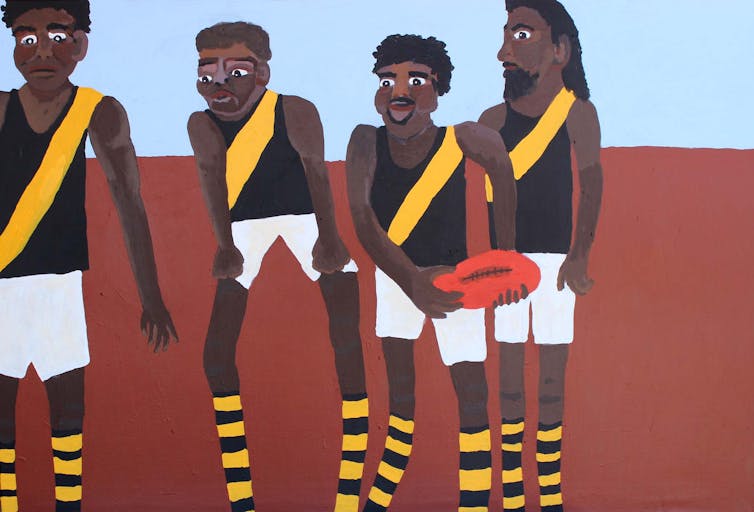
Vincent Namatjira, a Western Arrernte artist, is Albert Namatjira’s great-grandson. His genre is portraiture, but with a twist: loaded with satire and post-colonial politics.
He was the first Aboriginal artist to win the Archibald prize in 2020 with a portrait of fellow Indigenous man, footballer Adam Goodes.
His double-sided portrait on plywood, Close contact, won the Ramsay Prize in 2019. In this freestanding portrait Namatjira employs his strategy of inverting history: the artist commands the viewpoint, facing outward; Captain Cook on the rear side trails behind. Close Contact is the entry portrait for this fabulous survey exhibition, Vincent Namatjira: Australia in Colour on show at the Art Gallery of South Australia.
The paintings on display echo Namatjira’s mantra that his paintbrush is his weapon and that art has the power to change the world.

His multi-panel set of portraits, Australia in Colour, showing a mix of the rich and powerful such as Gina (Rinehart) and Scomo side-by-side with local heroes such as musician Angus (Young) and Ned Kelly along with Aboriginal heroes, Cathy (Freeman) and Vincent (Lingiari) sets the tone for the exhibition.
Nothing is off limits.
Artistic Lineage
Vincent Namatjira is very conscious of his lineage, and his role via portraiture in continuing what Albert Namatjira started in landscape in portraying Country.
This is underscored in his twin portrait, Albert and Vincent (2014), showing himself in the same pose William Dargie employed in his Archibald prize-winning portrait of his great-grandfather in 1956.
But for Vincent Namatjira, there is a timely assertiveness in addressing wrongful behaviour as in his telling portrait of Adam Goodes.
That assertiveness extends to correcting the historical record in his series of Unknown soldiers (2020) which portrays First Nations men who served in the first world war. Many chose not to declare their Aboriginal heritage so they could enlist. The paintings completed on army surplus camouflage fabric reinforce that their stories are still hidden, waiting to be woven into an inclusive national history.
Namatjira included himself in this series because he was trying
to understand the mindset of Indigenous men who volunteered for WW1 but were neglected and mistreated in their own country.
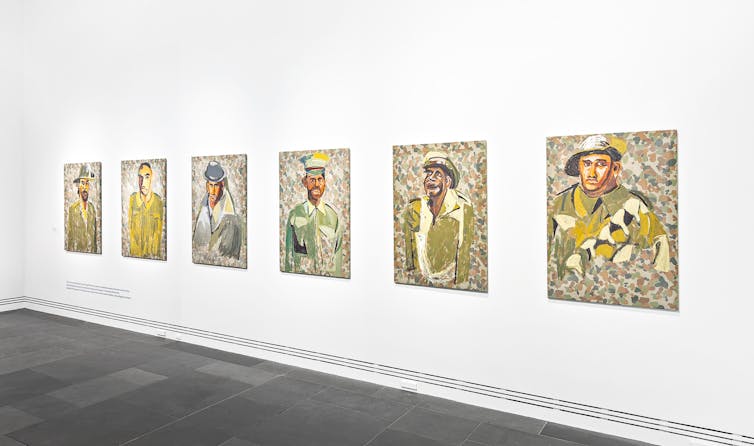
Visiting The Royals
Wry humour and astute reversals of identity go a long way towards rewriting history and the effects of colonialism.
British royalty feature in numerous paintings, often with Namatjira inserting himself into the composition. He is having afternoon tea in the Royal Tour (Charles, Vincent and Elizabeth) (2020); and standing atop the royal carriage in The Royal Tour (Vincent and Elizabeth on Country) (2022).
The simple gesture of placing an uncomfortable Queen in someone else’s Country with Namatjira towering over her from the rooftop of the royal carriage says it all.
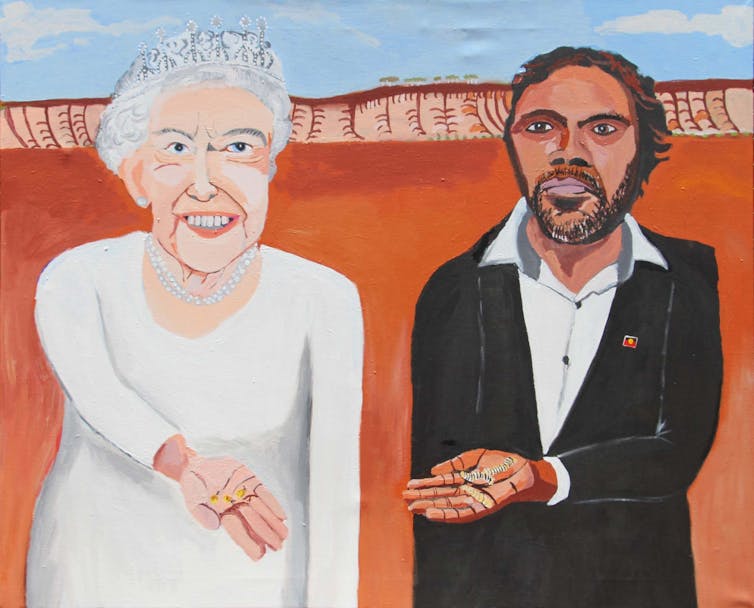
In another, Namatjira shows a dark-skinned and somewhat uncertain Charles on Country (2022), dressed in royal regalia and framed by an Albert Namatjira vista of the West Macdonnell ranges. The curatorial cues provided for viewers to read the imagery are in the artist’s own words. On royalty he says:
I’ve made a lot of paintings of the British royal family – that mob were born into wealth, power and privilege, so I feel it’s fair enough to make fun of their stuffy uniforms, and their outdated traditions … even their teeth.
Captain Cook too is a target – as a symbol of colonisation and empire, as he explains:
Over there is James Cook, his ship has washed up in the desert. He’s sunburnt, lost. British royals are out of place, wandering in the sandy creeks, among ghost gums.

Re-Recording History
An especially powerful set of portraits, Seven Leaders (2016), are of senior Aboriginal men from the Aṉangu Pitjantjatjara Yankunytjatjara (APY) Lands. They include Alec Baker, Kunmanara (Mumu Mike) Williams and Witjiti George.
Their white and greying hair and beards set against their dark skin, and their eyes full of experience and conviction, present an alternative set of powerful figures. Here, as in other paintings in this rich exhibition, the tables are turned – viewers come away questioning who has the power and why.
Sitting within the exhibition, Vincent Namatjira engages with the historical account of Rex Batterbee “teaching” Albert Namatjira the art of watercolour.

Vincent Namatjira’s rendition of this event, in which the transaction is one of cultural exchange, is a painting of equals.
That engagement with art history extends to constructions of national art. In place of bucolic pastoral scenes of settled land – minus its Indigenous inhabitants – by artists such as Arthur Streeton are new national pictures such as Albert Namatjira, Slim Dusty and Archie Roach on Country (2022).
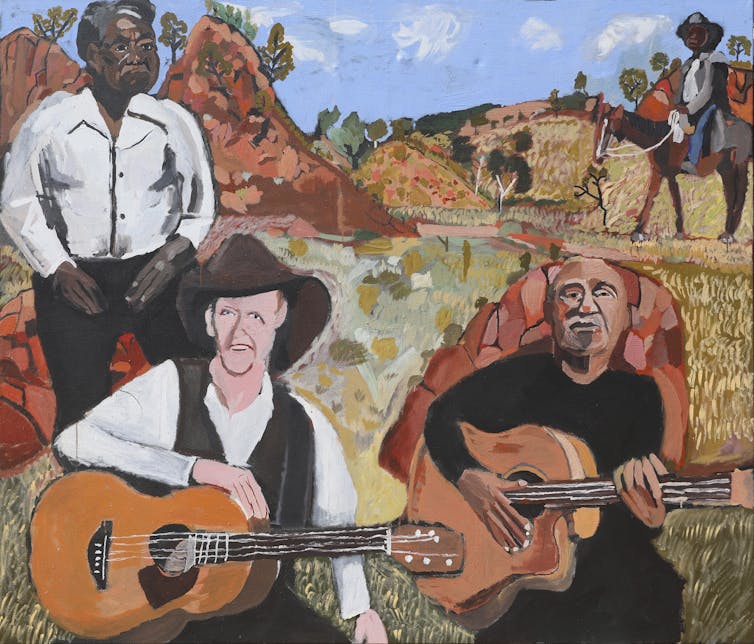
Collaborative pop-up books made with Tony Albert and irreverent portraits painted jointly with Ben Quilty, along with moving image work featuring Vincent Namatjira weaving through Country in Albert Namatjira’s trademark green truck, populate this lively, cheeky exhibition.
Its energy is infectious, its imagination extending to how things could be otherwise. Vincent Namatjira deserves the last word:
For me, the canvas is a setting where I can combine the past, present and possible futures, and I can put myself - as a proud Aboriginal man – at the front and centre of a situation where we would usually be out of sight.
Vincent Namatjira: Australia in Colour is on show at the Art Gallery of South Australia until January 21.![]()
Catherine Speck, Emerita Professor, Art History and Curatorship, University of Adelaide
This article is republished from The Conversation under a Creative Commons license. Read the original article.
The Walkley awards were begun by a prominent oil baron. How do we reconcile their history and future?

In May this year, Belinda Noble, former journalist and the founder of Comms Declare, an organisation representing media professionals who won’t promote the expansion of fossil fuels, wrote on Ampol’s sponsorship of the nation’s premier journalism prizes, the Walkley Awards.
Three months later, Walkley Award-winning cartoonist Jon Kudelka announced he would boycott the 2023 Walkleys because of this sponsorship. He was soon joined by scores of other cartoonists, who linked the issue to the omission of a dedicated award for climate-focused journalism.
The controversies for the 2023 awards didn’t end there. On September 2, journalist Osman Faruqi wrote about the racist views expressed by the founder of the awards, oil baron Sir William (Bill) Walkley. The Walkley Foundation issued an apology for these views that day.
This week, the winners of the 67th Walkleys will be announced, so it is timely to discuss how we reconcile our present attitudes and knowledge with historical realities – and how resistant is our media to being seduced by powerful interests.
A Murky History
The first Walkleys were awarded in 1956, but Bill Walkley’s seduction of the media began a few years beforehand. As managing director of Ampol, in 1953 he chartered a plane to take reporters to Rough Range in Western Australia to witness the spudding of Australia’s first oil well.
Staff writers published in The Age:
The prospects for Australia – if the strike proves part of a big field – are limitless. The discovery of oil could mean as much to 20th century Australians as the introduction of Merino sheep meant to our great-grandparents.
Historian and former journalist John Hurst wrote of the trip:
the food was first class, there was plenty of grog […] and Walkley was his usual affable self and always accessible.
Reporters described the land in the language of the settler as “a lonely expanse carpeted with spiky spinifex, salt-bush and stunted scrub”:
Kangaroos, emus, flocks of goats and a few wandering, scraggy sheep are the only audience of man’s activity.
The First Australians were invisible. Respect for their ownership of the land, even for their very existence, was entirely absent.
This kind of duchessing of the media by the oil industry lasted for years. From the 1950s to the 1980s, among the most sought-after junkets in Australian journalism were the Shell Tours, conducted in association with the Royal Agricultural Societies in NSW and Victoria to brief journalists on rural affairs.

Some reporting got done and some evocative photographs taken, but the companies that sponsored these trips and the journalists who went on them did so in a cultural climate where certain values were dominant and others were entirely absent.
In this climate, figures like Walkley were lionised as people whose views about the nation’s future should be heard. In 1961, Walkley and six other leaders of business, commerce and industry were invited by the Sydney Morning Herald to write on the theme “if I ran this country”.
Walkley argued Australia was underpopulated and underdeveloped. In accord with the conventional attitudes (and the White Australia Policy) prevailing in 1961, Walkley declared:
Today Australians are but a drop of white in a sea of colour that teems with more than 1,200 million land-hungry Asiatics.
This language, just as the invisibility of the Aboriginal people at Rough Ridge, is repugnant to us though unremarkable at the time.
Added to those considerations now is the impact on the climate of our use of fossil fuels – ignored at the time, despite prophetic scientific warnings.
Facing History And Future
So how do we reconcile our present attitudes and knowledge with these historical realities?
Concerning Walkley’s racist attitudes, we may begin with the moral absolute that racism is always wrong, and condemn him on that ground. But his culpability, although not absolved, is mitigated by the cultural climate in which he wrote.
Removing his name from the awards would leave existing recipients in possession of awards devalued by association, which would be ahistorical and grossly unfair. Frank disclosure, faithful recording of history, and the apology made by the Walkley Foundation are sufficient.
But climate change is a contemporary, not historical, problem to which Ampol contributes.
Typically under sponsorship arrangements, corporations are purchasing the goodwill of the media so if the need arises they will get the benefit of any doubt. This transactional element is harder to ignore.
The junket to Rough Ridge resulted in highly positive publicity for Ampol and Walkley. Certainly it reported an important development in Australia’s history – but the enthusiastic tone of celebration was generated by the goodwill resulting from the treatment the journalists received. Today there is a greater awareness among journalists of these dynamics but it is still hard to bite the hand that feeds.
There is a precedent for disconnecting journalism from fossil fuel revenue. Guardian Australia, whose journalists qualify for Walkley awards, has made a policy decision not to accept fossil fuel advertising.
Weakened by the impact of the internet on advertising revenue and of social media on information dissemination, the media and the profession of journalism on which they rely are not in a strong financial position to resist sponsorship. The ethical question for the Walkley Foundation is whether it is prepared to allow Ampol to get whatever benefit the company perceives comes its way from this sponsorship.
It comes down to principle, as Guardian Australia has demonstrated.
And if the Walkley Foundation were to introduce an award for climate-focused journalism, how would that sit with sponsorship from an oil company?![]()
Denis Muller, Senior Research Fellow, Centre for Advancing Journalism, The University of Melbourne and Jennifer Martin, Senior Lecturer, Communication at Deakin University Australia., Deakin University
This article is republished from The Conversation under a Creative Commons license. Read the original article.
JFK’s death 60 years on: what Australian condolence letters reveal about us
Jennifer Clark, University of AdelaideUS President John F. Kennedy was assassinated in Dallas 60 years ago, on November 22 1963. Within hours, the news ricocheted around the world.
Perhaps we could imagine a substantial impact in Europe, where Kennedy had only recently, and somewhat famously, declared “Ich bin ein Berliner”.
But Kennedy’s death was also deeply felt in Australia, prompting many people to write personal letters to Jacqueline Kennedy. They paint a revealing portrait of life down under in the 1960s.
Letters From ‘Far Flung Corners’
People from around the world felt compelled to write to the first lady.
Some 45,000 letters arrived on one day alone. White House staff were still processing more than one million letters years later.
Sometimes they came with cards and gifts, including pieces of especially composed music.
Hundreds of letters came all the way from Australia, from what a Rockhampton woman described as “a far flung corner”.
At a time when the national sentiment under Menzies’ leadership was more in favour of the United Kingdom than the United States, it’s somewhat surprising Kennedy’s death prompted such an outpouring of grief.
Kennedy never visited the “far flung corner”. There was some talk that he would come to Australia as part of a wider visit to the Pacific, but diplomatic sensibilities and logistics proved difficult to overcome.
In any case, one of the proposed dates clashed with a visit from the Queen Mother.
But some believed it was the assassination that ended the plans. A Sydney couple wrote to Jacqueline Kennedy:
I believe you were to honour us by a visit from you & the President this year […] but fate decided against it to our deepest disappointment […] and regret. We were all looking forward so eagerly to that great pleasure.
Interestingly, that same letter suggested that Robert Kennedy might have time in the future to bring Jacqueline and the children to Australia, revealing how restrictive gender roles were understood in 1963.
Political Figures As Personal Friends
Many of the letter writers admitted they mourned Kennedy as if he was a family member or a close friend.
A lot of this intimacy came from watching Kennedy on television.
One man from Mt Kuring-gai explained after he began his letter with “Dear Jacki”:
I ask your pardon for using your Christian name, but I feel that both you and John Kennedy are my personal friends.
Similar sentiments were expressed by a Brisbane woman:
Television is a wonderful thing […] although you have never met me, yet by seeing you several times on the television screen, I feel that I have met you.
During the Kennedy years, the quantity of TV time devoted to news in the US expanded considerably, meaning that mediated access to Kennedy also increased.
His youth, Hollywood good looks, and his glamorous wife became part of US and Australian cultural consumption.
The Australian Women’s Weekly also helped to popularise the Kennedy image. Readers were shown how to make their own Jackie pillbox hat and cultivate Jacqueline Kennedy’s intellectual style. The magazine instructed:
Start by reading the newspaper, go to art exhibitions, see a few historical film spectaculars, and learn to read a menu in French. Don’t chatter.
Seeing Themselves In The Kennedys
Widows and mothers especially identified with Jacqueline Kennedy. They wrote to her “as woman to woman”, relating their own grief experiences and offering to help mind the “kiddies”, if only she lived closer.
Catholics also wrote in large numbers. Kennedy was the great Catholic hero at a time of deep sectarianism in Australian society. They were proud of his political success.
It also helped that he had Irish roots, like much of the Catholic priesthood in Australia at the time.
During the Cold War, Kennedy offered a sense of security.
That proved important to Robert Menzies in his reelection campaign, given that Kennedy died only a week before polling day. Labor Party leader Arthur Calwell saw the writing on the wall.
When Menzies mentioned Kennedy while electioneering, Calwell complained that Menzies was trying to use the assassination for political purposes.
Calwell’s messaging didn’t cut through. Instead, voters wanted safety and familiarity in their leadership amid global upheaval.
One Strathfield woman who wrote to Jacqueline Kennedy explained that the idea of Menzies’ having “been in too long” disappeared with the assassination. She said:
[…] there was a great swing to Liberals & they won with the amazing majority of 22 seats.
A unique mixture of television, religion and personality meant Kennedy’s death had cultural repercussions in “the far flung corner”. We would not see a grief response like this again until the death of the Princess of Wales, 34 years later.
But so great was the impact in Cold War-era Australia that the death of an overseas president also had some bearing on the formation of government back home.![]()
Jennifer Clark, Professor of History, University of Adelaide
This article is republished from The Conversation under a Creative Commons license. Read the original article.
With COVID surging, should I wear a mask?
C Raina MacIntyre, UNSW SydneyCOVID is on the rise again, with a peak likely over the holiday season.
Given this, health authorities in a number of Australian states have recommended people start wearing masks again. In Western Australia, masks have been made mandatory in high-risk areas of public hospitals, while they’ve similarly been reintroduced in health-care settings in other parts of the country.
Hospitals and aged care facilities are definitely the first places where masks need to be reinstated during an epidemic. But authorities are differing in their recommendations currently. Calls to mask up, particularly in the wider community, have not been unanimous.
So amid rising COVID cases, should you be wearing a mask?
COVID Is Still A Threat
Unfortunately, SARS-CoV-2 (the virus that causes COVID) has not mutated into just a trivial cold.
As well as causing symptoms in the initial phase – which can be especially serious for people who are vulnerable – the virus can lead to chronic illness in people of any age and health status due to its ability to affect blood vessels, the heart, lungs, brain and immune system.
COVID and its ongoing effects are contributing to substantial disability in society. Loss of productivity due to long COVID is affecting workforce and economies.
While public messaging to “live with COVID” has seemingly encouraged us to move on from the pandemic, SARS-CoV-2 has other ideas. It has continued to mutate, become more contagious, and to evade the protection offered by vaccines.
COVID is not endemic, but is an epidemic virus like influenza or measles, so we can expect waves to keep coming. With this in mind, it’s definitely worth protecting yourself – particularly when cases are rising.
What Can We Do To Protect Ourselves?
We know SARS-CoV-2 transmits through the air we breathe. We also know a lot of the transmission risk is from people without symptoms, so you can’t tell who around you is infectious. This provides a strong rationale for universal masking during periods of high transmission.
The need is highest in hospitals where thousands of unsuspecting patients have caught COVID during the course of the pandemic and hundreds have died as a result in Victoria alone. Aged care facilities are similarly vulnerable.
Masks do work. A Cochrane review suggesting they don’t was flawed and subject to an apology.
Masks work equally by protecting others and protecting you. By visualising human exhalations too tiny to see with the naked eye, my colleagues and I showed how masks prevent outward emissions and how each layer of a mask improves this.
The most protective kind of mask is a respirator or N95, but any mask protects more than no mask.
Wearing a mask when visiting health-care or aged-care facilities is important. Wearing a mask at the shops, on public transport and in other crowded indoor settings will improve your chances of having a COVID-free Christmas.
What About Vaccines?
Although the virus’ evolution has challenged vaccines, they remain very important. Boosters will improve protection because vaccine immunity wanes and new mutations make older vaccines less effective.
In May 2023 the World Health Organization outlined why monovalent boosters matched to a single current circulating strain gives better protection than the old bivalent boosters (which target two strains). The XBB boosters are available in the United States, but not yet here.
Testing and treatment will also help. There are effective antivirals for COVID, but you cannot get them without a COVID test, and testing rates are very low. Having some RAT tests on hand means you can quickly isolate and get antivirals if indicated.
Finally, safe indoor air is key. Remember that SARS-CoV-2 spreads silently, mainly by inhaling contaminated air. Opening a window or using an air purifier can significantly reduce your risk, especially in crowded indoor settings like schools. A multi-layered strategy of vaccines, masks, safe indoor air, testing and treatment will help us navigate this COVID wave.![]()
C Raina MacIntyre, Professor of Global Biosecurity, NHMRC Principal Research Fellow, Head, Biosecurity Program, Kirby Institute, UNSW Sydney
This article is republished from The Conversation under a Creative Commons license. Read the original article.
Nature Photographers Posting To Social Media Help With Protecting Biodiversity
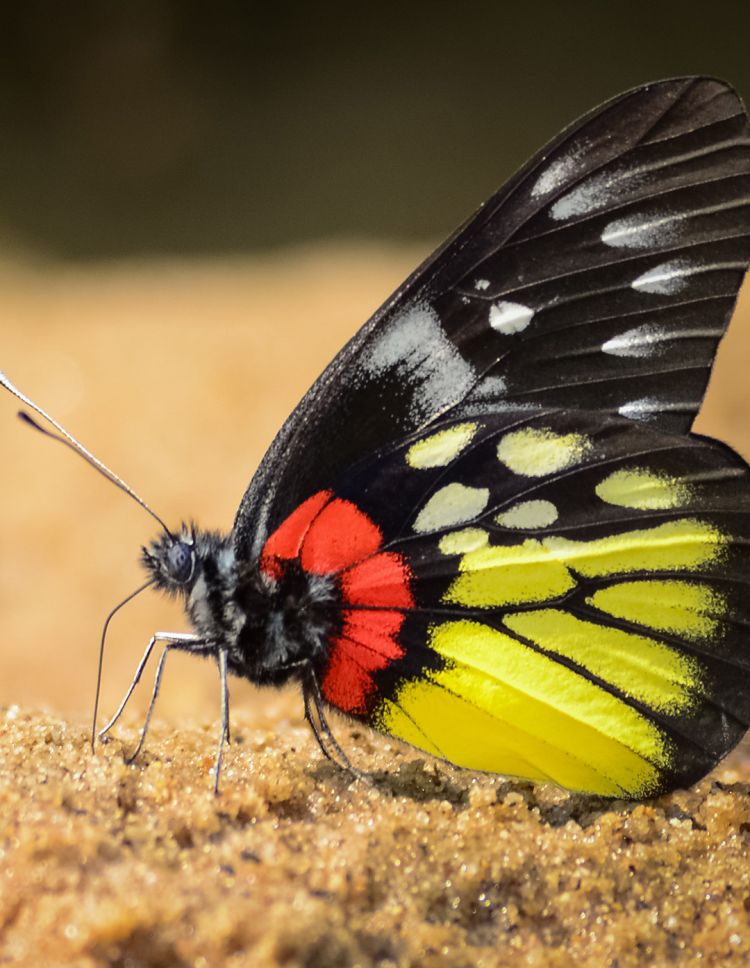
- Shawan Chowdhury, Richard A. Fuller, Md. Rokonuzzaman, Shofiul Alam, Priyanka Das, Asma Siddika, Sultan Ahmed, Mahzabin Muzahid Labi, Sayam U. Chowdhury, Sharif A. Mukul, Monika Böhm, Jeffrey O. Hanson. Insights from citizen science reveal priority areas for conserving biodiversity in Bangladesh. One Earth, 2023; 6 (10): 1315 DOI: 10.1016/j.oneear.2023.08.025
- Shawan Chowdhury, Richard A. Fuller, Sultan Ahmed, Shofiul Alam, Corey T. Callaghan, Priyanka Das, Ricardo A. Correia, Moreno Di Marco, Enrico Di Minin, Ivan Jarić, Mahzabin Muzahid Labi, Richard J. Ladle, Md. Rokonuzzaman, Uri Roll, Valerio Sbragaglia, Asma Siddika, Aletta Bonn. Using social media records to inform conservation planning. Conservation Biology, 2023; DOI: 10.1111/cobi.14161
49 women have been killed in Australia so far in 2023 as a result of violence. Are we actually making any progress?
Anastasia Powell, RMIT University; Jacqui True, Monash University; Kristin Diemer, The University of Melbourne, and Kyllie Cripps, Monash UniversityAs of November 17, 49 women have been killed in Australia this year as a result of violence; 28 were allegedly killed at the hands of a male intimate or ex-intimate partner. That’s according to the activist project Counting Dead Women Australia, which collects these figures based on media-reported crimes.
The Commonwealth government’s recent Outcomes Framework identifies key targets that need to be met if we are to end violence against women in “one generation”, as set out in the National Plan to End Violence Against Women and Children 2022–2032.
The targets include:
- 25% annual reductions in women being killed by intimate partners
- improved understanding of violence against women and support for gender equality in the community
- halving the rate of all forms of domestic/family violence and abuse against Aboriginal and Torres Strait Islander women and children by 2031, as progress towards zero.
Yet, Indigenous women in Australia are eight times more likely than non-Indigenous women to be murdered. Overall, one woman is killed by an intimate partner every two weeks in Australia.
There is no doubt violence against women has gained critical public and policy attention. But sometimes it can feel as though the problem is growing and that nothing we are doing is working to stop it.
So how much progress are we actually making?
What The Data Show: The Good News
Any preventable death is one too many, and zero homicides of any person should be our ultimate goal. Yet data from the National Homicide Monitoring Program show a reduction in intimate partner homicide in particular.
For example, in the most recent report, 25 females were killed by an intimate partner (2020-21). That’s a 31% reduction in one year from 2019-20, when 36 females were killed by an intimate partner. In 2016-17, 40 females were killed by an intimate partner, so the reduction over five years to 2020-21 is about 38%.
While the rates vary year-to-year, the good news is that the overall trend over the past decade shows intimate partner homicide is in steady decline.
Another critical measure of violence against women is the Personal Safety Survey (PSS). This is the most accurate measure of self-reported experiences of all forms of personal violence in Australia.
Conducted by the Australian Bureau of Statistics since 2005, the fourth wave was released earlier this year. While we often hear the lifetime prevalence rates of violence against women, it is changes in rates of violence experienced during the past 12 months that are most sensitive to current policies and programs. This means they are most useful for monitoring a decrease over time.
The survey shows rates of total partner violence, including both physical and sexual violence, have reduced. Overall, the 12-month partner violence rate decreased significantly, from 2.3% in the 12 months prior to the last survey (in 2016) to 1.5% during 2021-2022. The rate of cohabiting partner violence over the past two years has either decreased or not changed in all states of Australia (NT and ACT not reported).
Rates of sexual harassment in the most recent survey (2021-22) were also the lowest they’ve ever been in every state and territory. And there was a significant reduction in the national 12-month rate of sexual harassment to 12.6% in 2021-22 compared to 17.3% in 2016.
As a community, we are also hearing more about the truth of violence against women. This does seem to be improving our knowledge and attitudes. The Australian National Research Organisation for Women’s Safety (ANROWS) survey of Australian community attitudes towards violence against women (NCAS) identified that understanding and rejection of violence against women has been increasing over the past 12 years.
Where Do We Have The Most Work To Do?
As mentioned, Aboriginal and/or Torres Strait Islander women experience violence at higher rates than non-Aboriginal and/or Torres Strait Islander women. Available national data tell us that, despite comprising less than 3% of the population, Indigenous women have consistently experienced higher rates of homicide than non-Indigenous women since 2005–2006. The average rate is eight times higher than for non-Indigenous women.
Professor Kyllie Cripps’ coronial records investigation into 151 Indigenous women killed over the past two decades due to intimate partner violence by Indigenous and non-Indigenous men further found that almost all had sought help from the police but did not receive the support that could have saved their lives.
Alarmingly, national data on unsolved missing persons cases highlight that Indigenous women represent up to 10% of cases. This is significant, as many are presumed dead.
When these data are coupled with statistics highlighting the disproportionate rate at which Indigenous women are hospitalised for assault-related injuries (32 times higher than for non-Indigenous women), there is clearly much work to be done in this area.
Our national datasets do not routinely report on the specific experiences of Indigenous women. This makes it difficult to know if there have been reductions in intimate partner and family violence in recent years.
But statistics alone do not articulate the complexity of these women’s stories and the systemic challenges they have encountered. This requires more in-depth research and engagement with Indigenous communities to appreciate risk, and how that translates into intervention and prevention strategies.
The Senate Inquiry into Missing and Murdered First Nations Women and Children and the dedicated Aboriginal and Torres Strait Islander Action Plan are investments in building evidence to better understand the systemic issues and ultimately end the pervasive family, domestic and sexual violence in communities across the nation.
A further issue raised by the available data is the persistent rate of sexual assault in the Australian community. The 12-month prevalence rate from the last Personal Safety Survey showed no significant change in sexual assault or threatened sexual assault, a trend that has remained steady since 2005.
Further, the most recent national survey of Australian community attitudes towards violence against women (NCAS) identified that overall, four in ten Australians mistrust women’s reports of sexual violence. This suggests we still have a way to go to better educate and inform people about the reality of sexual assault and to support women in reporting it.
There has been a welcome increase in policy and funding to address violence against women across Australia in recent years as well as investments in research.
And while it is difficult to directly attribute reductions in violence against women to specific policy actions, the data to date show there is cause for optimism that our efforts are beginning to have a meaningful impact.
It’s not yet clear if these reductions will continue – we need to analyse the trend over time to make a clear assessment. And we need further investigation on how our prevention and response efforts affect different groups within the Australian population to ensure that all women are safer.
But it is clear that to end violence against women “in one generation” – between 20 and 30 years – we must not lose our focus. It will continue to take a coordinated and evidence-based set of actions across our whole community to address, and ultimately prevent, violence against women in Australia.
If this article has raised issues for you, or if you’re concerned about someone you know, call 1800RESPECT on 1800 737 732. In immediate danger, call 000.![]()
Anastasia Powell, Professor, Family & Sexual Violence, RMIT University; Jacqui True, FASSA FAIIA Director, ARC Centre of Excellence for the Elimination of Violence against Women (CEVAW), Monash University; Kristin Diemer, Associate Professor of Sociology, The University of Melbourne, and Kyllie Cripps, Director Monash Indigenous Studies Centre, CI ARC Centre of Excellence for the Elimination of Violence against Women (CEVAW), School of Philosophical, Historical & International Studies (SOPHIS), School of Social Sciences (SOSS), Faculty of Arts, Monash University
This article is republished from The Conversation under a Creative Commons license. Read the original article.
Disinformation campaigns are undermining democracy. Here’s how we can fight back
Stephan Lewandowsky, University of Bristol and John Cook, The University of MelbourneMisinformation is debated everywhere and has justifiably sparked concerns. It can polarise the public, reduce health-protective behaviours such as mask wearing and vaccination, and erode trust in science. Much of misinformation is spread not by accident but as part of organised political campaigns, in which case we refer to it as disinformation.
But there is a more fundamental, subversive damage arising from misinformation and disinformation that is discussed less often.
It undermines democracy itself. In a recent paper published in Current Opinion in Psychology, we highlight two important aspects of democracy that disinformation works to erode.
The Integrity Of Elections
The first of the two aspects is confidence in how power is distributed – the integrity of elections in particular.
In the United States, recent polls have shown nearly 70% of Republicans question the legitimacy of the 2020 presidential election. This is a direct result of disinformation from Donald Trump, the loser of that election.
Democracy depends on the people knowing that power will be transferred peacefully if an incumbent loses an election. The “big lie” that the 2020 US election was stolen undermines that confidence.
Depending On Reliable Information
The second important aspect of democracy is this – it depends on reliable information about the evidence for various policy options.
One reason we trust democracy as a system of governance is the idea that it can deliver “better” decisions and outcomes than autocracy, because the “wisdom of crowds” outperforms any one individual. But the benefits of this wisdom vanish if people are pervasively disinformed.
Disinformation about climate change is a well-documented example. The fossil fuel industry understood the environmental consequences of burning fossil fuels at least as early as the 1960s. Yet they spent decades funding organisations that denied the reality of climate change. This disinformation campaign has delayed climate mitigation by several decades – a case of public policy being thwarted by false information.
We’ve seen a similar misinformation trajectory in the COVID-19 pandemic, although it happened in just a few years rather than decades. Misinformation about COVID varied from claims that 5G towers rather than a virus caused the disease, to casting doubt on the effectiveness of lockdowns or the safety of vaccines.
The viral surge of misinformation led to the World Health Organisation introducing a new term – infodemic – to describe the abundance of low-quality information and conspiracy theories.
A Common Denominator Of Misinformation
Strikingly, some of the same political operatives involved in denying climate change have also used their rhetorical playbook to promote COVID disinformation. What do these two issues have in common?
One common denominator is suspicion of government solutions to societal problems. Whether it’s setting a price on carbon to mitigate climate change, or social distancing to slow the spread of COVID, contrarians fear the policies they consider to be an attack on personal liberties.
An ecosystem of conservative and free-market think tanks exists to deny any science that, if acted on, has the potential to infringe on “liberty” through regulations.
There is another common attribute that ties together all organised disinformation campaigns – whether about elections, climate change or vaccines. It’s the use of personal attacks to compromise people’s integrity and credibility.
Election workers in the US were falsely accused of committing fraud by those who fraudulently claimed the election had been “stolen” from Trump.
Climate scientists have been subject to harassment campaigns, ranging from hate mail to vexatious complaints and freedom-of-information requests. Public health officials such as Anthony Fauci have been prominent targets of far-right attacks.
The New Frontier In Attacks On Scientists
It is perhaps unsurprising there is now a new frontier in the attacks on scientists and others who seek to uphold the evidence-based integrity of democracy. It involves attacks and allegations of bias against misinformation researchers.
Such attacks are largely driven by Republican politicians, in particular those who have endorsed Trump’s baseless claims about the 2020 election.
The misinformers are seeking to neutralise research focused on their own conduct by borrowing from the climate denial and anti-vaccination playbook. Their campaign has had a chilling effect on research into misinformation.
How Do We Move On From Here?
Psychological research has contributed to legislative efforts by the European Union, such as the Digital Services Act or Code of Practice, which seek to make democracies more resilient against misinformation and disinformation.
Research has also investigated how to boost the public’s resistance to misinformation. One such method is inoculation, which rests on the idea people can be protected against being misled if they learn about the rhetorical techniques used to mislead them.
In a recent inoculation campaign involving brief educational videos shown to 38 million citizens in Eastern Europe, people’s ability to recognise misleading rhetoric about Ukrainian refugees was frequently improved.
It remains to be seen whether these initiatives and research findings will be put to use in places like the US, where one side of politics appears more threatened by research into misinformation than by the risks to democracy arising from misinformation itself.
We’d like to acknowledge our colleagues Ullrich Ecker, Naomi Oreskes, Jon Roozenbeek and Sander van der Linden who coauthored the journal article on which this article is based.![]()
Stephan Lewandowsky, Chair of Cognitive Psychology, University of Bristol and John Cook, Senior Research Fellow, Melbourne School of Psychological Sciences, The University of Melbourne
This article is republished from The Conversation under a Creative Commons license. Read the original article.
Engineered stone kills tradies. Bunnings and IKEA stopping its sales is a big win for public health

Major retailers Bunnings and IKEA have announced this week they will discontinue selling engineered stone. While this might mean you have to rethink your plans for your new kitchen benchtops, it’s a positive step that will protect the health of tradespeople exposed to this dangerous product.
Engineered stone contains up to 95% crystalline silica dust. This superfine dust is released into the atmosphere when workers cut, grind or drill engineered stone.
Breathing this dust into the lungs has been linked to serious long-term damage, including breathing difficulties, lung cancer and silicosis (scarring of the lungs).
We got to this point through a concerted campaign backed by strong scientific evidence. Let’s take a look.
Silicosis Is Preventable
In Australia, nearly one in four engineered-stone workers employed in the industry before 2018 have already developed silicosis or other silica dust-related diseases as a result of their exposure.
Silicosis is caused by breathing in silica dust which becomes embedded in the lungs and causes scarring. This means the person’s lungs can no longer function to their full capacity. Silicosis is a progressive disease, and there’s no cure.
We’ve known about silicosis for many years. Although engineered stone is a particularly potent source of silica dust, it can come from other sources too, such as rock, sand and concrete. It was historically a disease of miners due to their exposure to high dust levels.
Until the past few years, we were seeing a decline in silicosis numbers in Australia and internationally. But we’re now seeing a significant resurgence, due in a large part to the popularity of engineered stone.
My colleagues and I released a report last year which looked at how many Australian workers would develop silicosis and lung cancer as a result of their exposure to silica dust. We also looked at the effect of possible interventions to reduce or eliminate this exposure.
Our analysis found the lives of around 1,000 workers could be saved from silicosis if a ban on engineered stone was implemented. In addition, around 100 lung cancers would also be prevented over the lifetime of these workers.
While some lives could be saved by other measures, such as wearing well-fitted respirators and using water when cutting engineered stone to reduce the dust levels, we calculated that the impact of a ban was much greater. These control measures also rely on compliance to be effective.
How Did We Get Here?
The move – first taken by Bunnings, and soon after by IKEA – follows a concerted effort led by the Australian Council of Trade Unions (ACTU) over the past few years. The ACTU formed a consortium of organisations all working towards a ban on engineered stone to protect workers’ lives.
These organisations included the Lung Foundation, the Cancer Council, the Australian Institute of Occupational Hygienists and the Public Health Association of Australia. Our report was used to inform the campaigning by these organisations.
Members of the Construction Forestry Mining and Energy Union (CFMEU) staged protests at Bunnings stores earlier this year to encourage them to stop the sale of engineered stone products in their stores. In addition, the CFMEU and the wider union movement have vowed to stop their members from using engineered stone if a wider ban is not instituted.
Alongside this effort, we’ve seen numerous stories of everyday Australians – people who have worked with engineered stone, quarry workers and others – who have been diagnosed with silicosis. In many cases these have been young and otherwise healthy people.
No Safe Level
Our research added to evidence gathered by the Australian Institute of Occupational Hygienists that showed there was no practical way this product could be used safely. Based on the weight of this evidence, Safe Work Australia recently recommended a complete ban on engineered stone.
State and territory ministers in the portfolio of work health and safety met late last month to discuss the possibility of a ban. So far, governments in New South Wales and the Australian Capital Territory have indicated they will move towards a ban on engineered stone in the coming months if the federal government does not. It is thought that several other states would also support it.
There is clear momentum towards a ban on engineered stone, and we urge the federal government to implement this as soon as possible. This will ensure a unified, nationally consistent response. We would also encourage other businesses to follow the lead of Bunnings and IKEA.
While ministers deferred their decision on a ban when they met last month, we hope this issue will be resolved when they next meet in December. Continued use of engineered stone will only result in more illness and death among Australia’s tradies. There’s a real opportunity here to make a big difference to public health.![]()
Renee Carey, Senior Research Fellow, School of Population Health, Curtin University
This article is republished from The Conversation under a Creative Commons license. Read the original article.
No, antibiotics aren’t always needed. Here’s how GPs can avoid overprescribing

Antimicrobial resistance is one of the biggest global threats to health, food security and development. This month, The Conversation’s experts explore how we got here and the potential solutions.
The growth in antibiotic resistance threatens to return the world to the pre-antibiotic era – with deaths from now-treatable infections, and some elective surgery being restricted because of the risks of infection.
Antibiotic resistance is a major problem worldwide and should be the concern of everyone, including you.
We need to develop new antibiotics that can fight the resistant bacteria or antibiotics that bacteria would not be quickly resistant to. This is like finding new weapons to help the immune system fight the bacteria.
More importantly, we need to use our current antibiotics – our existing weapons against the bacteria – more wisely.
Giving GPs The Tools To Say No
In 2022, more than one-third of Australians had least one antibiotic prescription, with 88% of antibiotics prescribed by GPs.
Many people mistakenly think antibiotics are necessary for treating any infection and that infections won’t improve unless treated with antibiotics. This misconception is found in studies involving patients with various conditions, including respiratory infections and conjunctivitis.
In reality, not all infections require antibiotics, and this belief drives patients requesting antibiotics from GPs.
Other times, GPs give antibiotics because they think patients want them, even when they might not be necessary. Although, in reality they are after symptom relief.
For GPs, there are ways to target antibiotics for only when they are clearly needed, even with short appointments with patients perceived to want antibiotics. This includes:
using decision guides or tests to decide if antibiotics are really necessary
giving patients information sheets when antibiotics aren’t needed
giving a “delayed prescription” – only to be used after the patient waits to see if they get better on their own.
All these strategies need some training and practice, but they can help GPs prescribe antibiotics more responsibly. GPs can also learn from each other and use tools like posters as reminders.
To help with patients’ expectations, public campaigns have been run periodically to educate people about antibiotics. These campaigns explain why using antibiotics too much can be harmful and when it’s essential to take them.
Giving Doctors Feedback On Their Prescribing
National programs and interventions can help GPs use antibiotics more wisely
One successful way they do this is by giving GPs feedback about how they prescribe antibiotics. This works better when it’s provided by organisations that GPs trust, it happens more than once and clear goals are set for improvement.

The NPS (formerly National Prescribing Service) MedicineWise program, for example, had been giving feedback to GPs on how their antibiotic prescriptions compared to others. This reduced the number of antibiotics prescribed.
However, NPS no longer exists.
In 2017, the Australian health department did something similar by sending feedback letters, randomly using different formats, to the GPs who prescribed the most antibiotics, showing them how they were prescribing compared to others.
The most effective letter, which used pictures to show this comparison, reduced the number of antibiotics GPs prescribed by 9% in a year.
Clearer Rules And Regulations
Rules and regulations are crucial in the fight against antibiotic resistance.
Before April 2020, many GPs’ computer systems made it easy to get multiple repeat prescriptions for the same condition, which could encourage their overuse.
However, in April 2020, the Pharmaceutical Benefits Scheme (PBS) changed the rules to ensure GPs had to think more carefully about whether patients actually needed repeat antibiotics. This meant the amount of medicine prescribed better matched the days it was needed for.

Other regulations or policy targets could include:
ensuring all GPs have access to antibiotic prescribing guidelines, such as Therapeutic Guidelines, which is well accepted and widely available in Australia
ensuring GPs are only prescribing antibiotics when needed. Many of the conditions antibiotics are currently prescribed for (such as sore throat, cough and middle ear infections) are self-limiting, meaning they will get better without antibiotics
encouraging GP working with antibiotics manufacturers to align pack sizes to the recommended treatment duration. The recommended first-line treatments for uncomplicated urinary tract infections in non-pregnant women, for example, are either three days of trimethoprim 300 mg per night or five days of nitrofurantoin 100 mg every six hours. However, the packs contain enough for seven days. This can mean patients take it for longer or use leftovers later.
Australia Lags Behind Sweden
Australia has some good strategies for antibiotic prescribing, but we have not had a sustained long-term plan to ensure wise use.
Although Australian GPs have been doing well in reducing antibiotic prescribing since 2015, more could be done.
In the 1990s, Sweden’s antibiotic use was similar to Australia’s, but is now less than half. For more than two decades, Sweden has had a national strategy that reduces antibiotic use by about 7% annually.
It is vital Australia invests in a similar long-term national strategy – to have a centrally funded program, but with regional groups working on the implementation. This could be funded directly by the Commonwealth Department of Health and Ageing, or with earmarked funds via another body such as the Australian Centre for Disease Control.
In the meantime, individual GPs can do their part to prescribe antibiotics better, and patients can join the national effort to combat antibiotic resistance by asking their GP: “what would happen if I don’t take an antibiotic?”.
Read the other articles in The Conversation’s series on the dangers of antibiotic resistance here.![]()
Mina Bakhit, Assistant Professor of Public Health, Bond University and Paul Glasziou, Professor of Medicine, Bond University
This article is republished from The Conversation under a Creative Commons license. Read the original article.
David McBride is facing jailtime for helping reveal alleged war crimes. Will it end whistleblowing in Australia?
Rebecca Ananian-Welsh, The University of QueenslandThe long-awaited trial of former Australian Defence Force lawyer David McBride was short-lived.
He stood accused of putting national security at risk by sharing confidential information with journalists, who then reported on alleged Australian war crimes in Afghanistan.
An unexpected strategic move by the Department of Defence succeeded in withholding key documents from the ACT Supreme Court, all but dismantling McBride’s claim for whistleblower protection.
Having now pleaded guilty to unlawfully sharing classified material, what happens to McBride? And what does it say about the state of whistleblower protection laws in this country?
The End Of A Winding Road
David McBride was charged in 2019 for disclosing secret military information to two ABC journalists.
His concerns had included Australian soldiers being sent to Afghanistan by a government he believed was more concerned with politics than the troops. Interestingly, the court heard last week McBride was also concerned about the “over-investigation” of misconduct by special forces.
Instead, that information revealed allegations of war crimes by Australian soldiers in Afghanistan and a culture of cover-up in the Defence Force.
The ABC used the information to publish the Afghan Files reports. Many allegations were later supported by the inspector-general of the Australian Defence Force in the Brereton report.
That report, released in November 2020, recommended the chief of the Defence Force refer 36 matters relating to 25 incidents and involving 19 individuals to the Australian Federal Police for investigation.
So far, the only charges to have been laid as a result of these investigations are against McBride himself. A brief of evidence was also prepared against ABC journalist Dan Oakes, though the Commonwealth Director of Public Prosecutions declined to prosecute Oakes on public interest grounds.
It took four years for McBride’s case to get to court. Delays due to the pandemic and issues around maintaining the secrecy of classified information in court prolonged this process.
Eventually, the Department of Defence claimed public interest immunity over key information. This allows the government to withhold evidence (such as classified material) from the court on public interest grounds.
It means neither party can rely on the information.
This strategic decision meant McBride faced difficulties establishing key aspects of his whistleblower case. This included whether the information revealed relevant wrongdoing, his attempts to tell the department or police about his concerns, or whether the extent of the disclosure was necessary to establish wrongdoing.
On the other hand, the information McBride disclosed was security classified defence material that journalists were not authorised to receive. It is, therefore, not particularly surprising that he pleaded guilty to disclosure offences.
His only hope had been to avoid prosecution by grasping the shield of whistleblower protections.
What Next For McBride?
McBride will now be sentenced for his offences, likely next year.
There is a chance the court will show leniency in sentencing, taking into account the demonstrated public interest in McBride’s disclosures.
This happened in the prosecution of Witness K, who conspired to reveal an alleged spying operation in East Timor during oil and gas treaty negotiations.
They were not covered by whistleblower laws because the legislation does not apply to intelligence information, and also pleaded guilty to secrecy offences.
Alternatively, the judge may not be swayed by the public interest in McBride’s disclosures and McBride could face a lengthy jail term.
The length of any jail term will depend on a number of factors, such as:
the extent of information disclosed
the deliberate nature of the disclosures
a need to deter future disclosures of classified defence information.
What Does This Mean For Whistleblowers?
The punishment of McBride would have tragic impacts on whistleblowing in Australia.
Far from being a crime, research has identified whistleblowing as “the single most important way that wrongdoing or other problems come to light in organisations”.
Whistleblowing led not only to the Brereton report, but the Robodebt inquiry, the Banking royal commission, and Fitzgerald inquiry into police misconduct, to name but a few high profile examples.
The importance of whistleblowing has been recognised in Public Interest Disclosure Acts across Australia, protecting whistleblowers from reprisals, victimisation and prosecution.
The importance of these protections is heightened in recent years by the government’s willingness to prosecute whistleblowers such as Richard Boyle (who accused the Australian Taxation Office of using aggressive tactics to retrieve money), David McBride, and Witness K for calling out government wrongdoing.
Whistleblower protection law is not perfect. Calls for its improvement point to a need for greater consistency across private and public sector protections.
They also call for better protection for intelligence and defence whistleblowers, and supports for press freedom.
The protections are yet to be tested. McBride’s case would have been the first opportunity to see how courts interpret and apply whistleblower law.
But the government’s decision to withhold information from court stopped these laws from being tested.
It’s easy to see how the government’s reaction to McBride’s decision to blow the whistle will deter future whistleblowers, sending a bad message about transparency, accountability and the importance of calling out wrongdoing by those in positions of power.![]()
Rebecca Ananian-Welsh, Associate Professor, TC Beirne School of Law, The University of Queensland
This article is republished from The Conversation under a Creative Commons license. Read the original article.
What a biannual gathering of 1967 Impalas reveals about the blurry line between fandom and religion

Among the many spooky events happening over Halloween weekend was the biannual “Haunting of Impalas” at Family Business Brewing, a 15-acre brewery in Dripping Springs, Texas, owned by actor and musician Jensen Ackles.
Along with Jared Padalecki, Ackles is the star of “Supernatural,” a television series that ran from 2005 to 2020.
A weekly science-fiction show akin to “The X-Files,” “Supernatural” follows two brothers, Sam and Dean Winchester, as they drive in a classic 1967 Chevrolet Impala across the U.S., fighting monsters and uncovering their convoluted family past. Show creator Eric Kripke has described the show as “a modern American Western – two gunslingers who ride into town, fight the bad guys, kiss the girl and ride out into the sunset again.”
With a subtle nod to the show’s tagline: “Saving People, Hunting Things – The Family Business,” Ackles opened the brewery in 2017. It has since become a popular destination for fans of the TV series.
“Supernatural” has been called a “cult” drama, with conventions that draw fans from all over the country. Religious terms like cult are often used to convey how serious the fandom is. But as two scholars of religion, we see the connection between fandom and religion as one that’s stronger and deeper than many people might realize.
If You Build It, They Will Come
The Haunting of Impalas – fans call a gathering of the cars a “haunting” – has been held at the brewery as a free event since 2019, first as a casual meet-up and then as an official event sponsored by the brewery.
As much a character on the show as Ackles and Padalecki themselves, the characters’ black 1967 Impala has become iconic for fans. Elaborating on the debt “Supernatural” owes to Westerns, show writer Kripke said of the Impala, “If you’re going to have cowboys, they need a trusty horse.”

The car serves as the brothers’ home on the road, as their protection from evil and as a repository of monster-hunting weapons. In a nod to the car’s central role, some devoted fans of the show have since bought and restored black 1967 Impalas, which they bring together at the Haunting of Impalas event.
Fans have lovingly recreated each Impala – sometimes even accurate to a specific episode. Lined up, each car reveals a secret trunk compartment filled with weapons from the show, such as vampire-killing machetes, silver bullets for werewolves and holy water for demons.
Further care is taken to reflect other details found in the Impala over the seasons: a small green army man stuck in the ashtray or a partially eaten pie. At the brewery, four Impalas, as well as one AMC Gremlin that appeared in several episodes, were lined up for examination as close to 100 people milled about in the hour we visited. The social media accounts for the brewery registered over 1,500 RSVPs, and one organizer estimated that roughly 1,000 people were in attendance over the course of the day.
‘People Just Want To Have An Experience’
In our work, we’ve seen this behavior before. But it’s been in churches and temples rather than the parking lot of a brewery.
Spectators approached the Impalas with a hesitant reverence, eager to touch the trunk or take a photo sitting in the driver’s seat. One Impala received special interest, as it had actually been used in Season 12 of the show – a fact at least a dozen individuals told us in hushed tones. Its owner hovered around the car with a polishing cloth to quickly whisk away any fingerprints left by visiting fans, but was eager to point out each place an actor had signed the car or otherwise left their mark.
Many of the Impalas at the event had been driven across the country for days to participate. Organizer Travis Perdue, a fan in his early 40s, could tick off the whereabouts of other “Supernatural” Impalas – and the owners who had been too sick to come or otherwise detained.
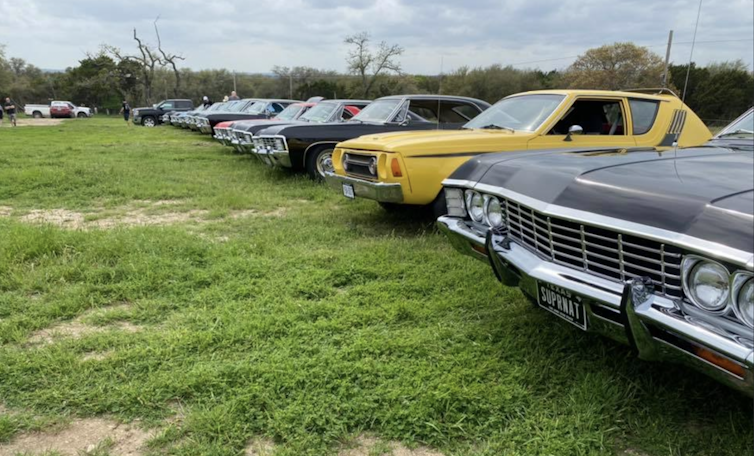
When asked if this event felt spiritual, Perdue explained, “It’s not about the cars; it’s not about the weapons. It’s something else. People just want to have an experience.”
He said that he frequently sees fans getting emotional near the cars. More than a handful of them have burst into tears. He said one person even passed out upon seeing the restored Impala.
We witnessed one man loudly tell his wife, with tears in his eyes, “If I had one of these, I could die happy.”
Sociologist Emile Durkheim has written that when people encounter their community’s sacred symbols, it can overwhelm them – that the feelings these objects inspire act like “material forces that mechanically generate physical effects.”
The Impalas are not the only potent symbols on display at the event, either. Most of the attendees wore some sort of Supernatural-themed apparel – a shirt, a bag or even a tattoo.
Inside several of the cars were facsimiles of the monster-hunting journal written by John Winchester, Sam and Dean’s father in the show. Each journal featured dozens of hand-inked pages, recreations of newspaper articles, a pin for military service in Vietnam and eerie photographs. Like monks producing illuminated manuscripts, a team of fans crafted each journal by hand.
Perdue, who’s worked on the journals, explained that the first facsimile took eight months of research to design, and each subsequent copy took six weeks to produce. They sell them to other fans for $650, and Perdue has a waitlist of dozens of people. But the group makes no money off the journals. Rather, he is motivated by the joy of making such a precious item for other fans.

Fandom As Religion Or Vice Versa?
Many scholars have noted the religious aspects of fan culture.
Perhaps, however, we might reverse the comparison and note that religion operates more like a fandom.
Because of America’s Protestant heritage, Americans often assume religion is about beliefs; That’s because Protestantism renounces “salvation through works” in favor of “sola fides,” or “faith alone.”
But most religions don’t work this way. As religion scholar Stephen Prothero points out, “Religions are often called ‘belief systems.’ But the Christian tradition is the only major religion that puts a strong emphasis on beliefs.”
According to Prothero, the common denominator that all religions share is not beliefs but stories. As he puts it, “All religions are ‘story systems.’” Outside of Christianity’s emphasis on creeds, most religious traditions emphasize practices, experiences and stories – exactly the things that drew fans to the Haunting of Impalas.
Pilgrimage – journeying to see sacred places and objects – is found in many religions. In 2023, the Hajj drew about 2 million pilgrims to Mecca despite dangerously high temperatures. Even more common is mimesis, or replicating sacred stories through art and ritual. In the Mexican tradition of Las Posadas, a procession recreates the story of Mary and Joseph being turned away from the inn before smashing a pinata shaped like the star of Bethlehem.
What made “Supernatural” great was not the supernatural. Fans know the Winchester brothers are imaginary. And yet the Winchesters’ story seems to represent something greater than themselves. The Impalas become an object of pilgrimage because they present a physical connection to things that are otherwise intangible and transcendent – a modern mythology and a community of like-minded people.
Religious studies is largely a Western invention, and so it has historically carried a lot of Protestant assumptions, even when discussing non-Christian religions, including the idea that the essence of religions is a set of intellectual propositions about God or the afterlife.
But if scholars of religion shift their analysis from beliefs to stories and communities, who is to say that the world’s religions are not just larger fandoms of figures like Jesus, Buddha or Krishna?![]()
Joseph P. Laycock, Associate Professor of Religious Studies, Texas State University and Natasha Mikles, Assistant Professor in Philosophy and Religious Studies, Texas State University
This article is republished from The Conversation under a Creative Commons license. Read the original article.
The Optus chief was right to quit but real change is unlikely at the telco until bigger issues are fixed
Helen Bird, Swinburne University of TechnologyOptus chief executive Kelly Bayer Rosmarin bowed to the inevitable on Monday and resigned as chief executive of Australia’s second largest telecommunications company.
Why inevitable? Poor communication and a lacklustre response during a major system outage is bad enough. Then things got worse when Bayer Rosmarin and the director of Optus networks admitted at a Senate hearing on Friday they had no disaster management plan for the kind of national outage experienced two weeks earlier.
Someone was always going to have to take the blame. Now, two critical questions emerge. First, will the resignation of the chief executive be sufficient to stem the tide of bad publicity from Optus’ outage debacle? Second, is this yet another instance of a female chief at a prominent Australian company being pushed over the “glass cliff”?
Quitting Is Only A Band-Aid Fix
The resignation of a chief executive following a national fiasco has become something of a ritual for big Australian corporations. This happened at Qantas, too.
Such actions calm public anger, making it appear someone is taking responsibility. Yet, is this truly effective? Not necessarily. This is because problems are deeply ingrained within these corporations, which removing the current leader will not necessarily resolve. Again, the Qantas example illustrates this point.
Optus’ challenges are notably linked to its operational model as a subsidiary of Singtel Ltd, a Singapore-based company. A review of its website shows Optus has a very lean corporate structure in Australia.
Remarkably, Optus doesn’t have a traditional board of directors within Australia to oversee its management. The website lists Paul O’Sullivan as the chairman, but it’s unclear what exactly he chairs. Surprisingly, O’Sullivan maintains a low public profile, despite Optus being Australia’s second-largest telecommunications carrier. At best, it appears he chairs a board of senior executives including the chief executive.
Even within the ranks of the nominated executives, no one is specifically responsible for the company’s risk management. While Optus claims to have such systems in place, the recent national outage points to a significant lapse in disaster planning. This is a major failure of risk management.
The likelihood of such an outage might have appeared remote to Bayer Rosmarin, yet given the potentially severe consequences, comprehensive planning and scenario testing would seem essential for the telco giant. Like the inevitability of cyber hacking, a national outage could be considered a matter of when, not if.
Optus Needs Robust Governance
In a typical scenario, a board of directors would scrutinise the executive team’s oversight and accountability functions as the catastrophe unfolded. With no Australian board, those tasks are apparently the responsibility of Optus’ parent, Singtel.
It is easy to imagine systemic risk concerns at Optus might be too far removed from the Singapore-based board. But that is not much consolation for Australian consumers and agencies who depend on Optus for telecommunication services, including the emergency triple-zero number.
Optus’ lack of strong governance in Australia is and remains a major concern for the company, regardless of who’s in charge. Optus urgently needs a properly constituted local board of directors with clear accountability for its local operations.
This includes a chairperson ready to front the media and share responsibility with the chief executive. It also requires more transparent governance, particularly regarding risk management and remuneration. Optus can handle some of these issues, but the cost overlay will no doubt be a factor in the mode of the remedy.
That is where the federal government, through its regulatory agency, the Australian Communications and Media Authority, must come in and tighten up the governance requirements of companies with a carrier licence.
The Short-Lived Tenure Of Women At The Top
The resignation of Bayer Rosmarin from Optus arguably becomes a classic case of the “glass cliff” phenomenon, where women are installed in leadership roles only to be blamed for failing to fix a crisis. Her stint as chief executive was brief, starting in April 2020 after joining Optus in March 2019. Her time at the helm will likely be remembered for two national scandals: a cyber hack and a national outage.
Studies looking at women in leadership suggest women who take on such roles in turbulent times are likely to endure a shorter tenure than their male counterparts. One scandal might be overlooked, but two? It seems the outcome was inevitable.
Michael Venter, the interim chief executive, may well succeed where Bayer-Rosmarin failed. However, unless Optus takes the time to properly resolve systemic risk issues and bolster its governance arrangements, it should expect more trouble ahead.![]()
Helen Bird, DIscipline Leader, Corporate Governance & Senior Lecturer, Swinburne Law School, Swinburne University of Technology
This article is republished from The Conversation under a Creative Commons license. Read the original article.
COVID Takes A Toll On Young Australians’ Education: New Study From ANU
 One-in-two high school students say COVID-19 hampered their education, with those with a disability the group reporting they'd fallen the most behind their peers, Australia's largest survey of young Australians has found.
One-in-two high school students say COVID-19 hampered their education, with those with a disability the group reporting they'd fallen the most behind their peers, Australia's largest survey of young Australians has found.Millennials Aren't All Worse Off Than Baby Boomers; But The Rich-Poor Gap Is Widening
Disclaimer: These articles are not intended to provide medical advice, diagnosis or treatment. Views expressed here do not necessarily reflect those of Pittwater Online News or its staff.